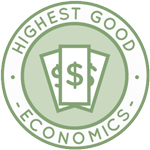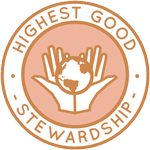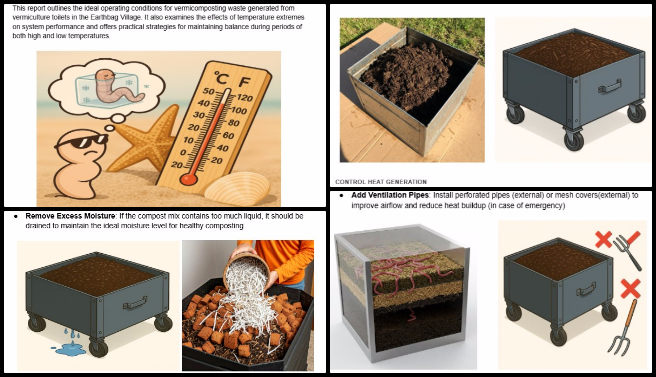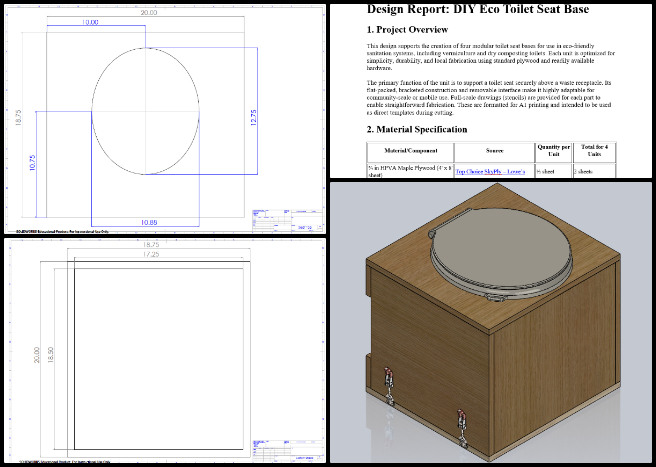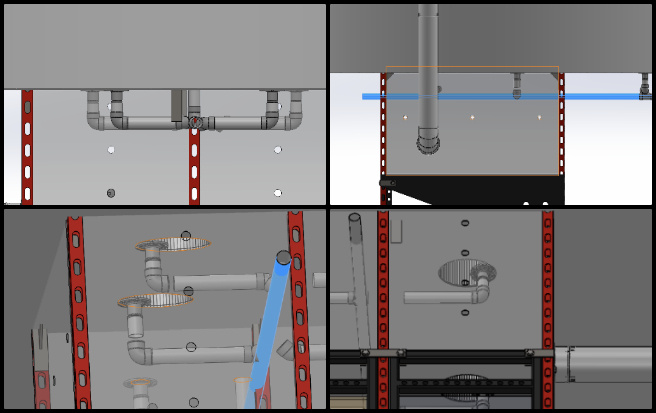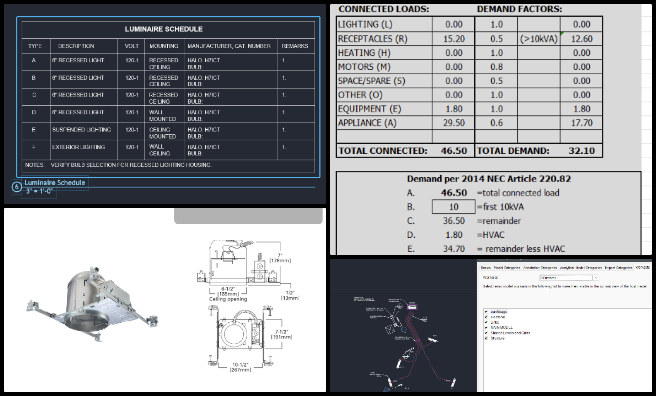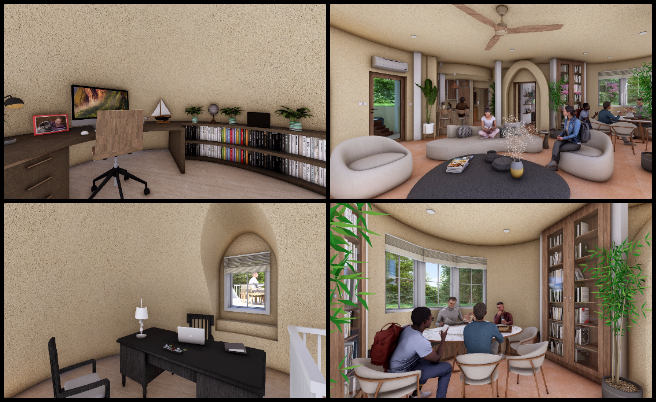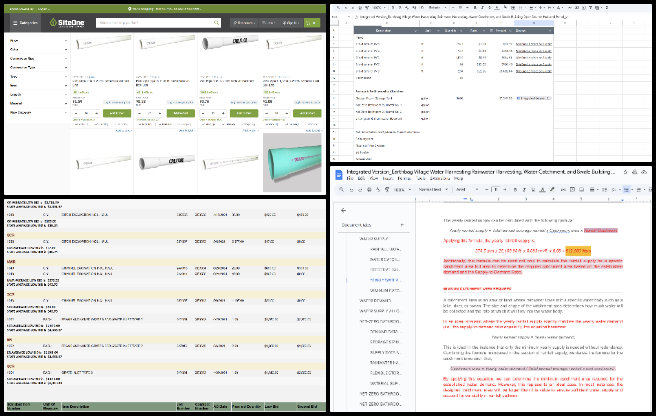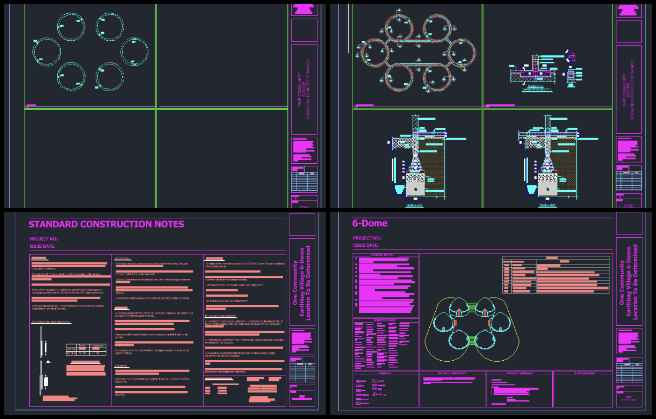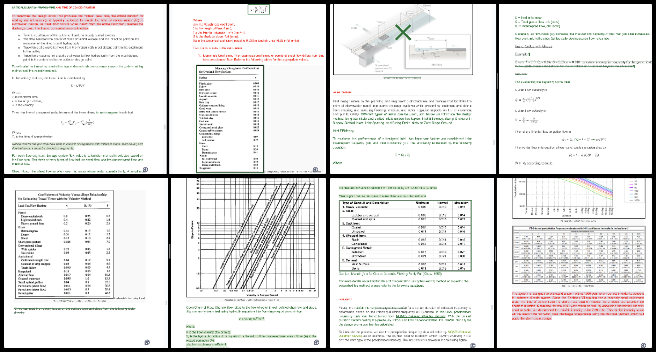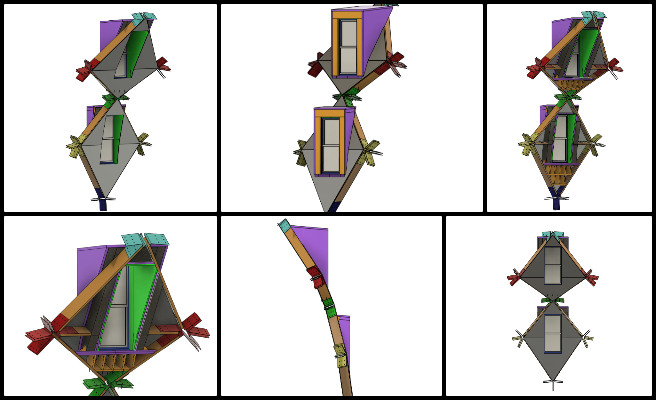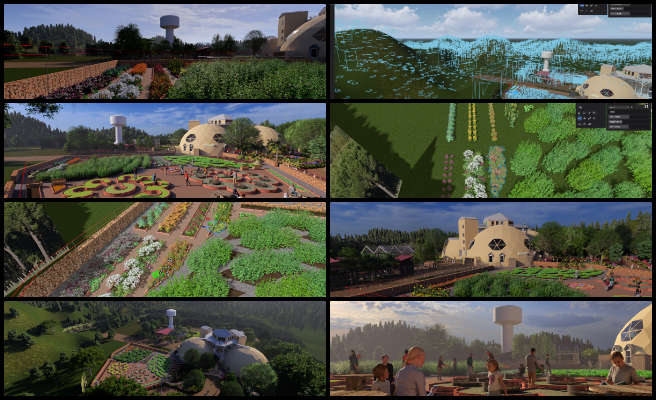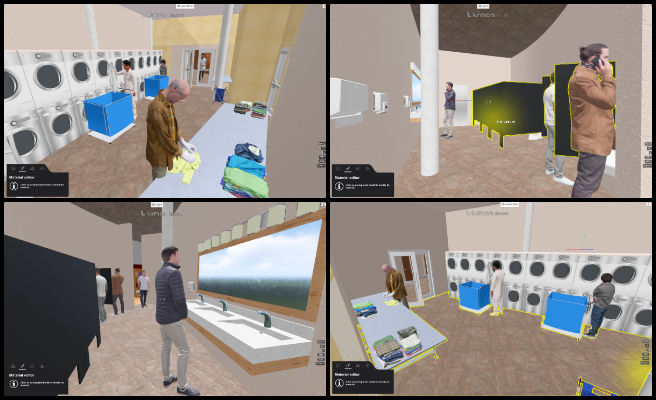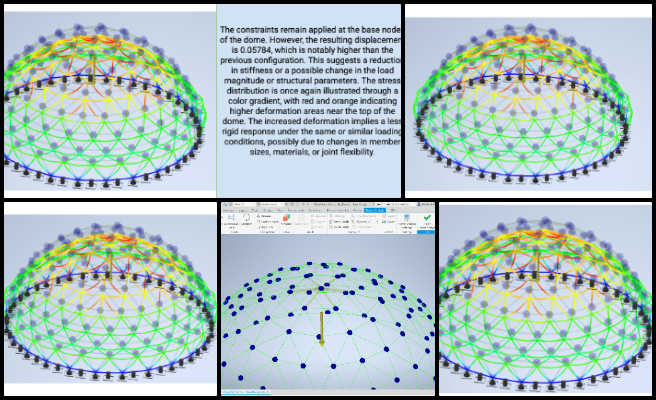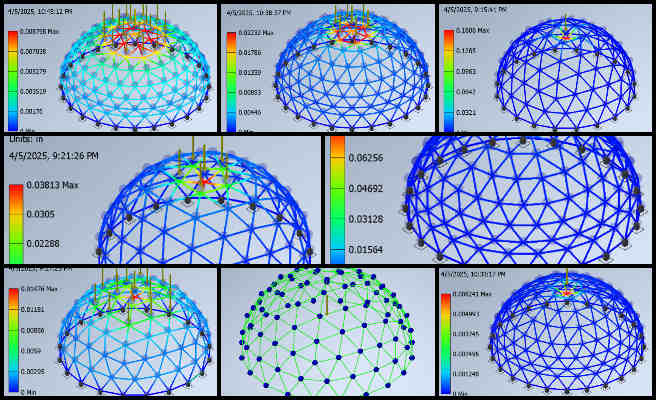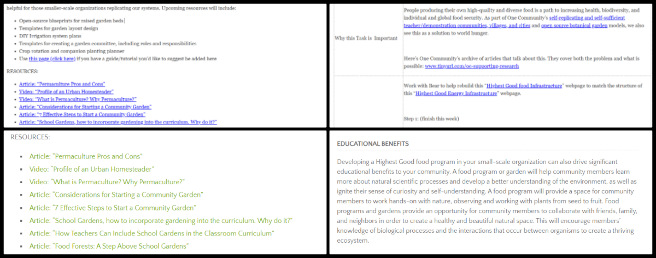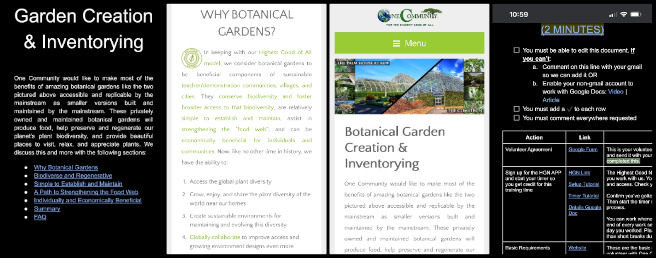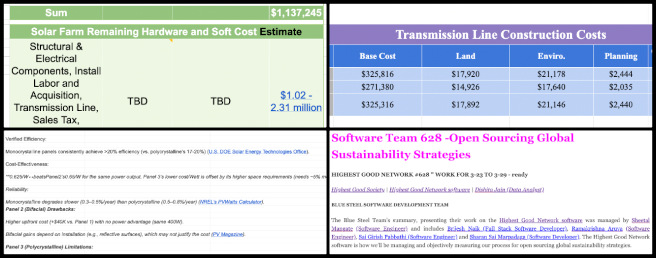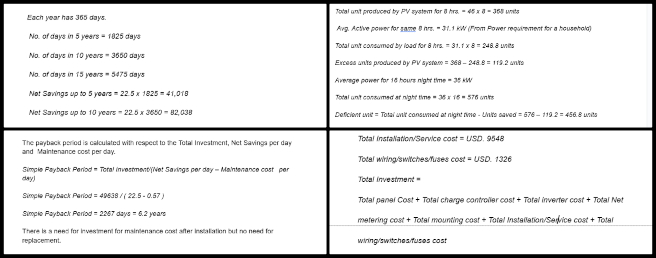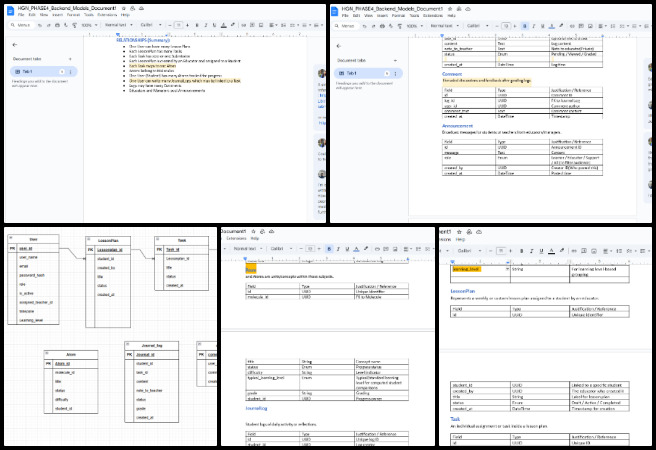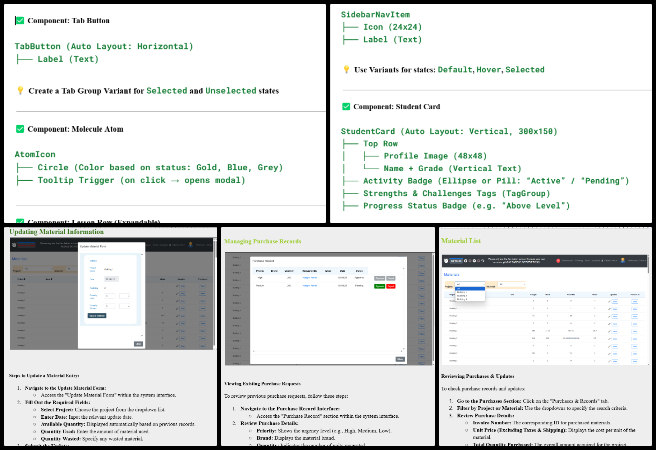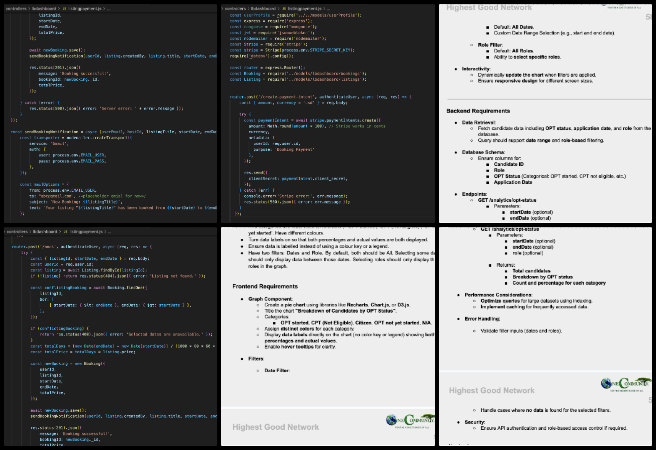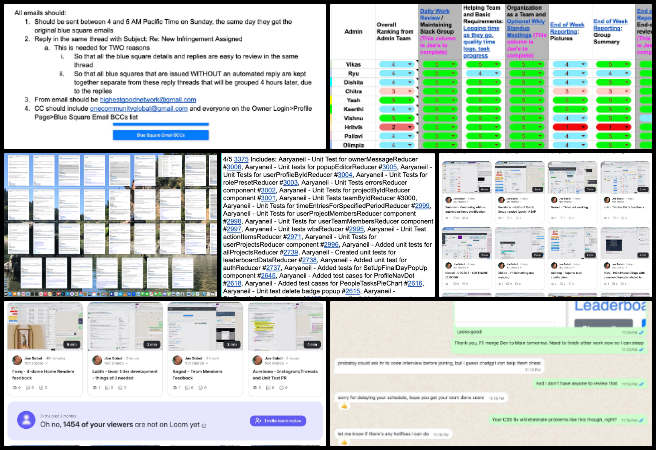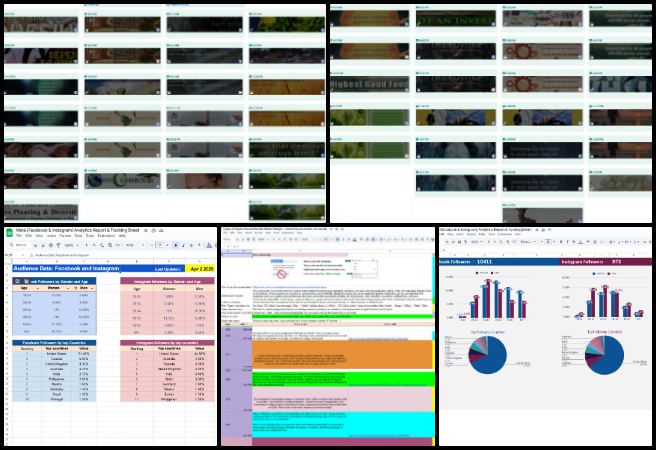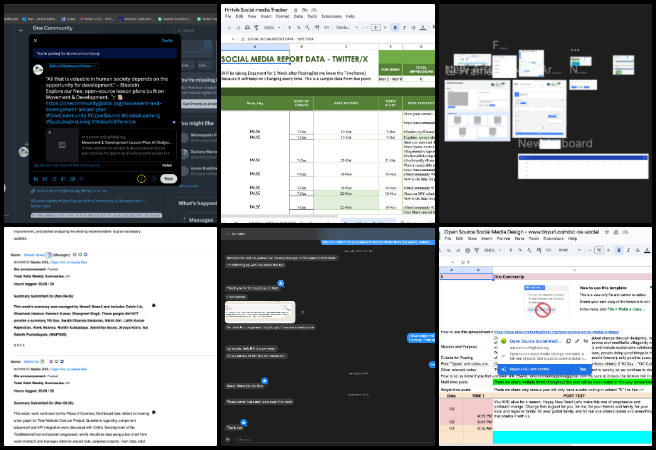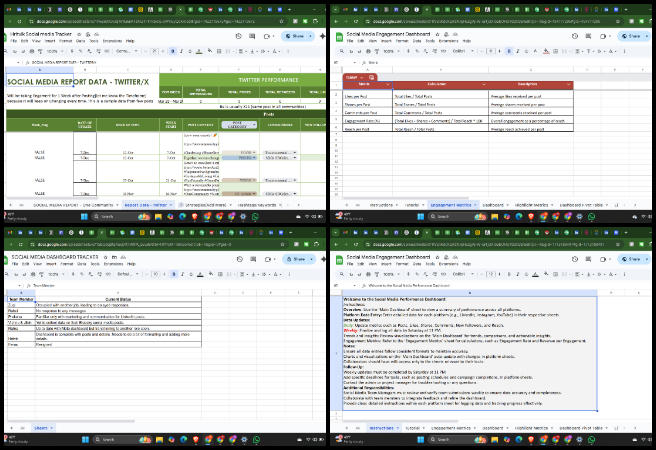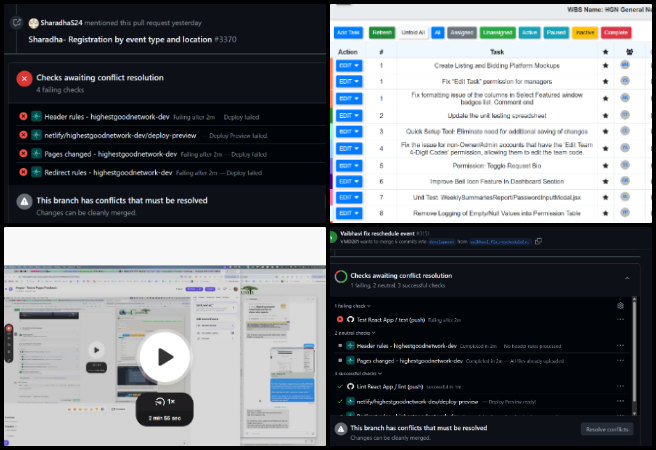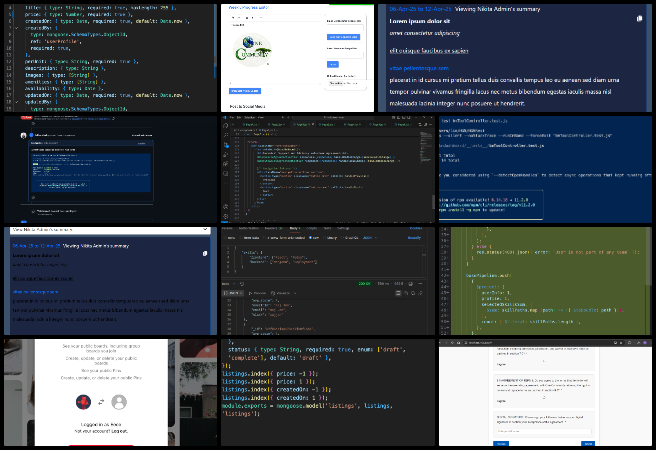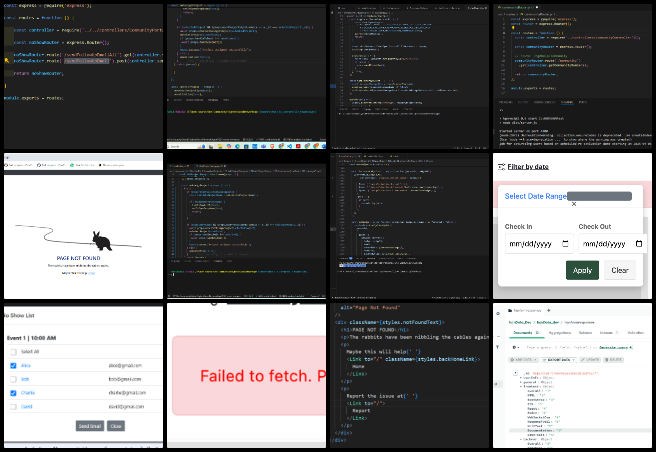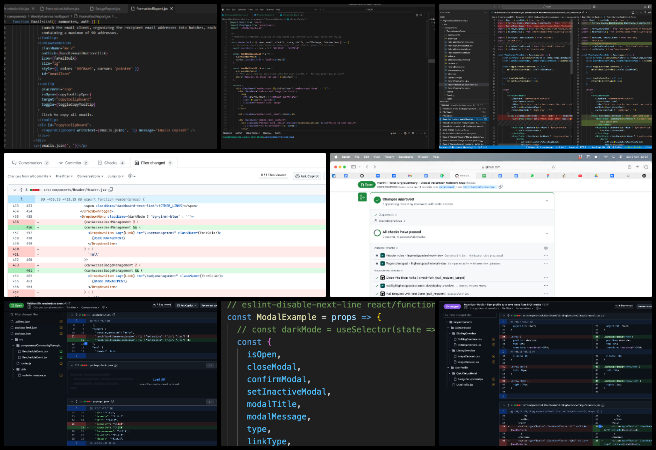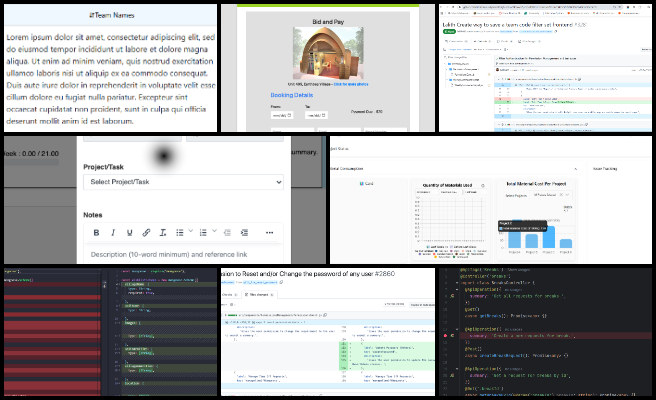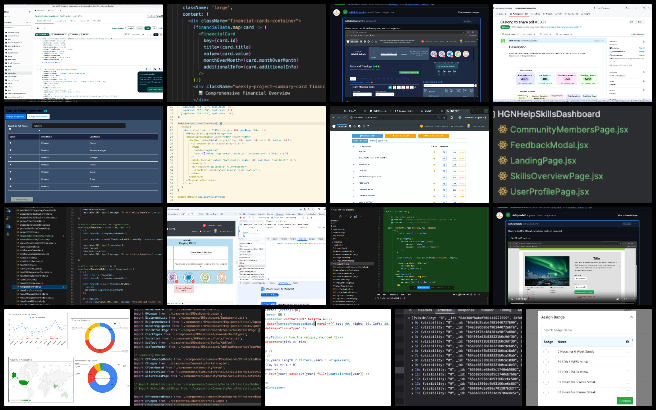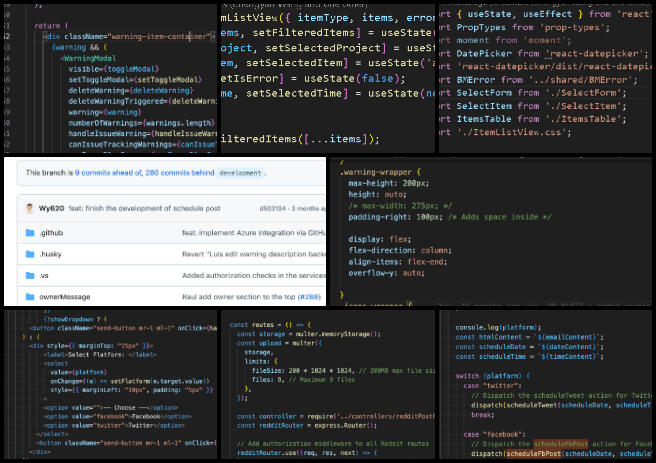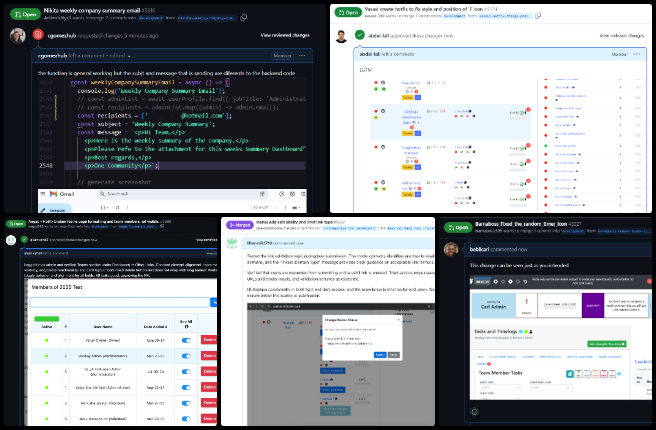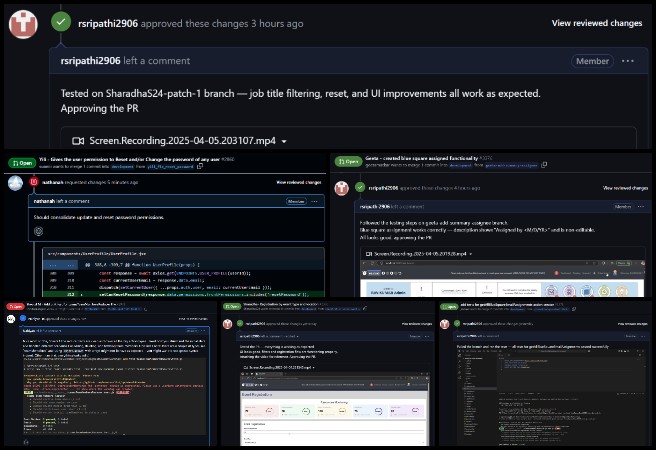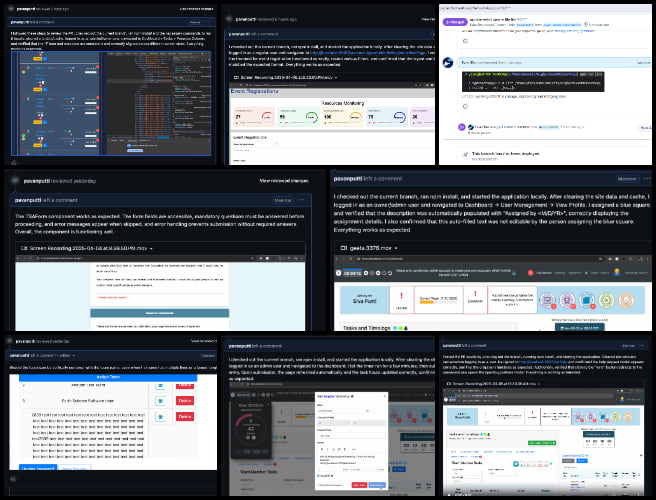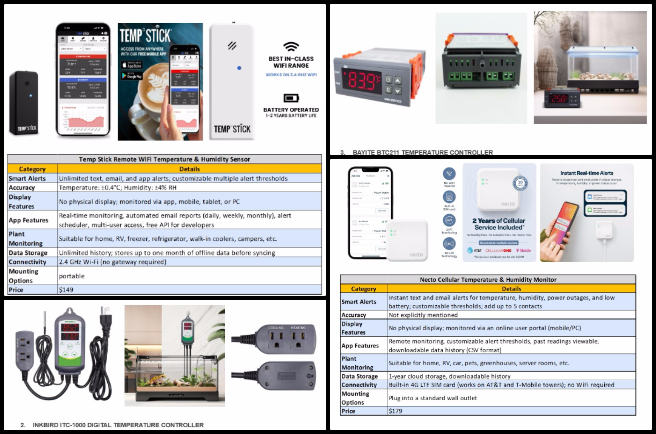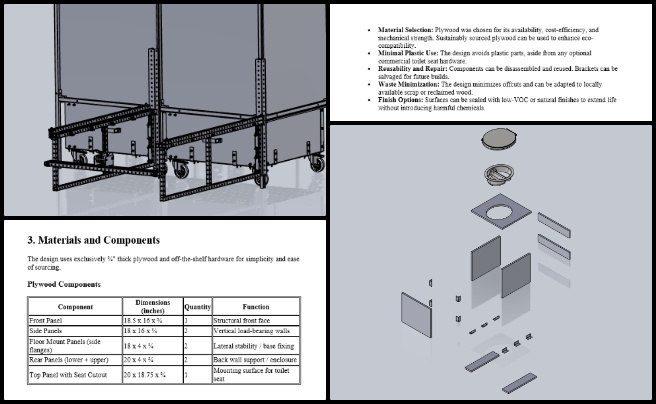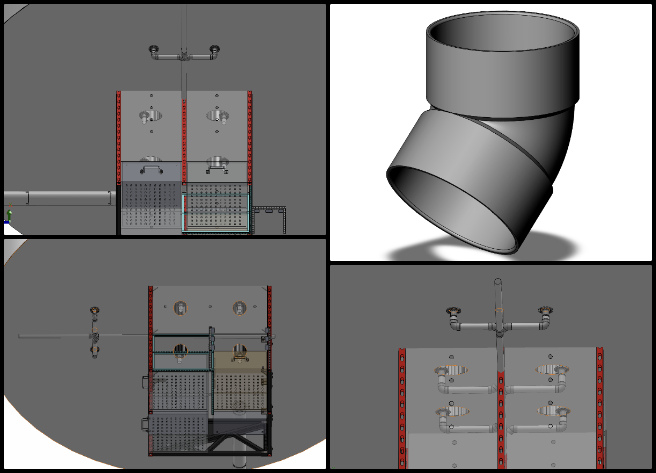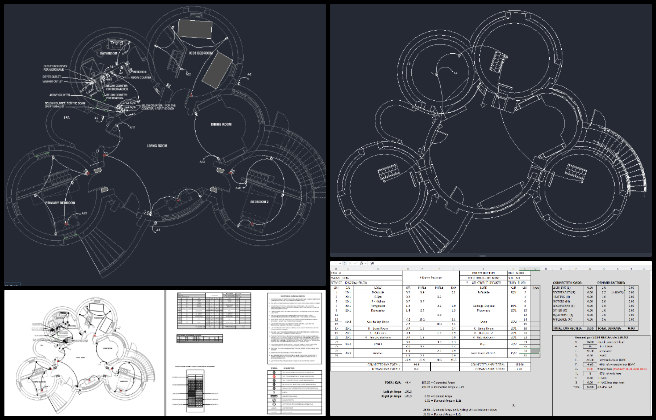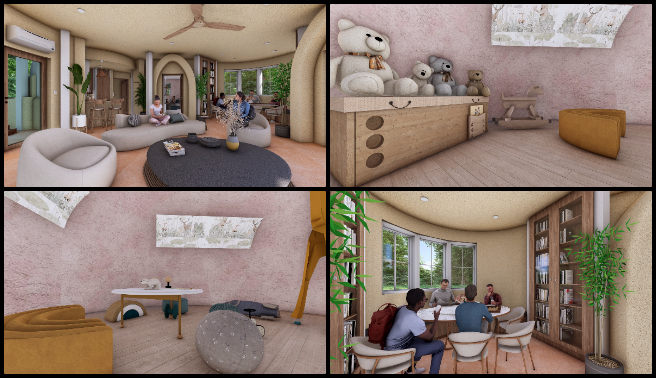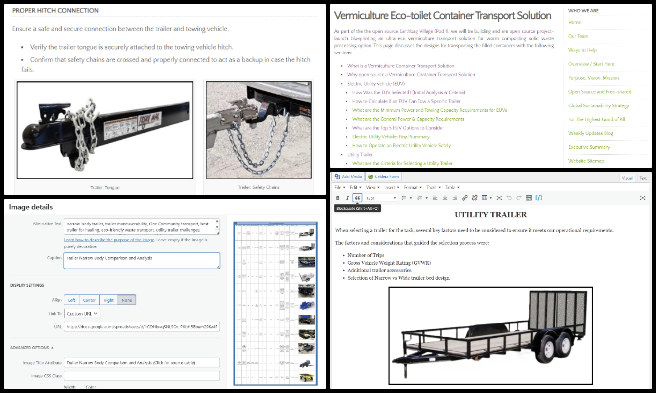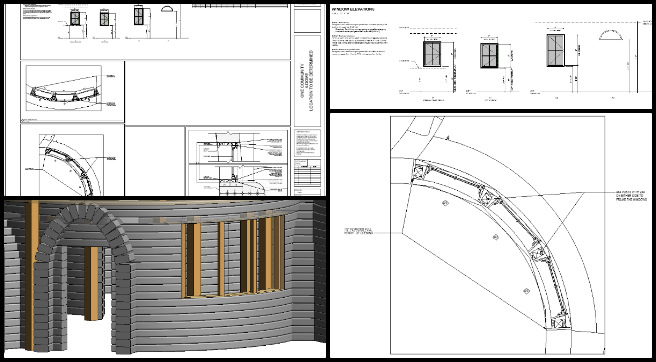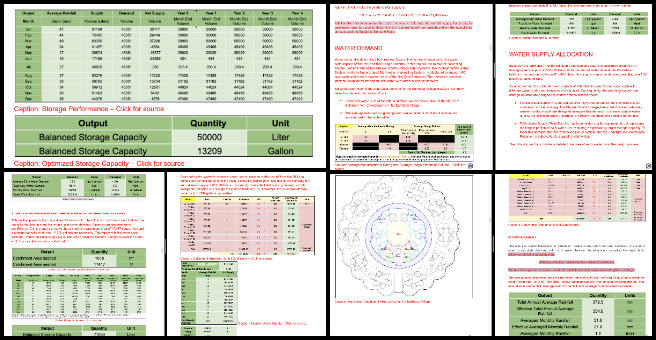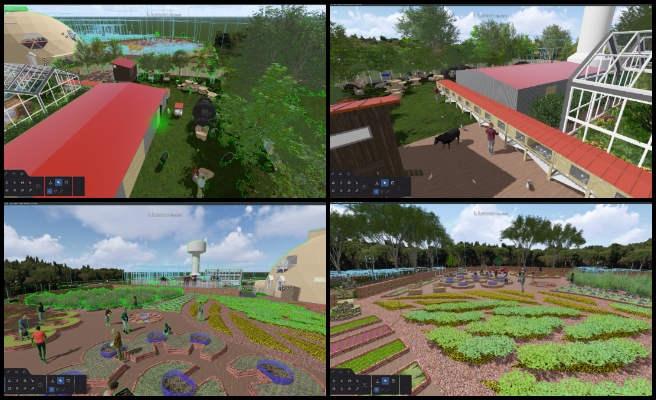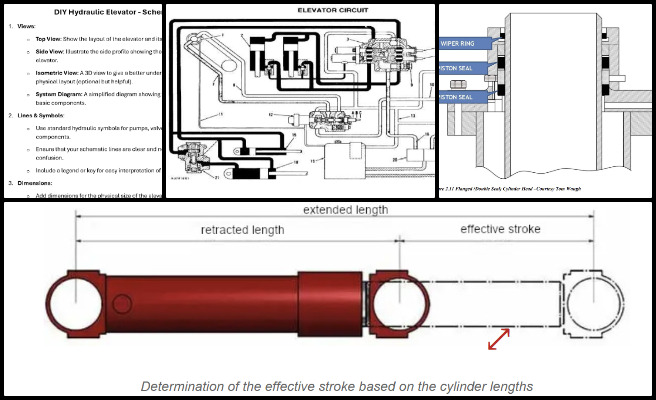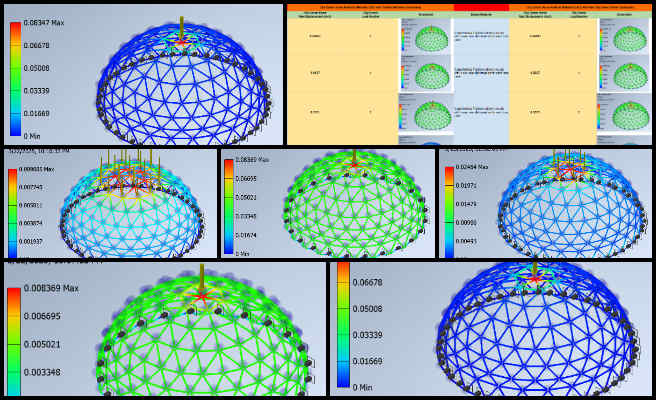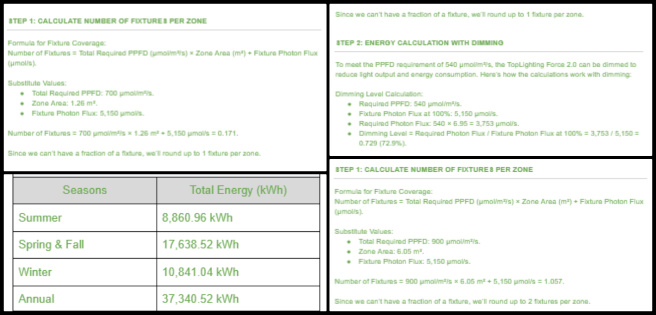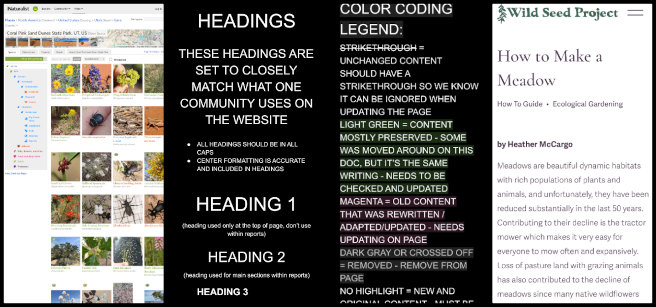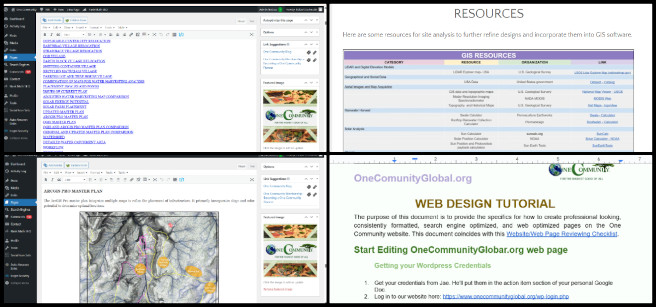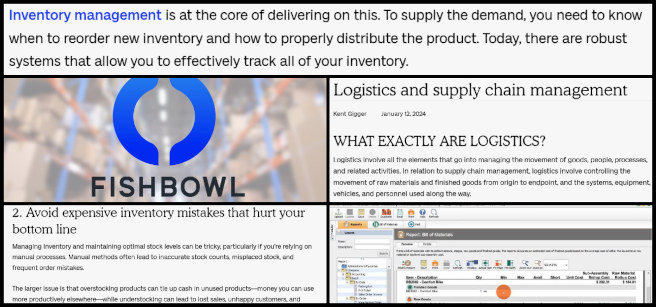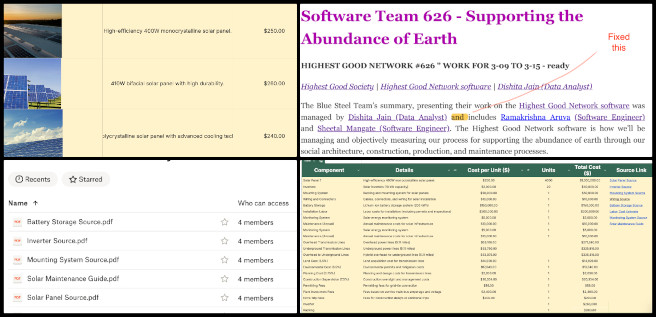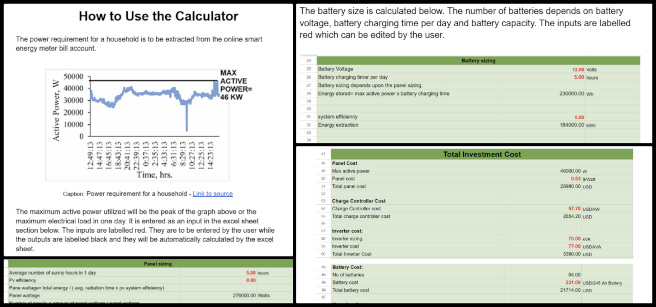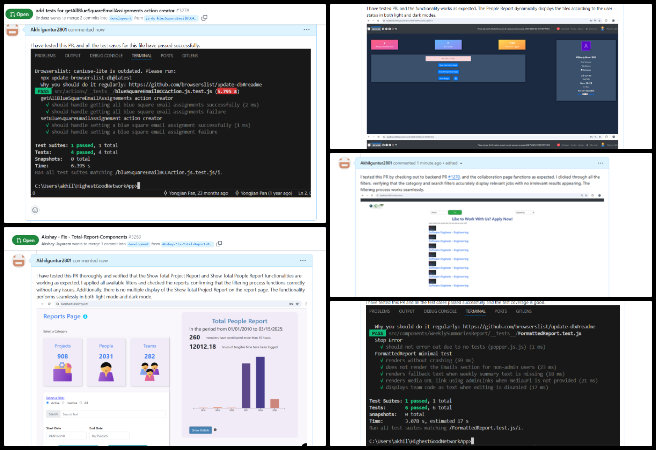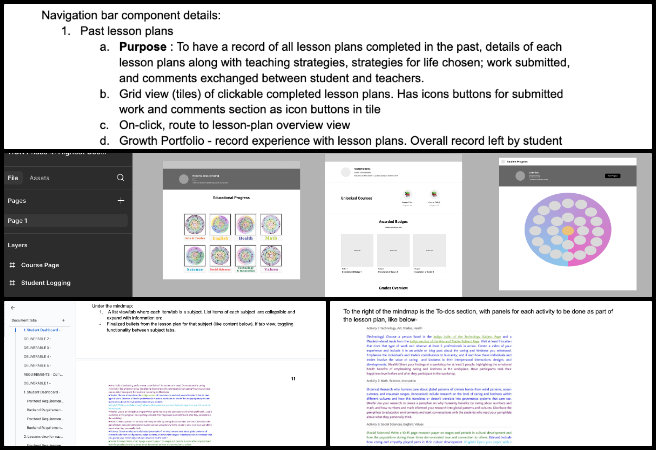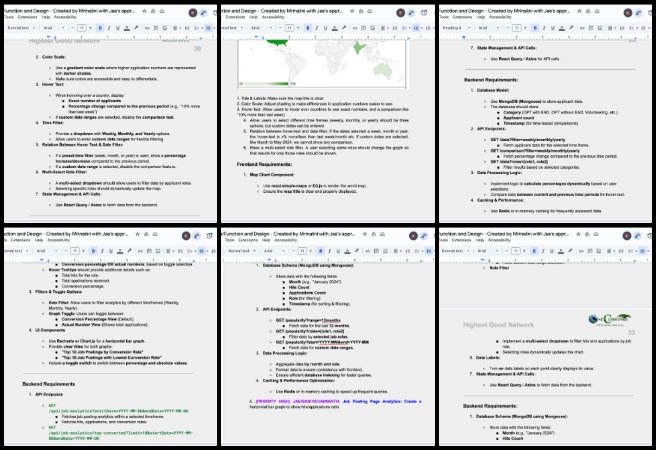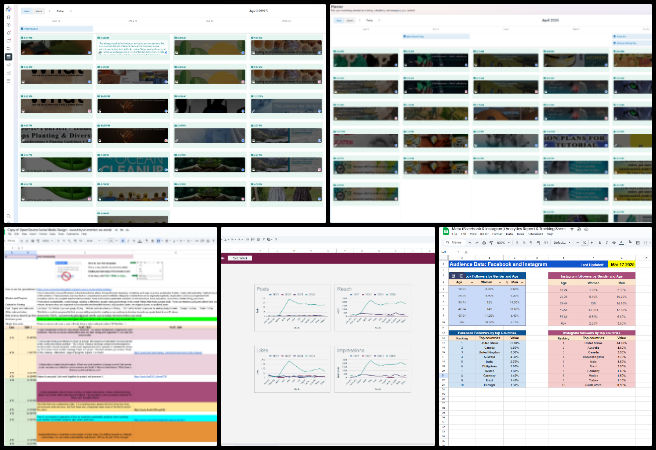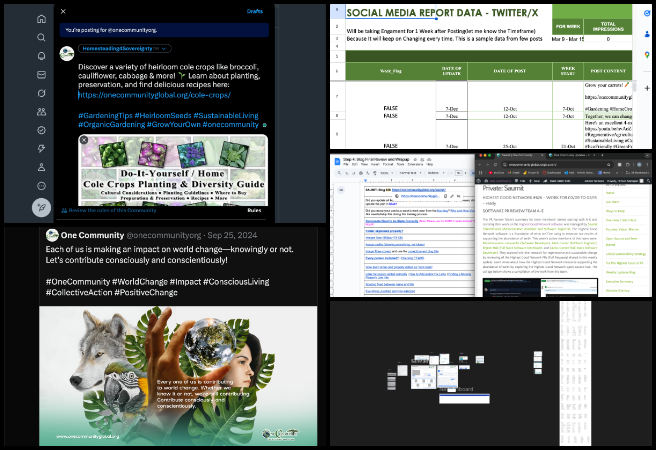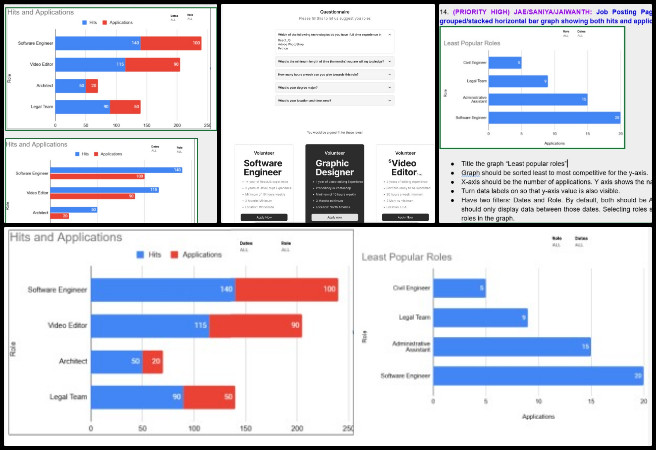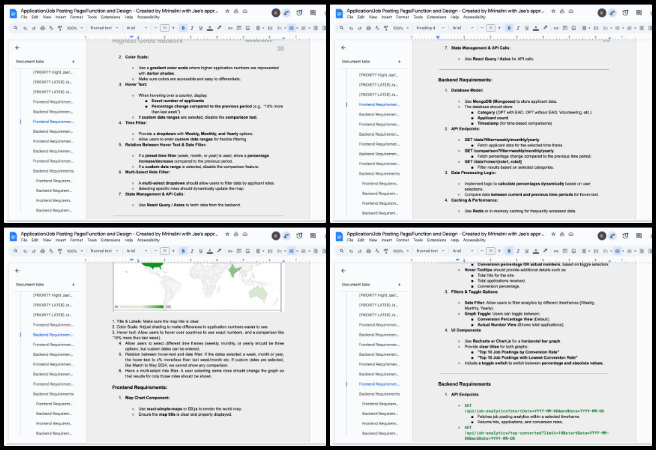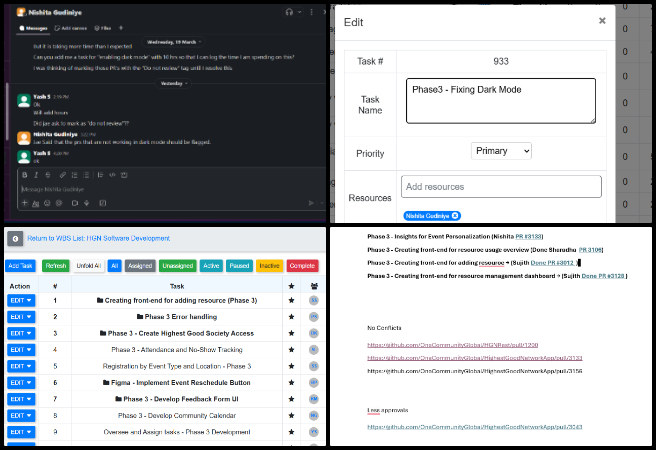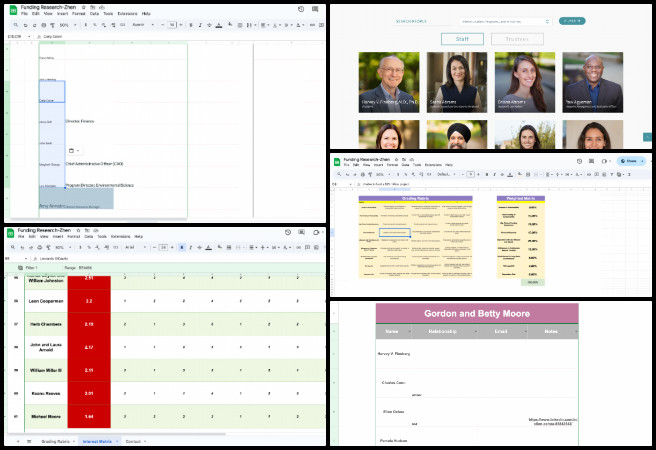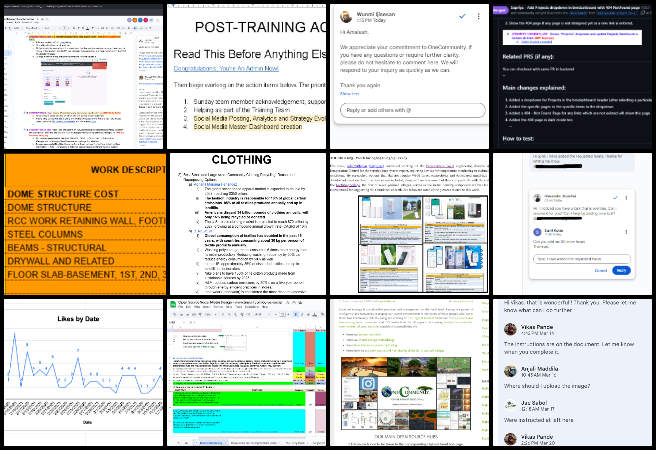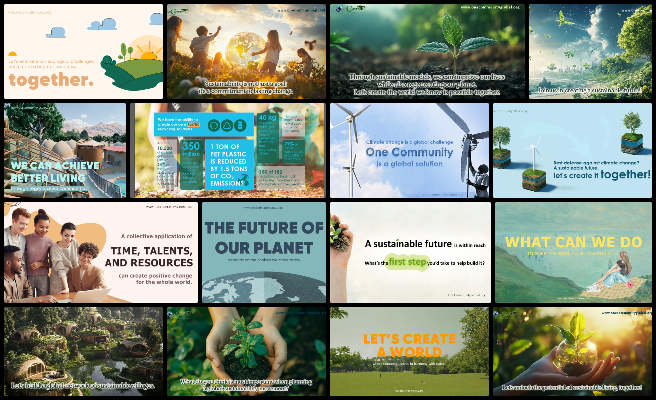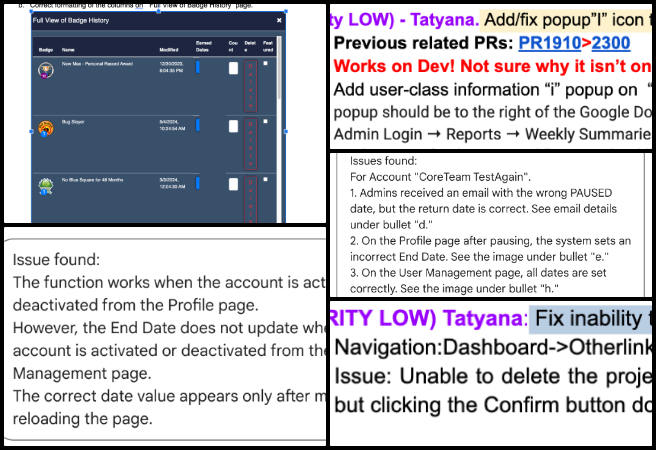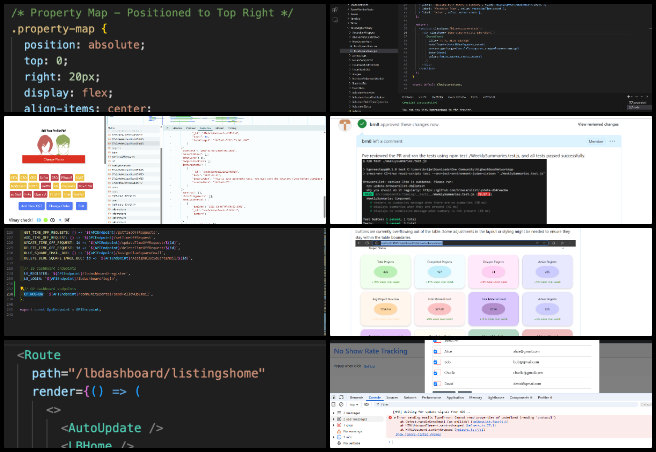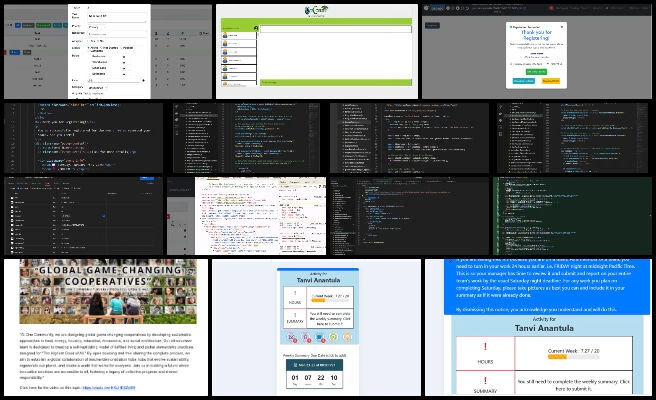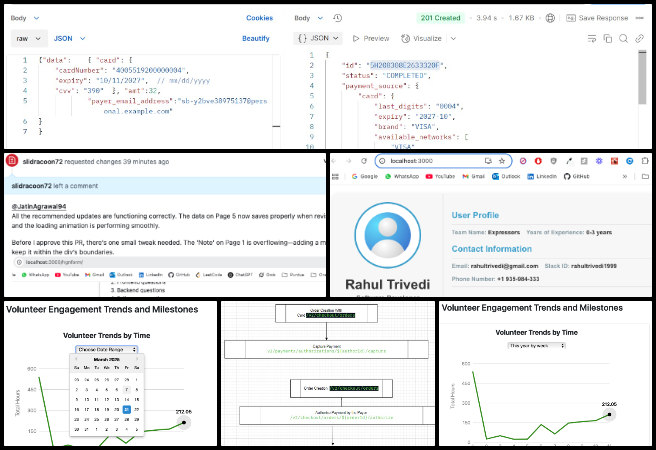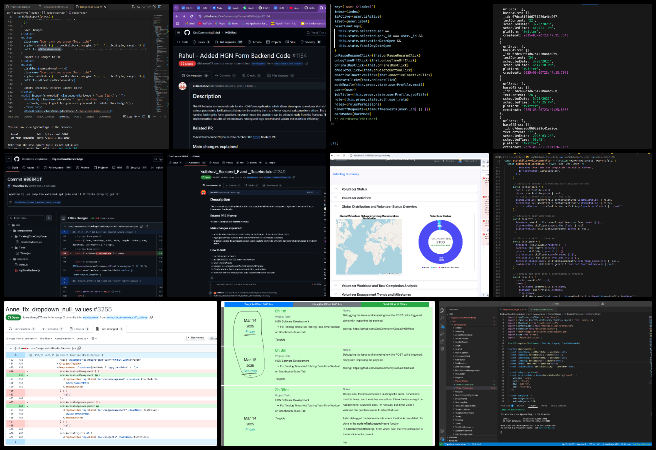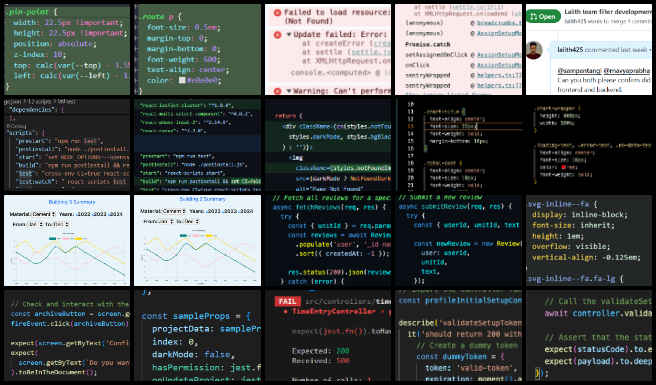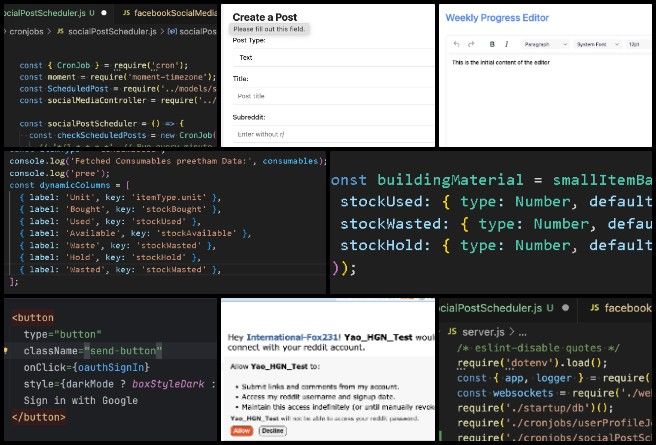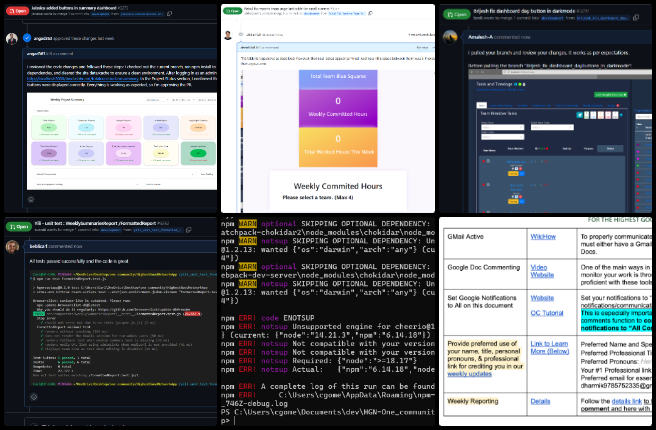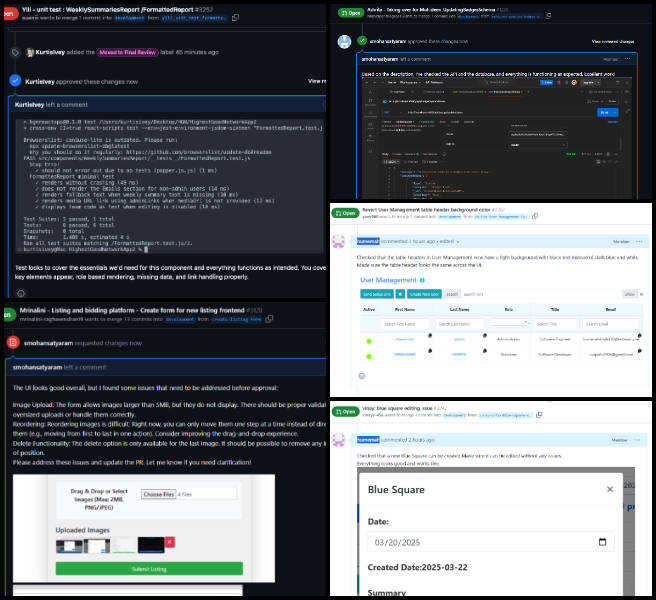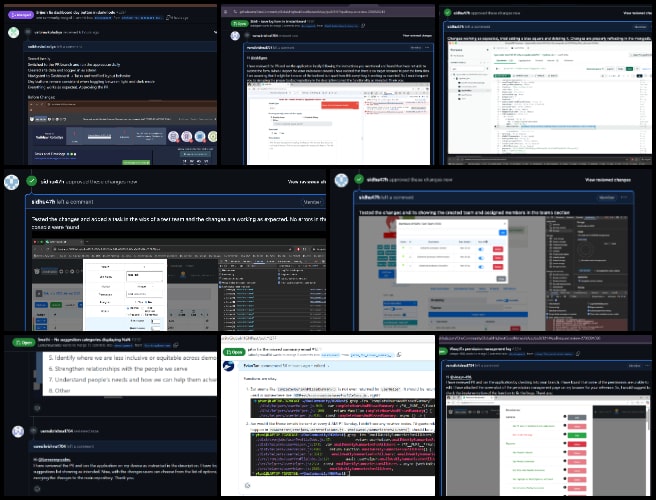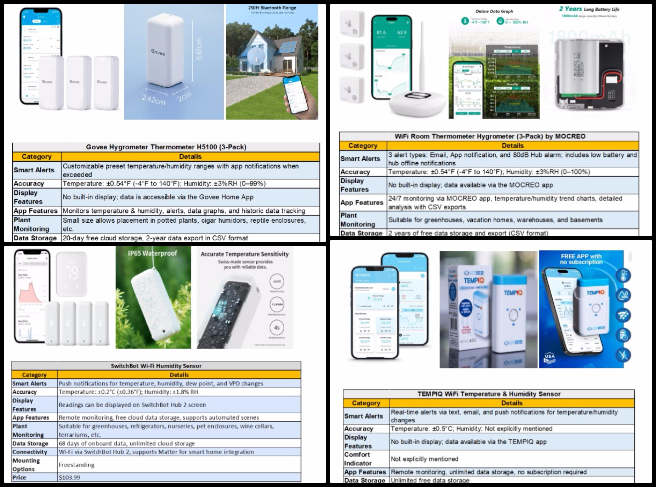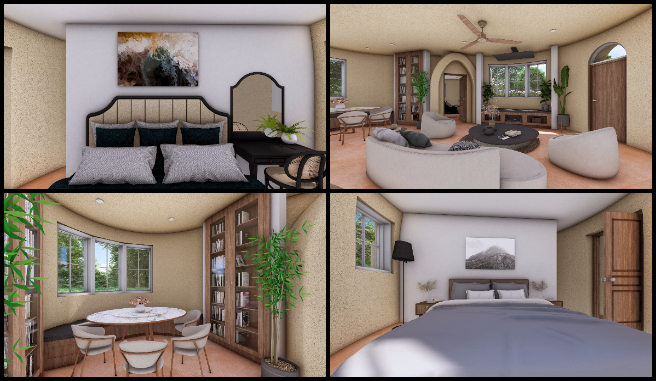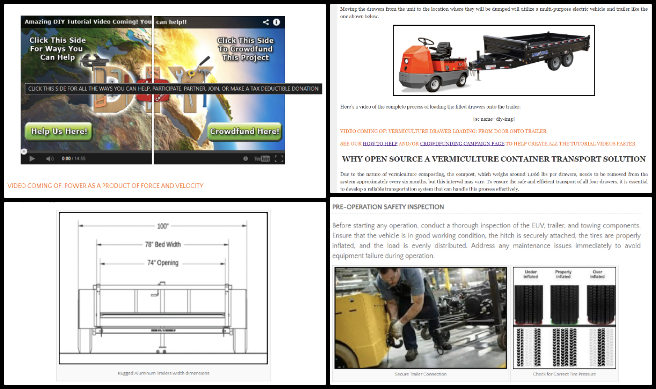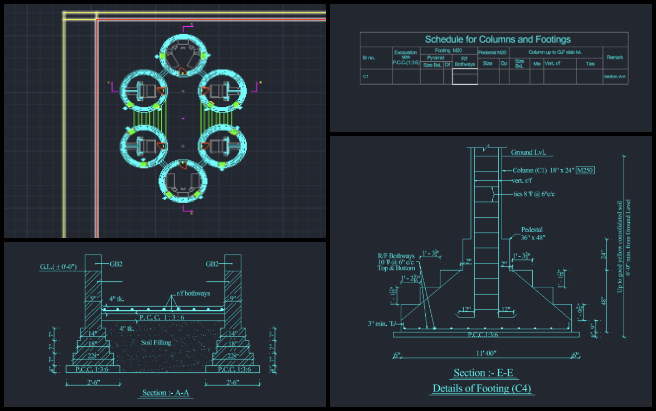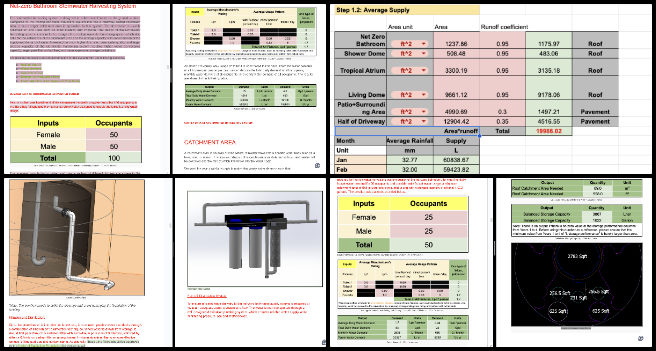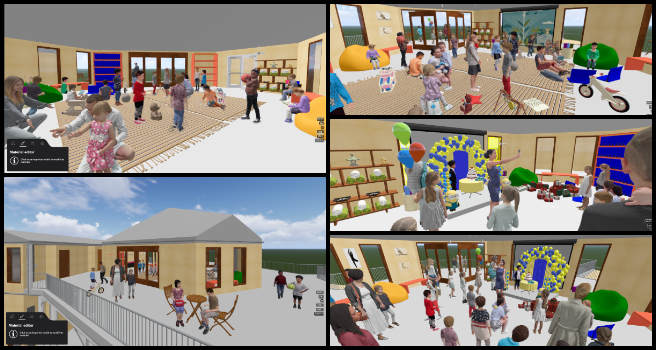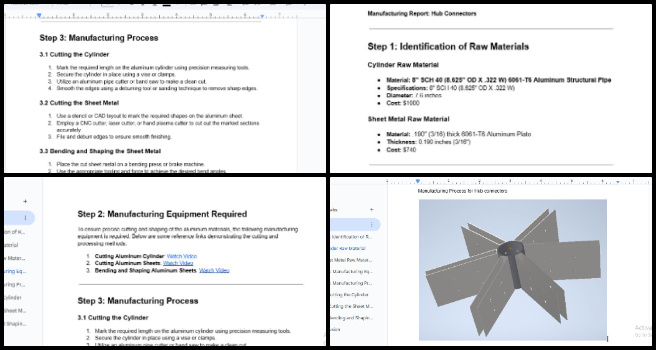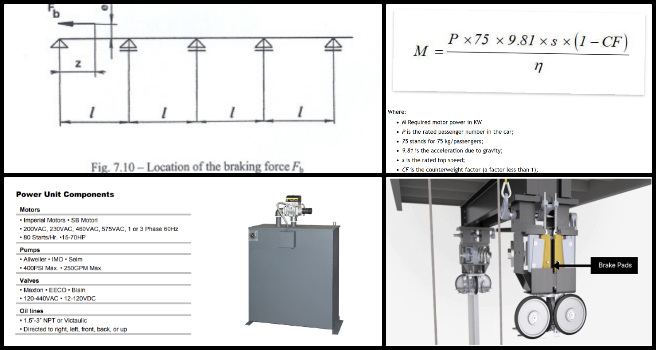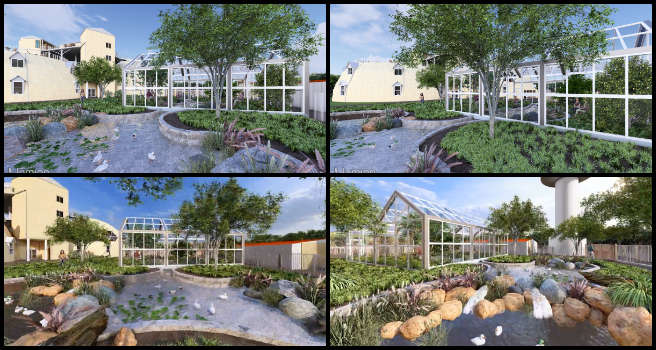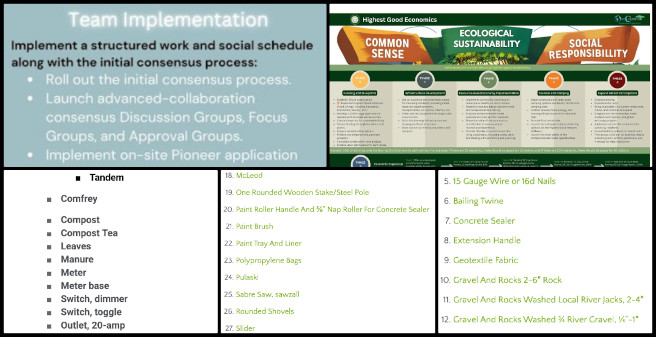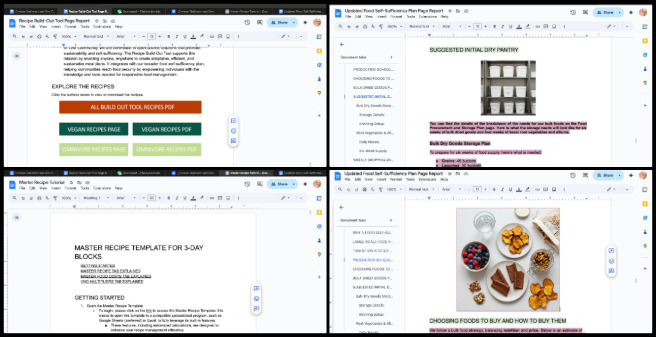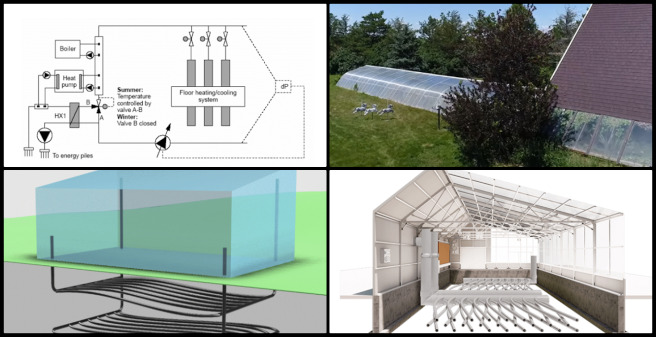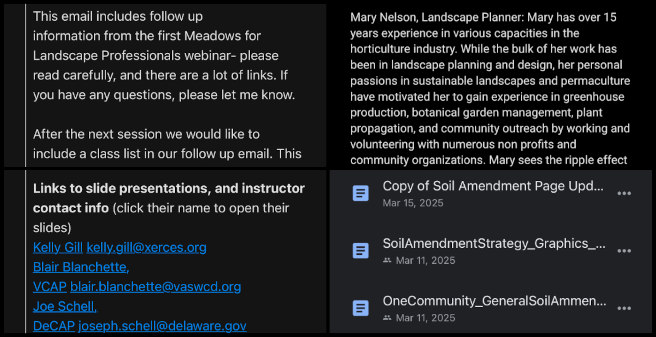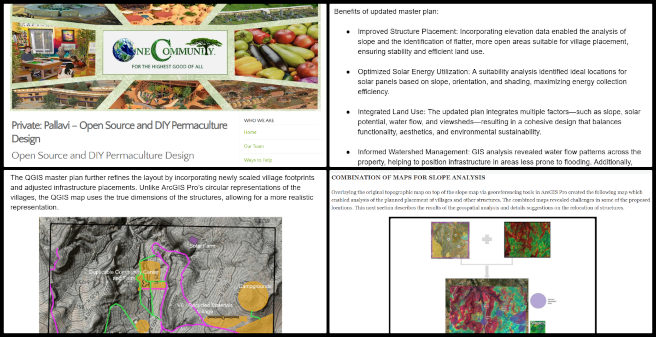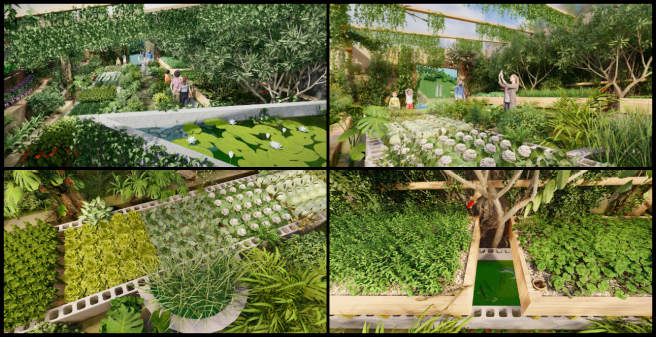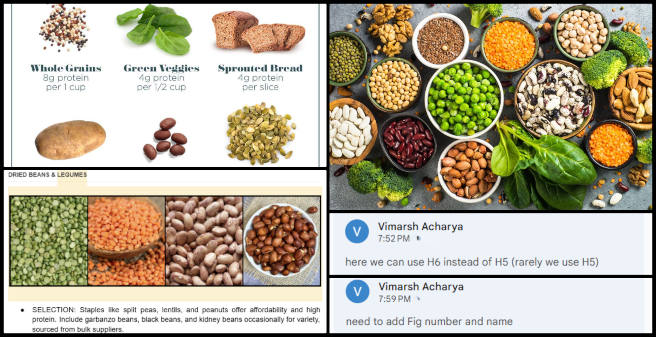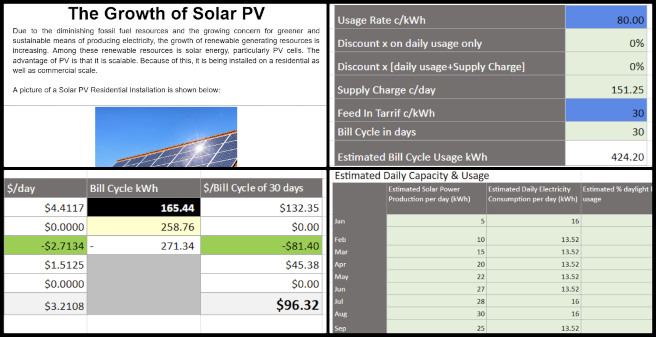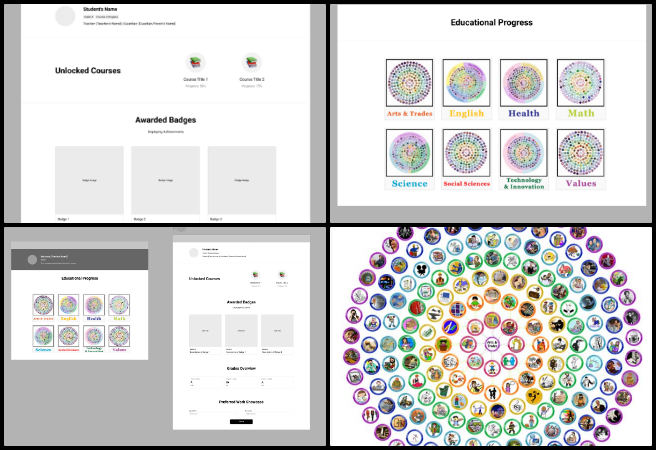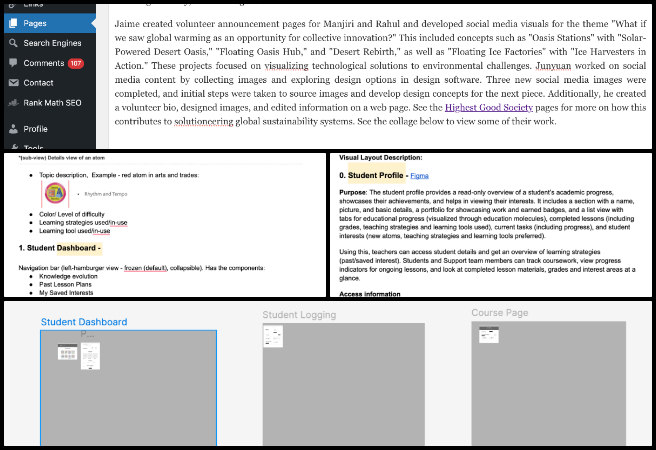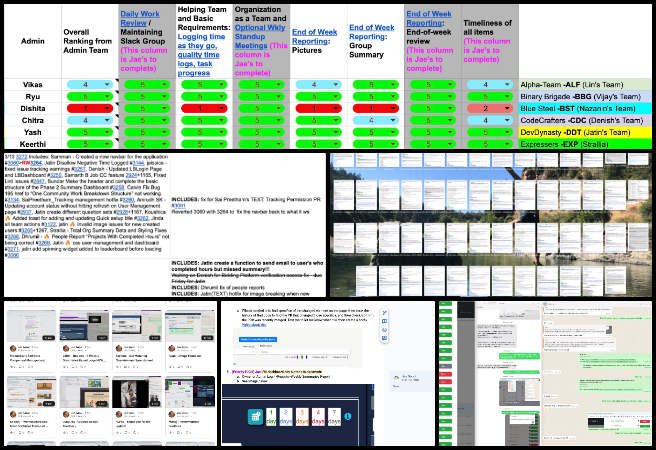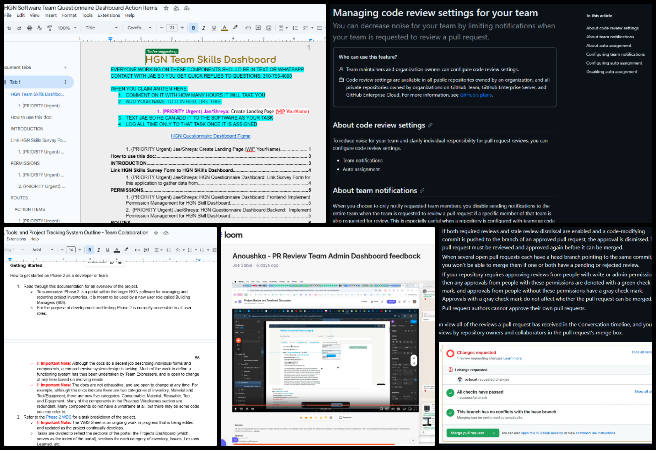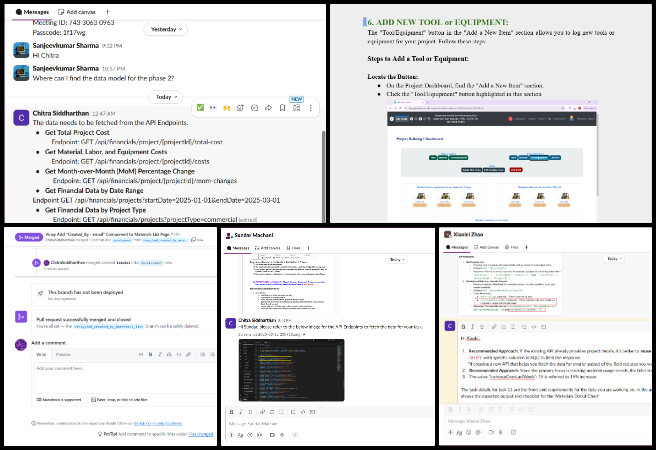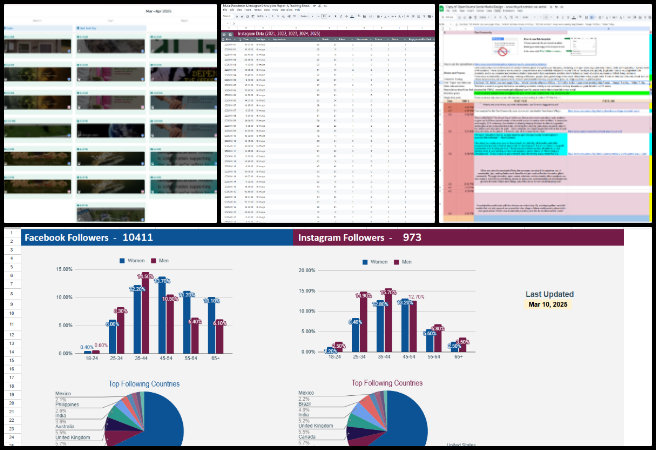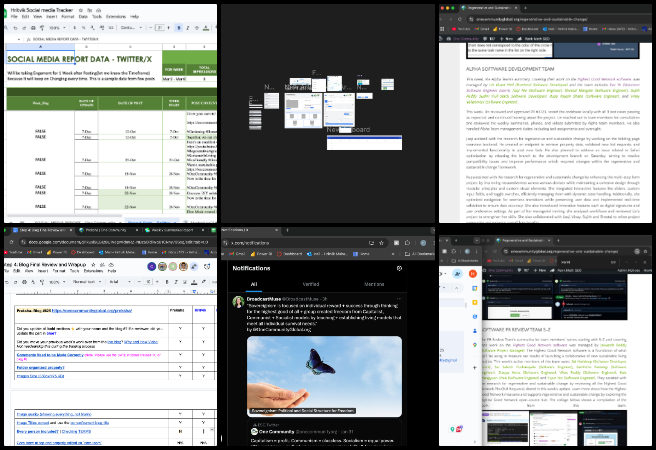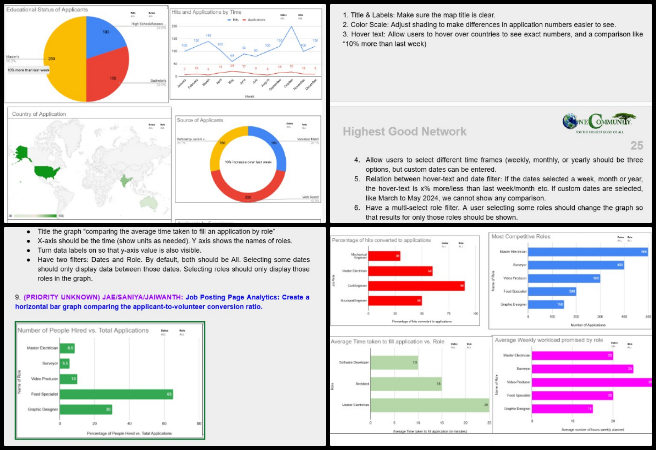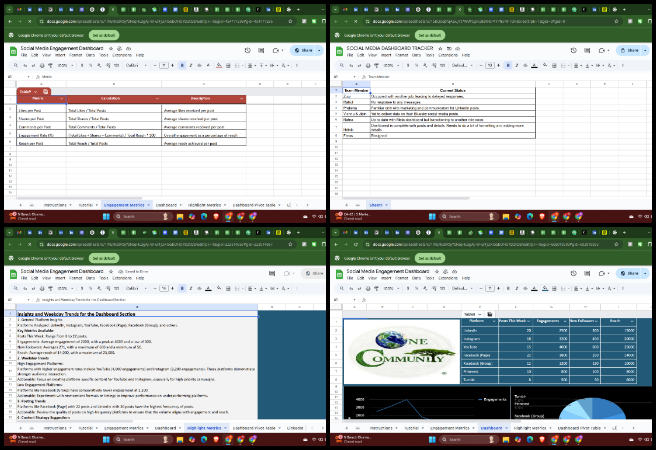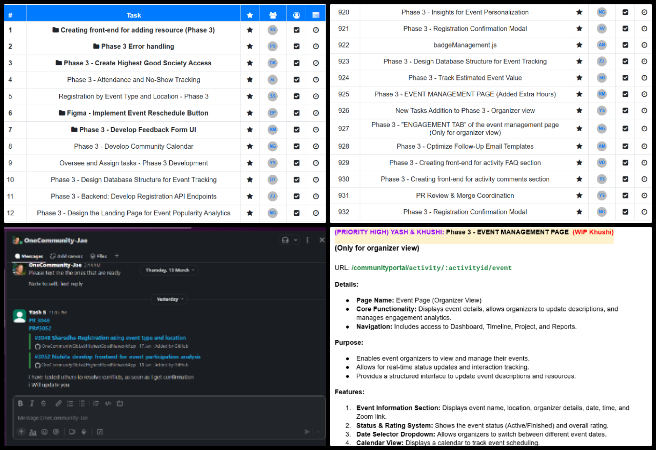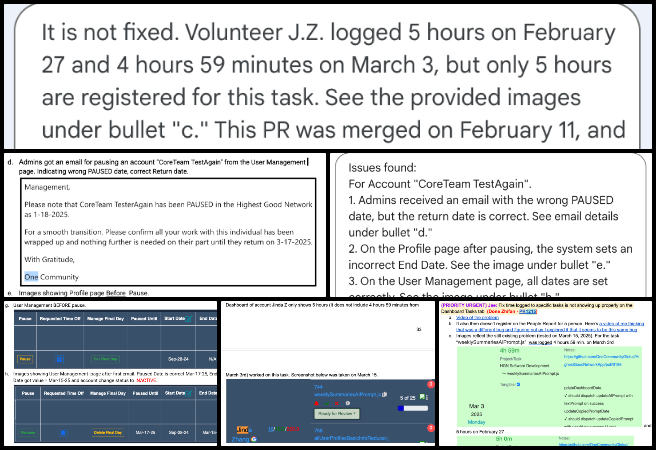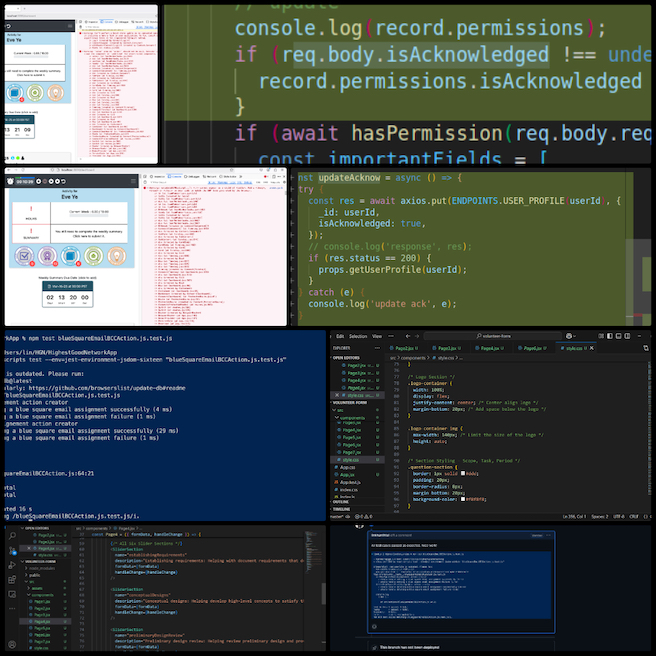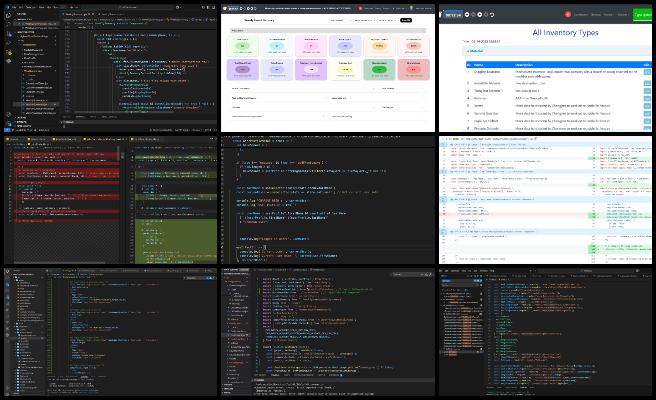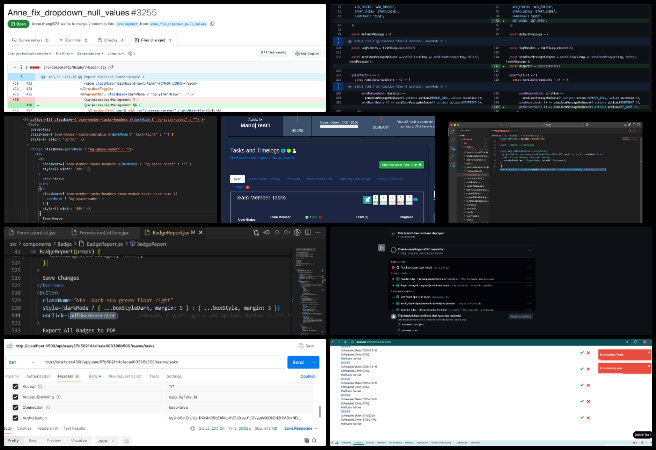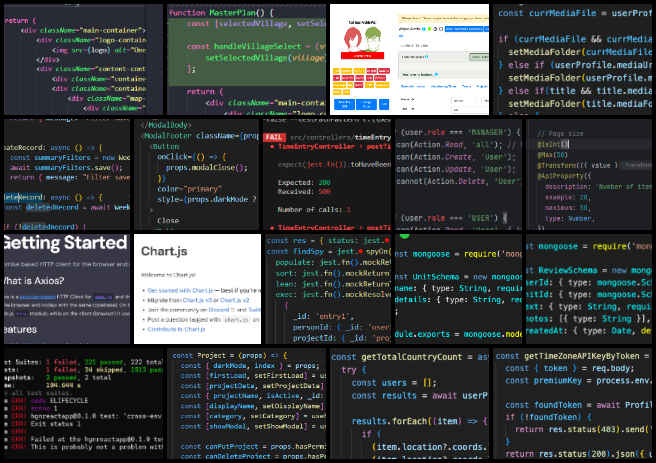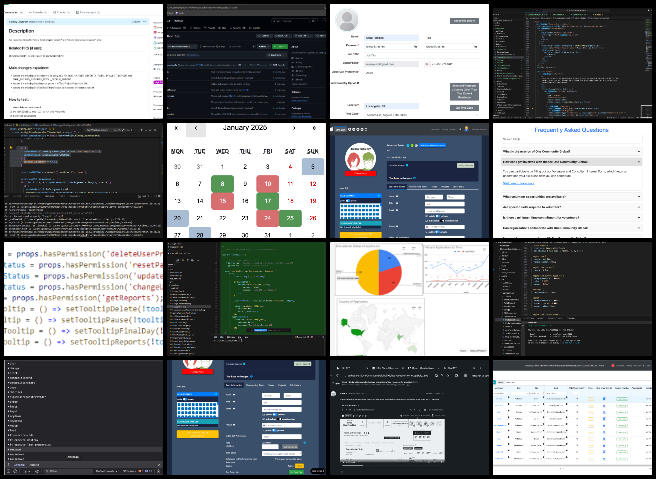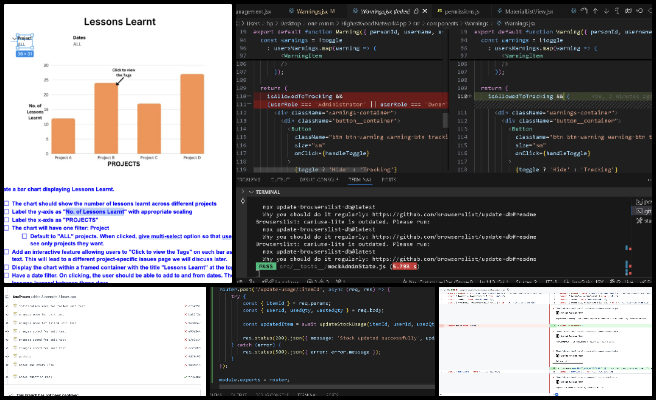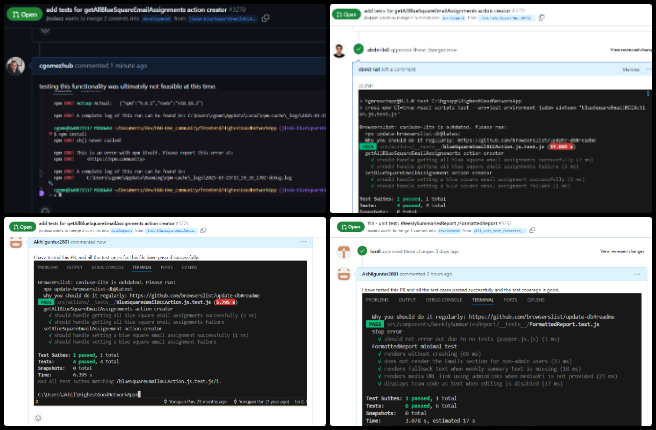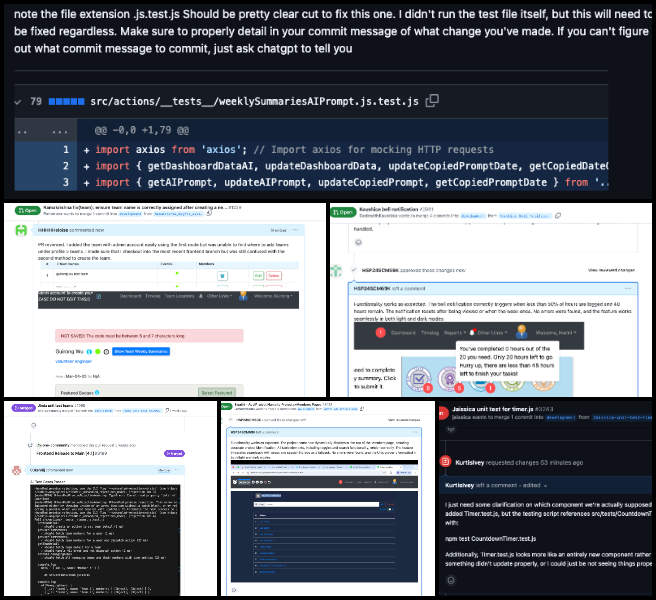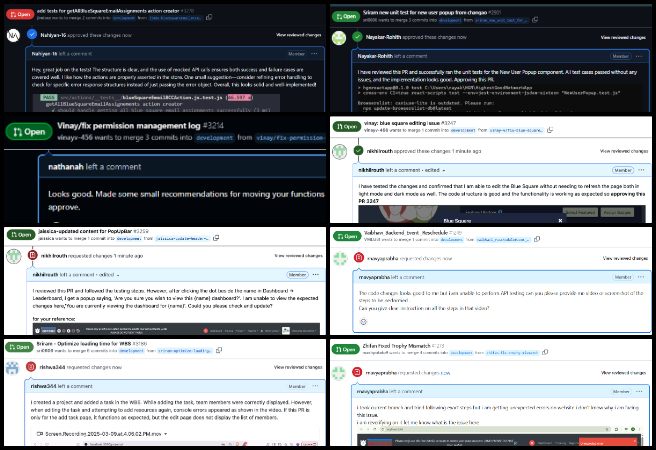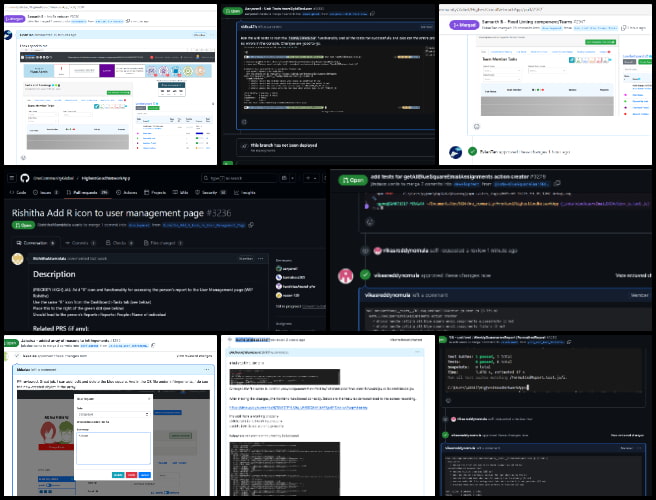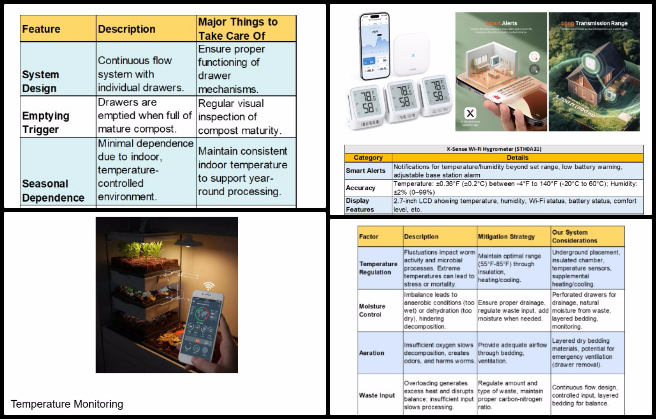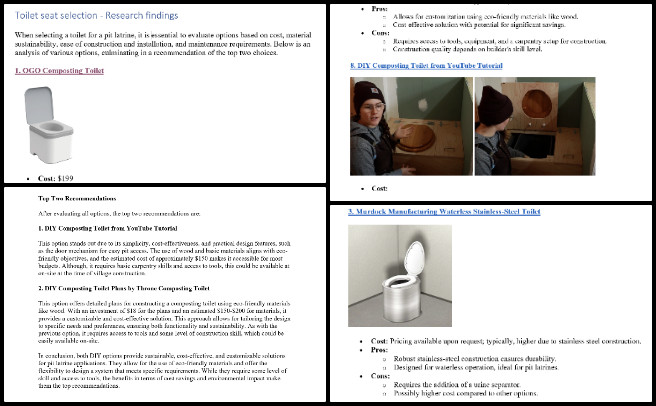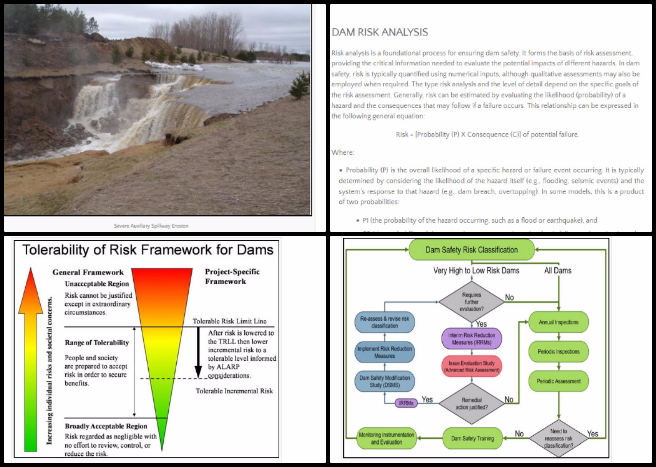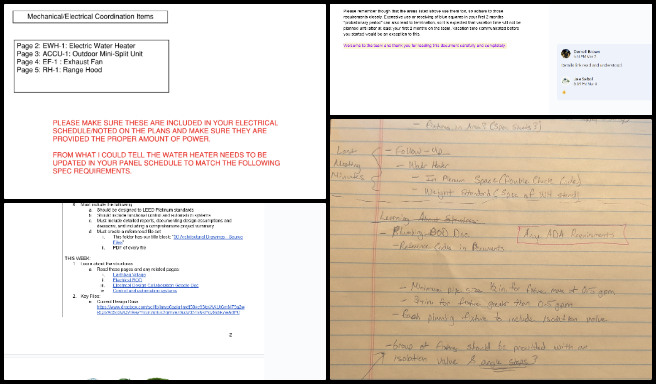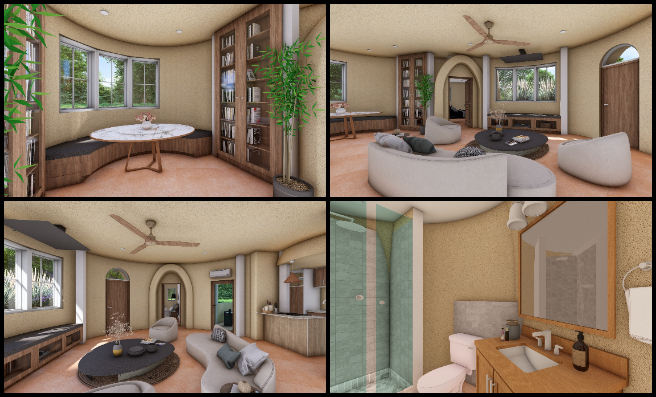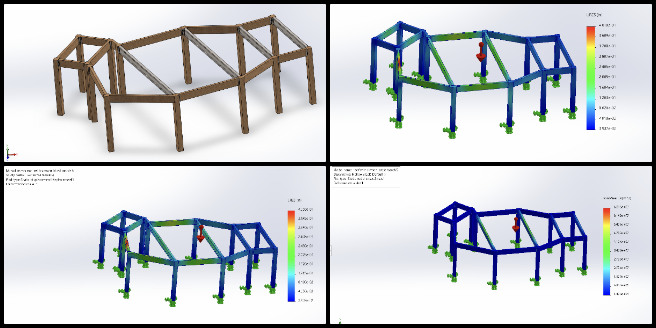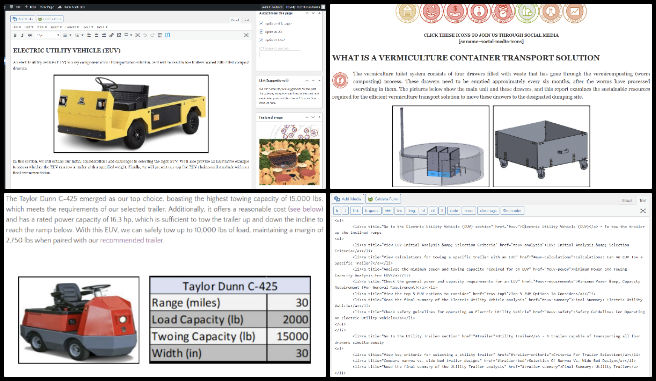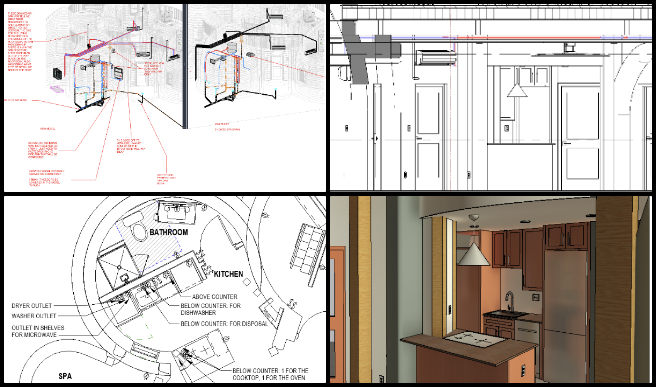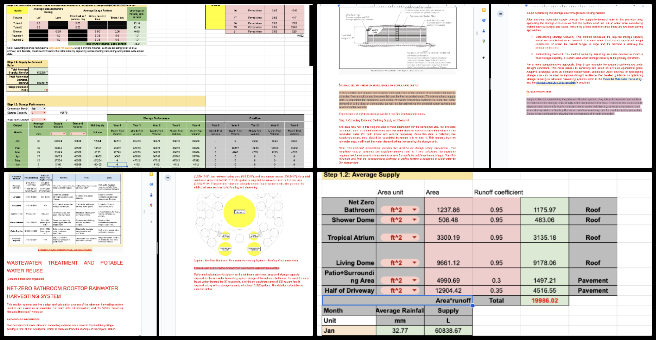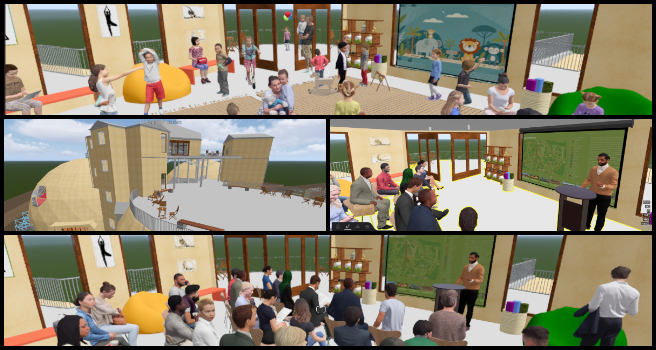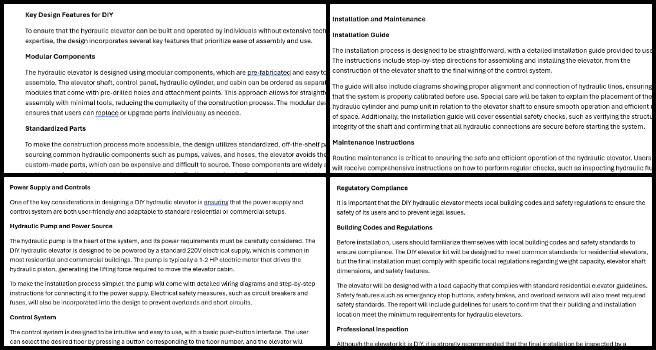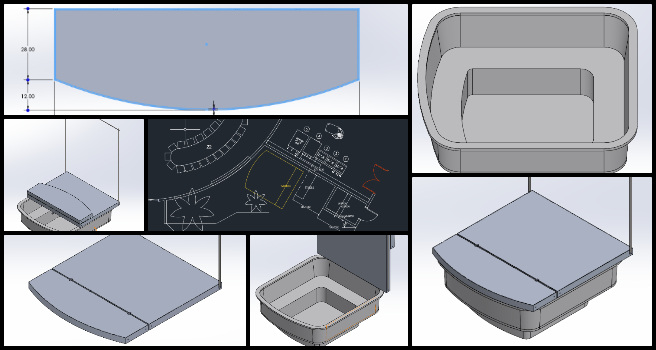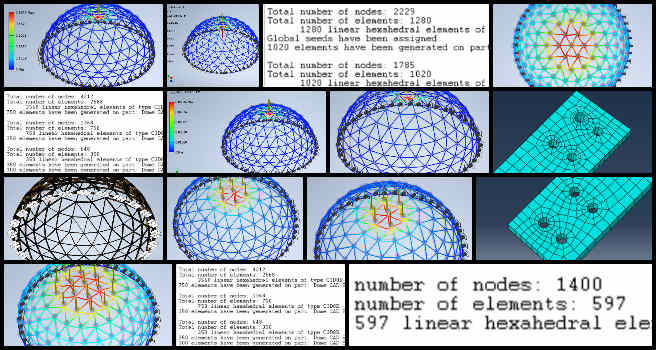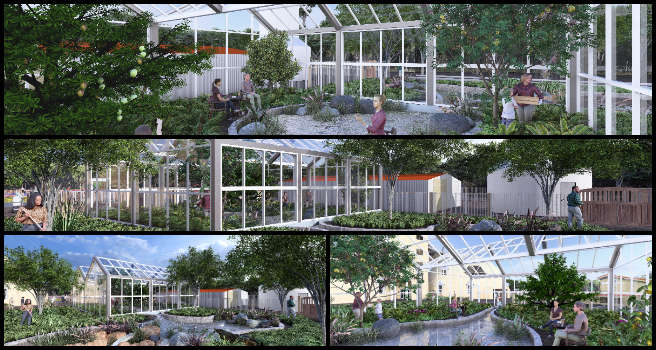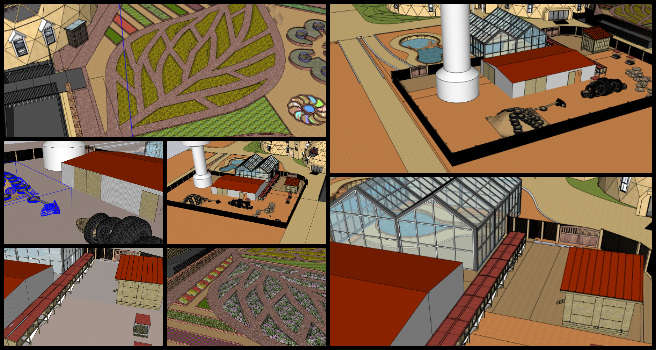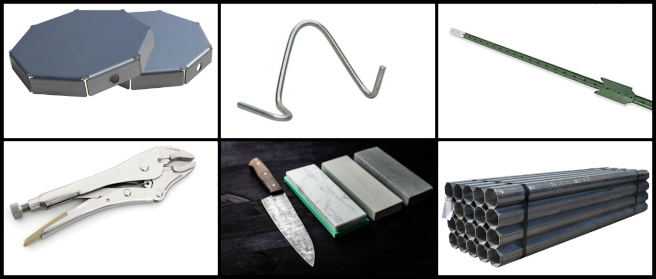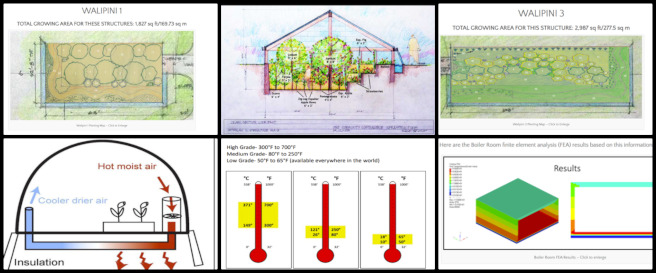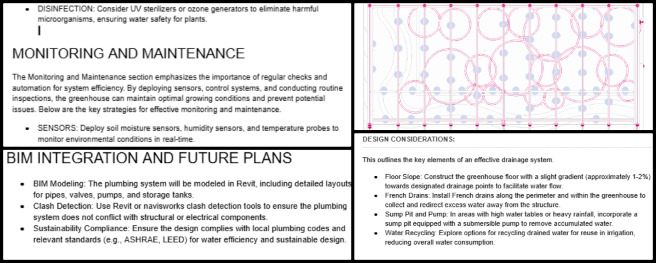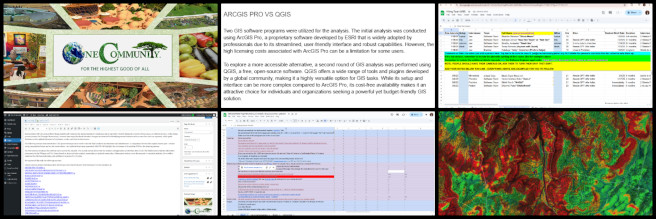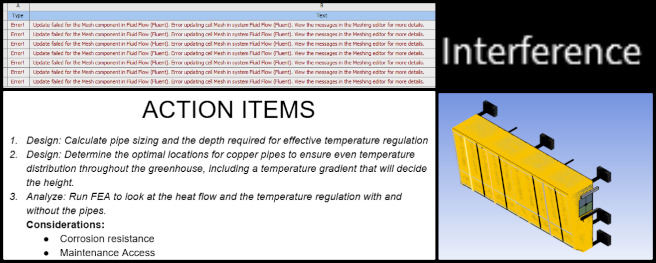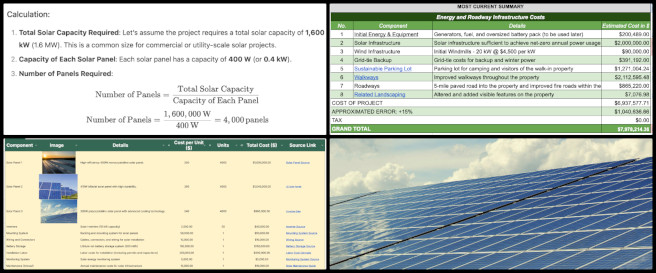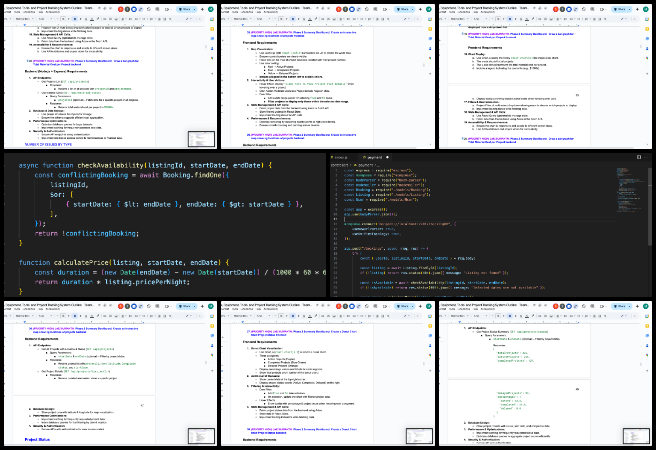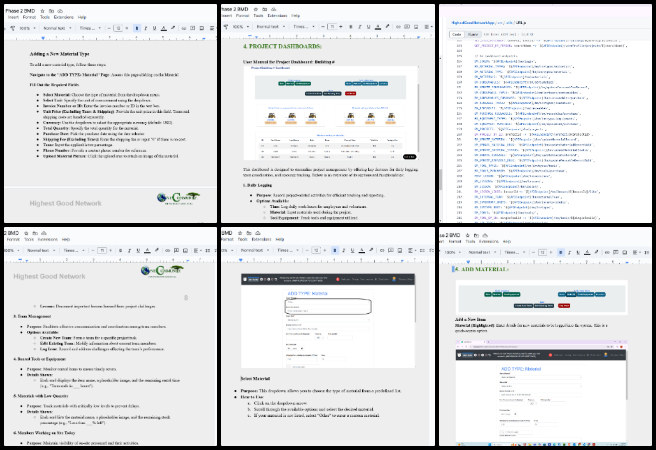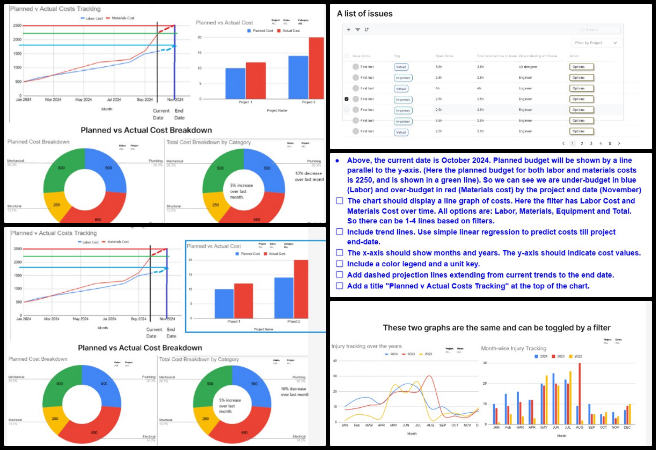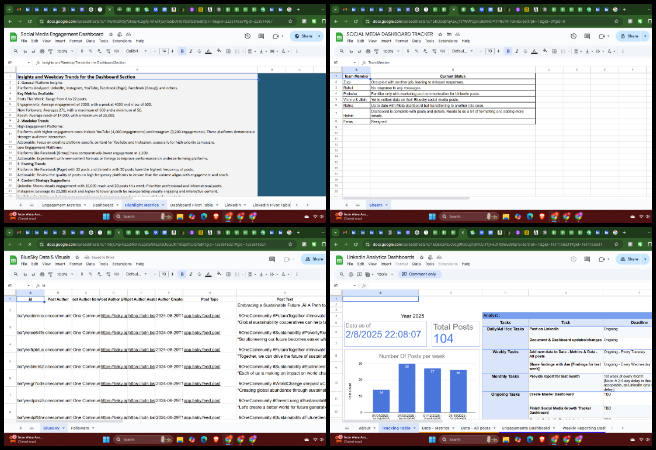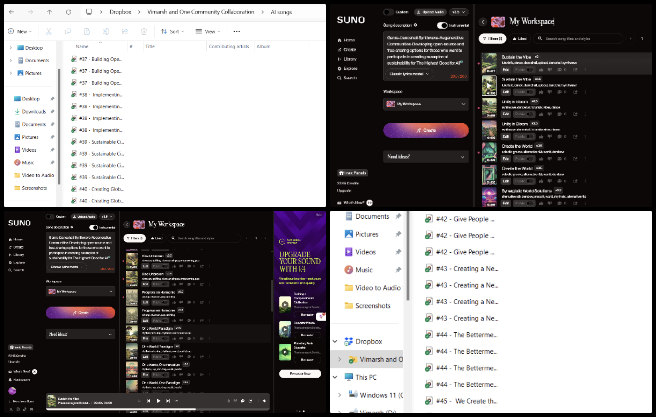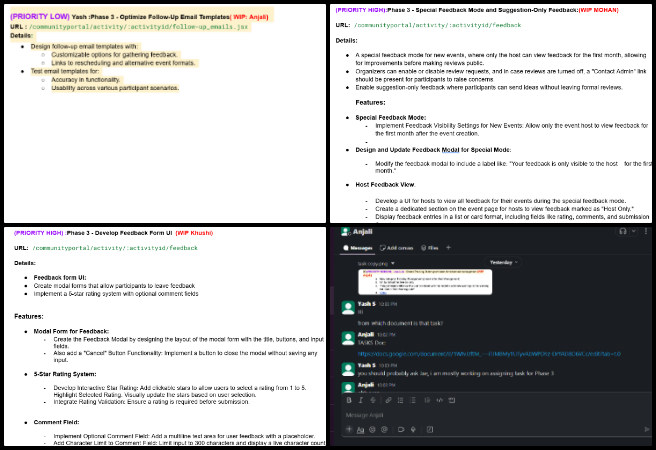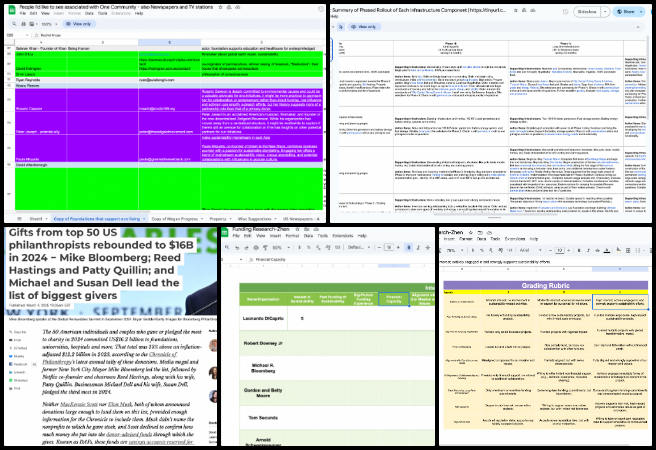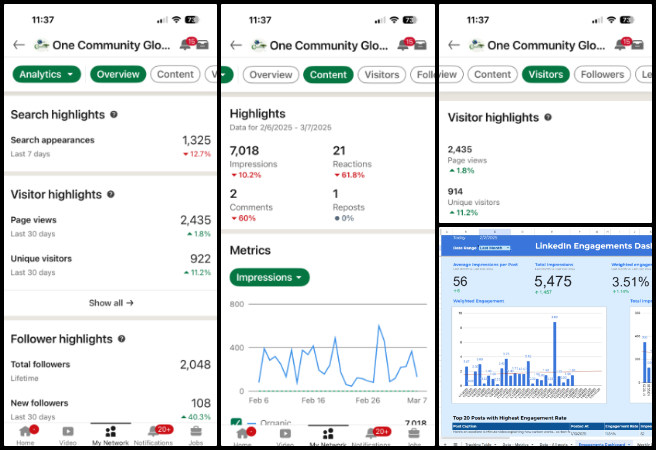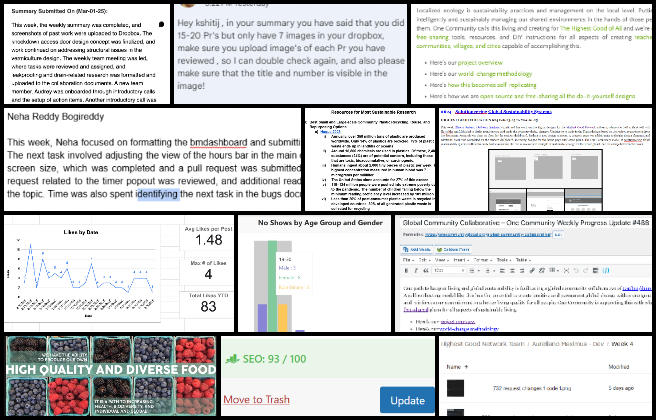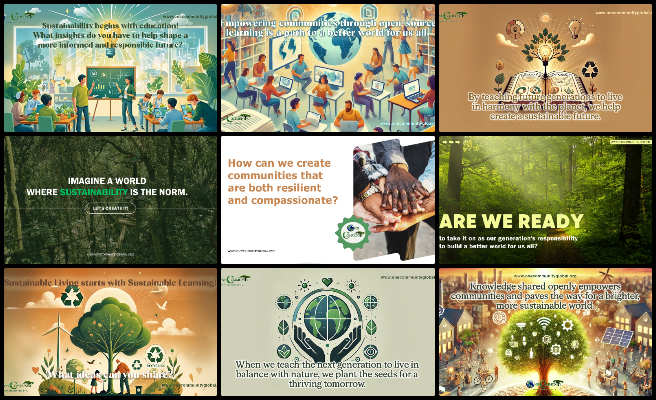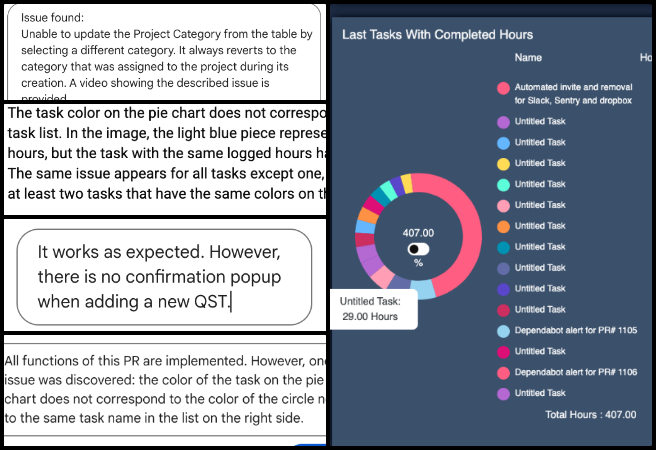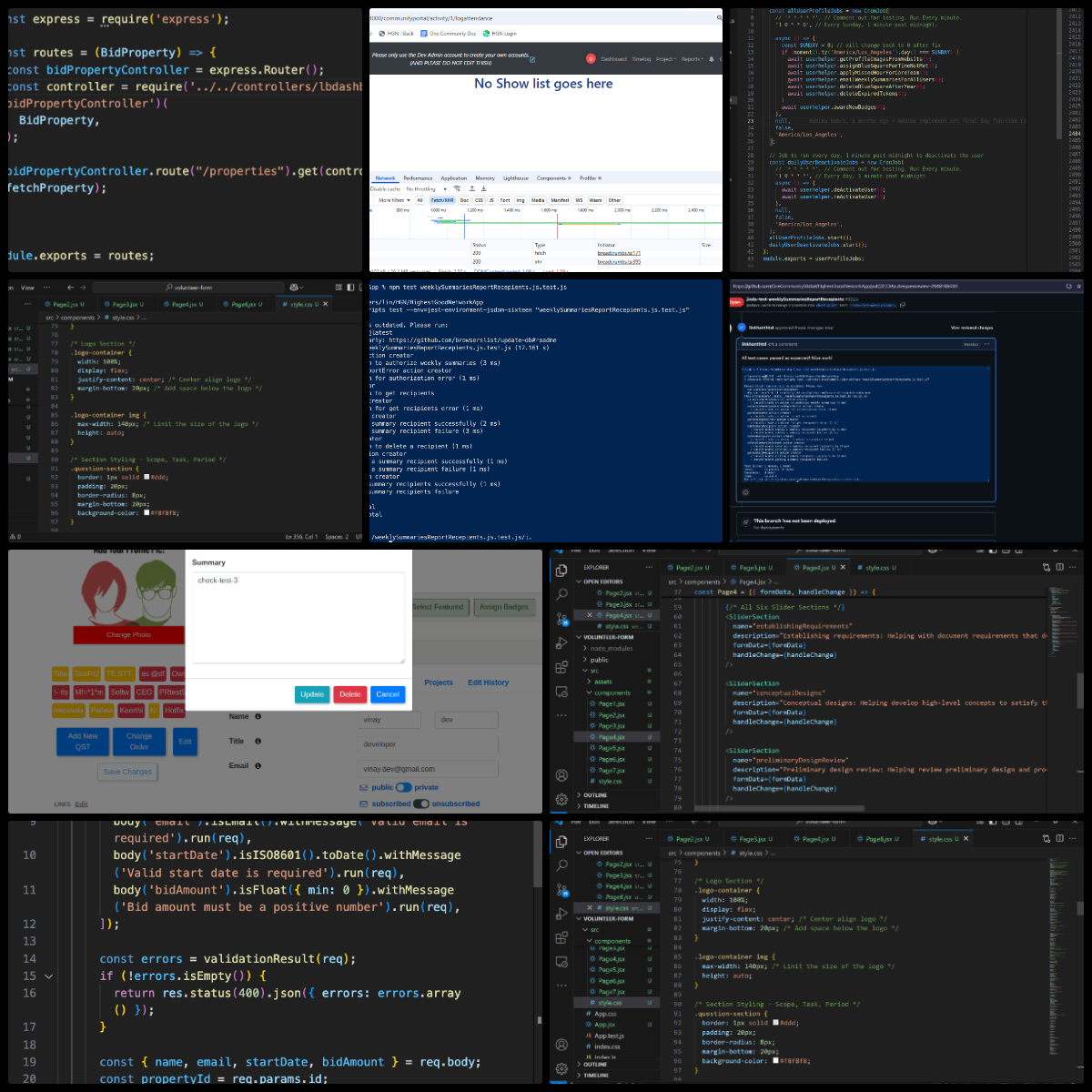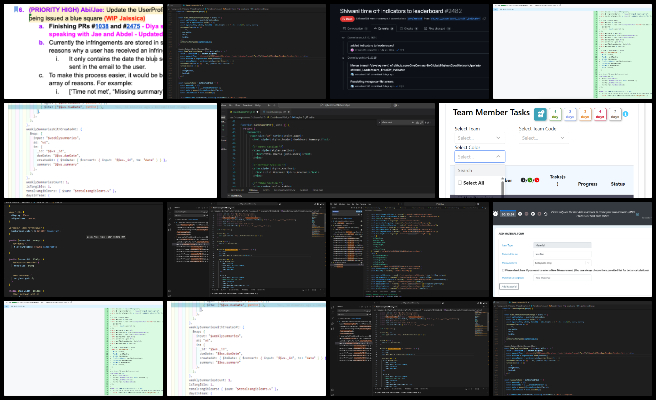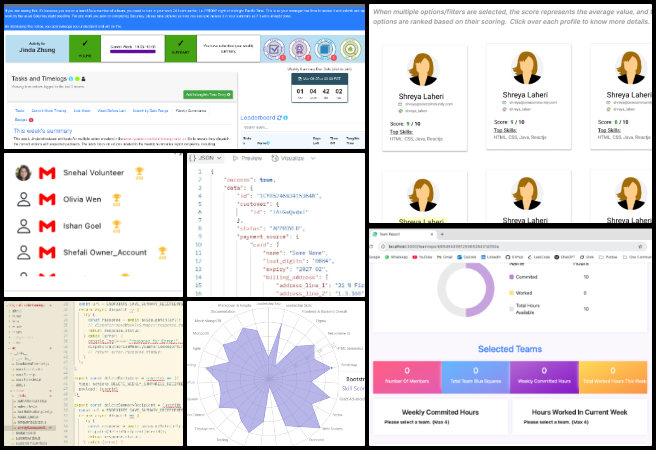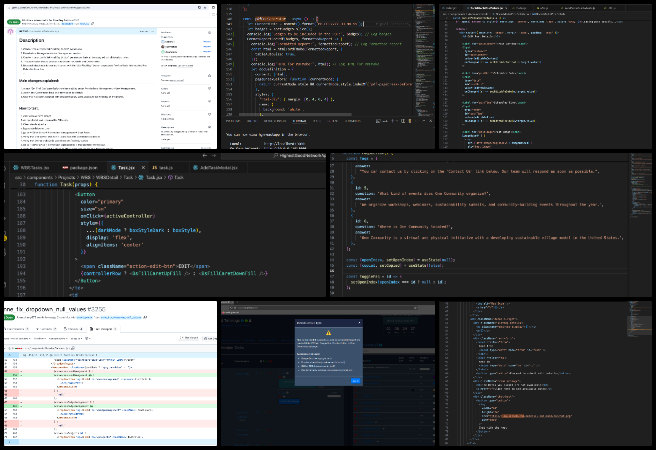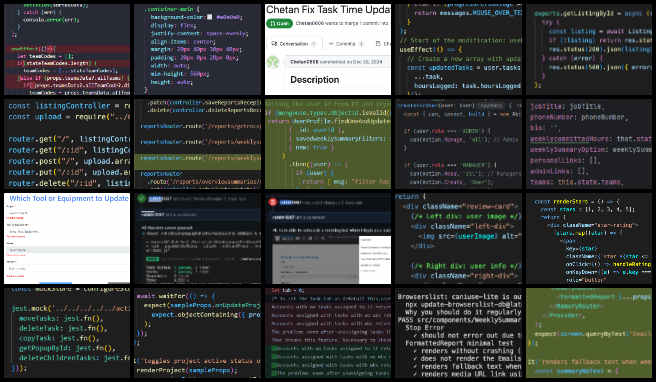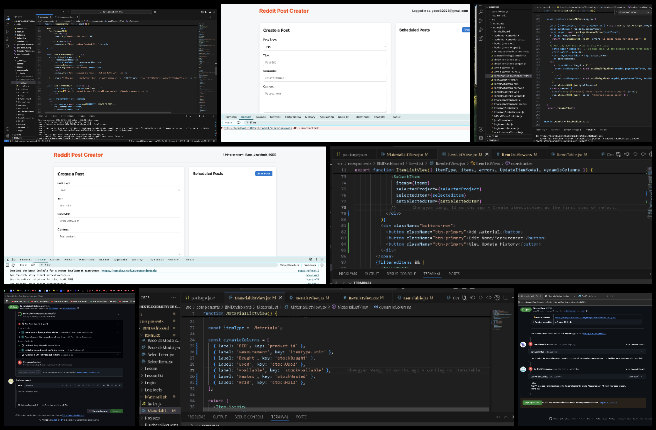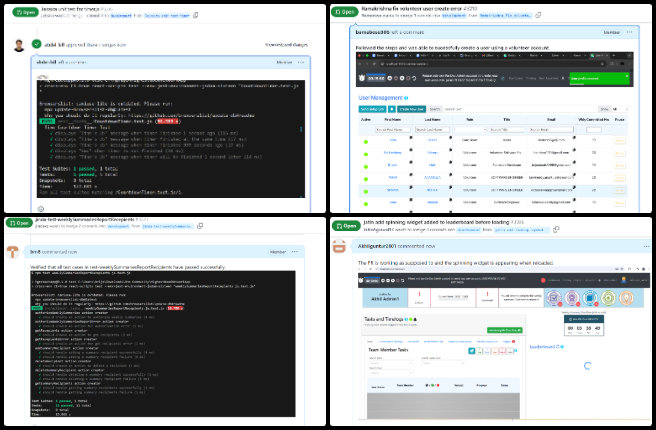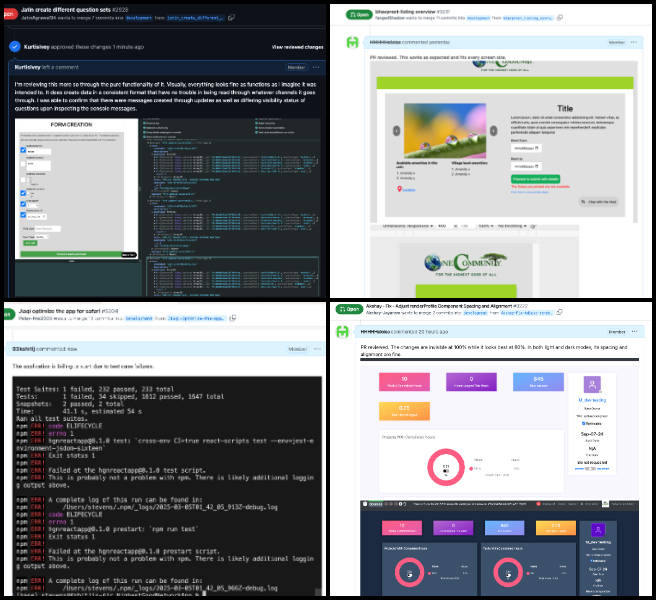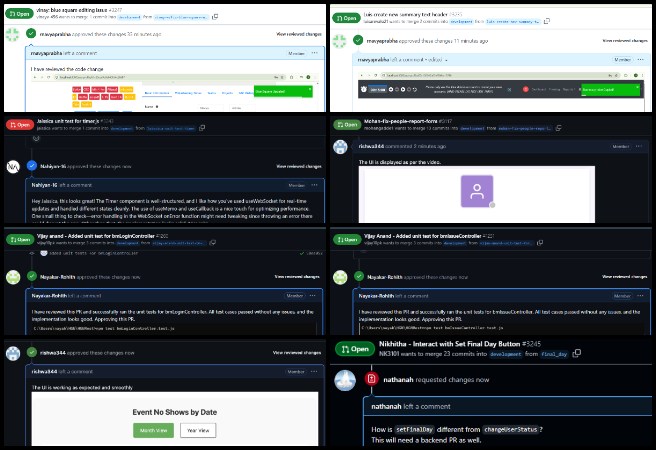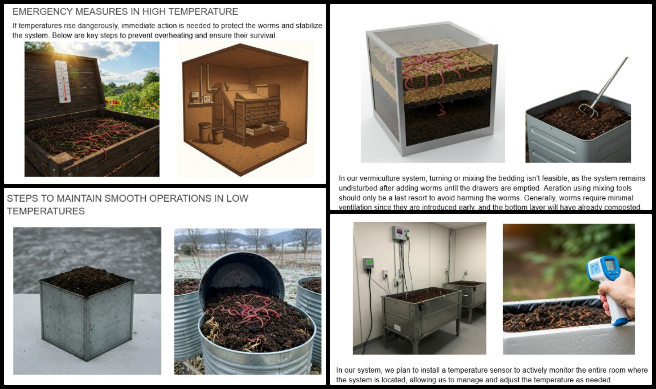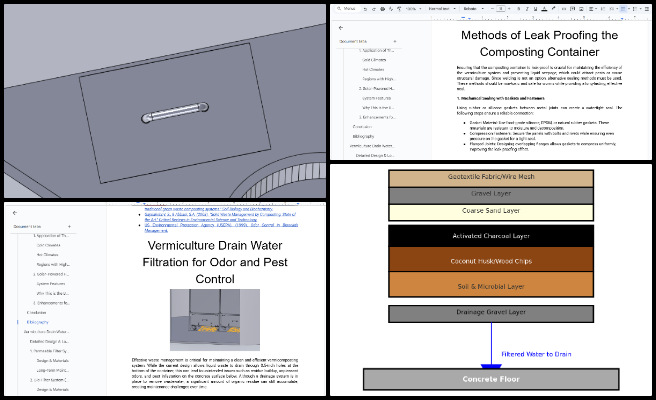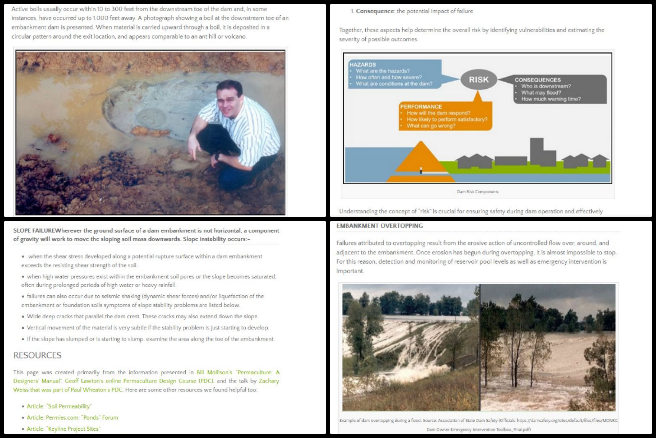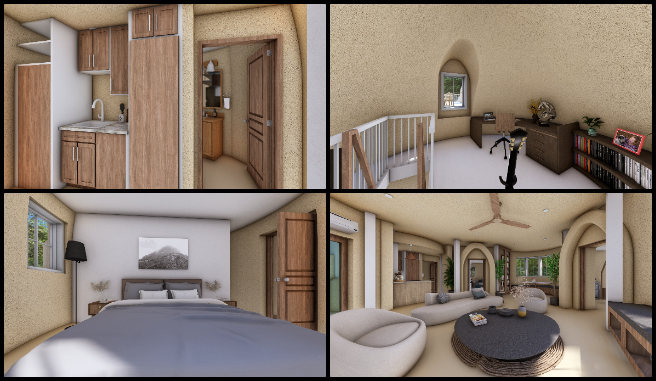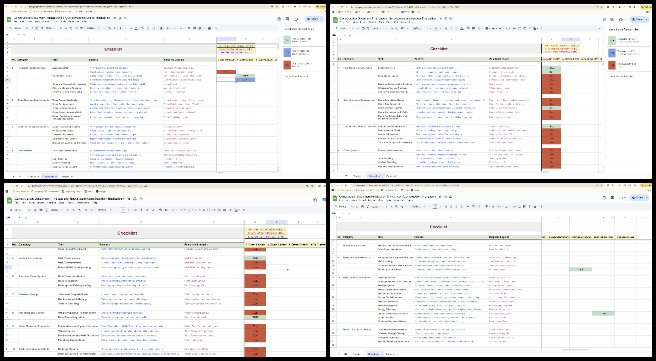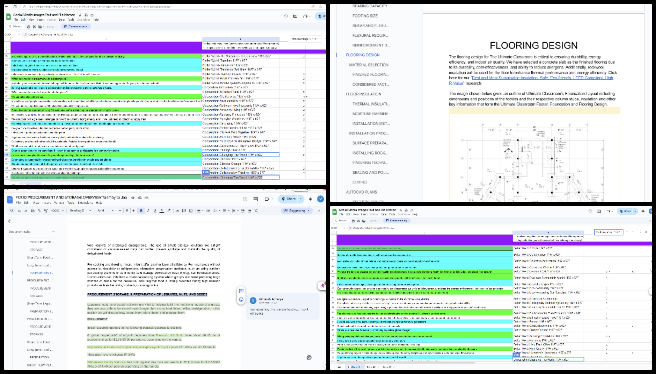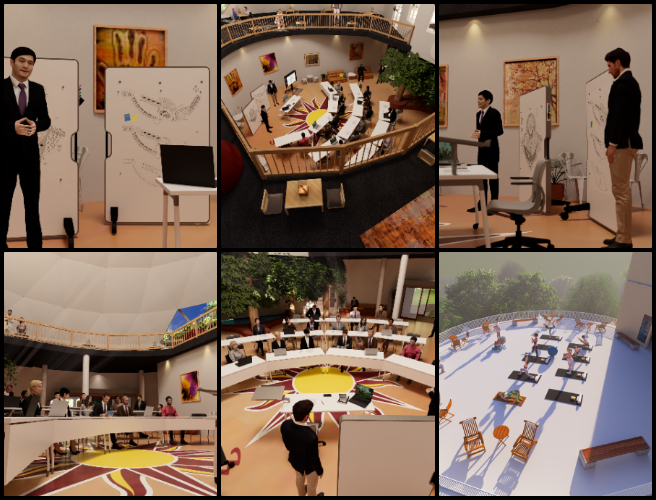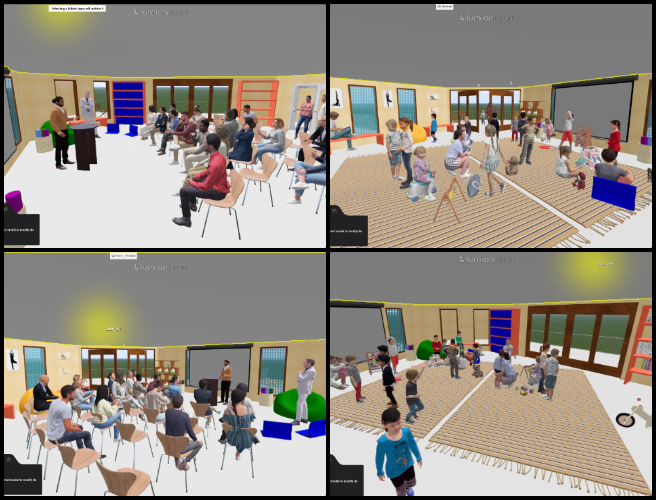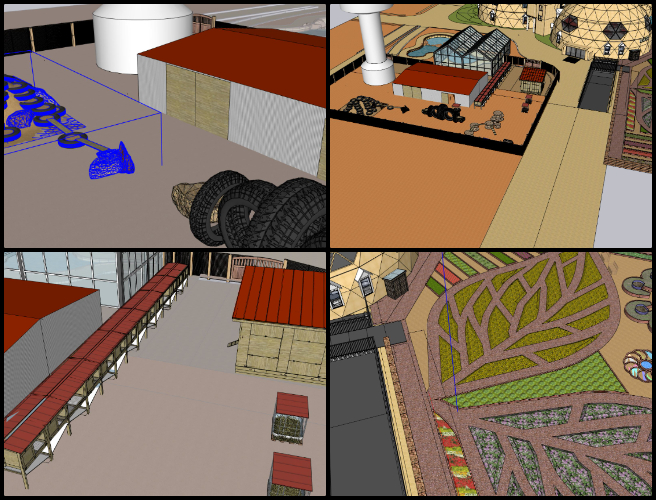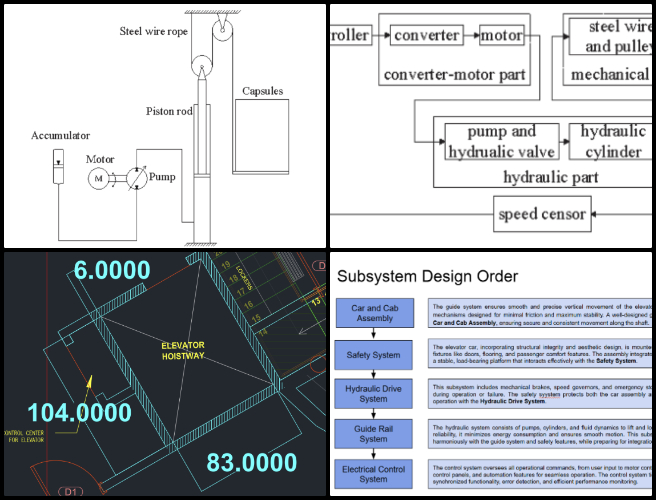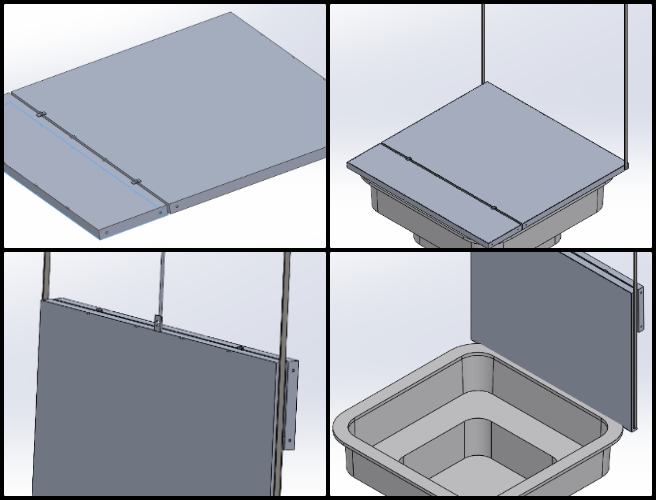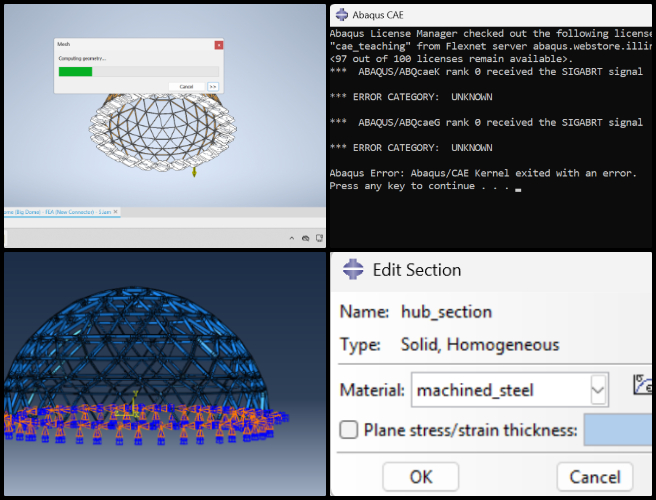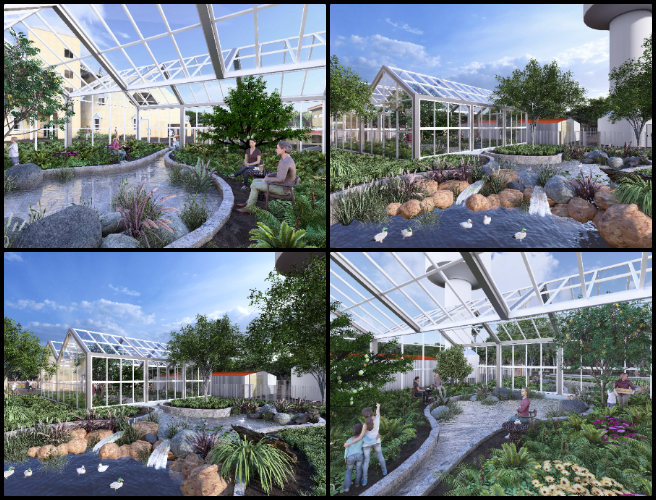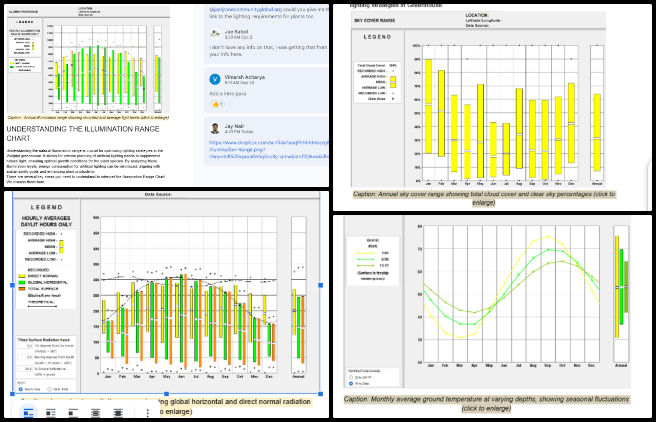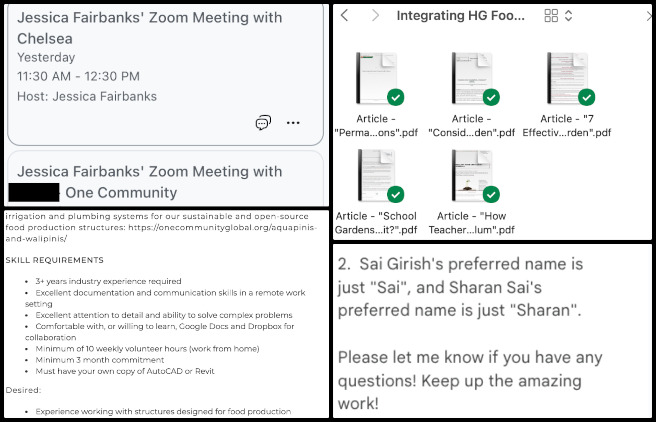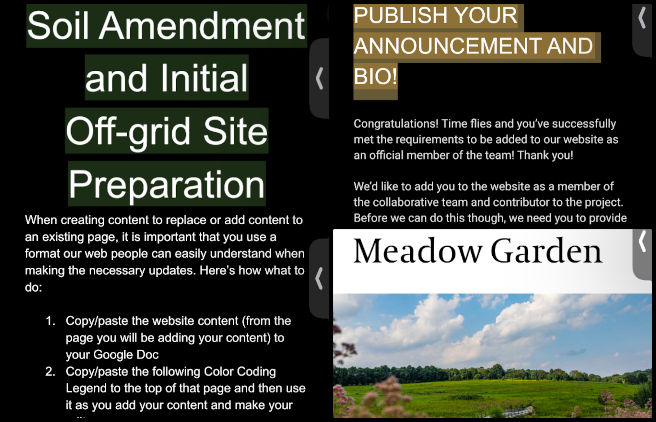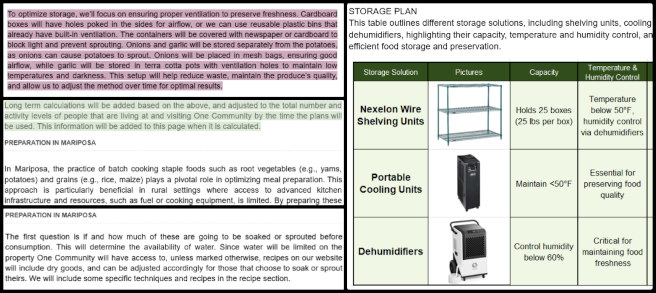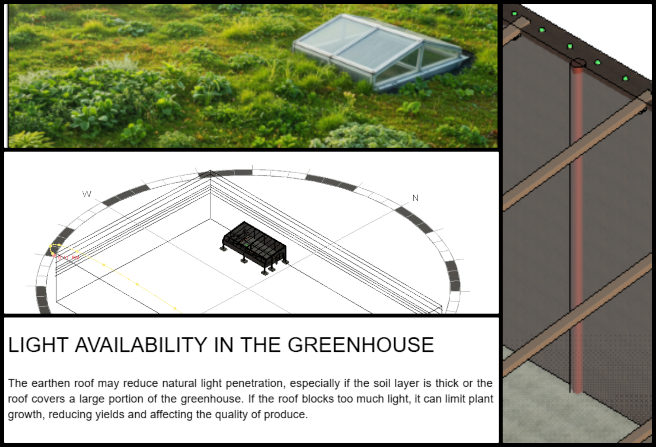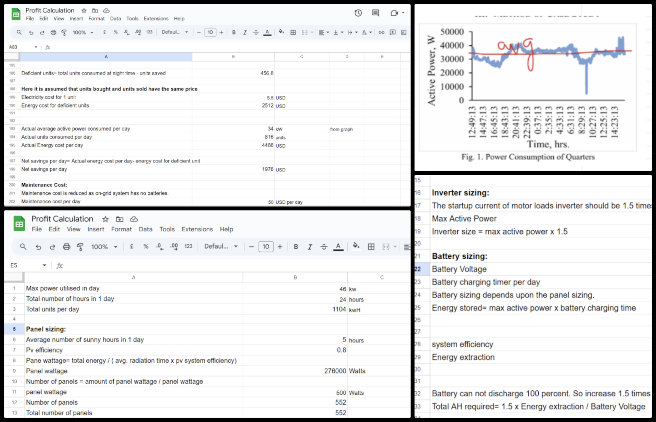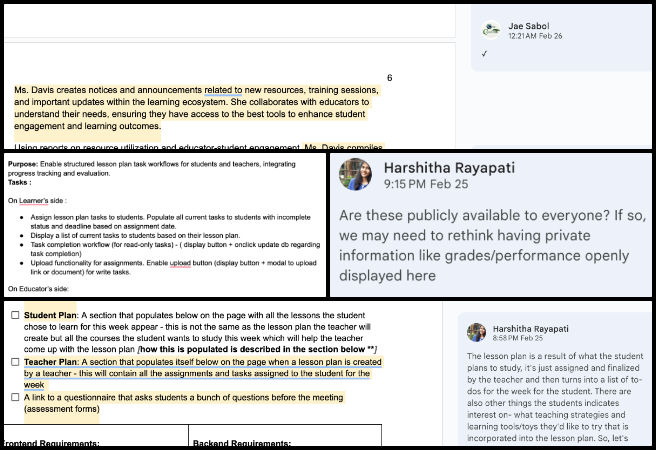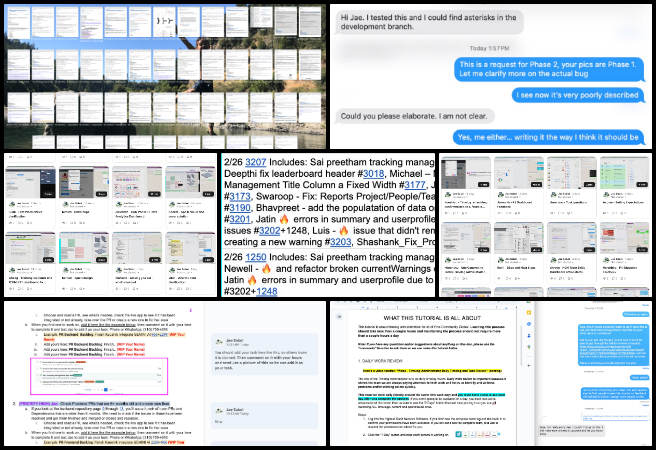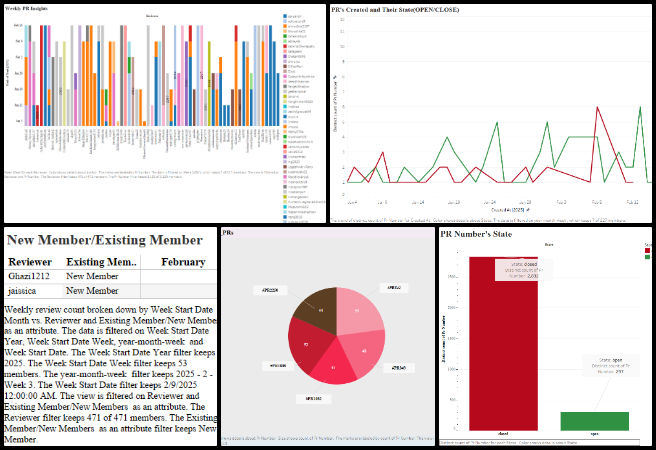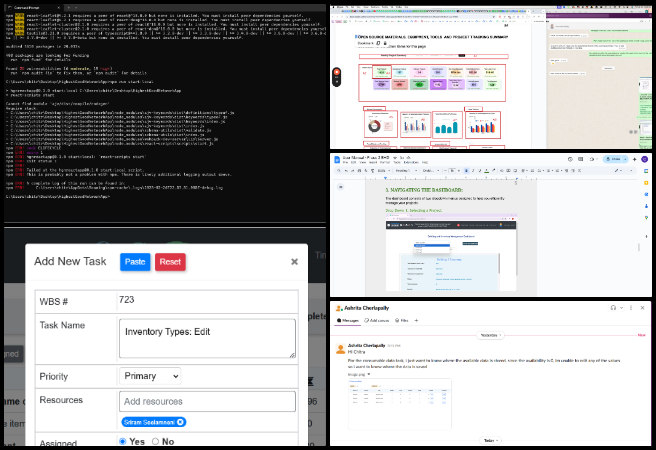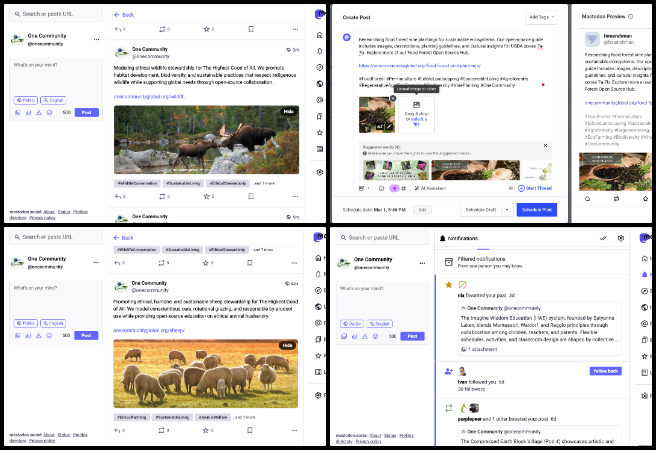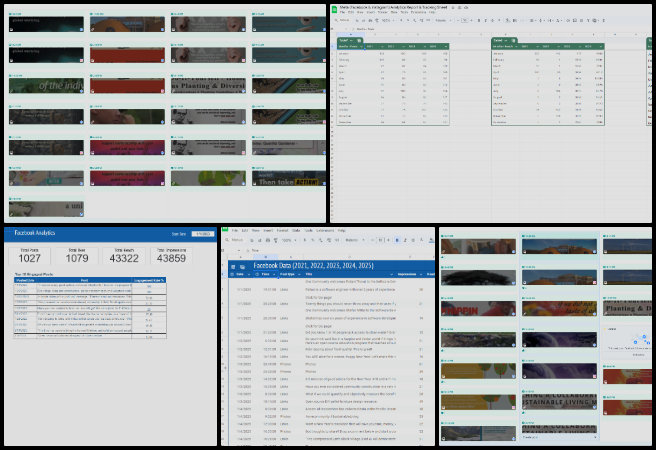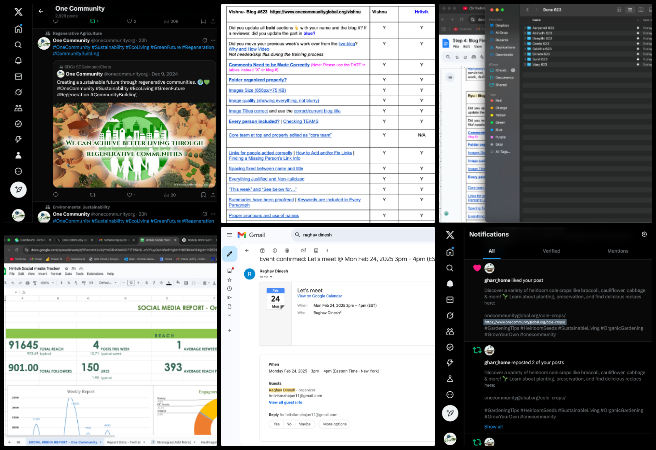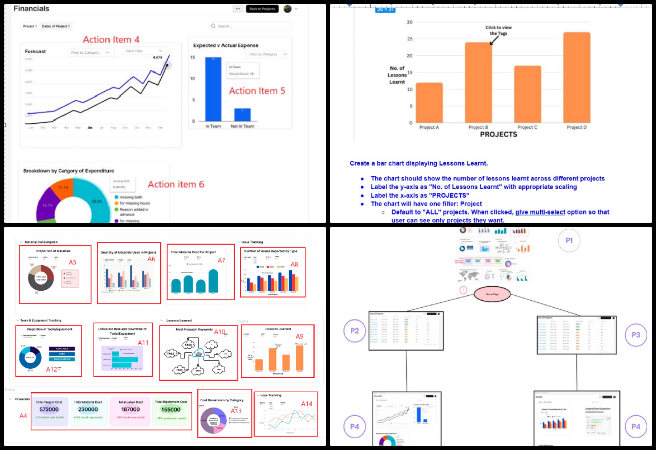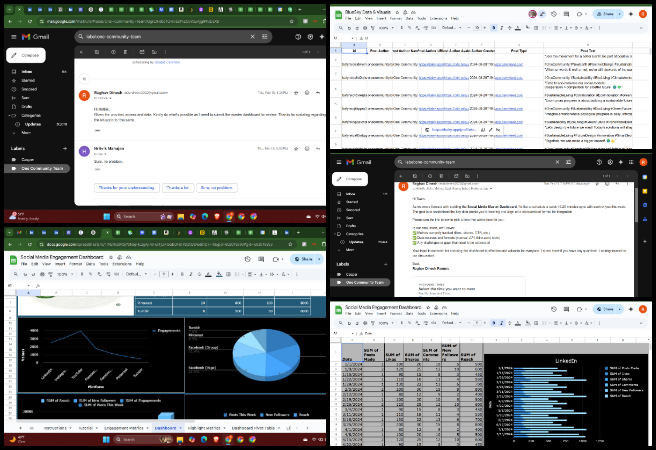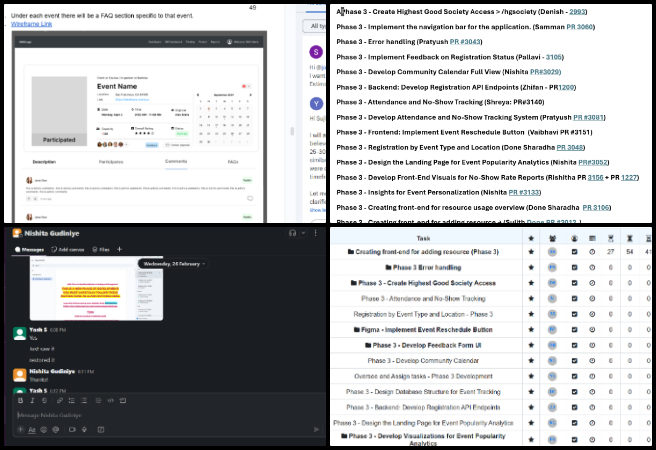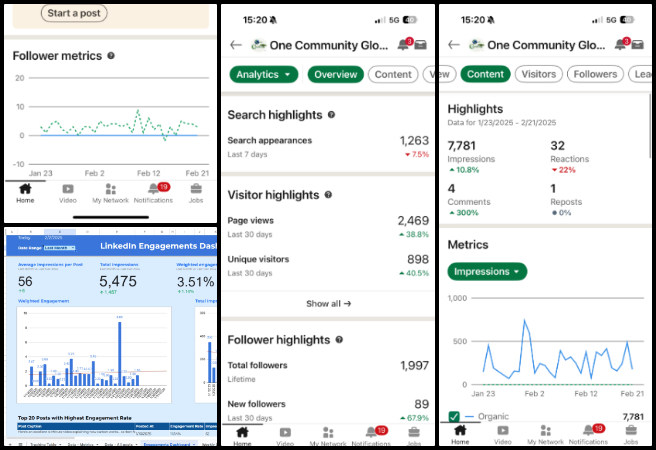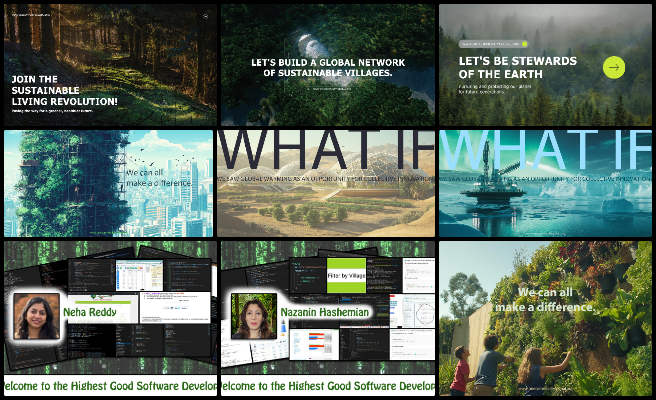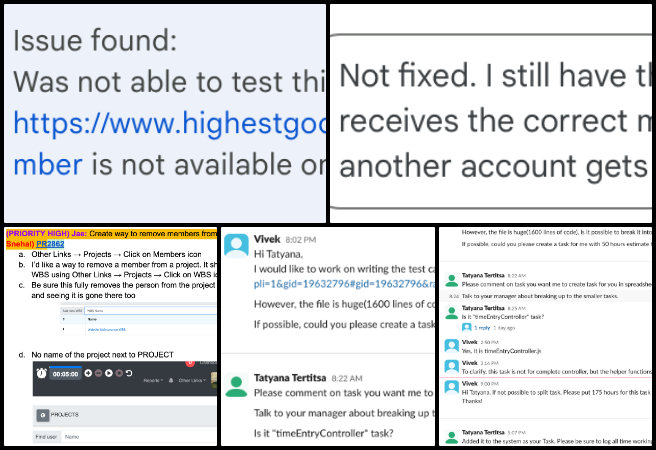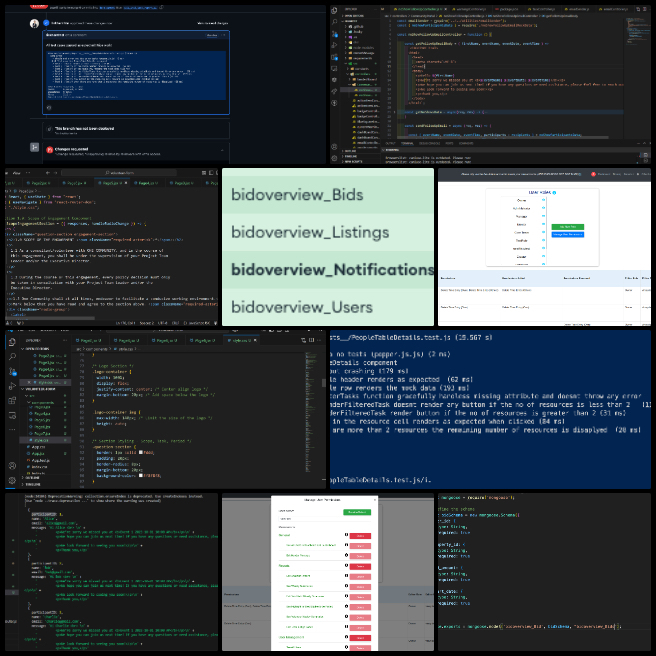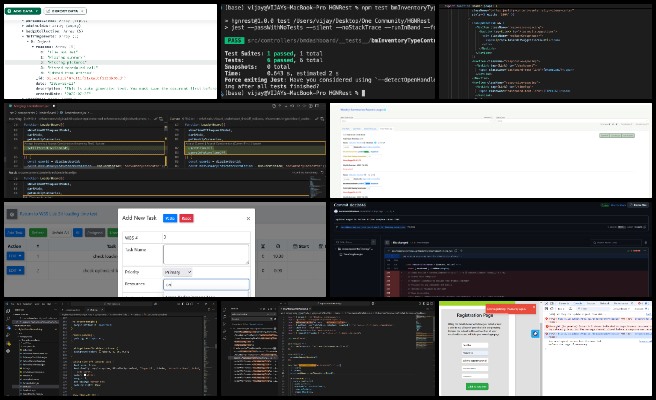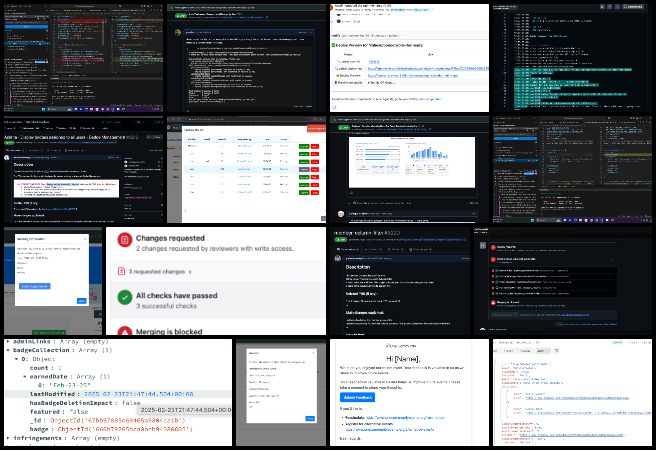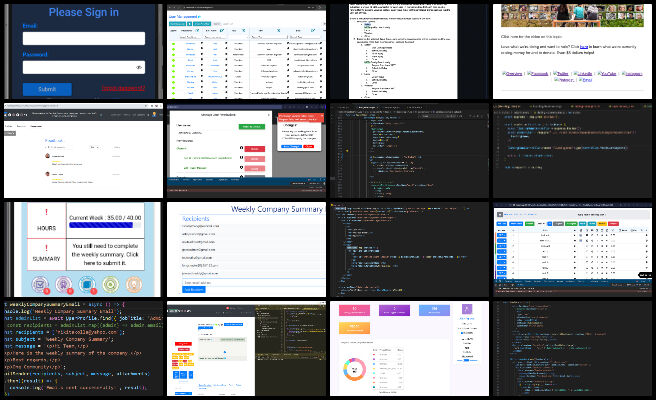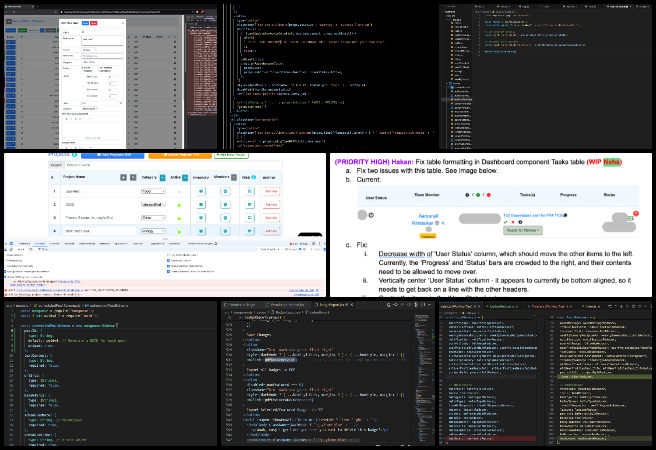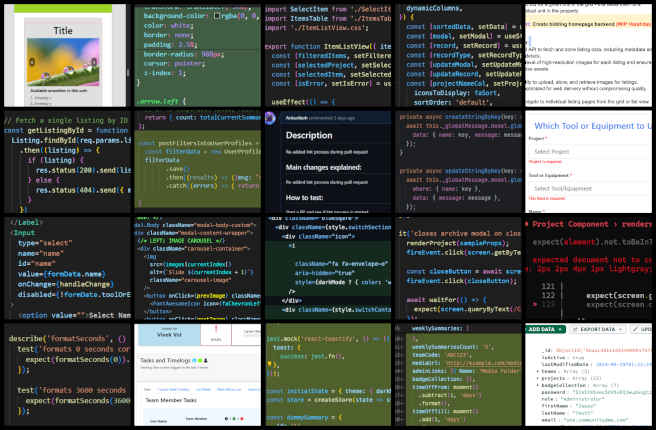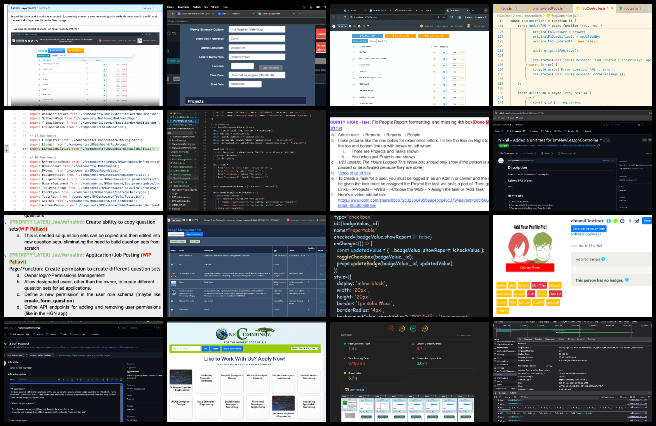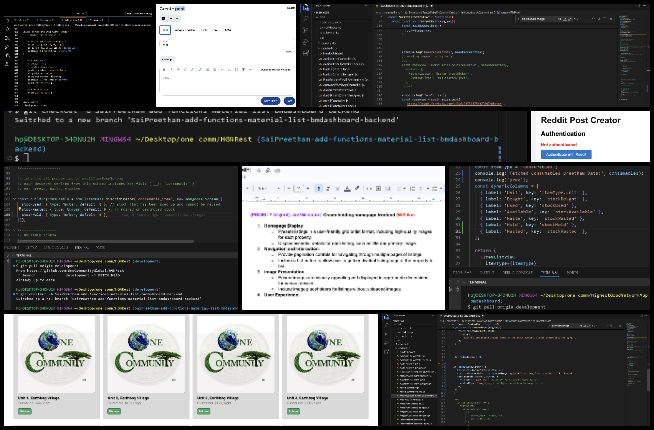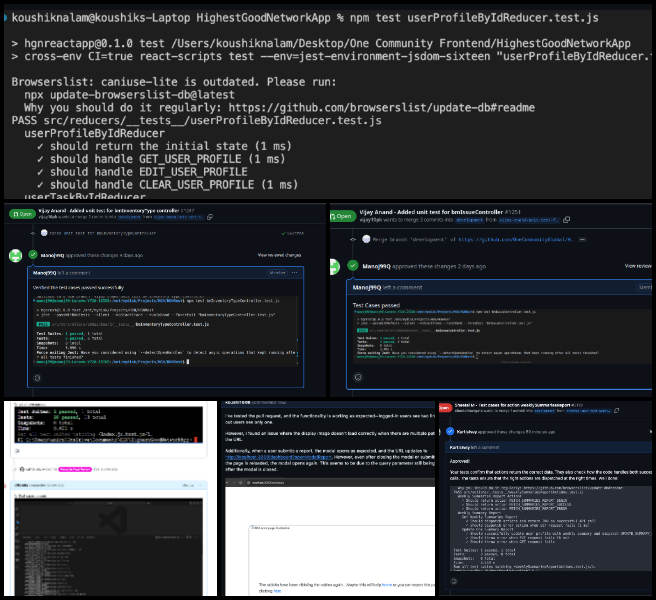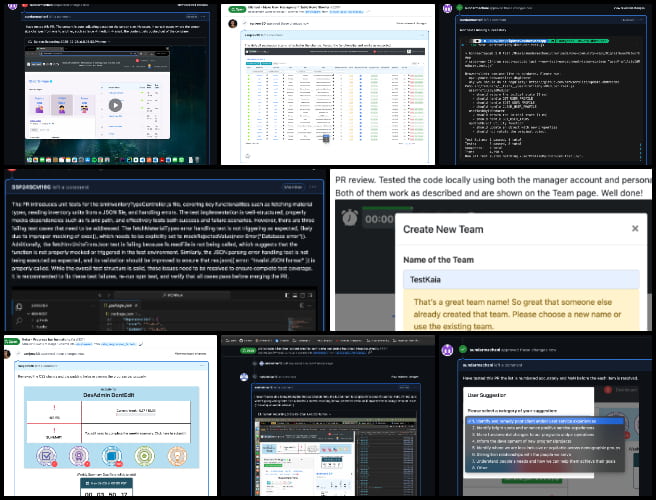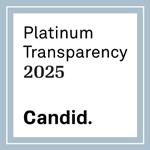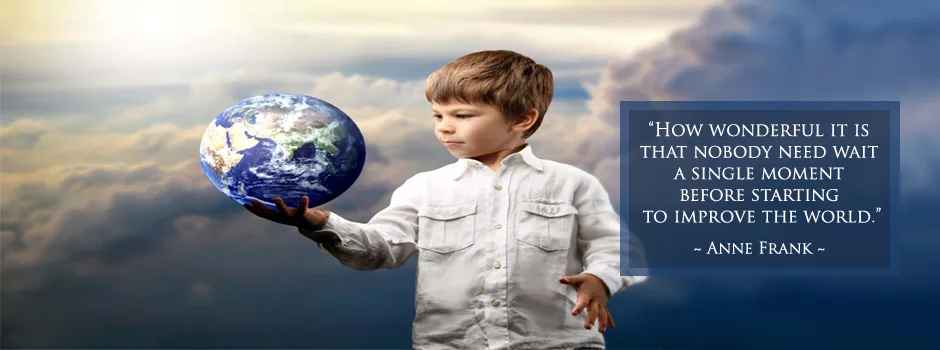
Community Conservation through Diversification – One Community Weekly Progress Update #629
Posted on April 7, 2025 by One Community Hs
Community conservation through diversification is at the heart of our all-volunteer organization. Through sustainable approaches to food, energy, housing, education, for-profit and non-profit economic design, social architecture, fulfilled living, global stewardship practices, and more, One Community is creating a model designed to be self-replicating. By designing everything as open source and free-shared, we ensure accessibility and inspire collective growth. With a focus on evolving sustainability, we are dedicated to creating a world that works for everyone while regenerating our planet. This model will serve as the foundation for a global collaboration of teacher/demonstration hubs, all done in the pursuit of “The Highest Good of All“.
- Here’s our project overview
- Here’s our world-change methodology
- Here’s how this becomes self-replicating
- Here’s how we are open source and free-sharing all the do-it-yourself designs

OUR MAIN OPEN SOURCE HUBS
Click on each icon to be taken to the corresponding Highest Good hub page.
One Community’s physical location will forward this movement of community conservation through diversification as the first of many self-replicating teacher/demonstration communities, villages, and cities to be built globally. This is the April 7th, 2025 edition (#629) of our weekly progress update detailing our team’s development and accomplishments:
Community Conservation through Diversification
One Community Progress Update #629
DONATE | COLLABORATE | HELP WITH LARGE-SCALE FUNDING
CLICK HERE IF YOU’D LIKE TO RECEIVE AN EMAIL EACH WEEK WHEN WE RELEASE A NEW UPDATE
YOU CAN ALSO JOIN US THROUGH SOCIAL MEDIA
ONE COMMUNITY WEEKLY UPDATE DETAILS
HIGHEST GOOD HOUSING PROGRESS
 One Community is creating community conservation through diversification through Highest Good housing that is artistic and beautiful, more affordable, more space efficient, lasts longer, DIY buildable, and constructed with healthy and sustainable materials:
One Community is creating community conservation through diversification through Highest Good housing that is artistic and beautiful, more affordable, more space efficient, lasts longer, DIY buildable, and constructed with healthy and sustainable materials:
- Learn about: Our Upcoming Crowdfunding Campaign
- Learn about the different village models: 7 Sustainable Village Models
- Visit the open source portals for the first two: Earthbag Village OS Hub | Straw Bale Village OS Hub
This week, Adil Zulfiquar (Engineer) continued working on the Vermiculture Toilet engineering designs. Adil updated the vermiculture operating conditions and schedule report, incorporating feedback from the review. The contents were streamlined to better reflect the actual operating conditions and procedures of the vermiculture system, including worm addition, bedding material, ventilation, moisture levels, and standard operating procedures. Extreme condition procedures were revised, and new images were added while existing images were updated to ensure they were royalty-free. The Earthbag Village, the first of seven planned villages, serves as the initial housing component within One Community’s open source model for community conservation through diversification. See below for some of the pictures related to this work.
Anil Karathra (Mechanical Engineer) continued advancing the engineering and design of the Vermiculture Toilet for the Earthbag Village project. The second round of feedback from Jae was received regarding the toilet seat lockdown mechanism, and work continued on finalizing the design and CAD model. The CAD for the mechanism was completed, and efforts shifted to preparing the associated documentation. A digital mockup of the DIY toilet seat was created, along with engineering drawings and part stencils to support fabrication. Work progressed on the design report and the preliminary bill of materials for the eco toilet seat. A weekly summary was compiled, and screenshots of the previous week’s work were uploaded to Dropbox. This commitment to community conservation through diversification drives the development of innovative, eco-friendly solutions that balance environmental responsibility with high standards of functionality. See below for pictures related to this work.
Audrey Gunawan (Mechanical Engineer) continued working on the Vermiculture Toilet plumbing details. Audrey continued work on the SolidWorks model, testing different configurations after identifying that the main plumbing line was interfering with the rail for the compost box. She modeled the pipes and attempted to lengthen one side but determined that additional revisions would be needed to refine the design. Her time was spent evaluating whether to lengthen sections or introduce bends in the model and assessing the feasibility of these adjustments within general plumbing practices. To support this evaluation, she reviewed plumbing codes and examples for reference. The model also presented mating errors in SolidWorks, which added difficulty to the process. As the first of seven planned villages, Earthbag Village provides the initial housing within One Community’s open source designs for community conservation through diversification. See below for some of the pictures related to this work.
Derrell Brown (Plumbing Designer) continued working on the Earthbag Village 4-dome home plumbing details. Derrell coordinated with Michaela on Monday to address minor follow-up items related to the 75% coordination electrical set previously submitted for review, including the addition of schedules and supporting information. He reviewed past documents to gather lighting fixture data, such as bulb types and housing, and used this information to create a luminaire schedule. Referencing material from the One Community website, he developed the luminaire schedule for inclusion in the architectural switching plan. After preparing this schedule for review, Derrell worked on remaining mechanical and plumbing tasks, which included relocating the condensate drain from the ductless fan coil unit to avoid it penetrating through the middle of the ceiling, adjusting vent stacks to resolve clashes, and creating an additional floor plan in Revit to address visibility graphics issues in the HVAC plan. One Community’s open source launching of community conservation through diversification begins with Earthbag Village, the first of seven planned villages providing housing. See below for some of the pictures related to this work.
Faeq Abu Alia (Architectural Engineer) continued his work on the Earthbag Village 4-dome home renders. Faeq worked on rendering the walkthrough video to visually present the updated design and enhancements of the 4-dome home. The focus was on refining the interior by adding blinds, decorative elements, and applying double-layered materials to improve visual appeal and ensure design cohesion. These updates were implemented to align with the overall layout and style of the structure, maintaining consistency across all spaces. The Earthbag Village is the first of 7 to be built as the housing component of One Community’s open source plans for community conservation through diversification. View examples of this work in the pictures provided below.
Karthik Pillai (Mechanical Engineer) continued helping finish the Vermiculture Toilet engineering and helping with the Earthbag Village 4-dome home roof plan. Karthik resumed work on both projects following a two-week break. For the 4-dome cluster roof design, with the roof structure now nearly finalized, he began drafting the report to document all findings and progress to date. During a meeting with Michaela, additional action items were identified, including the need for a Finite Element Analysis of the window beams, which will be addressed later. On the Vermiculture toilet design, he continued progress on the waste dumping mechanism report, and the design for the main Unistrut system is close to completion. As the first of seven planned villages, Earthbag Village provides the initial housing within One Community’s open source designs for community conservation through diversification. See the work in the collage below.
Ketsia Kayembe (Civil Engineer) started working on the Earthbag Village designs related to Rainwater Harvesting and Water Catchment. Ketsia completed the orientation and read background materials on the Earthbag Village project before reviewing the updated stormwater management and rainwater harvesting designs prepared by Yi-Ju. She corrected spelling and grammar issues in the documentation and verified calculations related to the design. Ketsia contacted Yi-Ju to arrange a meeting to clarify project tasks and discuss outstanding questions and coordinate next steps. She began working on the cost analysis by estimating expenses based on Yi-Ju’s design, compiling a list of required materials, and researching vendors to identify affordable pricing options. One Community’s open source model for community conservation through diversification begins with Earthbag Village, the first of seven planned villages providing housing. See below for some of the pictures related to this work.
Michaela Silva (Architect) continued working on the architectural details for the Earthbag Village 4-dome home design. Michaela modeled a desk for the primary bedroom loft office and drew sections through the computer to confirm that the desk’s depth aligns with the curvature of the dome. She also continued work on the door sheet by creating a door schedule and tagging the doors in the floor plan. As the first of seven villages in One Community’s open source plan for community conservation through diversification, the Earthbag Village represents the housing element. See her work in the collage below.
Rumi Shah (Civil Engineer) continued working on the Earthbag Village upgrades to bring our designs closer to construction-ready plans. Rumi worked on refining the construction notes and cover sheet to ensure all critical details were included for the project’s progression. Rumi also reviewed technical specifications and made adjustments to optimize the foundation details. Work continued on the calculations and design of the dome structure, which involves complex engineering requirements. The drafting of the dome design is in progress, with plans to submit the finalized documents. One Community’s open source resources for community conservation through diversification begin with the Earthbag Village, the first of seven planned villages providing housing. See below for some of the pictures related to this work.
Yi-Ju Lien (Environmental Engineer) continued her work on the Earthbag Village LEED points related to stormwater retention. Yi-Ju worked on updating the webpage content for the stormwater drainage system design methodology. She revised the section on the rational method for calculating peak discharge by adding more detail on critical duration and time of concentration, and explaining the use of the velocity method to calculate this time. She introduced three flow types—sheet flow, shallow concentrated flow, and open channel flow—along with their respective calculation methods. In the roadway drainage design section, Yi-Ju focused on gutter flow analysis and inlet design, adding information to clarify the use of equations and noting that discharge calculations for gutter analysis vary depending on the gutter section type. She also specified that different charts or equations are required for different configurations, highlighting the importance of maintaining collaboration and unity in community conservation through diversification. See some of the work done in the collage below.
DUPLICABLE CITY CENTER PROGRESS
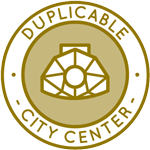 One Community is creating community conservation through diversification through a Duplicable and Sustainable City Center that is LEED Platinum certified/Sustainable, can feed 200 people at a time, provide laundry for over 300 people, is beautiful, spacious, and saves resources, money, and space:
One Community is creating community conservation through diversification through a Duplicable and Sustainable City Center that is LEED Platinum certified/Sustainable, can feed 200 people at a time, provide laundry for over 300 people, is beautiful, spacious, and saves resources, money, and space:
- Learn about this building and it’s function: Duplicable City Center Open Source Hub
This week, Andrew Chen (Industrial Designer) continued working on the Dormer second-floor window for the Duplicable City Center. He researched the Singapore Jewel, focusing on its spherical architecture and diamond structural framework, to explore how the window could integrate with similar architectural features. Andrew completed the first full model of the second-floor window, which included the internal structure and insulation. He is now waiting for feedback to move forward with the next stage of development. The Duplicable City Center is a foundational part of One Community’s open-source model, contributing to community conservation through diversification. See some of this work in the pictures below.
Jason Bao (Architectural Designer) continued working on producing renders for the Duplicable City Center library. His communication with Jae clarified next steps, and updated components from Nimika were shared with Yan. Adjustments to the garden area were implemented based on Jae’s instructions, including the addition and removal of plants, people, and other models. Rendering parameters were modified to align with project goals, and surrounding terrain elements were incorporated to enhance scene context. File optimizations were prioritized to maintain workflow efficiency while integrating updates. One Community’s open-source model features the Duplicable City Center, which plays a vital role in community conservation through diversification. See the work in the images below.
Mohammed Maaz Siddiqui (Architect) wrapped up his work on the interior renders for the Duplicable City Center project. The furniture in the older scenes was adjusted to ensure all pieces were properly placed on the ground, and a few plants were added to the outdoor area to enhance its appearance. The overall scenes of the laundry room and washroom were developed by searching for and updating materials and finishes to align with the project color palette based on the reference file provided by Jae. The scenes were then updated with appropriate 3D models to improve realism. The Duplicable City Center is an essential part of One Community’s open-source approach, aiding in community conservation through diversification. Explore the work in the pictures below.
Manjiri Patil (Mechanical Design Engineer) continued working on the designs for the City Center Dome Hub Connector Engineering. She is currently working on the review feedback provided by Jae and making the necessary updates to the manufacturing process report and excel sheet. In parallel, she is also refining the CAD drawing, addressing some gaps that were previously identified. One Community’s open-source Duplicable City Center is a key part for the community conservation through diversification. The images below showcase some of this work.
Sanket Basannavar (Mechanical Engineer) continued working on the Duplicable City Center spa cover as part of the City Center Natural Pool and Eco-spa Designs. A SolidWorks model was created for the walls and mechanical room, and it was assembled with the spa and spa cover. A mechanism was designed to hold the motor that will rotate the pulley to open the spa cover. The AutoCAD plan was revised by removing the space previously designated for the waterfall and reallocating the space for additional features like chairs and tables. As a foundational component of One Community’s open-source model, the Duplicable City Center promotes community conservation through diversification. See examples in the images below.
Shu-Tsun (Engineer) continued working on the City Center Dome Hub Connector Engineering by conducting the structural and frame analysis of the City Center dome using Autodesk Inventor, as well as working on the spreadsheet for which she is responsible. She reviewed her earlier analysis and discovered several errors that had impacted the accuracy of her findings. To address this, she chose to start the analysis over from scratch to ensure everything was handled properly. Shu-Tsun also carefully studied the instruction manual and related documentation to deepen her understanding of the correct procedures. Her goal was to prevent similar mistakes in the future and enhance the overall quality of her work. The Duplicable City Center is a key element of One Community’s open-source model, supporting community conservation through diversification. Check out some of the work in the images below.
Srujan Pandya (Mechanical Engineer) continued helping with the City Center Dome Hub Connector Engineering analysis. He worked on the previous traditional dome design and the City Center dome design to ensure a consistent model setup across both. This included applying fixed constraints on the last row, using the same previously defined load cases, and implementing frame analysis using simplified beam and node representations. The results for all three versions, version 0 (traditional dome), version 1 (city center dome), and version 2 (modified city center dome) were updated in the spreadsheet, along with notes and remarks interpreting the outcomes. One Community’s open-source model features the Duplicable City Center, which plays a vital role in community conservation through diversification. See the work in the images below.
HIGHEST GOOD FOOD PROGRESS
 One Community is creating community conservation through diversification through Highest Good food that is more diverse, more nutritious, locally grown and sustainable, and part of our open source botanical garden model to support and share bio-diversity:
One Community is creating community conservation through diversification through Highest Good food that is more diverse, more nutritious, locally grown and sustainable, and part of our open source botanical garden model to support and share bio-diversity:
- Learn about the structures: Hoop House Hub | Aquapini & Walipini Open Source Hub
- See what we’ll be growing: Gardens & Hoop Houses | Large-scale Structures | Food Forest | TA
This week, the core team completed adding photos to the Master Tools, Equipment, and Materials/Supplies document, including items related to the Goat, Chicken, and Rabbit sections. They also made sure that duplicate entries were removed and additional items were incorporated into both the master document and the hoop house listing. Certain additions, while not directly related to construction, pertain to ground preparation, ongoing operation, and maintenance. These items were designated with an asterisk to differentiate them from construction-specific tools and supplies. The Highest Good Food initiative is a key component of One Community’s open source plans, focused on community conservation through diversification, and exemplifies the organization’s commitment through innovative design and implementation. Below are some of the images showcasing this work.
Dirgh Patel (Volunteer Mechanical Engineer) continued assisting with the Climate Battery design evolutions. He reviewed CAD models related to the piping system and its connection to the climate battery, including joints, assemblies, and dimensions. He created detailed drawings in SolidWorks, verified dimensions against provided theory, exported them as standard PDFs, created a motion assembly, and saved both exploded and rotational views. Dirgh also began simulation work focused on the stress, strain, and deformation of pipes under the calculated weight of overlying dirt. He worked on FEA analysis, starting with individual components and then the full assembly, using estimated dirt volume to determine load and assess resulting pipe deformation. The Highest Good Food initiative is a key component of One Community’s open source plans, focused on community conservation through diversification, and exemplifies the organization’s commitment through innovative design and implementation. Below are some of the images showcasing his work.
Jay Nair (BIM Designer) continued working on Aquapini and Walipini Planting and Harvesting lighting and HVAC design. He held a call with a team member to discuss an alternative design for Walipini 1 that includes earthen roofs. Additionally, Jay continued working on the lighting energy calculations to reflect the changes in the roof design and continued researching how to use Dynamo for Revit to develop the corresponding lighting fixture. The Highest Good Food initiative is a key component of One Community’s open source plans, focused on community conservation through diversification, and exemplifies the organization’s commitment through innovative design and implementation. Below are some of the images showcasing this work.
Keerthi Reddy Gavinolla (Software Developer) continued working on the Highest Good Food page additions covering small-business and urban community options. She reviewed the Expressers team’s work, created their team collage, commented on their documents, and updated Blog #628. She also updated the Vermiculture website by adding additional provided content and started contributing to the Highest Good Food Infrastructure website. Additionally, she focused on editing formatting, adjusting headings, and justifying text to ensure consistency and readability. The Highest Good Food initiative is essential to One Community’s open source plans, focused on community conservation through diversification, and exemplifies the organization’s commitment through innovative design and implementation. Her contributions are highlighted in the collage below.
Mary Nelson (Landscape Planner) continued research and development of various Highest Good Food components. This week’s focus was research for community conservation through diversification by focusing primarily on editing the soil amendments strategy and making several updates to the document’s format to align with One Community standards. She continued working on the botanical garden tutorial, confirming that the correct page had been edited and was in the proper format. She requested time to meet for a review of her work in preparation for publishing. Additionally, she completed the meadow garden maintenance program she had started the previous week. The Highest Good Food initiative is essential to One Community’s open source plans, focused on community conservation through diversification, and exemplifies the organization’s commitment through innovative design and implementation. Her contributions are highlighted in the collage below.
Tanmay Koparde (Industrial Engineer and Team Administrator) continued optimizing the Food Procurement and Storage Plan to enhance efficiency and sustainability. He continued leveraging the Just-In-Time (JIT) methodology to enhance food storage efficiency and mitigate supply chain disruptions using the NetSuite ERP software. He explored approaches to address inventory shortages and ensure smooth food distribution. Additionally, he studied the concept of buffer stock and explored how to effectively implement it within food storage systems using the NetSuite ERP, focusing on strategies to prevent spoilage and minimize waste while maintaining sufficient reserves for emergency situations. The Highest Good Food Initiative is a key component of One Community’s open source plans, focused on community conservation through diversification, and exemplifies the organization’s commitment through innovative design and implementation. See his work in the collage below.
HIGHEST GOOD ENERGY PROGRESS
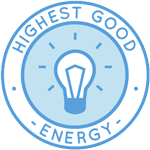 One Community is creating community conservation through diversification through Highest Good energy that is more sustainable, resilient, supports self-sufficiency and includes solar, wind, hydro and more:
One Community is creating community conservation through diversification through Highest Good energy that is more sustainable, resilient, supports self-sufficiency and includes solar, wind, hydro and more:
- Learn about the open source sustainable-energy foundations: Solar, Hydro, and Wind
- Explore our research into the most sustainable products and companies for saving water and energy: Insulation, Eco-laundry, Lightbulbs and Light Bulb Companies, Doors and Door Companies, Windows and Window Companies, Toilets, Faucets and Faucet Accessories, Urinals, and more.
This week, Dishita Jain (Data Analyst) continued assisting with the Highest Good Energy research and cost analysis for community conservation through diversification. She made updates to the spreadsheet with new resources, incorporating feedback provided by Jae and addressing additional issues identified during the review process. Prior to that, relevant research was completed, and initial data updates were shared for evaluation. Additionally, work was done on OC Administration activities, including reviewing and providing feedback on other admins’ blogs and images, as well as working on the training team’s review and creating a blog post with a summary and collage. The Highest Good Energy initiative is a key component of One Community’s open source plans, focused on community conservation through diversification, and exemplifies the organization’s commitment through innovative design and implementation. Below are some of the images showcasing this work.
Muhammad Sarmad Tariq (Electrical Engineer) continued assisting with off-grid and grid-tied Solar Microgrid comparisons as part of the Highest Good Energy component. This is part of research for community conservation through diversification covering sustainable power supply. This week’s focus was working on a report describing the calculator used to determine profit and net savings for both off-grid and grid-tied solar PV systems. He focused on the net savings and economic analysis of the on-grid PV system. In response to feedback from Jae on the final version of the Off-Grid vs. On-Grid PV system report, he reviewed relevant research and explored options for incorporating PV system sizing into the report. The Highest Good Energy initiative is a key component of One Community’s open-source plans, focused on community conservation through diversification, and exemplifies the organization’s commitment through innovative design and implementation. See his work in the collage below.
HIGHEST GOOD EDUCATION PROGRESS
 One Community is creating community conservation through diversification through Highest Good education that is for all ages, applicable in any environment, adaptable to individual needs, far exceeds traditional education standards, and more fun for both the teachers and the students. This component of One Community is about 95% complete with only the Open Source School Licensing and Ultimate Classroom construction and assembly details remaining to be finished. We’ll report on the final two elements to be finished as we develop them. With over 8 years of work invested in the process, the sections below are all complete until we move onto the property and continue the development and open sourcing process with teachers and students – a development process that is built directly into the structure of the education program and everything else we’re creating too:
One Community is creating community conservation through diversification through Highest Good education that is for all ages, applicable in any environment, adaptable to individual needs, far exceeds traditional education standards, and more fun for both the teachers and the students. This component of One Community is about 95% complete with only the Open Source School Licensing and Ultimate Classroom construction and assembly details remaining to be finished. We’ll report on the final two elements to be finished as we develop them. With over 8 years of work invested in the process, the sections below are all complete until we move onto the property and continue the development and open sourcing process with teachers and students – a development process that is built directly into the structure of the education program and everything else we’re creating too:
- Program Overview: Education Open Source Hub
- How the components work together in designing human orchestrated eco-abundance: How to use the Education for Life Program
- Lesson Plans for Life – Lesson Plans How-to
- Foundations of Outstanding Leaders, Teachers, and Communicators
- Curriculum for Life
- Teaching Strategies for Life
- Learning Tools and Toys for Life
- Evaluation and Evolution
This week, Akhil Guntur (FullStack Engineer) continued his work on enhancing and refining his backend model documentation for the Highest Good Education open source software designs, carefully exploring multiple backend design approaches. He systematically reviewed his teammates’ feedback, analyzed their comments in detail, and provided detailed responses to ensure clarity and alignment. Following additional research, he updated the documentation, integrating valuable insights and suggestions from the team. To strengthen his understanding and effectively inform backend setup decisions, he extensively reviewed existing HGN websites, gathering detailed information about current backend implementations. Additionally, he focused on creating clear and efficient entity relationship diagrams based on the improved models. These diagrams are essential for visualizing backend structures, enabling a smoother transition into the development phase. The One Community model of community conservation through diversification with sustainably built classrooms like this is an excellent example of sustainable change for the whole planet. See the collage below for his work.
Chitra Siddharthan (Data Analyst and Team Administrator) continued working on the deliverables for the Highest Good Education phase 4 software. The coursework description was prepared for the wireframes. Phase 2 Slack messages, tasks, and PRs were checked to track the progress of the reviews. The ‘Teacher Dashboard’ for phase 4 was broken down and is now ready for the wireframe structure. Additionally, tasks 747 through 753 were added for phase 2. The One Community model of community conservation through diversification with sustainably built classrooms like this is an excellent example of sustainable change for the whole planet. See the collage below for her work.
Harshitha Rayapati (Program Manager) continued work on detailing deliverables for the Highest Good education software platform, outlining various components, developing Figma designs, and expanding the visual layout of the student dashboard. This week, her work focused on the action items document to support the development and design process of Phase 4. Edits and changes were made to the backend architecture design shared by Akhil, and the updated action items document was submitted for Jae’s feedback. After reviewing Jae’s input, work moved forward with implementing the suggested changes. The HGN Phase 4 document was cleaned up to remove duplicates and unnecessary details, and content from other related documents was merged into the main Phase 4 document. Specific action items were detailed for the first sprint, and steps were taken to expand the front-end team and delegate tasks to Chitra. The backend design and action items were also merged into the original design document. Additionally, Harshitha assisted in compiling the weekly blog update, reviewed the Graphic Design Team’s weekly progress, edited the blog page, and created a collage. The One Community model of community conservation through diversification with sustainably built classrooms like this is an excellent example of sustainable change for the whole planet. See the collage below for her work.
Mrinalini Raghavendran (Software Engineer) continued refining and documenting both frontend and backend requirements for various graphs. She added formatting updates to the requirements document and captured additional dashboard ideas offline. She updated the documentation and continued working on the backend Node.js code for listing payments. Throughout the week, she wrote additional code, introduced new functionalities, and organized the backend codebase into appropriate folders. Toward the end of the week, she worked on integrating the Stripe payment intent functionality, which is pending local testing. By forwarding community conservation through diversification with classrooms like this, One Community provides a replicable example for global sustainable development. See the collage below for her work.
HIGHEST GOOD SOCIETY PROGRESS
 One Community is creating community conservation through diversification through a Highest Good society approach to living that is founded on fulfilled living, the study of meeting human needs, Community, and making a difference in the world:
One Community is creating community conservation through diversification through a Highest Good society approach to living that is founded on fulfilled living, the study of meeting human needs, Community, and making a difference in the world:
- Read the Highest Good society overview: Highest Good Society
- Learn about the model for fulfilled living and sharing: A Day in the Life
- Learn about the 4 economic models: RBE | For-profit | Non-profit | Entrepreneurship
- Learn about our open source community collaboration and management software: The Highest Good Network
This week, the core team completed over 48 hours managing One Community’s volunteer-work review not included above, emails, social media accounts, web development, new bug identification and bug-fix integration for the Highest Good Network software, and interviewing and getting set up new volunteer team members. They also shot and incorporated the video above that talks about how community conservation through diversification is a foundation of the bigger picture of everything One Community is doing. The image below shows some of this work.
Govind Sajithkumar (Project Manager) continued focusing on Meta platform analytics and content management for Facebook and Instagram channels. He updated the social media analytics spreadsheet with current performance metrics and processed new audience data for both platforms to ensure up-to-date reporting. He cleaned and normalized social data prior to integration into tracking systems and updated the master spreadsheet with revised audience demographics and engagement figures. He maintained scheduled content publishing on both platforms, aligning post times with audience activity patterns. He documented all new content in the Open Source spreadsheet, including relevant metadata, and kept tracking files updated to support content analytics. As part of PR Review Team Management, he provided comments and feedback on team documents, updated his WordPress site with the latest team summary and collage, revised the PR Review Team Table with required entries, and reviewed blog sites maintained by fellow admins. This work helps One Community’s mission of community conservation through diversification. The following images show his work for the week.
Hritvik Mahajan (Data Analyst) continued focusing on marketing and administrative tasks. He worked on multiple projects, including software testing, marketing, and administration. He reviewed several pull requests and communicated with team members via Slack to address merge conflicts and requested changes. He also refined the design of the HGN Social Media Scheduler. In marketing and promotion, he posted high-engagement content to Twitter communities to increase visibility and engagement. Additionally, he supported the OC Administration team by covering tasks for the moonfall team in Shrinivas’s absence and waited for feedback from Newell, as requested by Jae. This work helps One Community’s mission of community conservation through diversification. The following images show his work for the week.
Jaiwanth Reddy Adavalli (Project Manager) continued developing the Job Applicants page and the Highest Good Network Phase 2 Dashboard, making changes to better integrate these pages with existing content and data. Two pages worth of new components were created to enhance functionality, and action items were documented for further work. As part of the PR review team, he reviewed the pull requests of the volunteer team assigned to him. This work helps One Community’s mission of community conservation through diversification. The following images show his work for the week.
Raghav Dinesh Pamuru (Product Manager) continued work on coordinating with cross-functional teams to update the project roadmap and ensuring that all development tasks aligned with weekly goals. He reviewed submitted feature requests, refined backlog items in Jira, and clarified acceptance criteria in collaboration with stakeholders. He participated in daily stand-ups to provide project updates and flag blockers. He also worked with the UI/UX team to prioritize usability enhancements and documented the product feedback received during internal testing. He tracked sprint metrics and updated the product dashboard with current progress. This work helps One Community’s mission of community conservation through diversification. The following images show his work for the week.
Yash Shah (Data Analyst and Team Administrator) continued his admin work and managed the social architecture component of the Highest Good Network software. He focused on reviewing and managing pull requests to determine their readiness for merging. This involved checking for resolved merge conflicts, ensuring there were no failing tests, and confirming that all requested changes and reviewer comments were addressed, as per the feedback provided by Jae. He followed up with the developers responsible for the Phase 3 development tasks to help resolve outstanding issues and obtain the necessary approvals. In addition to PR management, he created a blog post for Dev Dynasty and organized the folder structure for the week’s materials. He also created a collage related to the ongoing project activities and provided feedback on blogs submitted by fellow volunteers. This work helps One Community’s mission of community conservation through diversification. The following images show his work for the week.
ADMINISTRATION TEAM
The Administration Team summary, covering their work administrating and managing most of One Community’s ongoing process for community conservation through diversification was managed by Bhakti Tigdi (Project Manager) and includes Himanshu Mandloi (Engineering Project Manager), Jibin Joby (Data Analyst), Kishan Sivakumar (Administrative Assistant and Software Team Manager), Olawunmi “Ola” Ijisesan (Administrative and Management Support), Olimpia Borgohain (Data Analyst and Team Administrator), Preksha Welankiwar (Digital Marketing Manager), Rachna Malav (Data Analyst), Rishi Sundara (Quality Control Engineer And Team Administrator), Ryutaro Wongso (Economic Analyst and Team Administrator), Saumit Chinchkhandi (Administrative Assistant and Software Engineer), Vikas Pande (Software Administrator), and Vishnu Murali (Data Analyst). The Highest Good Network software is how we’ll be managing and objectively measuring our process for community conservation through diversification through our social architecture, construction, production, and maintenance processes.
This week, the Administration team contributed to a variety of coordination, review, content, and technical tasks. Community conservation through diversification was at the core of many of the activities. Himanshu managed the daily timelog review process, followed up with team members on pending entries, addressed logging concerns with Jae, reviewed training steps, and recorded a video to explain a system issue. He also supported time adjustments, updated a blog post based on feedback, created a PDF version, and reviewed admin work. Jibin reviewed the housing team’s submissions, created collages, updated assigned pages, and collaborated with Vishnu to extract and visualize BlueSky data, while also working on a Python-based solution for improved accuracy. Kishan focused on senior admin responsibilities by reviewing volunteer documents and SEO pages, addressing requests, and initiating new tasks. Ola oversaw PR reviewers, followed up on incomplete tasks, checked progress report accuracy, updated documentation, and managed the admin workspace. Olimpia completed mockups for the social media dashboard based on existing mock data trends and participated in team reviews as part of the admin group, contributing to the ongoing efforts of community conservation through diversification.
Preksha worked on growing the Threads and LinkedIn presence, collaborated with Govind on Facebook and Instagram analytics, reviewed PDFs as a corrections admin, and submitted her contributor bio. Rachna was unable to schedule interviews due to limited availability and instead focused on pending SEO tasks, reviewed prior work, and stayed updated on communications. Rishi tested multiple PRs from Phase 1, added new bug items, reviewed team contributions, and updated blog content with SEO optimizations. Ryutaro reviewed Binary Brigade’s development progress, supported onboarding for a new team member, made updates to his profile, and continued cost analysis for the Duplicable City Center. Saumit managed PR workflows for volunteers A–E, tested various PRs related to Phase 1, reviewed PR training, and revised his blog based on feedback. Vikas interviewed a software developer candidate, reviewed blog scripts for accuracy, tracked team bios, and collaborated with other teams to maintain documentation. Vishnu reviewed team contributions, provided feedback on training documents, extracted and visualized BlueSky data, tested a new scraping solution in Python, and continued daily posting to increase engagement. This work contributes to One Community’s commitment to community conservation through diversification. See below to view images of their work.
GRAPHIC DESIGN TEAM
The Graphic Design Team’s summary was managed by Harshitha Rayapati (Program Manager) and includes Aurora Juang (Graphic Designer), Junyuan Liu (Graphic Designer, UI/UX Designer), Mounika Chowdary Popuri (Graphic Designer) and Yafei (Jojo) Wu (Graphic/UIUX designer) covering their work on graphic designs for community conservation through diversification. This week, Aurora created a GIS icon in Illustrator, developed several bio announcement posts, and continued refining the Seven Villages book by revising icons, updating content, and importing key visuals. She also worked on social media campaign posts, addressed missing links through individual corrections, and designed social media icons for Ryutato, Anjali, and Vinay. Her contributions to educational campaigns focused on maintaining consistency and accuracy across revised posts. She finalized new chapter icons for the website and submitted campaign graphics for Jae’s review. She continued content creation using Google Sheets by publishing new volunteer bios, correcting errors, and shaping bio announcements to support onboarding materials.
Junyuan gathered images and explored design options in software to create visuals for the Most Sustainable Project, incorporating text, adjusting layouts, and producing multiple image sizes based on feedback from Jae. Mounika updated the window height for all below-grade domes to match the specified sample dimensions and optimized SketchUp layers to improve structure and workflow. Yafei (Jojo) finalized four social media visuals by adjusting font weights for readability, standardizing image element proportions, and reinforcing the connection between visuals and supporting text. She also documented feedback and revision steps throughout the process. See the Highest Good Society pages for more on how this contributes to community conservation through diversification. See the collage below to view some of their work.
HIGHEST GOOD NETWORK PROGRESS
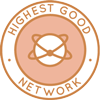 One Community is creating community conservation through diversification through open source Highest Good Network® software that is a web-based application for collaboration, time tracking, and objective data collection. The purpose of the Highest Good Network is to provide software for internal operations and external cooperation. It is being designed for global use in support of the different countries and communities replicating the One Community sustainable village models and related components.
One Community is creating community conservation through diversification through open source Highest Good Network® software that is a web-based application for collaboration, time tracking, and objective data collection. The purpose of the Highest Good Network is to provide software for internal operations and external cooperation. It is being designed for global use in support of the different countries and communities replicating the One Community sustainable village models and related components.
- Learn about our open source community collaboration and management software: The Highest Good Network
This week, the core team continued their work on the Highest Good Network PR testing and confirmed fixes for several issues, including the leaderboard header (#3018), the placement of lists on the Reports page for Projects, People, and Teams (PR 3190), the population of data upon input click (#3201), updates to the reusable form (#3145 and #1224), the implementation of a People Report bio toggle (#3218), the elimination of the need for additional saving in the Quick Setup Tool (#3031), improvements to the purchase request reusables (#3221), and the addition of a toggle request for the bio permission (PR 2289). Unresolved issues included design problems on narrow screens for the Projects/People/Teams page (PR 2473), the fixed width requirement for the User Management title column (PR 3177), profile page issues (PR 3187), and the QSC color not changing (#3227). Additionally, they recorded a video detailing an issue with the accuracy of the first and last day and the auto-refresh function on deactivation (PR 3176) and assigned a task to volunteer to fix the “Team Weekly Summaries” on Darkmode (6 hours). These improvements represent incremental steps towards the realization of community conservation through diversification. See the Highest Good Society and Highest Good Network pages for more on how this relates to community conservation through diversification. The collage below shows some of their work.
ALPHA SOFTWARE DEVELOPMENT TEAM
This week, the Alpha Team’s summary, covering their work on the Highest Good Network software, was managed by Lin Khant Htel (Frontend Software Developer) and the team includes Eve Ye (Volunteer Software Engineer Intern), Jiaqi Nie (Software Engineer), Nikita Kolla (Full Stack Developer), Rupa Rajesh Bhatia (Software Engineer), Sujith Reddy Sudini (Full-Stack Software Developer) and Vinay Vallabineni (Software Engineer). This software is a foundation of One Community tracking and management process for community conservation through diversification.
Lin reviewed and approved PR #1284 after familiarizing himself with the codebase and successfully running all 14 test cases locally. He consulted with team members, reviewed Alpha Team’s weekly summaries, photos, and videos, and continued his leadership duties—contributing to the overall goals of community conservation through diversification. Sujith refined the HTML structure and styling of the activity comments section to improve usability and responsiveness, laying a solid foundation for backend integration and ensuring alignment with the platform’s design.
Eve improved the Pinterest OAuth integration by switching to the more secure ‘authorization_code’ flow and adding a “Connect to Pinterest” button that manages token storage and renewal. Jiaqi merged notification and user bid endpoints, created a new listing schema, rewrote dependent APIs, and tested them using Postman—both contributing to community conservation through diversification through enhanced system functionality. Nikita resolved dark mode issues on the “Team Weekly Summaries” page and began addressing additional bugs, ensuring consistent visual design and accessibility across the app.
Rupa restructured the multi-step form with modular React components, integrated interactive UI elements, and optimized state management using hooks. She also enabled digital signatures, persistent user preferences, and real-time validation while collaborating across teams to refine features and support leadership development—all aligned with community conservation through diversification. Vinay developed dynamic scoring and ranking logic for the questionnaire dashboard, updating the data pipeline to retrieve average scores with team-based filters, and pushed the updated code to the repository. See the Highest Good Society and Highest Good Network pages for more on how this relates to creating community conservation through diversification. See below for some of the team’s work.
BINARY BRIGADE SOFTWARE DEVELOPMENT TEAM
The Binary Brigade Team’s summary overseeing advancements in the Highest Good Network software was managed by Aureliano Maximus (Volunteer Software Engineer) and includes Amalesh Arivanan (Software Engineer), Anirudh Sampath Kumar (Software Developer), Deepthi Kannan (Software Engineer), Geeta Matkar (Software Engineer), Jaissica Hora (Software Engineer), Nikhil Routh (Software Engineer), Sabitha Nazareth (Software Engineer), Sidhartha Sunkasari (Software Engineer), Sriram Seelamneni (Software Engineer), Samman Baidya (Software Engineer), Sunil Kotte (Full Stack Developer), Vasavi Vuppala (Software Engineer), and Wangyuan Chen (Software Engineer). The Highest Good Network software is how we’ll be managing and objectively measuring our progress in creating community conservation through diversification through our social architecture, construction, production, and maintenance processes.
This week, Amalesh reviewed 15 pull requests (#1288, #1294, #3313, #3319, #3322, #3325, #3327, #3332, #3335, #3337, #3338, #3342, #3343, #3345, #3346, #1298), which covered frontend and backend features including dashboard metrics, tag endpoints, calendar views, and leaderboard logic—each contributing to creating community conservation through diversification—documenting each with screenshots and uploading them to a shared folder. He also implemented PR #3356 to add a TSA Form to the HighestGoodNetwork app with navigation and validation logic. Anirudh worked on three pull requests, resolving merge conflicts and errors in test files, fixing a search bar bug, and updating overlapping code, each change reinforcing our broader goal of creating community conservation through diversification. This week, Aureliano became familiar with management responsibilities by completing the previous week’s tasks as practice and updating their weekly summary to reflect a manager’s perspective aligned with creating community conservation through diversification. He addressed a file upload issue where files were not resetting to null when users attempted to re-upload the same file. Deepthi addressed a responsiveness issue affecting leaderboard headers on high-resolution devices by replacing a fixed breakpoint with a dynamic condition based on screen width, supporting both visual clarity and our commitment to creating community conservation through diversification, and is collecting feedback for further refinements.
Geeta began work on the social media dashboard by analyzing key metrics and components from platforms like LinkedIn to guide future development and frontend UI adjustments that align with creating community conservation through diversification. Jaissica fixed linting issues on a donut chart and ensured visual consistency across light/dark modes and screen sizes, while also building backend endpoints to retrieve buildingTools data and reviewing weekly summaries for four team members, further reinforcing the mission of creating community conservation through diversification. Nikhil continued the migration to CSS Modules by converting .css files to .module.css format in the src directory, modifying 108 JSX files and resolving class reference issues in a manner that supports the broader vision of creating community conservation through diversification. Sabitha Rachel Nazareth worked on the listings and bidding platform for the Highest Good Housing project by writing APIs to fetch, update, and add villages, setting up the corresponding routes and controllers, and beginning the logic to filter villages based on specific criteria—all of which contribute to creating community conservation through diversification—with plans to clarify a related doubt with Jae. Sidhartha Sunkasari added a date range and comparison filter to the TotalOrgSummary page in the frontend and began backend updates to handle new comparison values that align with our strategy of creating community conservation through diversification.
Sriram worked on the TimeLogger component, resolving time synchronization issues and adding a search function by team, username, and role, each refinement reflecting our principles around creating community conservation through diversification. Samman worked on Phase III navigation bar updates, organizing menus and routes, integrating them into the dropdown, and addressing styling issues, while also progressing on the “Share PDF” task—all part of our efforts in creating community conservation through diversification. Sunil refined frontend logic in the Weekly Summaries Reports page to properly filter deactivated users by creation date, adjusted how the _id field is interpreted, and created pull requests for the updates—steps that support our focus on creating community conservation through diversification. Vasavi resolved a UI issue in the Dashboard > Tasks > Progress Column using CSS adjustments and fixed linting errors in the src/components/Projects and UserProfile directories, both efforts contributing to creating community conservation through diversification. Kaia implemented a new email assignment module for Weekly Summary BCC recipients. The feature allows users to search, add, and remove recipients via a dynamic modal interface, reinforcing usability in support of creating community conservation through diversification. See the Highest Good Society and Highest Good Network pages for more on how this relates to creating community conservation through diversification. View some of the team’s work in the collage below.
BLUE STEEL SOFTWARE DEVELOPMENT TEAM
The Blue Steel Team’s summary, presenting their work on the Highest Good Network software was managed by Sheetal Mangate (Software Engineer) and includes Humemah Khalid (Software Engineer/Backend Developer), Ramakrishna Aruva (Software Engineer), Sai Girish Pabbathi (Software Engineer), Sharan Sai Marpadaga (Software Developer) and Srichand Medagani (FullStack Developer). The Highest Good Network software is how we’ll be managing and objectively measuring our process for community conservation through diversification.
This week, Sai focused on tasks assigned by Jae, including displaying popups, filtering by date, using icons, and handling profile pages. He completed the CSS for properties to allow viewing on the same page as listings and spent time reviewing Airbnb’s interface to understand typical user interface patterns for day-to-day use, contributing to community conservation through diversification by improving the platform’s accessibility. Ramakrishna identified the root cause of a state management issue where the userProfile state, specifically the project’s data, was not updating correctly, leading to outdated data being sent to the backend. He explored solutions using Promises and useState to address the issue, implementing a solution to update the project’s data based on the previous userProfile state, which aligns with the goals of community conservation through diversification. After pulling the latest development changes, he made necessary adjustments and reviewed the updated codebase to ensure alignment with the current implementation. Humemah worked on the ‘HGN Questionnaire Dashboard: Backend: Implement Community Members List with Filtering, Sorting, and Search’ task, ensuring data retrieval and confirming the GET endpoint’s functionality, enhancing community conservation through diversification by improving data management. He also worked on the weekly summary and uploaded the corresponding Dropbox images, with filtering and sorting features still in progress.
Srichand worked on fixing the default 404 error page implementation and redirection. He analyzed the task details, ensured the error page displayed correctly for unsupported or invalid URLs, and included links for navigating to the dashboard and opening the Suggestions/Development modal. He identified issues with the previous PR and reviewed the NotFoundPage implementation to correctly place routing, layout, and modal logic, using ChatGPT to research connecting components and sharing modal state across the app. Sharan worked on understanding the requirements for building the Additional Notes and Work Experience section on the user page, reviewing the APIs to fetch the necessary information and gaining an understanding of how to begin implementing the section. Sheetal completed the task functionality for “Development for Re-Engagement Strategies,” performing code cleanup and a code review for the pull request. She also worked on the CSS to adjust the alignment of the form fields from the noShoList popup and added an error message at the bottom of the popup, replacing the previous alert system. Sheetal tested the functionality to ensure everything was working as expected. See the Highest Good Society and the Highest Good Network pages to learn more on how their work contributes to community conservation through diversification. See below to view images of their work.
CODE CRAFTERS SOFTWARE DEVELOPMENT TEAM
The Code Crafters Team, covering their work on the Highest Good Network software, was managed by Sundar Machani (Software Engineer) and includes Anjali Maddila (Software Engineer), Ashrita Cherlapally (Software Engineer), Denish Kalariya (Software Engineer), Humera Naaz (MERN developer), Kshitij Gugale (Software Engineer), Pavan Swaroop Lebakula (Software Engineer), Pratyush Prasanna Sahu (Software Engineer), Rohith Nayakar (Full Stack Developer), Sai Moola (Software Engineer), Sanjeevkumar Hanumantlal Sharma (Software Engineer) and Xiaolei Zhao (Software Engineer). The Highest Good Network software is how we’ll manage and objectively measure our process for community conservation through diversification through our social architecture, construction, production, and maintenance processes.
This week, Sundar worked on the HGN Software Development project focused on building the frontend for the “Paid Labor Cost” grouped-bar chart component within the Phase 2 Summary Dashboard. He created the base card structure, explored relevant data fields for UI mapping, added filters for tasks, projects, and dates, styled the dropdown using custom CSS, integrated an Airbnb-style date picker, implemented sorting logic to display tasks by ascending cost with the top two highlighted, adjusted mock data to fit the required structure, and updated the layout and styling to match the Figma design, contributing to community conservation through diversification. Rohith resolved a dropdown issue in the Weekly Summaries Report component by using global SCSS styles and created a dedicated branch with the fix. He also began working on the Newell refactor of the Weekly Summary component and contributed to the Carlos anniversary feature and Volunteer Hours Distribution update, aligning with the project’s goal of community conservation through diversification. Sai Shekhar linked a button on the initial modal to the openSuggestions modal on the dashboard, adjusted the dropdown dimensions, raised PR #3357, resolved issues from a rebase by reverting certain commits, and began work on a backend task. Xiaolei submitted PR #1302 to add a GET /lessons-learnt endpoint for the BM dashboard backend, enabling filtering by projectId and date range, aggregating lesson counts, and calculating month-over-month percentage change, and began exploring requirements for the Loss Tracking Line Graph backend, which supports the broader vision of community conservation through diversification.
Anjali addressed an error related to user name display when switching tabs and raised PR #3319 for the fix, then implemented a tracking button in the permission management section. Community conservation through diversification was an important consideration in the feature’s implementation. Pratyush reviewed several pull requests, including PRs 3373, 3372, 3370, 3368, 3367, and 3365, checking functionality, mobile responsiveness, lint errors, and UI appearance across themes. He also worked on the material dashboard summary task, fixed lint issues, and prepared a pull request. Sanjeevkumar completed five APIs for financial summaries with assumptions for labor time data, began gathering requirements, and started developing the backend API for the “Distribution of Labor Hours” pie chart in the Phase 2 Summary Dashboard. Ashrita integrated React Query and Axios for data fetching with a loading animation, developed tooltip hover functionality to display tag frequency, added basic click functionality, and faced challenges with font scaling logic and syncing date filter updates in the mind map rendering, further supporting the goals of community conservation through diversification.
Denish investigated a performance issue affecting the profile page by simulating recent changes in a controlled environment to isolate causes of the slowdown, comparing performance metrics, and reviewing modified components. Humera implemented a compressed zip file solution to manage user and login data using gzip headers, aiming to improve data handling efficiency. Pavan analyzed layout issues in the dashboard’s timer panel caused by a previous pull request and worked on adjusting the implementation to restore the prior appearance without affecting other components. Kshitij updated styles in `AddTaskModal.css` and adjusted elements in `AddTaskModal.jsx` to fix layout issues in the Add Task modal. He investigated why UI changes weren’t appearing by clearing the build cache, reinstalling dependencies, and rebuilding the app. Changes were committed and pushed on the correct branch, `hotfix/fix-wbs-add-task-format`. The issue seemed related to Webpack or browser caching, or how Hot Module Reloading handles file updates. See the Highest Good Society and Highest Good Network pages for more on how this relates to community conservation through diversification. View some of the team’s work in the collage below.
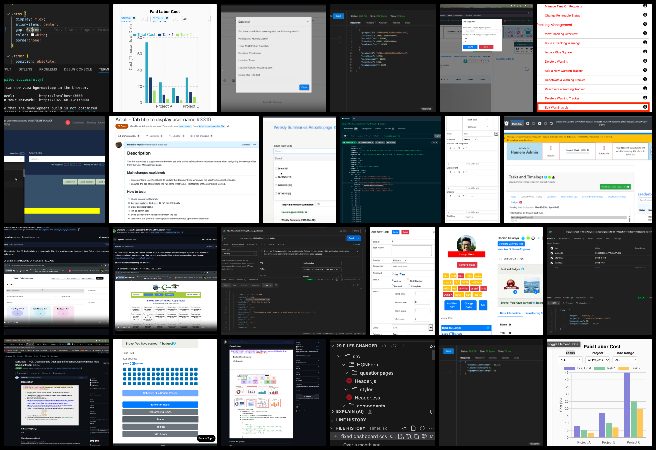
DEV DYNASTY SOFTWARE DEVELOPMENT TEAM
The Dev Dynasty Team’s summary, covering their work on the Highest Good Network software, was managed by Nishita Gudiniye (Software Engineer) and includes Honglin Chen (Software Engineer), Mohan Satya Ram Sara (Software Engineer), Jatin Agrawal (Software Engineer), Shraddha Shahari (Software Engineer), Tanvi Anantula (Software Engineer), Vaibhav Koladiya (Software Engineer), Vamsi Krishna (Software Engineer) and Zhifan Jia (Software Engineer). The Highest Good Network software is how we’ll manage and objectively measure our process for community conservation through diversification through our social architecture, construction, production, and maintenance processes.
This week, Honglin completed PRs 765 and 1984, adding actions, reducers, and toast notifications for updating and deleting inventory types and units of measurement. He also reviewed pull requests older than six months and documented their status—ready to merge, close, or reassign—contributing to the goals of community conservation through diversification. Jatin tackled bugs in the email auto-reply system, implemented workflows for various user completion scenarios, and finalized messaging updates for the lbdashboard. Mohan began setting up permission-based access control for the HGN skill dashboard, reviewed the database structure, and drafted integration plans to ensure scalability in line with community conservation through diversification.
Nishita enhanced dark mode for the event registration confirmation modal and the “Event Personalization” page, aligning both with the design system. She also prepared for managerial duties by reviewing training materials, supporting community conservation through diversification through team leadership. Shraddha addressed multiple bugs, including issues with the Equipment List update button, Featured Badges, badge assignments, and email functionalities, contributing to system stability and the overarching mission. Tanvi submitted a new, conflict-free pull request to replace a previously problematic one, ensuring smooth deployment processes aligned with community conservation through diversification.
Vaibhav developed a refresh notification popup, resolved display issues by implementing a new hash function, and created an update-hash.yml file to automate updates. He tested the feature and reviewed several pull requests for HighestGoodNetworkApp, advancing the goals of community conservation through diversification. Vamsi created a permission feature to track how often tasks are extended, added a corresponding option in the frontend, and aligned this functionality with platform goals. Zhifan completed backend functions for a donut chart visual, resolved multiple Node.js-related issues, tested with synthetic data, submitted a pull request with video proof, and updated prior PR names—supporting project consistency and community conservation through diversification. See the Highest Good Society and Highest Good Network pages for more on how this relates to community conservation through diversification. View some of the team’s work in the collage below.
EXPRESSERS SOFTWARE DEVELOPMENT TEAM
The Expressers Team’s summary, covering their work on the Highest Good Network software, managed by Strallia Chao (Software Engineer), includes Ghouse Shahe Meera Ziddi Mohammad (Software Engineer Intern), Meenashi Jeyanthinatha Subramanian (Full Stack Developer), Rahul Trivedi (Software Engineer) and Reina Takahara (Software Developer). The Highest Good Network software is how we’ll manage and objectively measure our process for community conservation through diversification through innovative software development, testing, and collaboration. This week, Ziddi continued work on the listing dashboard, focusing on fetching availability data for each unit. This involved identifying booked appointments, checking for pending reservations, and ensuring that time slots are made available when reservations are cancelled. To support this functionality, he began developing the necessary APIs, with an estimated requirement of three to four endpoints to complete the task.
Meenashi set up the webhook event controller and routes, then simulated events using Cloudflared. The bidAndPay details matching the screen were triggered, resulting in the creation of the PAYMENT.AUTHORIZATION.CREATED event, which in turn called the webhook. However, the webhook initially failed due to a 401 unauthorized error caused by the middleware.js file. After resolving the authorization issue and returning a success response, she observed that the webhook code was still not executing and continued investigating the issue. The efforts put in by Meenashi contribute to community conservation through diversification by ensuring smooth technical operations. Rahul worked on the HGN Questionnaire Dashboard by integrating the User Profile Page into the main application. He created a new branch and pushed the code. Backend API endpoints were connected to enable real-time data display, and frontend styling was improved for better responsiveness and visual accuracy. He added a GitHub section to user contact information, included a skills chart to display user skills, integrated Manoj’s backend API, and suggested data structure updates to better meet project requirements, further supporting community conservation through diversification.
Reina re-familiarized herself with the code base and selected a new task to create an interactive map showing project locations for Phase 2. After resolving local setup issues by updating her software, she created a new route for the interactive map and implemented it using Leaflet JS. She began populating the backend with fake data and started working on retrieving and displaying that data on the frontend. Strallia reviewed PR #3332 related to the Global Volunteer Map on the Total Org Summary Page. She provided feedback, reverted out-of-scope commits, added a loading icon, resolved merge conflicts, and integrated the backend API for custom date selection in the Volunteer Trends Line Chart. Additionally, she updated the progress tracking sheet to reflect frontend chart changes. See the Highest Good Society and Highest Good Network pages for more on how this contributed to community conservation through diversification. See the collage below to view the team’s work.
LUCKY STAR SOFTWARE DEVELOPMENT TEAM
The Lucky Star Team’s summary of the Highest Good Network software, was managed by Anne Zhang (Software Engineer) and includes contributions from Barnaboss Puli (Volunteer Software Engineer), Chetan Sunku (Software Engineer), Dipti Yadav (Software Engineer), Harini Korda (Software Engineer), Koushica Bosadi Ulaganathan (Software Engineer), Manoj Gembali (Software Engineer) and Vaibhavi Madhav Deshpande (Software Engineer). This improvement fostered a sense of ownership, much like that seen in community conservation through diversification where collective action drives progress.
This week, Barnaboss worked on improving code quality and developing backend features for the Phase 2 Summary Dashboard of the HGN Software project, resolving ESLint and Prettier issues in the src/components/TeamMemberTasks/ directory and submitting a pull request, while also working on caching and backend logic for visualizations including a Donut Chart for Project Status and a Bar Graph for Total Material Cost per Project, encountering and addressing mongosh authentication issues. Chetan continued work on fixing the “i” popup icon issue on the Weekly Summaries Reports page, focusing on ensuring popups appear correctly for roles other than “Volunteer” and are editable by Owners, with implementation and verification in progress. This improvement fostered a sense of ownership, much like that seen in community conservation through diversification where collective action drives progress.
Dipti completed task 763 related to saving and auto-populating Work Breakdown Structure content during auto-refresh, submitting backend and frontend pull requests (PR 1298 and PR 3346), and began work on a new issue related to the archive button not functioning, which involved investigating relevant files and identifying necessary fixes. Harini resolved merge conflicts and deployment issues in the Global Volunteer Map component, updated the Total Org Summary dashboard to improve the map and volunteer location display, addressed Netlify deployment warnings, and worked on the “Total People Report Hours” task by updating a label from “Total Logged Time” to “Total Tangible Logged Time.” Koushica resolved autosave issues in the user profile’s Quick Setup section, fixed bell notification behavior related to bar data load times, and implemented a hotfix for UI breakage caused by a new CSS file, while also starting a discussion on longer-term CSS management solutions. This improvement fostered a sense of ownership, much like that seen in community conservation through diversification where collective action drives progress.
Manoj added logging and permission authentication to a backend endpoint, created PR #1301 with screenshots, and began frontend development for the new Community Members HGN Help page by reviewing the task and Figma designs and setting up routes and components. Vaibhavi reviewed multiple pull requests for code quality and functionality, tested updates for system stability, and worked on advancing her own pull requests by refining features, testing, and preparing them for review. Anne worked on debugging a new bug related to saving blue square reasons for specific One Community roles, managed the Lucky Star team’s reviews and pictures of the week, and answered questions from team members regarding tasks and responsibilities. See the Highest Good Society and Highest Good Network pages for more on how this relates to community conservation through diversification. See the collage below to view the team’s work.
MOONFALL SOFTWARE DEVELOPMENT TEAM
The Moonfall Team’s summary, covering their work on the Highest Good Network software was managed by Newell Newell (Manager) and includes Angad Anil Gosain (Volunteer Software Engineer), Bhavpreet Singh (Software Engineer), Calvin Liu (PR Team), Lalith Kumar Rajendran (Software Engineer), Nikhil Giri (Software Engineer), Samhitha Gouru (Software Engineer), Shashank Kumar (Software Engineer), Sravya Kotra (Software Engineer), Vivek Sharma (Software Engineer), and Yili Sun (Software Engineer). This week, Angad reviewed multiple pull requests, validated backend endpoints, resolved layout, and logic issues, made UI improvements, and addressed test warnings and formatting problems before submitting a final pull request. Bhavpreet updated the wishlist model schema, routes, and controller functions to match frontend changes and replaced a custom image carousel with a Bootstrap version for ease of use, contributing to the broader goals of community conservation through diversification.
Lalith modified the handling of admin and owner role permissions by removing hardcoded logic and integrating it into the permissions management flow. Newell worked on implementing CASL-based attribute-based access control policies using PostgreSQL and Nest.js, protected backend domains with Cloudflare, completed Azure NSG and Cloudflare Firewall protection, addressed Azure-related issues, and worked on file uploading and new backend endpoints in Nest.js. Samhitha worked on designing and developing a bar graph to display the risk profile of projects, including a labeled X-axis with project names and color-coded bars for predicted cost overruns, time delays, and open issues, along with dropdown filters for project and date selection and dynamic filtering logic, which ties into community conservation through diversification by ensuring better project management. Shashank focused on making components responsive across screen sizes, studied PayPal’s SDK for checkout, customized card payment input fields using developer credentials, and worked around incomplete backend APIs.
Sravya fixed layout issues in the User Management UI by identifying the cause of recent CSS changes and applying a hotfix to restore alignment, spacing, and link color, which helps streamline the user interface as part of the effort towards community conservation through diversification. Yili worked on unit tests for profileInitialSetupController.js, refactored logic for better testability, resolved merge conflicts in multiple pull requests, and addressed change requests related to user permissions and editing team codes. See the Highest Good Society and Highest Good Network pages for more on how this relates to creating community conservation through diversification. Below is a collage for the team’s work.
REACTONAUTS SOFTWARE DEVELOPMENT TEAM
Reactonauts’ Team’s summary, covering their work on the Highest Good Network software, was managed by Vijeth Venkatesha (Software Engineer) and includes Akshay Jayaram (Software Engineer), Ghazi Rahman (Software Engineer Intern), Gmon Kuzhiyanikkal (Software Engineer), Guirong Wu (Software Engineer), Haoyue Wen (Software Engineer), Keying Guo (Software Engineer), Khushi Jain (Software Engineer), Mohan Gopi Gadde (Software Engineer), Nikhil Pittala (Software Engineer), Pallavi Thorat (PR Team O-Sh), Peterson Rodrigues (Full-Stack MERN Stack Developer), Rishitha Mamidala (Software Engineer), Rishwa Patel (Software Developer), Saniya Farheen (Software Engineer), Sharadha Shivakumar (Software Engineer), and Xiyan Li (Software Engineer Intern). This software is a foundation of One Community tracking and management process for supporting the abundance of the earth.
This week, Akshay focused on backend validation for user profiles, investigating the missing timeZone property through MongoDB queries, API inspections, and cache checks. He reviewed the Mongoose schema, restarted servers after each change, and used Postman to test real-time data responses, aligning his efforts with community conservation through diversification. Ghazi enhanced the financial summary cards by refining spacing, font styles, tooltips, and responsiveness. He optimized layouts for mobile and desktop views, tested UI consistency, and initiated a PR for dynamic button population, contributing to community conservation through diversification.
Gmon addressed hidden member tasks and added bell notifications based on task deadlines. He submitted PR 2850 for review, organized reference materials, and explored the project’s architecture, contributing to community conservation through diversification. Guirong resolved multiple formatting and editability issues in the Reports section and introduced a new contributors report filter with editable icons, all supporting community conservation through diversification. Haoyue fixed merge conflicts and ESLint errors for the FAQ tool and began developing analytics for job posting data visualization, aligning with community conservation through diversification. Khushi created a responsive Phase 2 Summary Dashboard pie chart with filters and interactive hover features, also implementing dark mode to support accessibility and community conservation through diversification.
Mohan updated the badge assignment system to support assigning multiple badges to multiple users, modifying front-end and back-end logic to ensure flexibility and compatibility, aligning with community conservation through diversification. Nikhil reviewed 14 pull requests across the stack, providing feedback and verifying functionality to maintain high code quality and support global sustainability strategies. Pallavi implemented a modal and backend system for question editing in the form builder, including template management with full CRUD support and user-level access control, all contributing to community conservation through diversification. Peterson resolved two 404 page bugs related to URL structure errors, supporting global sustainability through improved user experience.
Rishitha developed a bar chart with filters to visualize issue types and counts, supporting data clarity and community conservation through diversification. Rishwa set up the routing and folder structure for the HGN Help Skills Dashboard, creating key components and ensuring a clean Git commit history, reinforcing a scalable design that contributes to community conservation through diversification. Saniya worked on Figma mockups and iterated on feedback to improve wireframe design, aligning her updates with open-source global sustainability strategies. Sharadha improved the Job Posting UI and resolved merge conflicts on event registration features, submitting clean PRs that support community conservation through diversification.
Xiyan developed a URL shortening service with API integration, history tracking, and clipboard functionality using TypeScript for enhanced maintainability and usability, aligning with community conservation through diversification. Vijeth focused on team coordination and MongoDB performance optimization, reviewing summaries and addressing system slowdowns to ensure better functionality, contributing to the broader goals of community conservation through diversification. See the Highest Good Society and Highest Good Network for more on how this contributed to ecological global transformation. See the collage below to view the team’s work.
SKYE SOFTWARE DEVELOPMENT TEAM
Skye Team’s summary, covering their work on the Highest Good Network was managed by Olimpia Borgohain (Data Analyst and Team Admin) and Luis Arevalo (Software Engineer) and the team includes Sai Preetham (Full Stack Developer), Snehal Dilip Patare (Software Engineer), Vikas Nomula (Software Engineer) and Yao Wang (Software Engineer). The Highest Good Network software helps manage and objectively continue with supporting open sourcing community conservation through diversification, focusing on social architecture, construction, production, and maintenance processes to build sustainable and thriving ecosystems. This solution is portable, scalable, and ideal for off-grid or sustainable living communities.
This week, Luis resolved a grey icon issue in the warning popup by identifying a styling conflict and created a pull request. He explored YouTube API options for automating community posts but suggested switching tasks after finding no suitable solution. He also discussed potential improvements to the warnings component with Jae, by contributing to community conservation through diversification enhancing the user experience. Sai Preetham integrated a calendar-style time picker into the Materials page, resolved merge conflicts, and raised a pull request. He began analyzing the role-change confirmation modal task and revisited a tracking management task based on feedback, confirming its functionality and creating a demonstration video, further supporting the objectives of community conservation through diversification.
Snehal implemented Facebook post scheduling functionality, updated backend components, unified Twitter and Facebook functionality into a single interface, and added post scheduling options with history display on the frontend. Vikas worked on the YouTube autoposter task but the work was paused due to API limitations, and focus shifted to developing an autoposter for Medium, which provides an API for posting content. Yao refined backend and frontend implementations of the Reddit Auto Poster feature and created a handoff document outlining the status of Reddit and LinkedIn auto poster features for future development. See the picture below for the work done by the team on community conservation through diversification.
SOFTWARE PR REVIEW TEAM A-E
The PR Review Team’s summary for team members’ names starting with A-E and covering their work on the Highest Good Network software was managed by Saumit Chinchkhandi (Administrative Assistant and Software Engineer). The Highest Good Network software is a foundation of what we’ll be using to measure our results of community conservation through diversification. This week’s active members of this team were: Abdelmounaim Lallouache (Software Developer), Akanksha Singh (Software Developer), Carl Bebli (Software Engineer), Carlos Gomez (Full-Stack Software Developer), and Dharmik Patel (Software Engineer). They assisted with the research for community conservation through diversification by reviewing all the Highest Good Network PRs (Pull Requests) shared in this week’s update. Learn more about how the Highest Good Network measures community conservation through diversification by exploring the Highest Good Network open-source hub. The collage below shows a compilation of the work from this team.
SOFTWARE PR REVIEW TEAM F-M
The PR Review Team’s summaries for team members’ names starting with F-M and covering their work on the Highest Good Network software was managed by Anoushka Hazari (Data Analyst). The Highest Good Network software is a foundation of what we’ll be using to measure our results for community conservation through diversification. This week’s active members of this team were: Ganesh Karnati (Software Engineer), Greeshma Palanki (Software Engineer), Kurtis Ivey (Full Stack Developer), Linh Huynh (Volunteer Software Engineer), Manusha Jyasta (Senior Software Engineer), and Manvitha Yeeli (VolunteerSoftware Engineer). They reviewed all the Highest Good Network PRs (Pull Requests) shared in this week’s update. Learn more about how the Highest Good Network will measure and assist in community conservation through diversification in the Highest Good Network open source hub. The collage below shows a compilation of the work from this team.
SOFTWARE PR REVIEW TEAM N-R
The PR Review Team’s summaries for team members’ names starting with N-R and covering their work on the Highest Good Network software was managed by Govind Sajithkumar (Software Project Manager). The Highest Good Network software is a foundation of what we’ll be using to measure our results of community conservation through diversification. This week’s active members of this team were: Nahiyan Ahmed (Full Stack Software Developer), Nathan Hoffman (Software Engineer) and Ravikumar Sripathi (Software Engineer). They reviewed all the Highest Good Network PRs (Pull Requests) shared in this week’s update. Learn more about how the Highest Good Network measures community conservation through diversification by exploring the Highest Good Network open-source hub. The collage below shows a compilation of the work from this team.
SOFTWARE PR REVIEW TEAM S-Z
The PR Review Team’s summaries for team members’ names starting with S-Z and covering their work on the Highest Good Network software was managed by Jaiwanth Reddy (Software Project Manager). The Highest Good Network software is a foundation of what we’ll be using to measure our results of community conservation through diversification. This week’s active members of this team were: Siva Putti (Software Engineer) and Yiyun Tan (Software Engineer). They reviewed all the Highest Good Network PRs (Pull Requests) shared in this week’s update. Learn more about how the Highest Good Network measures community conservation through diversification by exploring the Highest Good Network open-source hub. The collage below shows a compilation of the work from this team.
AND WE PRODUCED THIS WEEKLY UPDATES BLOG – CLICK HERE TO SUBSCRIBE
FOLLOW ONE COMMUNITY’S PROGRESS (click icons for our pages)
INVESTOR PAGES
GET INVOLVED
Thanks for Your Contributions to Our Design Team Silin Wang!
Posted on March 29, 2025 by One Community Hs
One Community thanks Silin Wang for her contributions as a Volunteer/Consultant on the Design Team!!

Silin holds a Master of Landscape Architecture from the Rhode Island School of Design and a Bachelor’s degree in Environmental Design from the Xi’an Academy of Fine Arts, supported by over 15 years of professional drawing experience. She is a thoughtful and perceptive designer, passionate about conducting in-depth site analyses and crafting innovative design solutions for complex environmental challenges. Her academic and later professional work centers on sustainable and experiential spatial design, spanning residential landscapes, urban public projects, and ecological restoration. As a member of the One Community team, Silin contributed to the design of a subterranean food production structure, and believes that good food infrastructure and agricultural landscape planning can bring long-term benefits to communities. She is responsible for rendering, animation, and reporting of the Zenapini #2: Tropical Moist House model, integrating sustainable agriculture strategies with functional spatial planning.
WELCOME TO THE TEAM SILIN!
FOLLOW ONE COMMUNITY’S PROGRESS (click icons for our pages)
INVESTOR PAGES
GET INVOLVED
Ecological Global Transformation – One Community Weekly Progress Update #627
Posted on March 24, 2025 by One Community Hs
One Community is forwarding ecological global transformation by developing sustainable approaches to food, energy, housing, education, for-profit and non-profit economic design, social architecture, fulfilled living, global stewardship practices, and more. Our innovative model is designed to be self-replicating and will be used to create a global collaboration of teacher/demonstration hubs. We are committed to doing this for “The Highest Good of All” and creating everything so it is open source and free-shared, including open sourcing and free sharing the complete process.
- Here’s our project overview
- Here’s our world-change methodology
- Here’s how this becomes self-replicating
- Here’s how we are open source and free-sharing all the do-it-yourself designs

OUR MAIN OPEN SOURCE HUBS
Click on each icon to be taken to the corresponding Highest Good hub page.
One Community’s physical location will forward this movement as the first of many self-replicating teacher/demonstration communities, villages, and cities to be built around the world. This is the March 24th, 2025 edition (#627) of our weekly progress update detailing our team’s development and accomplishments:
Ecological Global Transformation
One Community Progress Update #627
DONATE | COLLABORATE | HELP WITH LARGE-SCALE FUNDING
CLICK HERE IF YOU’D LIKE TO RECEIVE AN EMAIL EACH WEEK WHEN WE RELEASE A NEW UPDATE
YOU CAN ALSO JOIN US THROUGH SOCIAL MEDIA
ONE COMMUNITY WEEKLY UPDATE DETAILS
HIGHEST GOOD HOUSING PROGRESS
 One Community is forwarding ecological global transformation through Highest Good housing that is artistic and beautiful, more affordable, more space efficient, lasts longer, DIY buildable, and constructed with healthy and sustainable materials:
One Community is forwarding ecological global transformation through Highest Good housing that is artistic and beautiful, more affordable, more space efficient, lasts longer, DIY buildable, and constructed with healthy and sustainable materials:
- Learn about: Our Upcoming Crowdfunding Campaign
- Learn about the different village models: 7 Sustainable Village Models
- Visit the open source portals for the first two: Earthbag Village OS Hub | Straw Bale Village OS Hub
This week, Adil Zulfiquar (Engineer) continued working on the Vermiculture Toilet engineering designs. Adil reviewed the Truly Passive Greenhouse report and provided feedback based on a preliminary assessment. Most of his work focused on the Temperature Monitoring and Control for Vermiculture System report, where he analyzed multiple device options, ranging from plug-and-play devices to advanced PLC controllers. The analysis considered temperature control solutions capable of switching between heating and cooling based on preset thresholds to maintain optimal conditions for vermiculture composting. The Earthbag Village, the first of seven planned villages, serves as the initial housing component within One Community’s open source model for ecological global transformation. See below for some of the pictures related to this work.
Anil Karathra (Mechanical Engineer) continued advancing the engineering and design of the Vermiculture Toilet for the Earthbag Village project. The CAD for the slider insertion platform was edited to align with the updated height of the vermiculture toilet structure, and a new assembly was created using the revised parts. The team meeting was attended, and work on the eco toilet seat continued, including the development of assembly instructions and a design report. The eco toilet design was refined further, and a design explanation and review video was recorded for feedback. The design report for the eco toilet seat was finalized and submitted. Additional edits were made to the slider insertion platform, and screenshots of the week’s work were uploaded to Dropbox along with the weekly summary. This commitment to ecological global transformation drives the development of innovative, eco-friendly solutions that balance environmental responsibility with high standards of functionality. See below for pictures related to this work.
Audrey Gunawan (Mechanical Engineer) continued working on the Vermiculture Toilet plumbing details. Audrey worked on the SolidWorks model for the plumbing of the flush toilets, revising the plumbing plan after determining that the existing design was not viable. She modeled connectors for the system and worked on fully integrating the updated plan. Most of her time was spent modeling parts and resolving mating errors in the SolidWorks model. She determined that a single main plumbing line running in the opposite direction would be more suitable and assessed its impact on the non-urinal components of the vermiculture toilets. As the first of seven planned villages, Earthbag Village provides the initial housing within One Community’s open source designs for ecological global transformation. See below for some of the pictures related to this work.
Derrell Brown (Plumbing Designer) continued working on the Earthbag Village 4-dome home plumbing details. Derrell coordinated with Michaela to address remaining electrical items and continued work on the electrical design. Following the meeting, he added circuits in Revit for the remaining receptacles, HVAC equipment, and plumbing equipment. These circuits were incorporated into an Excel worksheet to generate a load summary, including total equipment, amperage, kVa values, and a panel board setup. Using this data, he developed a panel schedule and a mechanical equipment schedule for inclusion in the electrical sheets. Once these schedules were imported, he plotted a 75% electrical review set for Michaela to review for comments and questions. One Community’s open source launching of ecological global transformation begins with Earthbag Village, the first of seven planned villages providing housing. See below for some of the pictures related to this work.
Faeq Abu Alia (Architectural Engineer) continued his work on the Earthbag Village 4-dome home renders. Faeq rendered the walkthrough video while incorporating feedback notes. He refined the 4-dome home design by applying double-layered materials and adding electrical spot placements according to the electrical plans to improve the visual presentation and ensure design cohesion. The Earthbag Village is the first of 7 to be built as the housing component of One Community’s open source plans for ecological global transformation. View examples of this work in the pictures provided below.
Keerthi Reddy Gavinolla (Software Developer) continued working on the Vermiculture Eco-toilet Container Transport Solution web page. Keerthi updated Blog 626 and edited the Vermiculture Eco-toilet Container Transport Solution webpage after reviewing Jae’s feedback. The updates included formatting images, changing heading names, linking sections appropriately, justifying paragraphs, and adding relevant SEO terms in image alt attributes. She also ensured that the overall formatting met the required standards. In addition, she worked on testing and reviewed PRs #3263, #3215, #2751, and others, confirming that all were functioning as expected. One Community’s open source tools and tutorials for ecological global transformation begin with the Earthbag Village, the first of seven planned villages providing housing. See below for some of the pictures related to this work.
Michaela Silva (Architect) continued working on the architectural details for the Earthbag Village 4-dome home design. Michaela worked on the construction documents for the windows, selecting the basis of design windows and confirming that the sizes met egress requirements. She created a detailed window elevation view and added a new sheet to organize all window-related information. Additionally, she produced a plan view for the dining room windows. As the first of seven villages in One Community’s open source plan for ecological global transformation, the Earthbag Village represents the housing element. See her work in the collage below.
Rumi Shah (Civil Engineer) continued working on the Earthbag Village upgrades to bring our designs closer to construction-ready plans. Rumi completed the foundation design for the 6-dome Earthbag Village structure, ensuring stability and compliance with U.S. building codes (ACI, ASCE, ASTM). The design process considered load distribution, soil conditions, and reinforcement requirements. After finalizing the design, Rumi drafted AutoCAD drawings with detailed sections illustrating footing dimensions, reinforcement placement, and connection points. These drawings provide clarity for construction teams and serve as a reference for the next phases of the project. One Community’s open source resources for ecological global transformation begin with the Earthbag Village, the first of seven planned villages providing housing. See below for some of the pictures related to this work.
Yi-Ju Lien (Environmental Engineer) continued her work on the Earthbag Village LEED points related to stormwater retention. Yi-Ju revised the Catchment and Storage Calculator for the Rainwater Harvesting System to improve flexibility for nonhomogeneous land use scenarios. Updates included sizing for the Minimum Catchment Area, Storage Sizing for Established Demand, and a new section for Storage Sizing in Site-Specific Scenarios where detailed catchment area data is available. The catchment maps for each harvesting system were updated to align with the latest Earthbag Village layout. Revisions were made to the stormwater harvesting system’s catchment area, considering runoff collection feasibility and ensuring adequate supply to meet water demand. Additionally, content was updated with the latest tables and images, highlighting the importance of maintaining collaboration and unity in ecological global transformation. See some of the work done in the collage below.
DUPLICABLE CITY CENTER PROGRESS
 One Community is forwarding ecological global transformation through a Duplicable and Sustainable City Center that is LEED Platinum certified/Sustainable, can feed 200 people at a time, provide laundry for over 300 people, is beautiful, spacious, and saves resources, money, and space:
One Community is forwarding ecological global transformation through a Duplicable and Sustainable City Center that is LEED Platinum certified/Sustainable, can feed 200 people at a time, provide laundry for over 300 people, is beautiful, spacious, and saves resources, money, and space:
- Learn about this building and it’s function: Duplicable City Center Open Source Hub
This week, Jason Bao (Architectural Designer) continued working on producing renders for the Duplicable City Center library. He initiated communication with Jae and Nimika to clarify next steps. Exterior render videos were finalized, and Nimika’s SketchUp file was reviewed to confirm usability before being restored. All project files were merged into a single Lumion file. Preparations were made to assist Nimika in completing outdoor components, with progress tracked to align with project timelines. The Duplicable City Center is a foundational part of One Community’s open-source model, which excels in ecological global transformation. See some of this work in the pictures below.
Mohammed Maaz Siddiqui (Architect) continued working on the cupola renders for the Duplicable City Center project. He started by developing activity scenes at multiple locations within the Duplicable City Center after importing the updated SketchUp model into the scene. The entire set was then rearranged in the same locations to prepare for render scenes. He also worked on developing and editing the birthday scene based on feedback from Jae. As part of this task, he searched for 3D models online to replace the balloons, but none matched the ongoing scene. Within One Community’s open-source framework, the Duplicable City Center plays a central role in the mission of ecological global transformation. The images below showcase some of this work.
Manjiri Patil (Mechanical Design Engineer) continued working on the designs for the Duplicable City Center DIY-replicable hub connector. She researched and selected 6061-T6 aluminum pipes and sheets as the raw materials for hub connectors. She identified the necessary manufacturing equipment, including cutting and bending tools, and provided relevant references for each process. She also developed a detailed manufacturing document, outlining steps such as marking, cutting, shaping, and finishing to ensure precision and efficiency in fabrication. With the document completed, she is now focused on creating technical drawings for the hub connectors, ensuring accurate design specifications and manufacturability. One Community’s open-source Duplicable City Center is a key part of ecological global transformation. The images below showcase some of this work.
Rudrani “Sravya” Mukkamala (Mechanizal Engineer) continued researching the structural components of a Duplicable City Center hydraulic elevator. Progress was made on the machine room project, including gathering information on the necessary components and completing some calculations. Work was done on designing the layout for the machine room and the overview schematic document, along with flow diagrams for the hydraulic system. The layout for the overview schematic document was prepared, and additional research was done to understand the required parameters for calculating speed. Formulas for speed calculation were reviewed, and relevant parameters needed for those calculations were gathered. Several questions related to the system were noted for further clarification. One Community’s open-source Duplicable City Center is a key part of our ongoing mission for ecological global transformation. The images below showcase some of this work.
Sanket Basannavar (Mechanical Engineer) continued working on the Duplicable City Center spa cover as part of the City Center Natural Pool and Eco-spa Designs. He designed a new holder in SolidWorks to lift the spa cover with a focus on user safety. The plan for the spa cover and pool was completed in AutoCAD, ensuring proper alignment and fit. Research was done on suitable motors and electrical appliances to automate the opening and closing mechanism of the spa cover. Various motor types and power requirements were analyzed to determine the best option for efficient operation. Additionally, considerations were made for integrating the selected components into the existing design without compromising functionality or safety. Ecological global transformation relies on open-source tools like One Community’s Duplicable City Center. The images below showcase some of this work.
Shu-Tsun (Engineer) continued working on the Duplicable City Center by dedicating her time to conducting the structural and frame analysis of the city center dome using Autodesk Inventor, as well as working on the spreadsheet for which she is responsible. She encountered some challenges during the analysis and plans to schedule a meeting to resolve the issues and move forward effectively. Within One Community’s open-source framework, the Duplicable City Center plays a central role in the mission of ecological global transformation. The images below showcase some of this work.
Srujan Pandya (Mechanical Engineer) continued helping with the Duplicable City Center FEA analysis. He discussed with Jae the modifications required in the analysis to compare it with previous results. The new design now applies the same type of constraints for each load case across both the traditional dome and city center dome models previously set up in Inventor. The analysis was repeated for each load case, with the material reverted to LVL 2 instead of steel, as discussed with Jae, to assess comparative strength. The spreadsheet was reformatted to improve readability, with legends added and additional columns inserted for notes, remarks, and boundary conditions to clarify explanations. A rough record of constraints, changes, and nuances in each analysis was maintained and updated in a separate document. Work also began on the report, which will detail the model setup and explanations of the process, serving as a complement to the spreadsheet containing the results. Within One Community’s open-source framework, the Duplicable City Center plays a central role in the mission of ecological global transformation. The images below showcase some of this work.
HIGHEST GOOD FOOD PROGRESS
 One Community is forwarding ecological global transformation through Highest Good food that is more diverse, more nutritious, locally grown and sustainable, and part of our open source botanical garden model to support and share bio-diversity:
One Community is forwarding ecological global transformation through Highest Good food that is more diverse, more nutritious, locally grown and sustainable, and part of our open source botanical garden model to support and share bio-diversity:
- Learn about the structures: Hoop House Hub | Aquapini & Walipini Open Source Hub
- See what we’ll be growing: Gardens & Hoop Houses | Large-scale Structures | Food Forest | TA
This week, the core team continued adding photos to the Master Tools, Equipment, and Materials / Supplies document. The additions encompassed a range of items, including garden tools, mechanized hand tools, fencing supplies, construction tools, and gating and fencing hardware and supplies, all pertinent to the construction and maintenance of the ethical raising of goats project. The Highest Good Food initiative is a key component of One Community’s open source plans, focused on ecological global transformation, and exemplifies the organization’s commitment through innovative design and implementation. Below are some of the images showcasing this work.
Dirgh Patel (Volunteer Mechanical Engineer) continued assisting with the research for ecological global transformation by studying various aspects crucial to battery design, starting with an article on geothermal heating applications in unconventional climates. He explored various aspects of Climate Battery Design, focusing on environmental factors such as air temperature, solar radiation, wind speed, and soil temperature. Using NRCS climate data, he studied how these factors vary by location, season, and depth, and their impact on ground temperature. He read and learned about the thermal properties of materials like high-density polyethylene, HVAC systems for tropical atriums and Walipini/Aquapini environments, as well as Thermal Lag and heat loss into the ground. Dirgh also reviewed the Climate Battery Calculator Version 2.0 to apply a structured design process and gained insights into engineering concepts, such as air heat transfer coefficients, soil types, and the effects of solar energy, wind speed, and insulation on the system’s performance. The Highest Good Food initiative is a key component of One Community’s open source plans, focused on ecological global transformation, and exemplifies the organization’s commitment through innovative design and implementation. Below are some of the images showcasing his work.
Jay Nair (BIM Designer) continued working on Aquapini and Walipini Planting and Harvesting lighting and HVAC design. He assisted with the research for ecological global transformation by recalculating the lighting energy requirements using the Philips GreenPower LED TopLighting Force 2.0, a more energy-efficient fixture, and updated the project documentation accordingly. Additionally, Jay reviewed the lighting section of a collaboration document prepared by a team member, ensuring consistency and alignment with the overall project goals. The Highest Good Food initiative is a key component of One Community’s open source plans, focused on ecological global transformation, and exemplifies the organization’s commitment through innovative design and implementation. Below are some of the images showcasing this work.
Mary Nelson (Landscape Planner) continued her research and content creation for the Highest Good Food component. This week, she assisted with the research for ecological global transformation by focusing primarily on editing the soil amendments strategy and making several updates to the document’s format to align with One Community standards. She also removed information relevant to the case study tutorial, ensuring it was placed in the appropriate location. Mary spent the remainder of the week continuing her research on the meadow garden tutorial, focusing on installation practices and the agricultural benefits of meadows. The Highest Good Food initiative is essential to One Community’s open source plans, focused on ecological global transformation, and exemplifies the organization’s commitment through innovative design and implementation. Her contributions are highlighted in the collage below.
Pallavi Deshmukh (Software Engineer) continued reviewing team member’s work and incorporated their contributions to ensure completeness. She also assisted with the research for ecological global transformation by completing seven interviews and providing details accordingly. She integrated Chris’s GIS content into the permaculture page, made final changes, and submitted it for review, headers were linked to appropriate pages in web design for improved clarity. The Highest Good Food initiative is a key component of One Community’s open source plans, focused on ecological global transformation, and exemplifies the organization’s commitment through innovative design and implementation. Her contributions are highlighted in the collage below.
Tanmay Koparde (Industrial Engineer And Team Administrator) continued optimizing Food Procurement and storage to enhance efficiency and sustainability. He focused on the research for ecological global transformation by working on how Fishbowl methodology can optimize food storage and address supply chain disruptions using Fishbowl warehouse software. He explored strategies to tackle inventory shortages and ensure seamless food distribution. Later, Tanmay implemented Vimarsh’s suggestions into his food procurement document, improving its accuracy, effectiveness, and overall procurement strategy. The Highest Good Food Initiative is a key component of One Community’s open source plans, focused on ecological global transformation, and exemplifies the organization’s commitment through innovative design and implementation. See his work in the collage below.
Vatsal Tapiawala (Mechanical Engineer) continued working on Aquapini/Walipinis structures. He assisted with the research for ecological global transformation by finalizing the earthen roof report. He organized and updated the relevant files, ensuring that the latest versions were placed in the appropriate folder. Vatsal created a to-do list to facilitate the transition for the next person to take over the work. Additionally, he made formatting adjustments to the heat transfer section of the report. The Highest Good Food Initiative is a key component of One Community’s open source plans, focused on ecological global transformation, and exemplifies the organization’s commitment through innovative design and implementation. See his work in the collage below.
HIGHEST GOOD ENERGY PROGRESS
 One Community is forwarding ecological global transformation through Highest Good energy that is more sustainable, resilient, supports self-sufficiency and includes solar, wind, hydro and more:
One Community is forwarding ecological global transformation through Highest Good energy that is more sustainable, resilient, supports self-sufficiency and includes solar, wind, hydro and more:
- Learn about the open source sustainable-energy foundations: Solar, Hydro, and Wind
- Explore our research into the most sustainable products and companies for saving water and energy: Insulation, Eco-laundry, Lightbulbs and Light Bulb Companies, Doors and Door Companies, Windows and Window Companies, Toilets, Faucets and Faucet Accessories, Urinals, and more.
This week, Dishita Jain (Data Analyst) continued assisting with the research for ecological global transformation by focusing on Energy Infrastructure Cost Analysis and visualization. She made updates to the Excel sheet and PDFs that were created for the source links. She also reviewed the Grid-tie Remote Energy Infrastructure Setup and Construction page to include relevant costs in the analysis. For OC Administration, she contributed to the Training Team review and feedback process by providing input on other administrators’ work, completing a team summary, creating a collage, and updating the associated blog. The Highest Good Energy initiative is a key component of One Community’s open source plans, focused on ecological global transformation, and exemplifies the organization’s commitment through innovative design and implementation. Below are some of the images showcasing this work.
Muhammad Sarmad Tariq (Electrical Engineer) continued assisting with the research for ecological global transformation by working on a report describing the calculator used to determine profit and net savings for both off-grid and grid-tied solar PV systems. He focused on the “How to Use the Calculator” section and the off-grid PV system, including PV panel sizing. Additionally, he sent Jae the final version of the Off-Grid vs. On-Grid PV system report, which is prepared for web publication. The Highest Good Energy initiative is a key component of One Community’s open-source plans, focused on ecological global transformation, and exemplifies the organization’s commitment through innovative design and implementation. See his work in the collage below.
HIGHEST GOOD EDUCATION PROGRESS
 One Community forwarding ecological global transformation through Highest Good education that is for all ages, applicable in any environment, adaptable to individual needs, far exceeds traditional education standards, and more fun for both the teachers and the students. This component of One Community is about 95% complete with only the Open Source School Licensing and Ultimate Classroom construction and assembly details remaining to be finished. We’ll report on the final two elements to be finished as we develop them. With over 8 years of work invested in the process, the sections below are all complete until we move onto the property and continue the development and open sourcing process with teachers and students – a development process that is built directly into the structure of the education program and everything else we’re creating too:
One Community forwarding ecological global transformation through Highest Good education that is for all ages, applicable in any environment, adaptable to individual needs, far exceeds traditional education standards, and more fun for both the teachers and the students. This component of One Community is about 95% complete with only the Open Source School Licensing and Ultimate Classroom construction and assembly details remaining to be finished. We’ll report on the final two elements to be finished as we develop them. With over 8 years of work invested in the process, the sections below are all complete until we move onto the property and continue the development and open sourcing process with teachers and students – a development process that is built directly into the structure of the education program and everything else we’re creating too:
- Program Overview: Education Open Source Hub
- How the components work together in designing human orchestrated eco-abundance: How to use the Education for Life Program
- Lesson Plans for Life – Lesson Plans How-to
- Foundations of Outstanding Leaders, Teachers, and Communicators
- Curriculum for Life
- Teaching Strategies for Life
- Learning Tools and Toys for Life
- Evaluation and Evolution
This week, Akhil Guntur (FullStack Engineer) focused on understanding the project’s Phase 4 development by reviewing the project guide and related documentation. He engaged with teammates, including Jae and Vijay, to clarify his roles and responsibilities, gaining insights into key deliverables and expectations. He explored the Team Management documentation to assess its implementation, identifying areas where further discussion with Harshitha was needed. Akhil also analyzed project tasks and deliverables, aiming to identify achievable goals for his contributions. Additionally, he familiarized himself with the Education for Life documentation and reviewed the developer guide to gain a deeper understanding of the project’s structure. He complemented his research by watching an introductory video shared by Jae, which helped solidify his understanding of the project’s workflow. Though the initial phase required extra time to connect with the team and grasp the project’s scope, Akhil has now established a clear starting point and developed a concrete plan for the next steps. The One Community model of forwarding ecological global transformation with sustainably built classrooms like this is an excellent example of sustainable change for the whole planet. See the collage below for his work.
Chitra Siddharthan (Data Analyst and Team Administrator) continued focusing on the existing web pages of the HGN Phase II website. This week, she focused on completing the weekly summary, updating Dropbox files, and managing the blog for Team Codecrafters for Week 626. Additionally, Yash and Keerthi’s work was reviewed. The Phase 4 Doc and related Figma page were studied to understand the next steps. Action items were completed, and their associated pull requests (PRs) were reviewed. Communication was made with Nikhil, Honglin, and Rishitha regarding the status of PRs 3107, 3254, and 3064. A meeting was held with Harshitha to discuss updates on Phase 4, brainstorm ideas for moving forward, and review progress on Phase 2 work. Remarks and comments from Rishi on completed Phase 2 action items were reviewed, and tasks 739, 740, 741, and 742 were added. The HGOA Lesson Plan was studied to prepare for the design of Figma wireframes. Work also continued on the User Manual for Phase 2, while messages on Slack were addressed, and the resolved issues in PR 3064 were marked as high priority in Git. The One Community model of forwarding ecological global transformation with sustainably built classrooms like this is an excellent example of sustainable change for the whole planet. See the collage below for her work.
Harshitha Rayapati (Program Manager) continued work on detailing deliverables for the Highest Good education software platform, outlining various components, developing Figma designs, and expanding the visual layout of the student dashboard. This week, her work focused on detailing the visual layout of the landing page for student, teacher, and learner support personas. Key features included navigation for lesson plans, subject and topic exploration and profile overviews. Collaboration was set up with new team members Chitra and Akhil to discuss building Figma designs and outlining backend requirements for software components. Additionally, support was provided in compiling the weekly blog update for the Graphic Design Team. The One Community model of ecological global transformation with sustainably built classrooms like this is an excellent example of sustainable change for the whole planet. See the collage below for her work.
Mrinalini Raghavendran (Software Engineer) continued documenting frontend and backend requirements for the Figma designs, identifying further areas for improvement. She also reformatted code and made changes to existing implementations while reconsidering what data should be stored in the database. Mrinalini reviewed other PRs to analyze their file structures, and brainstormed potential additions to the page. She added more frontend and backend requirements to the documentation, updated details on a past PR based on feedback, and noted ideas for the analytics dashboard. By forwarding ecological global transformation with classrooms like this, One Community provides a replicable example for global sustainable development. See the collage below for her work.
HIGHEST GOOD SOCIETY PROGRESS
 One Community forwarding ecological global transformation through a Highest Good society approach to living that is founded on fulfilled living, the study of meeting human needs, Community, and making a difference in the world:
One Community forwarding ecological global transformation through a Highest Good society approach to living that is founded on fulfilled living, the study of meeting human needs, Community, and making a difference in the world:
- Read the Highest Good society overview: Highest Good Society
- Learn about the model for fulfilled living and sharing: A Day in the Life
- Learn about the 4 economic models: RBE | For-profit | Non-profit | Entrepreneurship
- Learn about our open source community collaboration and management software: The Highest Good Network
This week, the core team completed over 51 hours managing One Community’s volunteer-work review not included above, emails, social media accounts, web development, new bug identification and bug-fix integration for the Highest Good Network software, and interviewing and getting set up new volunteer team members. They also shot and incorporated the video above that talks about forwarding ecological global transformation. The image below shows some of this work.
Govind Sajithkumar (Project Manager) continued focusing on Meta (Facebook and Instagram) Analytics Reporting and Tracking, meeting with Preksha to review One Community’s social media processes and dashboard functionality. He resolved data integrity issues in the Instagram Data sheet that were affecting engagement metrics and created four visualizations using Facebook performance data to support reporting efforts. He managed content for the Facebook and Instagram accounts, scheduling between five and seven posts daily through April 16th and adjusting posting times based on engagement data. He updated the Open Source Social Media Design spreadsheet with content information, publishing dates, and performance metrics. He made enhancements to the Meta Analytics and Reporting spreadsheet by automating date retrieval and added recent audience metrics, demographic details, and engagement statistics. Additionally, he completed tasks related to PR Review Team management by providing feedback on team documents and updating relevant spreadsheets. This work helps One Community’s mission of ecological global transformation. The following images show his work for the week.
Hritvik Mahajan (Data Analyst) continued focusing on marketing and administrative tasks. He worked on multiple projects, including Highest Good Network Software Development, Promotion, and OC Administration. He reviewed and tested various pull requests, followed up with team members on Slack regarding changes and merge conflicts, and refined the HGN Social Media Scheduler design. In marketing and promotion efforts, he posted high-engagement content in Twitter communities and selected posts for the following week. As part of OC Administration, he provided feedback and comments on admin team members’ work for Blog #626 in the Step 4 Document. This work helps One Community’s mission of ecological global transformation. The following images show his work for the week.
Jaiwanth Reddy Adavalli (Project Manager) continued work on designing the Phase 2 Highest Good Network dashboard. He designed wireframes for a role-suggesting page for prospective volunteers. He also continued developing the Job Listing page dashboard, creating new graphs and corresponding action items, and updated the action items for existing graphs. As part of the PR review team, he reviewed the pull requests of the volunteer team assigned to him. This work helps One Community’s mission of ecological global transformation. The following images show his work for the week.
Raghav Dinesh Pamuru (Product Manager) continued focusing on project coordination tasks, ensuring that deliverables aligned with timelines and objectives. He contributed to product management efforts by refining project workflows and updating task progress in Jira. He coordinated with team members to align priorities, addressed blockers, and ensured smooth communication across stakeholders. He worked on structuring documentation for ongoing initiatives, clarifying requirements, and organizing deliverables for better tracking. Additionally, he analyzed data to identify process inefficiencies and proposed optimizations to improve workflow efficiency. Raghav also reviewed and provided feedback on project roadmaps, ensuring alignment with organizational goals. This work helps One Community’s mission of ecological global transformation. The following images show his work for the week.
Yash Shah (Data Analyst and Team Administrator) continued his admin work and managed the social architecture component of the Highest Good Network software. He submitted a few pull requests (PRs) for review to Jae and received a feedback video, which he is currently addressing by making the necessary changes in coordination with the software team. He is also following up on the Phase 3 conflict resolution process and collaborated with Nishita to identify and flag tasks related to the dark mode error. Additionally, Yash contacted all the volunteers involved in the development tasks for Phase 3 to obtain approvals and address any conflicts, with only two PRs so far having approvals and no conflicts. He created a blog post for Dev Dynasty, organized the folder for the week, compiled a collage, and provided feedback on fellow volunteers’ blogs. This work helps One Community’s mission of ecological global transformation. The following images show his work for the week.
Zhen Xiang (Financial Analyst) focused on revising and refining details of previous tasks, including researching and gathering information to better understand how to approach the task of searching for contacts. He identified and prioritized the top three potential investors based on the highest weighted scores in the interest matrix, ensuring the scoring system was accurately applied to reflect the most relevant candidates. In addition, Zhen researched potential investors listed within the Gordon and Betty Moore Foundation’s contacts, analyzing available data and systematically organizing the findings into a structured format. This work involved cross-referencing information, evaluating alignment with project goals, and ensuring the compiled data was clear and actionable for future use. The updates to the interest matrix and the organized investor data aim to support more efficient and targeted outreach efforts moving forward. This work helps One Community’s mission of ecological global transformation. The following images show her work for the week.
ADMINISTRATION TEAM
The Administration Team summary, covering their work administrating and managing most of One Community’s ongoing process for ecological global transformation was managed by Bhakti Tigdi (Project Manager) and includes Himanshu Mandloi (Engineering Project Manager), Jibin Joby (Data Analyst), Kishan Sivakumar (Administrative Assistant and Software Team Manager), Olawunmi “Ola” Ijisesan (Administrative and Management Support), Olimpia Borgohain (Data Analyst and Team Administrator), Preksha Welankiwar (Digital Marketing Manager), Rachna Malav (Data Analyst), Rishi Sundara (Quality Control Engineer And Team Administrator), Ryutaro Wongso (Economic Analyst and Team Administrator), Saumit Chinchkhandi (Administrative Assistant and Software Engineer), Shrinivas Patil (Software Engineer), Vikas Pande (Software Administrator), and Vishnu Murali (Data Analyst). The Highest Good Network software is how we’ll be managing and objectively measuring our process for ecological global transformation through our social architecture, construction, production, and maintenance processes.
This week, the Administration team contributed to a range of project coordination, technical, and content development tasks, all aligned with our goal of ecological global transformation. Himanshu completed the daily time log review process, followed up with members on pending tasks, updated hours, addressed excessive entries, and communicated issues to Jae. He also created a video for a developer issue, finalized a WordPress blog, and reviewed a new task. Jibin collaborated with Vishnu on BlueSky analytics, prepared visuals and daily posts, reviewed housing team submissions, and maintained assigned pages, all of which support the ongoing ecological global transformation efforts. Kishan focused on senior admin responsibilities by reviewing volunteer documents, and SEO pages, and initiating new administrative tasks. Ola supervised pull request review managers, gave feedback, tracked team progress for development roles, updated documentation folders, and submitted reports. Olimpia completed her admin training, transitioned to LinkedIn analytics work, updated design sheets, and reviewed additional documentation with Raghav.
Preksha continued managing Threads and LinkedIn content, worked with Govind on analytics for Facebook and Instagram, and collaborated with Jae on addressing missing data and refining strategy. She also advanced into a corrections administrator role. Rishi tested multiple PRs from Phases 1 and 2, conducted a full-stack developer interview, optimized Blog 626’s SEO score, updated admin blogs, and completed frontend testing tutorials, all contributing to ecological global transformation. Ryutaro handled OC administration tasks including summary creation, blog preparation, template development for city center costs, and profile updates. Saumit managed PR workflows for volunteer A-E, tested a wide range of PRs related to Phase 1 and the Application document, and resolved comments from his blog reviewer. Shrinivas completed Blog 626 for Team Moonfall, managed a 12-member team, supported admin spreadsheet tracking, and expanded research on sustainable clothing and styrofoam recycling, driving ecological global transformation initiatives. Vikas worked on weekly summaries, bios, PDF fixes, blog completion, and outreach for missing media. Vishnu continued daily BlueSky posts, updated and visualized data using the scraper tool, created folders for Aircrete images, and supported team feedback and analytics. This work contributes to One Community’s commitment to ecological global transformation. See below to view images of their work.
GRAPHIC DESIGN TEAM
The Graphic Design Team’s summary was managed by Harshitha Rayapati (Program Manager) and includes Aurora Juang (Graphic Designer), Junyuan Liu (Graphic Designer, UI/UX Designer), and Yafei (Jojo) Wu (Graphic/UIUX designer) covering their work on graphic designs for ecological global transformation. This week, Aurora revised icons and updated information in the Seven Villages book, importing images and making necessary edits. She worked on six social media campaigns focused on education topics, refining previous posts for consistency and accuracy. Additionally, she continued designing new chapter icons for the website, finalized social media campaign images, and submitted them for Jae’s approval. She also worked on social media content creation from Google Sheets, publishing new volunteer bios, correcting errors, and crafting new bio announcements.
Junyuan created social media content by collecting images and exploring design options, completing three new photos and beginning the search for future design ideas. He also worked on the “Most Sustainable” image creation task, making layout and text modifications. Yafei (Jojo) created four social media images and revised them based on feedback, adjusting layout, color, and text placement to improve clarity, visual appeal, and consistency. Updates were made based on input while ensuring alignment with the original design objectives See the Highest Good Society pages for more on how this contributes to ecological global transformation. See the collage below to view some of their work.
HIGHEST GOOD NETWORK PROGRESS
 One Community forwarding ecological global transformation through open source Highest Good Network® software that is a web-based application for collaboration, time tracking, and objective data collection. The purpose of the Highest Good Network is to provide software for internal operations and external cooperation. It is being designed for global use in support of the different countries and communities replicating the One Community sustainable village models and related components.
One Community forwarding ecological global transformation through open source Highest Good Network® software that is a web-based application for collaboration, time tracking, and objective data collection. The purpose of the Highest Good Network is to provide software for internal operations and external cooperation. It is being designed for global use in support of the different countries and communities replicating the One Community sustainable village models and related components.
- Learn about our open source community collaboration and management software: The Highest Good Network
This week, the core team continued their work on the Highest Good Network PRs and confirmed fixes for several issues, including the addition of a sort button on the Projects page (PR #2443), corrections to the “Projects With Completed Hours” section in the People Report (PR #3033), resolving the “Tasks” tab reverting issue for Volunteer user accounts (PR #2342), and fixing badge display problems in the People Report (PR #2358). Issues that remained unresolved included the automatic reactivation of user accounts (PR #1219), where the test account was not reactivated and could not be manually reactivated, and the start and end date updates on account activation or deactivation (PR #3176), which worked on the Profile page but not on the User Management page. Additionally, they reported several new bugs, including missing or malfunctioning pop-up information icons on the Weekly Summaries Reports page, the inability to delete projects from the Project page, issues with viewing team members, and formatting inconsistencies in the Select Featured window badge list. These improvements represent incremental steps towards the realization of ecological global transformation. See the Highest Good Society and Highest Good Network pages for more. The collage below shows some of their work.
ALPHA SOFTWARE DEVELOPMENT TEAM
This week, the Alpha Team’s summary, covering their work on the Highest Good Network software, was managed by Lin Khant Htel (Frontend Software Developer) and the team includes Eve Ye (Volunteer Software Engineer Intern), Jiaqi Nie (Software Engineer),Rupa Rajesh Bhatia (Software Engineer), Sujith Reddy Sudini (Full-Stack Software Developer) and Vinay Vallabineni (Software Engineer). This software is a foundation of One Community tracking and management process for supporting the abundance of the earth.
Lin reviewed and approved PR #3278 after learning about the code base and testing it on a local machine, where all test cases passed as expected. He reached out to team members for consultation and reviewed Alpha team members’ weekly summaries, photos, and videos while managing team duties. Eve continued optimizing the app for Firefox. Upon reviewing the progress, she realized that Honglin had already addressed the console error and submitted PR #3179. Instead of creating a separate PR, Eve pulled Honglin’s changes and thoroughly tested all related links. However, an issue with exceeding the local storage quota on /totalorgsummary persists. Since it is unclear which data in local storage can be safely removed, the issue remains unresolved for now. Additionally, she developed a simple frontend for a Pinterest auto-poster. However, she encountered an issue when integrating it with the backend. She plans to continue troubleshooting and refining the integration next week and her work is crucial for ecological global transformation.
Jiaqi rebased the branch for the “optimize app on Safari” task and worked on the send notification endpoint. Due to current issues with unit tests, he determined that the Safari optimization branch cannot be merged at this time. For the backend work, he spent time planning the implementation of the notification endpoint and also fixed bugs related to the get property endpoint and the user make a bid endpoint. As part of our ongoing efforts in ecological global transformation, the notification system is an integral component of this initiative. Rupa improved the multi-step form project by enhancing device responsiveness while maintaining a consistent design using modular principles and custom visual elements. She added interactive components like sliders, custom input fields, and toggle switches, managing them with dynamic state handling. In alignment with ecological global transformation goals, Rupa also optimized navigation for smooth transitions while preserving user data and implemented real-time validation for accuracy.
Sujith focused on refining the HTML structure for the activity comments section, ensuring a clean, organized, and scalable layout aligned with the project’s design guidelines. He also dedicated significant effort to enhancing the styling, improving visual consistency, spacing, and responsiveness to ensure a seamless user experience. By fine-tuning CSS properties, implementing flexible layouts, and maintaining design coherence, he ensured that the comments section integrates aesthetically with the rest of the platform. His contributions laid a strong foundation for backend integration while enhancing the overall interactivity and usability of the platform, which ultimately supports the goals of ecological global transformation.
Vinay worked on two tasks. The first task involved providing a popup when there is a permission update for his account. This task was completed, and a demo along with pull requests for both the frontend and backend was submitted. The second task addressed an issue where the time was not being updated when a task was selected in the user time log. The bug was successfully recreated, and the code was reviewed to analyze the issue. See below for some the team’s work and how this contributed to the ecological global transformation.
BINARY BRIGADE SOFTWARE DEVELOPMENT TEAM
The Binary Brigade Team’s summary overseeing advancements in the Highest Good Network software was managed by Vijay Anand Pandian (Full Stack Software Engineer) and includes Aaryaneil Nimbalkar (Software Developer), Anirudh Sampath Kumar (Software Developer), Aureliano Maximus (Volunteer Software Engineer), Deepthi Kannan (Software Engineer), Geeta Matkar (Software Engineer), Jaissica Hora (Software Engineer), Sabitha Nazareth (Software Engineer), Samman Baidya (Software Engineer), Sriram Seelamneni (Software Engineer), Vasavi Vuppala (Software Engineer), Wangyuan Chen (Software Engineer). The Highest Good Network software is how we’ll be managing and objectively measuring our progress in forwarding ecological global transformation through our social architecture, construction, production, and maintenance processes.
This week, Aaryaneil worked on modifying and fixing older pull requests to prepare them for merging, supporting ecological global transformation. He tested API endpoints on the latest development branch and wrote code for a Google Sheets App Script to remove users from GitHub and Sentry—clearing the backlog for ecological global transformation. Anirudh enhanced the job application page by improving title searches (including summaries), fixing backend search functionality, and refining frontend CSS for mobile responsiveness, all contributing to ecological global transformation. Aureliano advanced scheduled posts by creating a MongoDB schema for data persistence and revamped the frontend UI with an SVG Imgur icon, while refactoring the Announcements component to mirror Imgur’s UI—key steps in ecological global transformation.
Deepthi resolved discrepancies in PR #2246 by reapplying fixes and testing locally, furthering ecological global transformation, while also stabilizing the dashboard dropdown across devices. Geeta progressed on the blue square summary task and reviewed analyst role documentation to advance ecological global transformation. Jaissica built a responsive donut chart for the Phase 2 Dashboard (tracking tool statuses like Available/Used/Maintenance) with dynamic filters, supporting ecological global transformation. Sabitha developed backend logic for village databases (amenities/properties) and collaborated to troubleshoot issues, aligning with ecological global transformation.
Samman transitioned to jspdf for client-side PDF generation, streamlining SharePDF tasks for ecological global transformation. Sriram optimized the bmDashboard time logger, porting changes to new branches and refining tests to uphold ecological global transformation. Sunil restructured Weekly Summaries Reports to properly display deactivated users’ data via backend date filters, ensuring accuracy for ecological global transformation. Vasavi verified PRs for system efficiency, while Wangyuan began developing a weekly report email feature—both critical to scaling ecological global transformation. See the Highest Good Society and Highest Good Network pages for more on how this relates to forwarding ecological global transformation. View some of the team’s work in the collage below.
BLUE STEEL SOFTWARE DEVELOPMENT TEAM
The Blue Steel Team’s summary, presenting their work on the Highest Good Network software was managed by Sheetal Mangate (Software Engineer) and includes Brijesh Naik (Full Stack Software Developer), Sai Girish Pabbathi (Software Engineer) and Sharan Sai Marpadaga (Software Developer) The Highest Good Network software is how we’ll be managing and objectively measuring our process for ecological global transformation.
This week, Sai advanced the “Filter by Village” feature, implementing HTML to enable village-based filtering for listings and refining card interactions with dummy data—progressing ecological global transformation through scalable system design. Brijesh enhanced the Highest Good Network App across multiple PRs: fixing dashboard day button layouts for consistent light/dark modes (#3297), reviewing Project Status section overflow issues (#3275), and verifying passing tests in WeeklySummaries.test.js (#3284), all driving ecological global transformation via technical optimizations. Sharan tackled a development environment issue where blue squares failed to issue, debugging cron jobs and user-specific cases, while also resolving incorrect data reads for Jae and Sara by identifying reverted changes. Sheetal focused on Re-Engagement Strategies, troubleshooting the sendEmail API endpoint via httpService.post and reviewing frontend integration challenges. She explored React’s useState hook and studied existing API call patterns to resolve issues, furthering ecological global transformation through collaborative problem-solving. See the Highest Good Society and the Highest Good Network pages to learn more on how their work contributes to ecological global transformation. See below to view images of their work.
CODE CRAFTERS SOFTWARE DEVELOPMENT TEAM
The Code Crafters Team, covering their work on the Highest Good Network software, was managed by Sundar Machani (Software Engineer) and includes Ashrita Cherlapally (Software Engineer), Denish Kalariya (Software Engineer), Dhrumil Dhimantkumar Shah (Software Engineer), Humera Naaz (MERN developer), Pavan Swaroop Lebakula (Software Engineer), Pratyush Prasanna Sahu (Software Engineer), Sai Moola (Software Engineer), Sanjeevkumar Hanumantlal Sharma (Software Engineer), and Xiaolei Zhao (Software Engineer). The Highest Good Network software is how we’ll manage and objectively measure our process for ecological global transformation through our social architecture, construction, production, and maintenance processes.
This week, Xiaolei completed the backend API for retrieving material data by project, including logic to calculate weekly material usage increases. The API supports optional filters (materialType and increaseOverLastWeek), submitted as PR #1275, advancing ecological global transformation through flexible data access. Xiaolei also reviewed PRs #1193 and #1208 and initiated the Lessons Learnt module by analyzing database structures. Ashrita refined the Badge Management component, enforcing a 10-badge selection limit via Git-tracked updates. Denish resolved login issues on the Listing/Bidding pages and optimized Weekly Summary backend performance, reducing load times for ecological global transformation. Pavan addressed PR feedback by adding role icons, adjusting column widths, and resolving merge conflicts to align with ecological global transformation goals.
Dhrumil completed the JSX for the bidding page overview, with CSS progress ongoing. Humera improved meeting scheduling logic, fixed note formatting, and troubleshooted .ics file downloads for Mac. Pratyush enhanced the doughnut chart with project-specific colors, material breakdown lists, and percentage distributions, supporting ecological global transformation through clearer data visualization. Sai implemented backend village selection for the bidding platform, updated schemas (mapCoordinates → positions, descriptionLink → description), and submitted approved PRs. Sanjeevkumar progressed on Financial Summary APIs, structuring responses for materials, labor, and equipment data to integrate sustainability into financial models. Sundar developed a grouped-bar chart for material usage on the Phase 2 Dashboard, adding filters and search functionality to optimize resource tracking for ecological global transformation. See the Highest Good Society and Highest Good Network pages for more on how this relates to ecological global transformation. View some of the team’s work in the collage below.
DEV DYNASTY SOFTWARE DEVELOPMENT TEAM
The Dev Dynasty Team’s summary, covering their work on the Highest Good Network software, was managed by Jatin Agrawal (Software Engineer) and includes Ghouse Shahe Meera Ziddi Mohammad (Software Engineer Intern), Michael Lambo (Software Developer), Nishita Gudiniye (Software Engineer), Shraddha Shahari (Software Engineer), Tanvi Anantula (Software Engineer), Yu Yan (Software Engineer) and Zhifan Jia (Software Engineer). The Highest Good Network software is how we’ll manage and objectively measure our process for ecological global transformation through our social architecture, construction, production, and maintenance processes.
This week, Jatin worked on the frontend of the Listing and Bidding Platform by creating a chat-based messaging system page where users can select new users and view active chats, building it according to the provided template and linking it to the backend to fetch previous chats and users, contributing to the broader goal of ecological global transformation through improved user interaction. Ziddi worked on backend development tasks by creating two APIs for adding and retrieving listing data from MongoDB, supporting both draft and completed listings with access control limited to the creator, manager, admin, or owner. Azure Storage integration was added for storing up to ten images per listing in a blob service container, and the fetch API was configured to retrieve listings based on query parameters for limit and offset, further driving ecological global transformation by streamlining data management. Modifications were also made to an existing pull request to address review comments. Michael mounted the /upload-image router, configured Azure storage to handle user-uploaded images, verified correct image display in Gmail-generated HTML content, and made formatting changes to Weekly Progress updates based on feedback.
Nishita worked on the event registration confirmation popup using Figma mockups and the Phase 3 document, and also implemented dark view functionality to maintain theme consistency. Shraddha fixed a formatting issue related to EDITING tasks on the Work Breakdown Pages by identifying the root cause in a previous PR, applying code changes, and submitting a new PR that is now awaiting approval. Tanvi analyzed and tested Vijay Anand’s UI fixes for dashboard components on screens smaller than 767px in PR #2684, verified functionality through four tests, and confirmed the PR was ready to be merged. Yu Yan reviewed PR 2691, which had been open for a year, and determined that the issue it aimed to resolve was no longer relevant as the problem had already been addressed in the development branch. Due to code conflicts and the absence of the original contributor, the PR was closed. Zhifan resolved multiple merge conflicts and compilation errors, applied a hotfix for a recurring unit test error, and started work on the backend for BM dashboard metrics by using some existing components and placeholders for future metrics, completing testing and recording a demo video. See the Highest Good Society and Highest Good Network pages for more on how this relates to ecological global transformation. View some of the team’s work in the collage below.
EXPRESSERS SOFTWARE DEVELOPMENT TEAM
The Expressers Team’s summary, covering their work on the Highest Good Network software, managed by Strallia Chao (Software Engineer), includes Meenashi Jeyanthinatha Subramanian (Full Stack Developer) and Rahul Trivedi (Software Engineer). The Highest Good Network software is how we’ll manage and objectively measure our process for ecological global transformation through innovative software development, testing, and collaboration. This week, Meenashi tested the OrderCreateAndCapture process and confirmed it creates an order with card details and captures the payment. The createOrder process was evaluated without a payment source, followed by authorization with the details and payment capture. A function was implemented to retrieve getPayPalAccessToken for local use, along with a route handler function. When an order is created with card details, the payment is captured directly using the API. For orders without card details, authorization can be handled using backend card data or through the front end before capturing payment via API. A new procedure, postPaymentWithCard, was created to generate an order and capture the amount. Card validations were included in the postPayment process, displaying error messages correctly; however, the process did not function as expected when correct details were entered.
Rahul focused on improving HGN Form integration in collaboration with Jatin Aggrawal, offering guidance on necessary updates. He reviewed PR #3070, checking for proper data saving on Page 5, smooth loading animations, and confirming fixes for UI issues like overflowing notes on Page 1. He suggested adding a margin-right for alignment. He also reviewed Figma designs for the next HGN Form phase and started designing the Skills Page for the frontend. Work began on the HGN Dashboard App, including the frontend for the User Profile Page. He created components for User Profile, Contact Information, and Slack ID on the HGN Questionnaire Dashboard – User Profile and worked on making the UI responsive and visually consistent. Strallia worked on the Volunteer Trends By Time chart on the Total Org Summary page, adding a y-axis label and integrating backend data. She also added a Date Range Filter that allows users to select either a pre-set or custom time range. In addition, she provided onboarding information for new developers joining the Total Org Summary team and updated the progress tracking sheet. See the Highest Good Society and Highest Good Network pages for more on how this contributed to ecological global transformation. See the collage below to view the team’s work.
LUCKY STAR SOFTWARE DEVELOPMENT TEAM
The Lucky Star Team’s summary of the Highest Good Network software, was managed by Anne Zhang (Software Engineer) and includes contributions from Barnaboss Puli (Volunteer Software Engineer), Chetan Sunku (Software Engineer), Dipti Yadav (Software Engineer), Harini Korda (Software Engineer), Koushica Bosadi Ulaganathan (Software Engineer), Nikhitha Kalinga (Software Engineer), Manoj Gembali (Software Engineer), Samhitha Pantangi (Software Engineer), Shefali Mittal (Volunteer Software Engineer) and Vaibhavi Madhav Deshpande (Software Engineer). This software is a foundation of One Community tracking and management process for ecological global transformation.
This week, Barnaboss focused on the development of the frontend for the Phase 2 Summary Dashboard, specifically the Project Status Donut Chart. He set up the component structure, installed dependencies, and created a chart placeholder while verifying the API connection. He configured Chart.js with static data, integrated the API using Axios for dynamic updates, and implemented date selectors and filtering logic. Additionally, he incorporated interactive hover tooltips displaying project count and percentage, conducted cross-browser and responsive testing, optimized state management, and addressed styling and functional issues. This improvement fostered a sense of ownership, much like that seen in supporting ecological global transformation where collective action drives progress.
Chetan completed the task related to the “Export All Badges to PDF” bug by identifying the root cause, implementing the fix, and ensuring newly assigned badges are included in the export. He raised a pull request for the fix, which is pending review. Dipti investigated a time discrepancy issue in the timelog system by analyzing logged entries and their order, sharing findings with Jae, and testing edits and deletions to identify inconsistencies in the progress bar update. Further investigation is ongoing. Harini worked on the Global Volunteer Map component for the Total Organization Summary dashboard, debugging issues related to location data validation and API responses. She tested different data visualization formats, addressed build and runtime errors, and attempted to resolve issues preventing the heatmap from rendering valid location points. Koushica fixed an issue where changing the system date allowed incorrect time logging by integrating external APIs to fetch and display the actual date. She also worked on a UI for a property unit booking and bidding platform, creating a wishlist feature and necessary supporting components. This improvement fostered a sense of ownership, much like that seen in supporting ecological global transformation where collective action drives progress.
Manoj incorporated feedback from Jae to adjust styling and layout on the assignee and reviewer dashboards, added a dropdown button in the assignee dashboard, and raised a pull request. He then began backend development for the user skills section of the HGN questionnaire dashboard, setting up MongoDB Compass and implementing models and controllers. Neha reviewed Lallith’s pull request, requested changes, verified updates, and approved the revised PR. She also worked on linking the HGN Skills Survey Form to the HGN Skills Dashboard by checking related pull requests and APIs while seeking further clarification on task responsibilities. This improvement fostered a sense of ownership, much like that seen in supporting ecological global transformation where collective action drives progress.
Nikitha addressed requested changes and resolved conflicts related to user permissions for toggling active and inactive status on the Profile Page and User Management page. She also reviewed concepts on Unit Testing using the HGN Unit Testing Guide. Shefali worked on fixing an image-related bug in the social media poster for Twitter, specifically addressing a character limit issue after converting images to base64. She attempted to resolve the problem by introducing a delay to allow the state to update but continued debugging as the error persisted. She also added rate-limiting logic to both the backend and frontend and began testing its implementation. Vaibhavi investigated and resolved merge conflicts in the HGNRest repository by analyzing changes introduced in PR #1249 and PR #3151, identifying areas requiring fixes, and troubleshooting bugs. This improvement fostered a sense of ownership, much like that seen in supporting ecological global transformation where collective action drives progress.
Anne worked on two tasks, fixing an issue where the manager account displayed an incorrect dropdown menu under Other Links and resolving conflicts in the GitHub repository. She created a pull request for the bug fix and worked on a new issue related to saving blue square reasons. She also managed the Lucky Star team’s reviews and pictures of the week and answered questions regarding work and responsibilities within One Community. See the Highest Good Society and Highest Good Network pages for more on how this relates to ecological global transformation. See the collage below to view the team’s work.
MOONFALL SOFTWARE DEVELOPMENT TEAM
The Moonfall Team’s summary, covering their work on the Highest Good Network software was managed by Newell Newell (Manager), and includes Bhavpreet Singh (Software Engineer), Calvin Liu (PR Team), Lalith Kumar Rajendran (Software Engineer), Nikhil Giri (Software Engineer), Rohith Kukkadapu (Software Engineer), Sai Saketh Puchakayala (Software Engineer), Samhitha Gouru (Software Engineer), Shashank Kumar (Software Engineer), Swathi Dharma Sankaran (Software Engineer), Vivek Sharma (Software Engineer) and Yili Sun (Software Engineer).
This week, Bhavpreet enhanced the master plan map frontend by adding village pinpoint markers and navigation selection features, advancing ecological global transformation. He also began backend development for wishlist storage APIs. Calvin fixed PR #3031’s Google Doc link-saving bug by restructuring axios requests and synchronizing Redux state. Lalith resolved frontend/backend bugs, implemented filter test cases, and collaborated with testers to support ecological global transformation. Newell addressed website bugs, migrated components to SCSS, improved unit testing, and progressed on Nest.js backend development. Nikhil resolved merge conflicts and built the TotalMaterialCost.jsx component for the Phase 2 Dashboard, creating a filterable bar chart for project material costs.
Rohith integrated a donut chart to visualize cost distribution (materials/labor/equipment) on the dashboard. Sai contributed to bar graph API integrations. Samhitha developed a ProjectSummary.jsx line chart tracking material loss percentages with dynamic filters, replacing dummy data. Shashank completed review component backend work, updating image upload models and endpoints. Sravya fixed User Management layout issues by adjusting search fields, table rows, and link styling. Swathi implemented comprehensive Jest tests for Task.jsx (rendering, modals, metadata). Vivek tested time-entry functions and resolved user profile caching issues. Yili expanded unit test coverage for profileInitialSetupController.js through refactoring. See the Highest Good Society and Highest Good Network pages for more on how this relates to ecological global transformation. Below is a collage for the team’s work.
REACTONAUTS SOFTWARE DEVELOPMENT TEAM
Reactonauts’ Team’s summary, covering their work on the Highest Good Network software, was managed by Vijeth Venkatesha (Software Engineer) and includes Akshay Jayaram (Software Engineer), Ghazi Rahman (Software Engineer Intern), Gmon Kuzhiyanikkal (Software Engineer), Guirong Wu (Software Engineer), Haoyue Wen (Software Engineer), Keying Guo (Software Engineer), Khushi Jain (Software Engineer), Mohan Gopi Gadde (Software Engineer), Nikhil Pittala (Software Engineer), Pallavi Thorat (PR Team O-Sh), Peterson Rodrigues (Full-Stack MERN Stack Developer), Rishitha Mamidala (Software Engineer), Rishwa Patel (Software Developer), Saniya Farheen (Software Engineer), Sharadha Shivakumar (Software Engineer), and Xiyan Li (Software Engineer Intern). This software is a foundation of One Community tracking and management process for supporting the abundance of the earth.
Akshay implemented a time difference feature using TimeDifference.jsx, ensuring proper timeZone handling to support ecological global transformation. Ghazi enhanced financial summary cards with color-coded trends and validated data accuracy while refining UI elements. Gmon developed team toggle functionality and deadline notifications (PR #2850), structuring updates to advance ecological global transformation. Guirong contributed to multiple PRs including User Management fixes (#3267) and weekly summary testing, applying ecological global transformation principles throughout.
Haoyue completed FAQ email functionality with robust logging and environment configurations. Keying created interactive components with responsive buttons that improve user experience. Khushi built a Distribution of Labor Hours visualization with dynamic filtering to support ecological global transformation through data analysis. Mohan corrected blue square tracking system errors that affected metrics. Nikhil wrote bmToolController tests and reviewed five PRs, maintaining code quality for ecological global transformation initiatives.
Pallavi developed a Question Set Manager with Redux/Axios integration and local storage fallbacks. Peterson implemented an intuitive 404 page with dashboard navigation links. Rishitha created grouped-bar graphs for issue tracking while optimizing User Management UI elements. Rishwa analyzed HGN Questionnaire Dashboard requirements and implemented skill showcase routes. Saniya refined Figma mockups through collaborative design reviews, ensuring alignment with ecological global transformation goals.
Xiyan built a URL shortening service with history tracking and clipboard features using TypeScript. Vijeth optimized MongoDB performance by analyzing query patterns and restructuring data storage. Frontend developers focused on responsive designs like Bmdashboard mobile fixes (PR #3178) that embody ecological global transformation principles. Backend specialists enhanced API endpoints including weeklySummariesAIPrompt.js testing (PR #3196) to better serve ecological global transformation objectives.
The team’s collective work on components ranging from timezone handling to labor hour visualizations advanced our sustainable development goals. Each improvement, from UI refinements to database optimizations, contributed to the Highest Good Network’s capacity to drive ecological global transformation. See the Highest Good Society and Highest Good Network for more on how this contributed to ecological global transformation. See the collage below to view the team’s work.
SKYE SOFTWARE DEVELOPMENT TEAM
Skye Team’s summary, covering their work on the Highest Good Network was managed by Olimpia Borgohain (Data Analyst and Team Admin) and Luis Arevalo (Software Engineer) and the team includes Sai Preetham (Full Stack Developer), Snehal Dilip Patare (Software Engineer), Vikas Nomula (Software Engineer) and Yao Wang (Software Engineer). The Highest Good Network software helps manage and objectively continue with ecological global transformation, focusing on social architecture, construction, production, and maintenance processes to build sustainable and thriving ecosystems. This solution is portable, scalable, and ideal for off-grid or sustainable living communities.
This week, Luis raised the pull request for sending a new warning with the changes requested by Jae, as part of the ecological global transformation efforts. He encountered an issue with the DevOps side of the request, and Jae provided guidance on using a new branch to commit the changes. He then reviewed the warning model to update it by using the current warnings model as an enum instead of hardcoding the warnings, as they dynamically change to support the ecological global transformation process. Sai Preetham worked on backend implementation for the usage record, integrating new columns into the inventory management system. He implemented dynamic stock tracking and usage recording for real-time inventory updates, addressed bugs, and ensured backend logic aligned with the new fields. Additionally, Sai Preetham worked on the weekly summary, uploaded corresponding Dropbox images, and checked the status of his pending pull requests.
Snehal worked on backend scheduling for Facebook posts, modifying the facebookSocialMediaController.js and socialPostScheduler.js files to implement cron jobs that check for scheduled posts. When the scheduled time matches the current time, posts are automatically published on Facebook, contributing to the broader vision of ecological global transformation through efficient social media management. She also worked on backend models and integrated them into server.js. Vikas worked on developing an auto-poster for YouTube, implementing OAuth using Google authentication for secure access. Ongoing research is focused on identifying an API that allows direct posting to YouTube to automate content publishing while ensuring platform compatibility, aligning with the goal of ecological global transformation by streamlining digital content management. Yao worked on the Reddit post backend, addressing an authentication error affecting user login and post submission. Efforts included reviewing the authentication flow, checking token validation, and testing potential fixes to ensure consistent behavior across user sessions and backend services. See the picture below for the work done by the team.
SOFTWARE PR REVIEW TEAM A-E
The PR Review Team’s summary for team members’ names starting with A-E and covering their work on the Highest Good Network software was managed by Saumit Chinchkhandi (Administrative Assistant and Software Engineer). The Highest Good Network software is a foundation of what we’ll be using to measure our results of ecological global transformation. This week’s active members of this team were: Abdelmounaim Lallouache (Software Developer), Amalesh Arivanan (Software Engineer), Angad Anil Gosain (Volunteer Software Engineer), Carl Bebli (Software Engineer), Carlos Gomez (Full-Stack Software Developer), and Dharmik Patel (Software Engineer). They assisted with the research for ecological global transformation by reviewing all the Highest Good Network PRs (Pull Requests) shared in this week’s update. Learn more about how the Highest Good Network measures ecological global transformation by exploring the Highest Good Network open-source hub. The collage below shows a compilation of the work from this team.
SOFTWARE PR REVIEW TEAM F-M
The PR Review Team’s summaries for team members’ names starting with F-M and covering their work on the Highest Good Network software was managed by Anoushka Hazari (Data Analyst). The Highest Good Network software is a foundation of what we’ll be using to measure our results for ecological global transformation. This week’s active members of this team were: Humemah Khalid (Software Engineer/Backend Developer), Kurtis Ivey (Full Stack Developer) and Mohan Satya Ram Sara (Software Engineer). They reviewed all the Highest Good Network PRs (Pull Requests) shared in this week’s update. Learn more about how the Highest Good Network will measure and assist in ecological global transformation in the Highest Good Network open source hub. The collage below shows a compilation of the work from this team.
SOFTWARE PR REVIEW TEAM N-R
The PR Review Team’s summaries for team members’ names starting with N-R and covering their work on the Highest Good Network software was managed by Govind Sajithkumar (Software Project Manager). The Highest Good Network software is a foundation of what we’ll be using to measure our results of ecological global transformation. This week’s active members of this team were: Nahiyan Ahmed (Full Stack Software Developer), Nathan Hoffman (Software Engineer), Nikhil Routh (Software Engineer) and Prit Patel (Software Engineer) They reviewed all the Highest Good Network PRs (Pull Requests) shared in this week’s update. Learn more about how the Highest Good Network measures ecological global transformation by exploring the Highest Good Network open-source hub. The collage below shows a compilation of the work from this team.
SOFTWARE PR REVIEW TEAM S-Z
The PR Review Team’s summaries for team members’ names starting with S-Z and covering their work on the Highest Good Network software was managed by Jaiwanth Reddy (Software Project Manager). The Highest Good Network software is a foundation of what we’ll be using to measure our results of ecological global transformation. This week’s active members of this team were: Sidhartha Sunkasari (Software Engineer), Vaibhav Koladiya (Software Engineer), Vamsi Krishna (Software Engineer) and Yiyun Tan (Software Engineer). They reviewed all the Highest Good Network PRs (Pull Requests) shared in this week’s update. Learn more about how the Highest Good Network measures ecological global transformation by exploring the Highest Good Network open-source hub. The collage below shows a compilation of the work from this team.
AND WE PRODUCED THIS WEEKLY UPDATES BLOG – CLICK HERE TO SUBSCRIBE
FOLLOW ONE COMMUNITY’S PROGRESS (click icons for our pages)
INVESTOR PAGES
GET INVOLVED
Supporting the Abundance of Earth – One Community Weekly Progress Update #626
Posted on March 17, 2025 by One Community Hs
At One Community, we are committed to supporting the abundance of earth. We are an all-volunteer organization that is dedicated to creating a sustainable future through our work on sustainable approaches to food, energy, housing, education, for-profit and non-profit economic design, social architecture, fulfilled living, global stewardship practices, and more. Our goal is to develop a model that becomes self-replicating and can be used to create a global collaboration of teacher/demonstration hubs. We believe that everything we create should be open source and free-shared, and we are creating DIY-replicable plans for all aspects of sustainable living.
- Here’s our project overview
- Here’s our world-change methodology
- Here’s how this becomes self-replicating
- Here’s how we are open source and free-sharing all the do-it-yourself designs
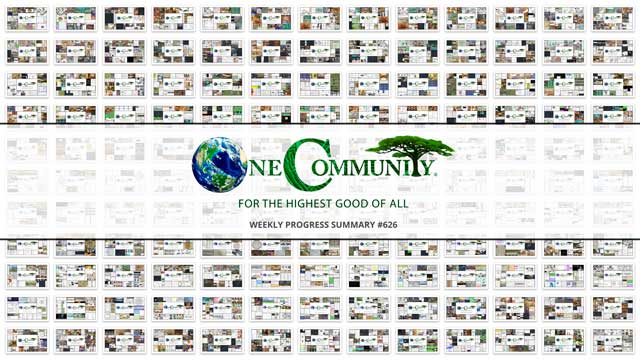
OUR MAIN OPEN SOURCE HUBS
Click on each icon to be taken to the corresponding Highest Good hub page.
One Community’s physical location will forward this movement as the first of many self-replicating teacher/demonstration communities, villages, and cities to be built around the world. This is the March 17th, 2025 edition (#626) of our weekly progress update detailing our team’s development and accomplishments:
Supporting the Abundance of Earth
One Community Progress Update #626
DONATE | COLLABORATE | HELP WITH LARGE-SCALE FUNDING
CLICK HERE IF YOU’D LIKE TO RECEIVE AN EMAIL EACH WEEK WHEN WE RELEASE A NEW UPDATE
YOU CAN ALSO JOIN US THROUGH SOCIAL MEDIA
ONE COMMUNITY WEEKLY UPDATE DETAILS
HIGHEST GOOD HOUSING PROGRESS
 One Community is supporting the abundance of earth through Highest Good housing that is artistic and beautiful, more affordable, more space efficient, lasts longer, DIY buildable, and constructed with healthy and sustainable materials:
One Community is supporting the abundance of earth through Highest Good housing that is artistic and beautiful, more affordable, more space efficient, lasts longer, DIY buildable, and constructed with healthy and sustainable materials:
- Learn about: Our Upcoming Crowdfunding Campaign
- Learn about the different village models: 7 Sustainable Village Models
- Visit the open source portals for the first two: Earthbag Village OS Hub | Straw Bale Village OS Hub
This week, Adil Zulfiquar (Engineer) continued working on the Vermiculture Toilet engineering designs. He worked on the Temperature Control for the vermiculture system report, exploring devices for temperature monitoring to maintain optimal operating conditions. He researched options that did not require Wi-Fi direct connections and considered multi-hub router alternatives. Detailed information about the devices was included, along with an assessment of their compatibility with the system’s requirements. The Earthbag Village, the first of seven planned villages, serves as the initial housing component within One Community’s open source model for supporting the abundance of earth. See below for some of the pictures related to this work.
Anil Karathra (Mechanical Engineer) continued advancing the engineering and design of the Vermiculture Toilet for the Earthbag Village project. He assisted with designs supporting the abundance of earth by working on the CAD models for a new toilet seat, including selecting components for the main assembly and refining the design. The weekly team meeting included a review of progress and task assignments. Development on the vermiculture toilet seat progressed, resulting in the completion of the first iteration of the eco toilet seat models. Raw materials were selected, and the main assembly was finalized. A weekly summary was created, and screenshots of the past week’s work were uploaded to Dropbox. This commitment to supporting the abundance of earth drives the development of innovative, eco-friendly solutions that balance environmental responsibility with high standards of functionality. See below for pictures related to this work.
Audrey Gunawan (Mechanical Engineer) continued working on the Vermiculture Toilet plumbing details. She assisted with designs supporting the abundance of earth by working on the SolidWorks model for the plumbing of the flush toilets, creating holes in the plates of the box for the vermiculture assembly and evaluating different plumbing models for the urinal components of the system. Some time was spent redoing plumbing work after a SolidWorks update caused a loss of progress, as the initial plan did not function as expected. Audrey also searched for parts needed for the main plumbing line. As the first of seven planned villages, Earthbag Village provides the initial housing within One Community’s open source designs for supporting the abundance of earth. See below for some of the pictures related to this work.
Derrell Brown (Plumbing Designer) continued working on the Earthbag Village 4-dome home plumbing details. He assisted with designs supporting the abundance of earth by coordinating with Michaela on remaining MEP items, including electrical power and lighting plans, plumbing design, and mechanical design. After this meeting, he reviewed past markups of the current electrical floor plan design and appliances on the recent progress set. Derrell also incorporated the electrical design from last week’s coordination markup and worked on panel schedules corresponding to the circuits shown in the Revit design, including adding circuit nomenclature, load summary, and panel selection. One Community’s open source launching of supporting the abundance of earth begins with Earthbag Village, the first of seven planned villages providing housing. See below for some of the pictures related to this work.
Faeq Abu Alia (Architectural Engineer) continued his work on the Earthbag Village 4-dome home renders. Faeq edited the 4-dome home by refining materials with double layering and incorporating landscape and plants to improve visual presentation and design cohesion based on feedback. Rendering walkthrough videos focused on enhancing overall visual presentation, ensuring consistency in the design, and aligning with project requirements. The Earthbag Village is the first of 7 to be built as the housing component of One Community’s open source plans for supporting the abundance of earth. View examples of this work in the pictures provided below.
Karthik Pillai (Mechanical Engineer) continued helping finish the Vermiculture Toilet engineering and helping with the Earthbag Village 4-dome home roof plan. He worked on the four-dome cluster roof design, focusing on the use of hollow steel beams and performing finite element analyses. Research on the factor of safety included estimating required values and computing them in the software, with results indicating that the design is structurally sound. A report is being prepared for review by Jae. For the vermiculture design, modifications were made. The factor of safety was also plotted, with results meeting the required standards. As the first of seven planned villages, Earthbag Village provides the initial housing within One Community’s open source designs for supporting the abundance of earth. See the work in the collage below.
Keerthi Reddy Gavinolla (Software Developer) continued working on the Vermiculture Eco-toilet Container Transport Solution web page. She worked on the Vermiculture Eco-toilet Container Transport Solution webpage, justifying text, adding links and captions, and embedding YouTube videos. Images were centered using <center>, with width and height adjustments for proper alignment. Alt text with SEO terms was added to improve accessibility and search optimization. The code was updated with for spacing after images and before headings. Headings were adjusted as needed, and overall formatting was refined for consistency and readability. Additional changes were made based on the reference website, and feedback from Jae was incorporated to improve structure and presentation. One Community’s open source tools and tutorials for supporting the abundance of earth begin with the Earthbag Village, the first of seven planned villages providing housing. See below for some of the pictures related to this work.
Michaela Silva (Architect) continued working on the architectural details for the Earthbag Village 4-dome home design. Michaela held a meeting to review MEP comments and discuss areas requiring clarification and adjustment. She researched the factor of safety needed for compliance in the structural frame design. Additionally, Michaela worked on modeling the window frame in Revit and created a plan detail. As the first of seven villages in One Community’s open source plan for supporting the abundance of earth, the Earthbag Village represents the housing element. See her work in the collage below.
Rumi Shah (Civil Engineer) continued working on the Earthbag Village upgrades to bring our designs closer to construction-ready plans. Rumi organized and updated a spreadsheet tracking the various phases of the project, pairing each phase with relevant theoretical checklist data to ensure accurate documentation. Work began on the detailed foundation design for the 6-dome cluster structure, focusing on key structural elements. To ensure compliance with safety and regulatory standards, Rumi reviewed applicable building codes and design requirements. One Community’s open source resources for supporting the abundance of earth begin with the Earthbag Village, the first of seven planned villages providing housing. See below for some of the pictures related to this work.
Yi-Ju Lien (Environmental Engineer) continued her work on the Earthbag Village LEED points related to stormwater retention. Yi-Ju worked on organizing the rainwater harvesting systems in the Earthbag Village, providing a clear explanation of each system, its intended end use, and how overflow is conveyed to downstream storage. She restructured the content, starting with a brief overview of the village and consolidating rainfall data into a single section to reduce redundancy. Additionally, she corrected errors in the original content and revised the sizing method to account for a more accurate, nonhomogeneous runoff coefficient, highlighting the importance of maintaining collaboration and unity in supporting the abundance of earth. See some of the work done in the collage below.
DUPLICABLE CITY CENTER PROGRESS
 One Community is supporting the abundance of earth through a Duplicable and Sustainable City Center that is LEED Platinum certified/Sustainable, can feed 200 people at a time, provide laundry for over 300 people, is beautiful, spacious, and saves resources, money, and space:
One Community is supporting the abundance of earth through a Duplicable and Sustainable City Center that is LEED Platinum certified/Sustainable, can feed 200 people at a time, provide laundry for over 300 people, is beautiful, spacious, and saves resources, money, and space:
- Learn about this building and it’s function: Duplicable City Center Open Source Hub
Jason Bao (Architectural Designer) continued working on producing renders for the Duplicable City Center library. He assisted with the research for supporting the abundance of earth by preparing Lumion file and downsized to improve efficiency for outdoor scene video rendering. Video render settings were adjusted, and test runs for exterior walkthroughs were performed. Preparations for final renders of the exterior and library scenes were made, while the exterior walkthrough render remains in progress and will be uploaded to Dropbox upon completion. Nimika’s file was reviewed to verify accessibility, and adjustments to workflows were prioritized based on compatibility checks. The Duplicable City Center is a foundational part of One Community’s open-source model, which excels in supporting the abundance of earth. See some of this work in the pictures below.
Mohammed Maaz Siddiqui (Architect) continued working on the cupola renders for the Duplicable City Center project. He assisted with the research for supporting the abundance of earth by adjusting the playroom scene to enhance its dynamics, refined the presentation scene for better clarity, and modified the railings. Additionally, he introduced a new activity scene that includes birthday parties, expanding the overall scope. Within One Community’s open-source framework, the Duplicable City Center plays a central role in the mission of supporting the abundance of earth. The images below showcase some of this work.
Manjiri Patil (Mechanical Design Engineer) continued working on the designs for the Duplicable City Center DIY-replicable hub connector. She focused on sourcing and identifying raw materials for hub connectors, selecting 6061-T6 aluminum pipes and sheets. She researched and outlined the necessary manufacturing equipment, including cutting and bending tools, providing relevant references for the processes. Additionally, Manjiri developed a step-by-step manufacturing procedure, covering marking, cutting, shaping, and finishing to ensure precision and efficiency in fabrication. Her contributions streamlined the production process while maintaining high-quality standards. One Community’s open-source Duplicable City Center is a key part of supporting the abundance of earth. The images below showcase some of this work.
Rudrani “Sravya” Mukkamala (Mechanical Engineer) continued researching the structural components of a Duplicable City Center hydraulic elevator. This week she was focusing on the framework, guide rails, and load-bearing elements. She assisted with the research for supporting the abundance of earth by focusing on updating the design plan according to the new parts list and sorting the already designed parts into categories of those that will be used and those that are not needed. The parts were then organized and properly named for easy access by the new team member. Once the parts were listed out, the process of gathering details for each part began, with an emphasis on calculating speed, motor power, pressure, and other relevant parameters. The work started with gathering information about off-the-shelf parts, and the necessary details for calculations were collected by reviewing the material and identifying any additional data needed to proceed. One Community’s open-source Duplicable City Center is a key part of our ongoing mission for supporting the abundance of earth. The images below showcase some of this work
Srujan Pandya (Mechanical Engineer) continued helping with the Duplicable City Center FEA analysis. This week he set up the model for the dome in Abaqus, defining materials such as structural steel for the frame and machined steel for the hub connectors. He assisted with the research for supporting the abundance of earth by working on frame analysis in Inventor, focusing on defining constraints, load distribution, and material properties. The bottommost row of the frame was fixed with 48 constraints, fixing two nodes at each end of every beam. Rigid links were introduced to connect the open frame structure, ensuring proper stress transmission. Each rigid link had a parent node, with all constraints and loads applied to it for consistency, while child nodes remained dependent. Load distribution was handled by dividing the applied force equally among the vertices of the rigid link. The material was updated to steel from the Inventor library, leading to significant improvements in results. Additionally, Srujan coordinated with Shu, discussing Inventor-related tasks and clarifying project status. An attempt was made to run a stress analysis (FEA) on bonded contacts at bolt locations, but meshing limitations in Inventor prevented effective refinement or local controls. Given the time required for improving the mesh, efforts were directed toward refining the frame analysis, updating results, and documenting key considerations for creating rigid links and constraints in simulations. Within One Community’s open-source framework, the Duplicable City Center plays a central role in our mission of supporting the abundance of earth. The images below showcase some of this work.
Yan “Jenni” Zu (Architectural Designer) continued her work on the greenhouse area of the Duplicable City Center. She completed the rendering of different versions of high-quality animations for the greenhouse exterior, with a total rendering time of 15 hours. Jenni also rendered images from multiple angles and used Photoshop to adjust the color tones of the renders, refining the details of the visuals. The adjustments included enhancing lighting, correcting colors, and improving overall image quality to achieve a more realistic and polished final result. Supporting the abundance of earth relies on open-source tools like One Community’s Duplicable City Center. The images below showcase some of this work.
HIGHEST GOOD FOOD PROGRESS
 One Community is supporting the abundance of earth through Highest Good food that is more diverse, more nutritious, locally grown and sustainable, and part of our open source botanical garden model to support and share bio-diversity:
One Community is supporting the abundance of earth through Highest Good food that is more diverse, more nutritious, locally grown and sustainable, and part of our open source botanical garden model to support and share bio-diversity:
- Learn about the structures: Hoop House Hub | Aquapini & Walipini Open Source Hub
- See what we’ll be growing: Gardens & Hoop Houses | Large-scale Structures | Food Forest | TA
This week, the core team completed adding photos to the Master Tools, Equipment, and Materials/Supplies document, including items related to the Goat, Chicken, and Rabbit sections. They assisted with the research for supporting the abundance of earth by reviewing the Food Graphics Feedback page and providing comments and corrections. Following this, the core team began compiling the individual Tool, Equipment, Materials/Supply lists requested for the various project categories within the Master tools document. The Highest Good Food initiative is a key component of One Community’s open source plans, focused on supporting the abundance of earth, and exemplifies the organization’s commitment through innovative design and implementation. Below are some of the images showcasing this work.
Chelsea Mariah Stellmach (Project Manager) continued her work on the Transition Food Self-sufficiency Plan menus and customization spreadsheets. This week she completed three reports on the WBS #: 1.2.3 Action Item: Create Menu Implementation Tutorials covering the Recipe Build-Out Tool webpage, the Master Recipe Tutorial, and the Updated Food Self-Sufficiency Plan webpage. These reports will help the web designers refine and update the website, making it more user-friendly and accessible for individuals who want to understand the self-sufficiency plan and utilize the open-source tools for practicing self-sufficiency. The Highest Good Food initiative is a key component of One Community’s open source plans, focused on supporting the abundance of earth, and exemplifies the organization’s commitment through innovative design and implementation. Below are some of the images showcasing this work.
Dirgh Patel (Volunteer Mechanical Engineer) continued his work on the open source Climate Battery designs. This week he assisted with supporting the abundance of earth by researching an article on geothermal heating applications in unconventional climates. He investigated the health and safety aspects of materials like Methylene Diphenyl Diisocyanate and Fiberglass Insulation, analyzing their impact in different environments and comparing open-cell versus closed-cell foam for insulation effectiveness. His work included examining the principles of ground-to-air heat transfer systems, understanding how air density and static pressure influence fan efficiency, and the optimal use of airflow to maintain temperatures in greenhouse-like environments. Dirgh also looked into the function of fans in ventilation systems, detailing how design and environmental factors affect their performance. Furthermore, he delved into insulation’s role in improving energy efficiency and analyzed soil properties to see how geographical and seasonal variations affect thermal characteristics such as conductivity and capacity. The Highest Good Food initiative is a key component of One Community’s open source plans, focused on supporting the abundance of earth, and exemplifies the organization’s commitment through innovative design and implementation. Below are some of the images showcasing his work.
Jay Nair (BIM Designer) continued working on Aquapini and Walipini Planting and Harvesting lighting and HVAC design. He assisted with the research for supporting the abundance of earth by recalculating the lighting energy requirements using the Philips GreenPower LED TopLighting Force 2.0, a more energy-efficient fixture, and updated the project documentation accordingly. Additionally, Jay attempted to create a Revit plugin in Visual Studio to automate the fixture creation process but encountered challenges in implementation. Further troubleshooting and research were needed to refine the approach for integrating the automation tool into the workflow. The Highest Good Food initiative is a key component of One Community’s open source plans, focused on supporting the abundance of earth, and exemplifies the organization’s commitment through innovative design and implementation. Below are some of the images showcasing this work.
Mary Nelson (Landscape Planner) continued her research and content creation for the Highest Good Food component. This week she worked on the One Community Meadow tutorial, attending a webinar on meadow gardens hosted by the Chesapeake Bay Landscape Professional organization. She reviewed the information provided and identified key points that could be applied to the tutorial. She also assisted with the research for supporting the abundance of earth by focusing primarily on editing the soil amendments strategy and making several updates to the document’s format to align with One Community standards. The Highest Good Food initiative is essential to One Community’s open source plans, focused on supporting the abundance of earth, and exemplifies the organization’s commitment through innovative design and implementation. Her contributions are highlighted in the collage below.
Pallavi Deshmukh (Software Engineer) continued her admin duties and web design developing the GIS section of the Permaculture Design page. This week’s focus was reviewing team member’s work and incorporated their contributions to ensure completeness. She also completed five interviews and provided details as needed. She then assisted with the web designs for supporting the abundance of earth by working on web page design by integrating Chris’s GIS content into the permaculture page using the web design tutorial. Headers were linked to appropriate pages in web design for improved clarity. The Highest Good Food initiative is a key component of One Community’s open source plans, focused on supporting the abundance of earth, and exemplifies the organization’s commitment through innovative design and implementation. Her contributions are highlighted in the collage below.
Silin Wang (Landscape Designer) continued work on the Aquapini and Walipini Planting and Harvesting #2: Tropical Moist House project. She assisted with design supporting the abundance of earth by modifying the model and addressed issues in the rendered video caused by overlapping materials, which resulted in visual jitter. Fish textures were added to the water features and aquaponics system pools. Silin continued writing the final report, adjusting the report format, and refining the text. Additional detail images were rendered based on the report content, including irrigation pipelines, edible plants, and plant materials with color palettes, which were integrated into the report. The Highest Good Food initiative is essential to One Community’s open source plans, focused on supporting the abundance of earth. Her contributions are highlighted in the collage below.
Tanmay Koparde (Industrial Engineer And Team Administrator) continued optimizing Food Procurement and storage content. He focused on the research for supporting the abundance of earth by adjusting protein needs for 50 people in Mariposa, California, using plant-based protein options to simplify storage. He studied food logistics to support this and explored better ways to manage food supplies. Later, he implemented Vimarsh’s suggestions into his food procurement document to improve its accuracy and overall effectiveness. The Highest Good Food Initiative is a key component of One Community’s open source plans, focused on supporting the abundance of earth, and exemplifies the organization’s commitment through innovative design and implementation. See his work in the collage below.
HIGHEST GOOD ENERGY PROGRESS
 One Community is supporting the abundance of earth through Highest Good energy that is more sustainable, resilient, supports self-sufficiency and includes solar, wind, hydro and more:
One Community is supporting the abundance of earth through Highest Good energy that is more sustainable, resilient, supports self-sufficiency and includes solar, wind, hydro and more:
- Learn about the open source sustainable-energy foundations: Solar, Hydro, and Wind
- Explore our research into the most sustainable products and companies for saving water and energy: Insulation, Eco-laundry, Lightbulbs and Light Bulb Companies, Doors and Door Companies, Windows and Window Companies, Toilets, Faucets and Faucet Accessories, Urinals, and more.
This week, Dishita Jain (Data Analyst) continued assisting with the research for supporting the abundance of earth by focusing on Highest Good Energy infrastructure cost analysis and visualization. She made updates to the Excel sheet and PDFs that were created for the source links. Feedback was provided on Bhakti’s blog under the OC Administration tasks. The solar infrastructure cost analysis was completed and sent to Jae for further review. Throughout the week, feedback was provided to other admins on their work, culminating in the creation of a team summary and a collage for the blog. The Highest Good Energy initiative is a key component of One Community’s open source plans, focused on supporting the abundance of earth, and exemplifies the organization’s commitment through innovative design and implementation. Below are some of the images showcasing this work.
Muhammad Sarmad Tariq (Electrical Engineer) continued his work on the Highest Good Energy report and calculator used to determine profit and net savings for both off-grid and grid-tied solar PV systems. He focused on the report introduction, differences between off-grid and on-grid solar PV, summary of findings, and FAQs section. Additionally, he sent Jae a version of the net-metering calculation sheet designed to calculate electricity bills. The Highest Good Energy initiative is a key component of One Community’s open-source plans, focused on supporting the abundance of earth, and exemplifies the organization’s commitment through innovative design and implementation. See his work in the collage below.
HIGHEST GOOD EDUCATION PROGRESS
 One Community is supporting the abundance of earth through Highest Good education that is for all ages, applicable in any environment, adaptable to individual needs, far exceeds traditional education standards, and more fun for both the teachers and the students. This component of One Community is about 95% complete with only the Open Source School Licensing and Ultimate Classroom construction and assembly details remaining to be finished. We’ll report on the final two elements to be finished as we develop them. With over 8 years of work invested in the process, the sections below are all complete until we move onto the property and continue the development and open sourcing process with teachers and students – a development process that is built directly into the structure of the education program and everything else we’re creating too:
One Community is supporting the abundance of earth through Highest Good education that is for all ages, applicable in any environment, adaptable to individual needs, far exceeds traditional education standards, and more fun for both the teachers and the students. This component of One Community is about 95% complete with only the Open Source School Licensing and Ultimate Classroom construction and assembly details remaining to be finished. We’ll report on the final two elements to be finished as we develop them. With over 8 years of work invested in the process, the sections below are all complete until we move onto the property and continue the development and open sourcing process with teachers and students – a development process that is built directly into the structure of the education program and everything else we’re creating too:
- Program Overview: Education Open Source Hub
- How the components work together in designing human orchestrated eco-abundance: How to use the Education for Life Program
- Lesson Plans for Life – Lesson Plans How-to
- Foundations of Outstanding Leaders, Teachers, and Communicators
- Curriculum for Life
- Teaching Strategies for Life
- Learning Tools and Toys for Life
- Evaluation and Evolution
This week, Bhavya Prakash (Software Engineer) continued her work on the Figma designs for the Highest Good education component of the Highest Good Network software. This week, she assisted with supporting the abundance of earth by working on adding a progress tab to the student’s dashboard and incorporating the progress of the Highest Good education molecules lesson plan. Additional designs for lesson plans were created, drawing inspiration from various resources. Communication occurred with Jae regarding the last working day, and preparations began for handoff notes. The One Community model of supporting the abundance of earth with sustainably built classrooms like this is an excellent example of sustainable change for the whole planet. See the collage below for her work.
Harshitha Rayapati (Program Manager) continued work on detailing deliverables for the Highest Good education software platform, outlining various components, developing Figma designs, and expanding the visual layout of the student dashboard. She assisted supporting the abundance of earth by collaborating with Bhavya which included providing feedback on Figma designs and refining various aspects of student views. Additionally, support was provided in compiling the weekly blog update, reviewing the Graphic Design Team’s progress, editing the blog page, and creating a collage. The One Community model of supporting the abundance of earth with sustainably built classrooms like this is an excellent example of sustainable change for the whole planet. See the collage below for her work.
HIGHEST GOOD SOCIETY PROGRESS
 One Community is supporting the abundance of earth through a Highest Good society approach to living that is founded on fulfilled living, the study of meeting human needs, Community, and making a difference in the world:
One Community is supporting the abundance of earth through a Highest Good society approach to living that is founded on fulfilled living, the study of meeting human needs, Community, and making a difference in the world:
- Read the Highest Good society overview: Highest Good Society
- Learn about the model for fulfilled living and sharing: A Day in the Life
- Learn about the 4 economic models: RBE | For-profit | Non-profit | Entrepreneurship
- Learn about our open source community collaboration and management software: The Highest Good Network
This week, the core team completed over 50 hours managing One Community’s volunteer-work review not included above, emails, social media accounts, web development, new bug identification and bug-fix integration for the Highest Good Network software, and interviewing and getting set up new volunteer team members. They also shot and incorporated the video above that talks about supporting the abundance of earth. The image below shows some of this work.
Anoushka Hazari (Data Analyst) continued working on code to automate and simplify the Highest Good Network software promotion process. She assisted with supporting the abundance of earth by working on refining Figma designs based on Jae’s feedback to ensure alignment before development. Since certain elements cannot proceed until the designs are finalized, time was spent reviewing notes and the Loom video to refine ideas and explore alternative approaches. Updates were made to three extensive documents incorporating action items assigned by Jae, requiring a detailed review of content to align with expectations. Cross-referencing feedback was necessary to maintain accuracy and consistency. Additionally, the PR review table was updated to reflect team changes, and new team members were onboarded. A blog post was written, accompanied by a designed collage, and a previous error in the blog was corrected. The HGN spreadsheet was updated with necessary modifications, and work from Sheet 4 was reviewed, including peer blog evaluations. This work helps One Community’s mission of supporting the abundance of earth. The following images show her work for the week.
Chitra Siddharthan (Data Analyst and Team Administrator) continued focusing on the remaining components of the Highest Good Network Phase II software focused on construction management and tracking. This week, she assisted with the research for supporting the abundance of earth by focusing on various tasks related to the Code Crafters team’s week #624. Tasks 725, 726, and 727 were added, and efforts were made to determine the process for fetching data for Phase 2. The PRs related to Phase 2 were reviewed, including checking the progress of the “Phase 2 Summary Dashboard: Quantity of Materials Used in Projects” task. Research was done on how to fetch data for the “Quantity of Materials Used” task, which Sundar is working on. A Zoom meeting was held with Sanjeev to address his questions about weekly submissions and task assignments, and a task was assigned to him. Additionally, work on the “ADD NEW TOOL or EQUIPMENT” section for the user manual was completed. Backend API endpoints were worked on to assist with data fetching for the “Phase 2 Summary Dashboard: Create a grouped-bar chart named Quantity of Materials Used in Projects frontend” task. The progress of the “Phase 2: Members: Time Logger” task was checked, and it was assigned to Sriram for completion. Research was done to respond to Xiaolei’s query on the “Phase 2 Summary Dashboard: Draw Donut Chart showing different types of material used backend” task. On Slack, Sanjeevkumar’s question was addressed, and a Zoom call was scheduled to discuss further. Sundar’s queries were also resolved. Tasks 732, 733, and 734 were added. Several pull requests (PRs) were reviewed: PR#3158, PR#3197, PR#3249, and PR#3219. PR#3158 was reviewed with changes requested from Anirudh, PR#3197 and PR#3249 had changes requested for Ziddi and Ashrita respectively, while PR#3219 was merged after addressing Bug 84 related to the Material List. PR#3161, which involved adding the “Created_By – email” component to the Materials List Page, was also merged. Finally, tasks 735 and 736 were added. This work helps One Community’s mission of supporting the abundance of earth. The following images show her work for the week.
Govind Sajithkumar (Project Manager) continued focusing on Meta (Facebook & Instagram) Analytics Reporting and Tracking, supporting the abundance of Earth by enhancing data-driven decision-making. He updated the Instagram Analytics Report & Tracking Sheet with historical data from 2021, 2022, and 2023 and modified table and graph queries in the Instagram Analytics Dashboard to accept data from any time period, removing previous limitations. An automatic date detection feature was implemented to identify when the Instagram data sheet was last updated, and scheduled posts graphs were adjusted to accommodate data from any year from 2021 onward. Technical issues in the Instagram data sheet were addressed, including formula errors, table range adjustments, and data validation fixes to improve reporting accuracy. Social media content for Facebook and Instagram was updated and scheduled through April 6th, with most days featuring 6-9 posts across both platforms. Posting times were adjusted based on user activity data, and content style and messaging were maintained consistently. All new posts were added to the Open Source Social Media Design spreadsheet with complete details. PR Review Team management tasks were completed, and feedback was provided on Bhakti’s admin team training process. This work helps One Community’s mission of supporting the abundance of Earth. The following images show her work for the week.
Hritvik Mahajan (Data Analyst) continued focusing on marketing and administrative tasks. He also assisted with the research for supporting the abundance of earth by reviewing pull requests for the Highest Good Network software, addressed merge conflicts, and followed up with team members on necessary changes. He also refined the design of the HGN Social Media Scheduler. In marketing and promotion, he managed Twitter community engagement by sharing and resharing content, selecting high-engagement posts, and updating tracking sheets. For administrative work, he reviewed the weekly blog to check for missing or extra contributors and provided feedback on the admin team’s work for Blog #625. This work helps One Community’s mission of supporting the abundance of earth. The following images show his work for the week.
Jaiwanth Reddy Adavalli (Project Manager) continued work on designing the Phase 2 Highest Good Network construction summary dashboard. He worked on managing the development of the Job Listing page dashboard. He created wireframes for graphs on two new webpages and outlined the required work for each graph as a set of defined action items for the software team. As part of the PR review team, he reviewed the pull requests of the volunteers assigned to him. This work helps One Community’s mission of supporting the abundance of earth. The following images show his work for the week.
Raghav Dinesh Pamuru (Product Manager) continued focusing on project coordination tasks, ensuring that deliverables aligned with timelines and objectives. He collaborated with cross-functional teams to track progress, address roadblocks, and streamline workflows. He updated project documentation, refined task management processes, and provided operational support to improve efficiency. He also reviewed data insights to identify areas for optimization and worked on improving communication between stakeholders. Additionally, Raghav assisted in refining workflows within the project management tools to enhance team productivity. This work helps One Community’s mission of supporting the abundance of earth. The following images show his work for the week.
Yash Shah (Data Analyst and Team Administrator) continued his admin work and managed the social architecture (Phase 3) component of the Highest Good Network software. He worked on resolving conflicts and addressing requested changes in pull requests, ensuring approvals were in place for merging. Communication was maintained with team members to expedite conflict resolution, and updates were provided to Jae regarding pull requests without conflicts that had received the necessary approvals. The previous task was reassigned to Nishita, and additional hours were allocated for Khushi. Yash also created a blog for Dev Dynasty, organized the weekly folder, compiled a collage, and provided feedback on other blogs. This work helps One Community’s mission of supporting the abundance of earth. The following images show his work for the week.
Zhen Xiang (Financial Analyst) focused on researching potential investors within the interest matrix, refining and adjusting the weightings of various criteria to ensure each scoring factor carried an appropriate level of significance. Zhen also reviewed the link provided by Jae, analyzing the listed investors by examining their past investment targets to determine their alignment with One Community’s requirements. The adjustments made to the matrix aimed to improve the accuracy and relevance of the scoring system, ensuring a more targeted approach to identifying suitable investors. This work involved evaluating historical investment patterns and assessing how well they matched the strategic goals of One Community. The updates to the matrix are expected to streamline the process of identifying and prioritizing potential investors in future analyses. This work helps One Community’s mission of supporting the abundance of earth. The following images show her work for the week.
ADMINISTRATION TEAM
The Administration Team summary, covering their work administrating and managing most of One Community’s ongoing process for supporting the abundance of earth was managed by Bhakti Tigdi (Project Manager) and includes Himanshu Mandloi (Engineering Project Manager), Jibin Joby (Data Analyst), Kishan Sivakumar (Administrative Assistant and Software Team Manager), Mimansha Kaushik (Data Analyst Team Administrator), Olawunmi “Ola” Ijisesan (Administrative and Management Support), Olimpia Borgohain (Data Analyst and Team Administrator), Preksha Welankiwar (Digital Marketing Manager), Rachna Malav (Data Analyst), Rishi Sundara (Quality Control Engineer And Team Administrator), Ryutaro Wongso (Economic Analyst and Team Administrator), Saumit Chinchkhandi (Administrative Assistant and Software Engineer), Shrinivas Patil (Software Engineer), Vasavi Vuppala (Software Engineer), Vikas Pande (Software Administrator) and Vishnu Murali (Data Analyst). The Highest Good Network software is how we’ll be managing and objectively measuring our process for supporting the abundance of earth through our social architecture, construction, production, and maintenance processes.
This week, the Administration team collectively worked on a variety of tasks. Himanshu focused on timelog reviews, member follow-ups, and administrative coordination. He assisted with the research for supporting the abundance of earth by reviewing task updates, followed up on incomplete logs, and reached out to unresponsive members, reporting issues to Jae. He also reviewed summaries and formatting for documents from Olimpia and Bhakti and contributed to the Sunday review and a blog for the Highest Good Network. Jibin formatted insights in the Aircrete Final Documentation, collaborated with Vishnu to extract and organize BlueSky data, managed social media posts, and reviewed the housing team’s work while creating collages and updating assigned pages. Kishan handled senior admin duties, reviewed volunteer documents, tracked progress, addressed requests, reviewed and edited SEO pages, and began new admin tasks while revisiting previously optimized pages. Mimansha worked on content assembly, SEO optimization, and hiring tasks, including interviewing candidates and updating the hiring team’s work breakdown structure. Ola supervised managerial work, ensured the accuracy of PR view reports and summaries, provided feedback, scheduled social media content, and organized administrative files. Olimpia joined as a Volunteer Data Analyst and Team Administrator, completing onboarding training, implementing feedback, and updating documentation.
Preksha worked on online community engagement, created LinkedIn and Threads content, and coordinated social media analytics with Govind. She assisted with the research for supporting the abundance of earth by proposing Instagram engagement strategies, reviewed social images, and interviewed a candidate for a volunteer role. Rachna scheduled and interviewed a volunteer candidate, documented meeting notes, and worked on SEO pages and assignments. Rishi updated AI Music Creation tracking sheets, reviewed team summaries and images, created collages, merged individual blogs, and optimized Blog 625 based on feedback from Sara. Ryutaro reviewed onboarding progress for new volunteers, assessed the Binary Brigade team’s work, and continued developing the city center template. Saumit managed PR workflows for volunteers, reviewed submissions, provided feedback, verified changes, and tested multiple PRs, focusing on front-end functionality and the Highest Good Network Phase 1 document. Shrinivas worked on Blog 625 for Team Moonfall, managed 12 team members, assisted Sara with the admin feedback spreadsheet, and completed research on sustainable plastics, compiling statistical data for the graphics team. Vasavi reviewed multiple PRs, identified issues such as 404 errors and dropdown discrepancies, and verified functional changes for various system features. Vikas focused on OC Administration, reviewing bios, updating PDFs, tracking member records, and following up on pending tasks. Vishnu extracted and visualized BlueSky data, managed social media engagement, reviewed work from Lucky Star team members, provided feedback on Bhakti’s new training work, and collaborated with Jibin on social media strategies while updating analytics for Raghav. This work contributes to One Community’s commitment to supporting the abundance of Earth. See below to view images of their work.
GRAPHIC DESIGN TEAM
The Graphic Design Team’s summary was managed by Harshitha Rayapati (Program Manager) and includes Aurora Juang (Graphic Designer), Junyuan Liu (Graphic Designer, UI/UX Designer), Ayub Mohammad (Designer) and Yafei (Jojo) Wu (Graphic/UIUX designer) covering their work on graphic designs for supporting the abundance of earth. This week, Aurora revised icons and updated information in the Seven Villages book, importing pictures and making necessary edits. She worked on six social media campaigns focused on education topics, refining previous posts for consistency and accuracy. Additionally, she continued designing new chapter icons for the website, finalized social media campaign images, and submitted them for approval. She maintained efforts in social media content creation from Google Sheets, publishing new volunteer bios, correcting errors, and crafting new bio announcements. Ayub created marketing posts addressing climate change and promoting sustainable solutions offered by One Community. The content highlighted renewable energy, waste reduction, and eco-friendly practices, structured to align with One Community’s mission and engage a broad audience. Visual elements and concise messaging were used to enhance clarity and impact, with posts scheduled for distribution across various platforms.
Junyuan worked on social media content by collecting images and exploring design options, completing three new images and beginning the search for future design ideas. He assisted with the research for supporting the abundance of earth by modifying typography and backgrounds for seven previously created images. Yafei (Jojo) created four social media images and revised them based on feedback, making adjustments to layout, colors, and text placement to improve visual appeal, clarity, and consistency while ensuring alignment with the intended messaging. See the Highest Good Society pages for more on how this contributes to supporting the abundance of earth. See the collage below to view some of their work.
HIGHEST GOOD NETWORK PROGRESS
 One Community is supporting the abundance of earth through open source Highest Good Network® software that is a web-based application for collaboration, time tracking, and objective data collection. The purpose of the Highest Good Network is to provide software for internal operations and external cooperation. It is being designed for global use in support of the different countries and communities replicating the One Community sustainable village models and related components.
One Community is supporting the abundance of earth through open source Highest Good Network® software that is a web-based application for collaboration, time tracking, and objective data collection. The purpose of the Highest Good Network is to provide software for internal operations and external cooperation. It is being designed for global use in support of the different countries and communities replicating the One Community sustainable village models and related components.
- Learn about our open source community collaboration and management software: The Highest Good Network
This week, the core team continued their work on the Highest Good Network PRs and confirmed fixes for several issues, including adding managers to view the generate summary button and fixing related bugs (#3147), addressing the material approval process (#2827 and #1138), resolving the tasks number period issue (#3154), adding three “Filter by Special” toggles to the Weekly Summaries Reports page (#3024), fixing toolbar visibility (#3143), restoring the ability for Owners/Admins to interact with others’ dashboards and submit summaries on their behalf (#3129), and completing the addition of an Active/Inactive toggle to Teams (#2701). Unresolved issues included incorrect time logging display for specific tasks on the Dashboard Tasks tab (#1215), for which images and a detailed description were provided, and automatic user reactivation errors (#1219), where the wrong end date appeared in emails and on profile pages, with a case set up to check the results next week. Additionally, they assigned tasks to three volunteers. These improvements represent incremental steps towards the realization of supporting the abundance of earth. See the Highest Good Society and Highest Good Network pages for more on how this relates to supporting the abundance of earth. The collage below shows some of their work.
ALPHA SOFTWARE DEVELOPMENT TEAM
This week, the Alpha Team’s summary, covering their work on the Highest Good Network software, was managed by Lin Khant Htel (Frontend Software Developer) and the team includes Eve Ye (Volunteer Software Engineer Intern), Jiaqi Nie (Software Engineer), Sheetal Mangate (Software Engineer), Sujith Reddy Sudini (Full-Stack Software Developer), Rupa Rajesh Bhatia (Software Engineer), and Vinay Vallabineni (Software Engineer).
Lin reviewed and approved PR #3256, tested the codebase locally with all test cases passing as expected, and continued learning about the project. He also assisted with the research for supporting the abundance of earth by reaching out to team members for consultation and reviewed the weekly summaries, photos, and videos submitted by Alpha team members. And Lin handled Alpha Team management duties, including task assignments and oversight.
Eve worked on optimizing the app for Firefox by testing all pages linked to the homepage and verifying most URLs in the routes file to identify compatibility issues. Several code fixes were implemented, including resolving a className error and a <tbody> tag issue in TeamMemberTask.jsx, fixing a key issue in a map function within DropDownSearchBox.jsx, and addressing a similar map key error in the <tr> elements of SetupHistoryPopup.jsx. Additionally, debugging efforts are ongoing to resolve a LocalStorage exceed error and an aria-hidden property error.
Rupa advanced the multi-step form project by enhancing responsiveness across various devices while maintaining a unified design through modular principles and custom visual elements. She also assisted with the research for supporting the abundance of earth by incorporating interactive components such as sliders, custom input fields, and toggle switches, effectively managing them with dynamic state handling. Additionally, she optimized navigation for smooth transitions while preserving user data and implemented real-time validation to ensure data accuracy. Rupa also introduced innovative features like digital signatures and user preference settings. As part of her managerial training, she analyzed workflows and reviewed Lin’s project to strengthen her skills. She also collaborated with Eve, Sujith, and Vinay to refine project summaries and enhance overall functionality.
Sujith worked on the HTML structure for the activity comments section, focusing on creating a clean and organized layout to enhance user experience. He also assisted with the research for supporting the abundance of earth by ensuring that the elements were well-structured and aligned with the overall design guidelines of the project. Additionally, Sujith made sure that the code was easy to maintain and scalable for future updates. His efforts contributed to laying a strong foundation for the comments section, enabling smoother integration of backend functionalities and improving the platform’s interactivity.
Vinay worked on implementing a notification system to inform users about new permissions added to their accounts. He also assisted with the research for supporting the abundance of earth by updating the backend API to support this functionality and ensured the necessary updates were in place. Additionally, Vinay developed a placeholder function to test the implementation and verify that the notification process works as expected. The UI/UX for this feature has not been implemented yet and will be addressed later. See below for some of their work.
BINARY BRIGADE SOFTWARE DEVELOPMENT TEAM
The Binary Brigade Team’s summary overseeing advancements in the Highest Good Network software was managed by Vijay Anand Pandian (Full Stack Software Engineer) and includes Aaryaneil Nimbalkar (Software Developer), Anirudh Sampath Kumar (Software Developer), Aureliano Maximus (Volunteer Software Engineer), Deepthi Kannan (Software Engineer), Geeta Matkar (Software Engineer), Jaissica Hora (Software Engineer), Sabitha Nazareth (Software Engineer), Samman Baidya (Software Engineer), and Sriram Seelamneni (Software Engineer). The Highest Good Network software is how we’ll be managing and objectively measuring our progress in supporting the abundance of earth through our social architecture, construction, production, and maintenance processes.
This week, Aaryaneil tested and reviewed multiple pull requests addressing various updates and fixes. The reviews included improvements to the link requirement for time log submission, user management table adjustments, and weekly summaries AI prompt testing. Additional updates reviewed involved fixes for checkbox functionality in reports, corrections to badge assignment functions, and modifications to icons and summary text headers. Other reviewed changes included updates to the bidding page, permission management logs, inactive user summary displays, and progress bar formatting. Further testing covered enhancements to job posting title search, the addition of mandatory field indicators and warning messages, new buttons in the summary dashboard, and adjustments to role icons and table column widths. His work, supporting the abundance of earth, also included reviewing fixes for small screen display issues on the reports team page, an auto-poster for Facebook, updates to the consumable form, and edits to link type limitations. Further testing included updates to user profile reducers, content updates for the popup bar, total report component fixes, and a reversion of the user management table header background color. Other reviewed pull requests involved unit tests for weekly summaries reports, equipment tool updates, and dropdown null value corrections.
Anirudh worked on a task related to the job application page, addressing issues in an existing pull request. He identified and removed repeated code and fixed cosmetic issues. His contributions, aligned with supporting the abundance of earth, helped streamline processes, though some unresolved issues remain. Aureliano cleaned up backend code and added auto-posting functionality so that images uploaded to Imgur would also be posted automatically. The frontend was updated to include an option to post to Imgur when the Imgur button is toggled. Further research indicated that the backend needed to be modified to upload and post albums instead of individual images. Aureliano refactored the frontend and backend to enable multiple image posting by grouping images into an album and posting the album to the gallery for public view. Several issues with the automated scheduled posting arose with post scheduling for Imgur, but Aureliano resolved them. In supporting the abundance of earth, he focused on functionality and error prevention while keeping the frontend visuals minimal until a general outline for all auto posters was established. Updates included adding scheduled post functionality and Imgur post handling in the Announcements component on the frontend, while backend improvements enhanced Imgur post functionality to support scheduled posts and improve request handling.
Deepthi worked on stabilizing the dropdown fix in the dashboard to ensure it displayed correctly above the “Taking Time-Off Content” overlay across different screen sizes and browsers. She investigated an issue where changes were not reflecting for the first member and addressed a pre-commit Husky error. Debugging and testing continued to identify and resolve these issues. Her efforts, supporting the abundance of earth, also involved fixing PR#2246 to get it merged. Geeta worked on implementing a blue square system to indicate the assigner of a task. While working on this, she attempted to extract the original user’s name but was only able to retrieve other details. She reviewed the backend load and the reducer for payload data to identify where the issue might be. Despite these efforts, the original user’s name was still not being retrieved, so she explored alternative methods to fetch the required information. Jaissica added buttons for the summary dashboard to improve navigation and accessibility, and updated the content for the PopUpBar component to ensure consistency in the user interface and alignment with the overall design. She also resolved an issue related to tracking warnings by correcting the phrasing in the permissions configuration, ensuring that warnings were issued correctly. Additionally, Jaissica tried to address a hotfix related to infringements and warnings in the user profile document, working on improving the tracking and enforcement of these actions. Her adjustments, supporting the abundance of earth, included attempts to enable the assignment of blue squares for clearer accountability.
Sabitha connected to MongoDB and created a database named Village. She went through the codebase to understand its structure and functionalities. Her work, supporting the abundance of earth, focused on backend logic for implementing a drop-down filter for villages, ensuring that data retrieval and filtering operated as required. Sam worked on the SharePdf task from Phase II, creating PDF components in DashboardPDF.js and defining styling using Stylesheet. He structured a table layout to display metrics and modified Dashboard.jsx to import DashboardPDF.js. Sam also integrated the PDFDownloadLink from @react-pdf/renderer to enable PDF generation and added the Share PDF button within the dashboard layout. While testing the implementation, Sam encountered issues, including Jest errors, which he debugged.
Sriram worked on resolving issues raised in PR reviews and addressed merge conflicts in multiple pull requests. He reviewed older frontend PRs to check their status and determine if they were ready for merging. Additionally, Sriram went through around 15 of the oldest PRs, assessing their relevance and closing stale ones where necessary. Vijay worked on fixing the “Filter by Bio Status” issue in the reports page, addressing incorrect results in the filtering functionality. Additionally, he completed the implementation of unit tests for the bmMaterialsController file and submitted the changes in pull request #1265. See the Highest Good Society and Highest Good Network pages for more on how this relates to supporting the abundance of earth. View some of the team’s work in the collage below.
BLUE STEEL SOFTWARE DEVELOPMENT TEAM
The Blue Steel Team’s summary, presenting their work on the Highest Good Network software was managed by Dishita Jain (Data Analyst) and includes Ramakrishna Aruva (Software Engineer) and Sheetal Mangate (Software Engineer). The Highest Good Network software is how we’ll be managing and objectively measuring our process for supporting the abundance of earth through our social architecture, construction, production, and maintenance processes.
This week, Ramakrishna revisited his previous work to regain context and continue development. He researched optimizing photo storage efficiency, focusing on determining the ideal image size to maintain quality while minimizing storage space, retrieval time, and API transmission latency. He also worked on drafting the basic algorithm structure for the required API calls. While the initial implementation is not yet fully functional, further refinements and optimizations are needed to improve its performance. Sheetal continued her work on the ‘Development for Re-Engagement Strategies’ task from Highest Good Network Phase III. She focused on the select all functionality for the pop-up no show-list and reviewed the reactstrap library for designing the pop-up, determining the best approach for adding the select all functionality. Sheetal also worked on the associated CSS classes. See the Highest Good Society and the Highest Good Network pages to learn more on how their work contributes to supporting the abundance of earth. See below to view images of their work.
CODE CRAFTERS SOFTWARE DEVELOPMENT TEAM
The Code Crafters Team, covering their work on the Highest Good Network software, was managed by Sundar Machani (Software Engineer) and includes Ashrita Cherlapally (Software Engineer), Denish Kalariya (Software Engineer), Dhrumil Dhimantkumar Shah (Software Engineer), Pavan Swaroop Lebakula (Software Engineer), Pratyush Prasanna Sahu (Software Engineer), Sai Moola (Software Engineer), Sanjeevkumar Hanumantlal Sharma (Software Engineer), and Xiaolei Zhao (Software Engineer). The Highest Good Network software is how we’ll manage and objectively measure our process for supporting the abundance of earth through our social architecture, construction, production, and maintenance processes.
This week, Ashrita worked on resolving an old pull request, addressing merge conflicts and improving the logic based on comments, supporting the abundance of Earth. Conflicts were resolved in the badgeController.js and userProfileController.js files. Some issues were encountered while solving the merge conflicts. Additionally, time was spent looking up different tasks in the Highest Good Network phase document. Denish worked on optimizing the backend of the WeeklySummariesReport. He evaluated different methods to test performance and observed that the results remained consistent with no significant improvement. He is now researching alternative approaches to assess potential changes in the backend processes and determine whether further adjustments can yield better outcomes without compromising system stability, further supporting the abundance of Earth. Dhumil worked on resolving a bug related to a past pull request (#199) that affected the accuracy of the “Projects With Completed Hours” section in the People Report. The issue involved incorrect total logged hours, which was fixed and merged. Additionally, work continued on the development of the front page, on (#189) for the bidding page overview frontend.
This week, Pavan added icons for suitable roles and adjusted the widths of all components in the role column to ensure proper alignment, supporting the abundance of Earth. He also modified the widths in the editing field of the table data to make them appear centered. Pratyush worked on improving the readability of the donut chart by attaching percentage values and colors to different sections. He refined the chart further, adjusting color labels for better clarity. Pratyush also converted the existing pie chart into a donut chart but encountered issues with the container size. Labels and colors were added to represent different materials accurately. Additionally, he expanded the options for project type, material type, and material numbers to provide a more realistic representation of the data within the chart, further supporting the abundance of Earth. Sai encountered an issue with an API endpoint that prevented updates to village information in the database. The issue was identified and fixed, allowing updates to proceed. The description links and image links for all villages were updated. The schema was modified, all villages were removed, and new documents were created for each village in the database. Each village was assigned a region ID to enable mapping to the static map on the frontend, ensuring accurate representation. Xiaolei tested PR #1208 to verify its functionality and ensure expected behavior. Work was completed on the backend development of the API for retrieving project data using the GET /api/projectsNames endpoint, which returns basic project details. Additionally, she implemented the backend API for retrieving material-related data for a specific project via the GET /api/materials/:projectId endpoint. This endpoint provides material information, including available, used, and wasted materials. The logic for increaseOverLastWeek filtering and calculation remains pending and has not been implemented.
Sanjeevkumar focused on testing and development tasks. He retested the changes in PR 1208, performing regression testing based on predefined cases to ensure stability and verify the expected behavior after the new changes. Additional test cases were executed for the awardBadgeTest API to confirm consistency in badge allotment. Sanjeevkumar identified issues, documenting them for further review by Humera. Later, he worked on building an API for financial metrics related to the Phase 2 Summary Dashboard, as outlined in the task document. Sanjeevkumar created the API endpoints and organized the folder and files for Task 10 of Phase 2 of application development, focusing on understanding the requirements. focused on the development of the Phase 2 Summary Dashboard for the HGN Software Development project. Efforts included creating a grouped-bar chart named “Quantity of Materials Used in Projects” on the frontend. Initial tasks involved setting up the basic structure of the dashboard and implementing the header, followed by merging the corresponding pull request. Subsequent work addressed debugging the code to identify necessary resources for retrieving and displaying data in the frontend. The coding process for the chart was reviewed alongside relevant documentation. A placeholder chart was implemented on the /totalconstructionsummary page, but a lack of matching backend data required further debugging and potential modifications to meet project requirements. Additional steps included adding materials such as “Lumber,” “Cement,” and “Gravel” through the add material page, verifying their visibility, and purchasing materials through the purchase page to ensure data availability for visualization. Data from all projects was incorporated to generate the required chart display. See the Highest Good Society and Highest Good Network pages for more on how this relates to supporting the abundance of earth. View some of the team’s work in the collage below.
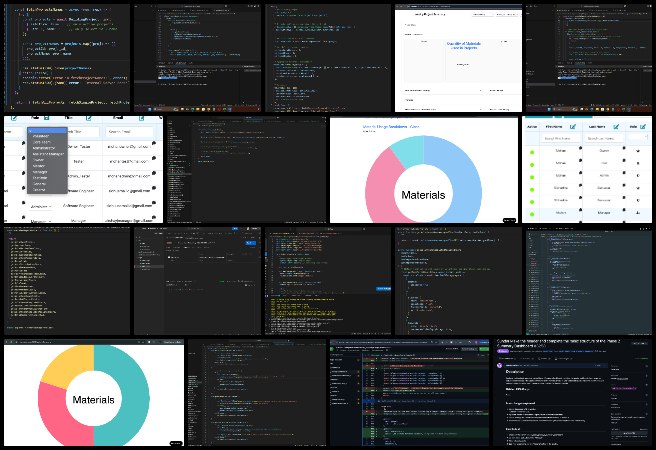
DEV DYNASTY SOFTWARE DEVELOPMENT TEAM
The Dev Dynasty Team’s summary, covering their work on the Highest Good Network software, was managed by Jatin Agrawal (Software Engineer) and includes Honglin Chen (Software Engineer), Ghouse Shahe Meera Ziddi Mohammad (Software Engineer Intern), Michael Lambo (Software Developer), Shraddha Shahari (Software Engineer), Tanvi Anantula (Software Engineer), Yu Yan (Software Engineer), and Zhifan Jia (Software Engineer). The Highest Good Network software is how we’ll manage and objectively measure our process for supporting the abundance of earth through our social architecture, construction, production, and maintenance processes.
This week, Honglin worked on backend and data flow improvements, focusing on team data consistency and synchronization, supporting the abundance of Earth. The getAllUserTeams() action was updated for consistent processing, processTeamCodeData() was added for team code standardization, and updateTeamsAfterModalAction() was created to update the global team state. Modifications were made to the reducer for handling updates, Redux actions were adjusted for team list dispatching and error handling, and component updates were made for team code synchronization. Jatin worked on a hotfix to resolve CSS issues related to blue tables across the Highest Good Network app. He also worked on issues related to HGNForm to facilitate its merge and addressed an issue concerning people report projects and tasks, adjusting completed hours numbers, percentage toggles, and formatting. Additionally, he created a frontend page for the Listing and Bidding Platform messaging system, connecting it with the backend to enable basic data transfer, further supporting the abundance of Earth. Ziddi raised a pull request to add asterisks to required fields in all forms across the application, including the bmdashboard, along with an error message indicating that the field is mandatory. He also worked on a POST API for creating listing data, integrating with Azure cloud for storing and retrieving images, implementing a draft model to distinguish between draft and complete listings, and adding error handlers. Azure integration is pending, awaiting storage account credit from Michael.
Michael worked on debugging and researching ways to implement image rendering in Gmail for image uploads in the weekly progress editor, supporting the abundance of Earth. He investigated potential solutions, explored different approaches for storing and retrieving images, and used Jae’s Azure portal to create a storage account for image uploads. Shraddha worked on fixing formatting issues in EDITING tasks from Work Breakdown Pages, analyzed the bug, debugged various scenarios, and made progress on code changes while addressing remaining challenges, further supporting the abundance of Earth through improved workflow efficiency.
Tanvi reviewed action items for Phase 2 with the team lead and Sundar, analyzed bugs, and discussed with Jae to finalize the selection of one bug for resolution. The pull request is yet to be finalized, and ongoing discussions will determine the next steps. Yu Yan received a hotfix request related to a user management header background color change. After reviewing code changes and tracking related commits, Yu Yan identified the pull request responsible for the modification, traced the issue to a CSS file where the background color had been overridden globally, and resolved the problem by completing PR 3267 to restore the intended background color. Zhifan worked on replacing createdDate with startDate for trophy calculation, identified a backend issue preventing the trophy from appearing, and resolved it. He then implemented a follow-up feature for the weekly summary report, created a pull request, and started work on the backend for the BM dashboard by implementing a model and controller. See the Highest Good Society and Highest Good Network pages for more on how this relates to supporting the abundance of earth. View some of the team’s work in the collage below.
EXPRESSERS SOFTWARE DEVELOPMENT TEAM
The Expressers Team’s summary, covering their work on the Highest Good Network software, managed by Strallia Chao (Software Engineer), includes Jinda Zhang (Software Engineer/Machine Learning Engineer), Meenashi Jeyanthinatha Subramanian (Full Stack Developer), Rahul Trivedi (Software Engineer) and Shreya Laheri (Software Developer). The Highest Good Network software is how we’ll manage and objectively measure our process for supporting the abundance of earth through innovative software development, testing, and collaboration. This week, Jinda updated and introduced unit tests for the blueSquareEmailBCCAction.js file, responsible for deleting a blue square email assignment through an HTTP DELETE request and dispatching the relevant actions based on the response. The change includes adding unit tests to ensure the function correctly handles asynchronous operations and dispatches appropriate actions. To test, users should check out the branch, run npm install to install dependencies, and execute npm test blueSquareEmailBCCAction.js.test.js. Additionally, a deploy preview is available for review. Meenashi updated the getPayPalAccessToken procedure to use the base URL as an environment variable instead of hardcoding it. She modified the router to call the getPaymentCardToken procedure and added validation for card details, including Card Number, Expiry Date, CVV, and Cardholder’s Name, ensuring valid token creation. The generated token was used to create an order through the PayPal API, but an authorization error occurred. She included the confirmPaymentSource and checkoutNowPost procedures to authorize the order.
Rahul reviewed PRs #1204 and #3070 as requested by Jae, supporting the abundance of Earth by ensuring seamless integration and functionality. PR #1204 focused on verifying Highest Good Network (HGN) Form’s backend integration with the main application, ensuring questions were saved correctly in the database and confirming functionality in owner mode. PR #3070 was reviewed to check if the HGN Form loaded questions per page, allowed editing in owner mode, and applied correct input validations. UI issues, including misaligned radio buttons and button placements, were noted. Updates were made to improve small-screen compatibility, and changes were committed to the local branch. Additional refinements were made to the Reports page, improving dark mode adjustments and layout consistency, further supporting the abundance of Earth through better user experience. PR #3070 was re-reviewed at Jatin’s request after he addressed previous feedback, and additional recommendations were provided. The UI issues were confirmed as fixed, but edited responses on Page 5 were not saving correctly, and dashboard UI issues persisted. Research was conducted for the next phase of the HGN Forms design.
Shreya worked on the HGN Skills Dashboard and reviewed pull requests related to the HGN Survey Form, as the required data for the Skills Dashboard is sourced from there. Feedback was provided on the PRs, and she is awaiting the approval of action items before starting development. Strallia identified issues with the Total Org Summary frontend, including the volunteer trends line, volunteer activities, and global distribution charts. A pull request (PR3268) was created with general data and styling fixes for the Total Org Summary page. A list of additional action items was compiled, and the progress tracking sheet was updated. Work continued on the Volunteer Trends by Time chart, modifying it to use backend data and include x and y labels. Improvements were made to the Date Filter dropdown functionality. See the Highest Good Society and Highest Good Network pages for more on how this contributed to supporting the abundance of earth. See the collage below to view the team’s work.
LUCKY STAR SOFTWARE DEVELOPMENT TEAM
The Lucky Star Team’s summary of the Highest Good Network software, was managed by Anne Zhang (Software Engineer) and includes contributions from Barnaboss Puli (Volunteer Software Engineer), Chetan Sunku (Software Engineer), Dipti Yadav (Software Engineer), Koushica Bosadi Ulaganathan (Software Engineer), Neha Bogireddy (Software Engineer), Manoj Gembali (Software Engineer), Shefali Mittal (Volunteer Software Engineer) and Vaibhavi Madhav Deshpande (Software Engineer). This software is a foundation of One Community tracking and management process for supporting the abundance of earth. This week, Barnaboss worked on backend development for the material cost visualization feature in the HGN Software Development project, implementing API endpoints, integrating database models, improving database performance, and addressing authentication issues. He completed PR reviews, identifying issues such as preventing symbols in input fields, verifying test results, and confirming proper UI functionality. This improvement fostered a sense of ownership, much like that seen in supporting the abundance of earth change where collective action drives progress.
Chetan worked on the “Export All Badges to PDF” feature, which was previously exporting only old assigned badges, and performed final checks to ensure it now exports newly created ones as well. Dipti debugged code, created and assigned two tasks to herself, and reviewed the recorded time for both, confirming that logged hours matched the system records. She analyzed backend and frontend flows, confirmed the backend time calculation logic was correct, and used Postman to verify the data structure while investigating an issue with task time discrepancies. Koushica resolved an issue where changing the system date allowed users to log time for a different date by implementing an external API call as the primary date source, with a fallback to the server date. She also worked on a new platform supporting property browsing, bidding, and reservations, creating a UI for viewing wishlist items, developing a new route and supporting components, and completing an initial UI outline requiring further modifications. This improvement fostered a sense of ownership, much like that seen in supporting the abundance of earth change where collective action drives progress.
Manoj updated the user interface for link submission by adding buttons for viewing and updating submitted links, integrating an edit link modal with restriction logic, ensuring responsiveness through CSS adjustments, and adding an option for reviewers to edit links within a dropdown menu. He also communicated with Jae for feedback and began working on the requested changes. Neha reviewed requirements for the current task, examined documented bugs, completed the task, submitted a pull request, and conducted research on a previous task with requested changes. Shefali worked on additional features for the social media poster for Twitter, ensuring scheduled tweets are automatically deleted after posting, implementing a character limit for displayed posts, and troubleshooting an issue with image fetching due to the size of base64 image URLs. This improvement fostered a sense of ownership, much like that seen in supporting the abundance of earth change where collective action drives progress.
Vaibhavi focused on resolving merge conflicts and investigating code issues, analyzing differences between PR #1249 and PR #3151 in the HGNRest repository, identifying areas requiring fixes, and troubleshooting related bugs. Anne fixed an issue with the manager account’s dropdown menu under Other Links, tested it across admin and user accounts, created a PR for the bug, and began working on a new bug related to saving blue square reasons while also managing the Lucky Star team’s reviews and pictures of the week. See the Highest Good Society and Highest Good Network pages for more on how this relates to supporting the abundance of earth. See the collage below to view the team’s work.
MOONFALL SOFTWARE DEVELOPMENT TEAM
The Moonfall Team’s summary, covering their work on the Highest Good Network software was managed by Newell Newell (Manager), and includes Bhavpreet Singh (Software Engineer), Calvin Liu (PR Team), Lalith Kumar Rajendran (Software Engineer), Nikhil Giri (Software Engineer), Shashank Kumar (Software Engineer), Swathi Dharma Sankaran (Software Engineer), Vivek Sharma (Software Engineer), and Yili Sun (Software Engineer). This software is a foundation of One Community tracking and management process for supporting the abundance of earth. This week, Bhavpreet worked on the interactive map by adding village positions in the bottom div and integrated selectable map pointers for direct village selection. Routes were added to illustrate map functionality, and the HTML structure was modified to improve layout adjustments across screen sizes, supporting the abundance of Earth. Calvin addressed an issue where logged task time was not updating immediately in the task tab without a page refresh. Changes were made to the useEffect dependency array, and explicit state synchronization mechanisms were introduced. Testing included modifying API response structures, manually triggering state updates, and simulating real-time interactions. Additional optimizations were made to reduce unnecessary re-renders, and the time-off display logic was refined for better availability presentation, further supporting the abundance of Earth. Lalith integrated frontend and backend changes and tested filter features. He added a delete function for created filters. Debugging and usability improvements were made based on feedback. Newell resolved multiple application-related issues and assisted developers with debugging. Also, he corrected Azure resource placements to reduce costs and implemented new API endpoints. Nikhil worked on implementing a bar chart using Chart.js with the react-chartjs-2 library. The chart displays project names on the x-axis and total material costs on the y-axis, with tooltips and a multi-select dropdown for filtering projects. Loading states are being implemented for data fetching and React Query is being considered for state management. Shashank created models for users, units, and reviews. He defined schemas and relationships. Routes were added for user operations, unit data retrieval, and review submissions. He implemented input validation and error handling for data integrity and security. Swathi wrote unit tests for the Task.jsx component using Jest and React Testing Library. She verified test case for button clicks, modal toggles, priority icon rendering, and child task expansion. She tested event simulations state changes and debugging was performed to resolve test failures. Vivek completed test cases for TimeEntryController functions, including startRecalculation and getTimeEntriesForSpecifiedProject, with work in progress on postTimeEntry due to its complexity. Yili completed unit tests for profileInitialSetupController.js and reviewed the implementation. She identified required test coverage and ensured edge case handling. The test structure was refined to align with project standards. See the Highest Good Society and Highest Good Network pages for more on how this relates to supporting the abundance of earth . Below is a collage for the team’s work.
REACTONAUTS SOFTWARE DEVELOPMENT TEAM
Reactonauts’ Team’s summary, covering their work on the Highest Good Network software was managed by Vijeth Venkatesha (Software Engineer) and includes Akshay Jayaram (Software Engineer), Ghazi Rahman (Software Engineer Intern), Gmon Kuzhiyanikkal (Software Engineer), Haoyue Wen (Software Engineer), Keying Guo (Software Engineer), Khushi Jain (Software Engineer), Mohan Gopi Gadde (Software Engineer), Nikhil Pittala (Software Engineer), Pallavi Thorat (PR Team O-Sh), Peterson Rodrigues (Full-Stack MERN Stack Developer), Rishitha Mamidala (Software Engineer), Saniya Farheen (Software Engineer), Sharadha Shivakumar (Software Engineer), and Xiyan Li (Software Engineer Intern). This software is a foundation of One Community tracking and management process for supporting the abundance of earth.
This week, Akshay completed the task of fixing the total report dashboard and opened PR3263. The updates included adding missing API endpoints in utils/url.js for TIME ENTRIES REPORTS TOTAL PROJECT REPORT and TIME ENTRIES REPORTS TOTAL PEOPLE REPORT. A missing Loading component was added in TotalProjectReport.jsx, and a missing element in the ShowTotalTeamReport component was included in Reports.jsx. Additionally, work started on adding a component to display the time zone hours difference in Other Links > User Management > upper right corner of the Active box, ensuring supporting the abundance of earth in resource tracking.
Ghazi implemented default password handling in UserProfileAdd.jsx, and the dependency on an environment variable was removed from the file. Changes were committed and pushed to the branch. Steps involved in user creation and available methods for creating a new user were confirmed with Jae. The use of the default password in both methods was clarified, and its handling was implemented without reliance on the environment variable that was causing an error. A pull request was initiated to review the changes related to user creation, and a backend pull request was also opened to address error messages in API responses for bad requests. Error message ‘501’ was changed to ‘400’ for bad request handling. Documentation and a weekly summary of the completed work were submitted, supporting the abundance of earth in sustainable development goals. Work on “Phase 2 Summary Dashboard: Copy 4 buttons created in Action Item 3 and place them in the financials category” took place on Saturday.
Gmon took on a new task, which was to fix tasks so that members are hidden with the teams toggle and to add bell notifications for 50%, 75%, and 90% of the task deadline being complete. He saw that a PR already existed, and it could be marked as complete. He finished working on his task of adding active/inactive numbers by teams on the team page, and a new pull request branch was created, called Gmon-Active-NonActive-team. The PR number is PR 2850, and it is waiting for review. The old PR 2609 is under final review and awaiting approval from the team members, after which it can be pushed to the main. All the relevant screenshots and videos to highlight specific PR 2850 were added. The screenshots and videos were also organized and uploaded to Dropbox for easy reference. He also spent time understanding the project’s architecture and existing features, supporting the abundance of earth through sustainable practices.
Haoyue worked on developing the feature to log unanswered FAQs in the FAQ tool. She implemented a system to track and store user-submitted questions that did not have existing answers, ensuring they were recorded for review, supporting the abundance of earth by promoting efficient information management. This involved modifying backend logic to log unanswered queries, optimizing data storage, and implementing mechanisms for retrieving and managing these records. On the frontend, she improved the user experience by providing clear feedback when no answer was found and ensuring smooth interaction with the logging system.
Keying developed a new component for importing images and displaying additional housing information. The component integrated with the existing layout, ensuring clarity and usability. She also focused on refining the UI and completed the visual aspects. Attention was given to styling and responsiveness to provide a smooth user experience. While working on the component, she encountered challenges in managing image data and structuring property details efficiently. Through improvements and best practices, the UI aligned with the intended design, supporting the abundance of earth through sustainable development.
Khushi focused on developing the Phase 3 – Event Management Page for organizers, which can be found at /communityportal/activity/:activityid, to enhance event oversight. She improved the CSS, resolved URL redirection issues when navigating between tabs, and ensured proper alignment of components on the page. The Event Information Middle Section presents essential event details, while organizers can monitor progress through an editable Status & Rating System. A Date Selector Dropdown on the right side, along with a Calendar View, aids in scheduling. The lower section features an editable Description Box for updating event information. Additionally, the page includes tabs for Description, Analysis, Resource, and Engagement, which promote efficient management. A Top Navigation Bar allows quick access to dashboards and user profiles, while a left panel emphasizes event details. An interactive dropdown for date selection keeps the interface functional and user-friendly, supporting the abundance of earth. She also worked on Phase 2 Summary Dashboard: Create a Pie chart called Distribution of Labor Hours frontend.
Mohan addressed an issue regarding the tracking system for Core Team members. Previously, when a Core Team member with five blue squares logged the required weekly hours but failed to submit the Weekly Summary report, they received a sixth blue square, and an additional hour was added to their required weekly hours. He identified and corrected the issue to ensure accurate tracking and enforcement of requirements, supporting the abundance of earth through efficient management. Nikhil wrote a unit test file for bmResuableController.js and worked on a unit test for bmtoolController.js. He focused on verifying functionality, ensuring test coverage, and refining test cases. His work involved debugging, analyzing test results, and making adjustments to improve reliability. Additionally, he reviewed existing test implementations to maintain consistency across the codebase, supporting the abundance of earth through efficient software development practices. Progress on bmtoolController.js is ongoing as he refines and expands the test coverage.
Pallavi worked on implementing the ability to copy question sets, allowing users to duplicate and modify existing sets instead of creating them from scratch. This feature simplifies the process of building application forms by enabling quick modifications to pre-existing question sets. She also enhanced the permissions system for the Application/Job Posting feature by defining a new permission in the user role schema, allowing designated users other than the owner to create different question sets for job applications. The necessary API endpoints for managing user permissions were examined, similar to those in the HGN app, ensuring that permissions such as Add Role, Delete Role, Edit Role, and Edit Individual User Permissions were properly managed. Work was done on expanding general questionnaire capabilities, allowing owners to create reusable question sets based on an applicant’s title or profession rather than tying them to a specific job ad. The structure of fixed and addable fields within the application form was reviewed to ensure required fields remained consistent while allowing owners to customize position-specific fields. Consideration was given to an optional ad link field, enabling owners to attach a specific job ad link or select from a set of general links. In addition to these implementations, form creation functionality from a previous PR was tested to ensure proper integration, supporting the abundance of earth through sustainable and efficient development.
Peterson fixed a bug on the User Profile page, specifically in the Teams tab. The bug allowed users who were neither Administrators nor Owners to edit their own Team Code or that of other users. The change was not saved, and an error message appeared stating that the user did not have permission for this action. After the fix, only Administrators and Owners can edit the Team Code, ensuring that unauthorized users cannot make this modification. Rishitha resolved merge conflicts and fixed styling issues for the “R” icon on the User Management page. In the reports projects page, a reported bug indicated that the pagination UI was incorrect and inactive members were not displayed. She attempted to recreate the issue to understand the problem but could not. Different testing methods were used to identify the cause, but the bug could not be reproduced, supporting the abundance of earth through issue resolution.
Saniya reviewed a previously identified bug under pull request review, addressing any remaining feedback as it neared full approval from all reviewers. She also took on a new task involving Figma, creating documentation outlining the required changes and initial implementation steps. She worked on analyzing the design specifications and planning the necessary modifications to align with project requirements.Sharadha added a frontend title search option for the job posting component and created pull requests PR 3273 for the frontend and PR 1270 for the backend. Changes were made to JobsController.js in the backend and collaboration.jsx in the frontend. She worked on implementing the “use both filters” popup and function for job postings, supporting the abundance of earth through effective job search features.
Xiyan integrated an advanced URL shortening service into the Highest Good Network application. He built key functionalities including the URLService to handle API interactions and the URLController for managing incoming requests. Beyond basic URL shortening, the implementation also tracks the history of generated links and provides a convenient copy-to-clipboard feature for users. Leveraging modern web technologies and TypeScript for enhanced type safety, he ensured a reliable, maintainable, and user-friendly solution, supporting the abundance of earth through efficient and sustainable development. Vijeth focused on team management and technical analysis. He reviewed weekly summaries, addressed team member queries, and provided guidance on assigned tasks. Additionally, he analyzed the MongoDB database to identify redundant or replicated data contributing to the application’s slowdown. His investigation assessed database structures and identified inefficiencies impacting performance, supporting the abundance of earth through improved system performance and optimization. See the Highest Good Society and Highest Good Network for more on how this contributed to supporting the abundance of earth. See the collage below to view the team’s work.
SKYE SOFTWARE DEVELOPMENT TEAM
Skye Team’s summary, covering their work on the Highest Good Network was managed by Preksha Welankiwar (Digital Marketing Manager and Team Admin) and Luis Arevalo (Software Engineer) and the team includes Ikechukwu Gbogboade (Frontend Software Developer), Sai Preetham (Full Stack Developer), Snehal Dilip Patare (Software Engineer), and Yao Wang (Software Engineer). The Highest Good Network software helps manage and objectively measure with supporting the abundance of earth, focusing on social architecture, construction, production, and maintenance processes to build sustainable and thriving ecosystems. This solution is portable, scalable, and ideal for off-grid or sustainable living communities.
This week, Ike focused on supporting the abundance of earth, by resolving errors in PR#3246, ensuring the necessary fixes were made for a smoother review process. He reviewed the code, addressed issues, and re-tested functionality. Luis worked on a hotfix for Jae to allow warnings to be submitted as typed, as the original implementation automatically converted them to lowercase. While addressing this issue, he worked on challenges ensuring that warnings could include special characters such as + and -, in his effort in supporting the abundance of earth.
Sai Preetham worked on a hotfix for the tracking management task, addressing an issue with the functionality and implementing the necessary fix. He worked on the backend implementation for the usage record and incorporated new columns to improve data tracking. Additionally, he implemented dynamic stock tracking and usage recording in the inventory management system, ensuring stock availability updates based on usage and wastage while maintaining accurate tracking through the update record. He also worked on handling stock updates efficiently to improve inventory monitoring and management in his effort to supporting the abundance of earth. Snehal created pull requests (PRs) #3270+ #1268 for the frontend and backend auto-poster for Facebook. She tested the PR using a new Facebook testing account, created a developer account, and assigned access for the new testing account. Initially, she encountered issues with HGNRest dependencies, and after resolving the issue, she created the PRs and corrected the errors for the failed unit tests extending her effort in supporting the abundance of earth.
Yao continued working on the Reddit post functionality. Initially, the implementation used Python code and an API wrapper, but issues arose when migrating the backend to HGN. To address this, Yao began rewriting the code and implementing the functionality in JavaScript for the HGN backend. See the Highest Good Society and the Highest Good Network pages to learn more about how their work contributes to supporting the abundance of earth. See below for the work done by the group.
SOFTWARE PR REVIEW TEAM A-E
The PR Review Team’s summary for team members’ names starting with A-E and covering their work on the Highest Good Network software was managed by Saumit Chinchkhandi (Administrative Assistant and Software Engineer). The Highest Good Network software is a foundation of what we’ll be using to measure our results of supporting the abundance of earth. This week’s active members of this team were: Abdelmounaim Lallouache (Software Developer), Akhil Guntur (FullStack Engineer), Brijesh Naik (Full Stack Software Developer), and Carlos Gomez (Full-Stack Software Developer). They assisted with the research for regenerative and sustainable change by reviewing all the Highest Good Network PRs (Pull Requests) shared in this week’s update. Learn more about how the Highest Good Network measures supporting the abundance of earth by exploring the Highest Good Network open-source hub. The collage below shows a compilation of the work from this team.
SOFTWARE PR REVIEW TEAM F-M
The PR Review Team’s summaries for team members’ names starting with F-M and covering their work on the Highest Good Network software was managed by Anoushka Hazari (Data Analyst). The Highest Good Network software is a foundation of what we’ll be using to measure our results for supporting the abundance of earth. This week’s active members of this team were: Heloise Wu (Software Engineer), Harini Korda (Software Engineer), Kurtis Ivey (Full Stack Developer), and Kshitij Gugale (Software Developer). They reviewed all the Highest Good Network PRs (Pull Requests) shared in this week’s update. Learn more about how the Highest Good Network will measure and assist in supporting the abundance of earth in the Highest Good Network open source hub. The collage below shows a compilation of the work from this team.
SOFTWARE PR REVIEW TEAM N-R
The PR Review Team’s summaries for team members’ names starting with N-R and covering their work on the Highest Good Network software was managed by Govind Sajithkumar (Software Project Manager). The Highest Good Network software is a foundation of what we’ll be using to measure our results of supporting the abundance of earth. This week’s active members of this team were: Nahiyan Ahmed (Full Stack Software Developer), Nathan Hoffman (Software Engineer), Navyaprabha Rajappa (Software Engineer), Nikhil Routh (Software Engineer), Rishwa Patel (Software Engineer), and Rohith Nayakar (Full Stack Developer). They reviewed all the Highest Good Network PRs (Pull Requests) shared in this week’s update. Learn more about how the Highest Good Network measures supporting the abundance of earth by exploring the Highest Good Network open-source hub. The collage below shows a compilation of the work from this team.
SOFTWARE PR REVIEW TEAM S-Z
The PR Review Team’s summaries for team members’ names starting with S-Z and covering their work on the Highest Good Network software was managed by Jaiwanth Reddy (Software Project Manager). The Highest Good Network software is a foundation of what we’ll be using to measure our results of supporting the abundance of earth. This week’s active members of this team were: Sai Harideep (Software Developer Intern), Sai Saketh Puchakayala (Software Engineer), Samhitha Pantangi (Software Engineer), Sidhartha Sunkasari (Software Engineer), Sravya Kotra (Software Engineer), Vikas Reddy (Software Engineer), Kaia Wangyuan Chen (Software Engineer), and Yiyun Tan (Software Engineer). They reviewed all the Highest Good Network PRs (Pull Requests) shared in this week’s update. Learn more about how the Highest Good Network measures supporting the abundance of earth by exploring the Highest Good Network open-source hub. The collage below shows a compilation of the work from this team.
AND WE PRODUCED THIS WEEKLY UPDATES BLOG – CLICK HERE TO SUBSCRIBE
FOLLOW ONE COMMUNITY’S PROGRESS (click icons for our pages)
INVESTOR PAGES
GET INVOLVED
Regenerative and Sustainable Change – One Community Weekly Progress Update #625
Posted on March 10, 2025 by One Community Hs
At One Community, we are creating regenerative and sustainable change to regenerate our planet and create a world that works for everyone. Our all-volunteer team is focused on sustainable approaches to food, energy, housing, education, economics, and social architecture. By open sourcing and free sharing the complete process, we aim to build a self-replicating model that inspires a global collaboration of teacher/demonstration hubs, all for “The Highest Good of All.” Together, we are evolving sustainability and fostering global stewardship practices that promote fulfilled living and lasting progress.
- Here’s our project overview
- Here’s our world-change methodology
- Here’s how this becomes self-replicating
- Here’s how we are open source and free-sharing all the do-it-yourself designs
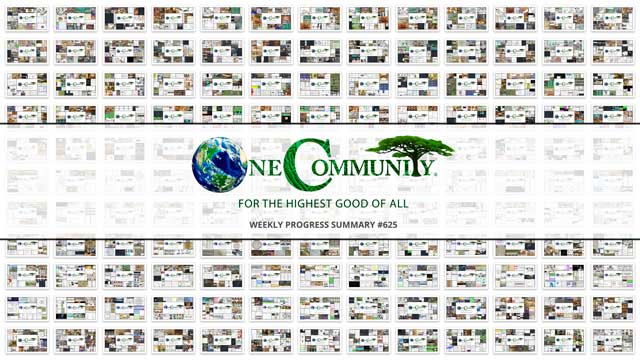
OUR MAIN OPEN SOURCE HUBS
Click on each icon to be taken to the corresponding Highest Good hub page.
One Community’s physical location will forward this movement for regenerative and sustainable change as the first of many self-replicating teacher/demonstration communities, villages, and cities to be built around the world. This is the March 10, 2025 edition (#625) of our weekly progress update detailing our team’s development and accomplishments:
Regenerative and Sustainable Change
One Community Progress Update #625
DONATE | COLLABORATE | HELP WITH LARGE-SCALE FUNDING
CLICK HERE IF YOU’D LIKE TO RECEIVE AN EMAIL EACH WEEK WHEN WE RELEASE A NEW UPDATE
YOU CAN ALSO JOIN US THROUGH SOCIAL MEDIA
ONE COMMUNITY WEEKLY UPDATE DETAILS
HIGHEST GOOD HOUSING PROGRESS
 One Community is creating regenerative and sustainable change through Highest Good housing that is artistic and beautiful, more affordable, more space efficient, lasts longer, DIY buildable, and constructed with healthy and sustainable materials:
One Community is creating regenerative and sustainable change through Highest Good housing that is artistic and beautiful, more affordable, more space efficient, lasts longer, DIY buildable, and constructed with healthy and sustainable materials:
- Learn about: Our Upcoming Crowdfunding Campaign
- Learn about the different village models and how they contribute to regenerative and sustainable change: 7 Sustainable Village Models
- Visit the open source portals for the first two: Earthbag Village OS Hub | Straw Bale Village OS Hub
This week, Adil Zulfiquar (Engineer) continued working on the Vermiculture Toilet engineering designs. Updates were made to the vermiculture operating conditions report based on feedback. A new report on temperature control for the vermiculture system was created, examining various commercially available monitoring devices. The report evaluated different options based on features, compatibility, use cases, pricing, system requirements, and real-time monitoring capabilities. The Earthbag Village, the first of seven planned villages, serves as the initial housing component within One Community’s open source model for regenerative and sustainable change. See below for some of the pictures related to this work.
Anil Karathra (Mechanical Engineer) continued advancing the engineering and design of the Vermiculture Toilet for the Earthbag Village project. Joseph’s work on the slider insertion platform was retrieved, the CAD models were edited, and the updated design was integrated into a new assembly. The weekly team meeting was led, including discussions on plumbing work plans and ideas with Audrey. Feedback from Jae was reviewed, and potential concerns and clarifications were addressed. Research on toilet seat options for the vermiculture toilet was completed, with a list compiled detailing possible choices along with their pros and cons. The research findings were documented and organized, and two options were shortlisted. A weekly summary was created, and screenshots of the past week’s work were uploaded to Dropbox. This commitment to regenerative and sustainable change drives the development of innovative, eco-friendly solutions that balance environmental responsibility with high standards of functionality. See below for pictures related to this work.
Audrey Gunawan (Mechanical Engineer) continued working on the Vermiculture Toilet plumbing details. Audrey worked on the SolidWorks model for the plumbing of the flush toilets, correcting misalignments where some toilet components were off-center and adjusting the design by creating larger holes for the vermiculture toilets. Additional piping was added for the flush toilet plumbing. After completing the plumbing layout for these toilets, she began working on the plumbing for the vermiculture toilets, discussing design options with the team and deciding to create an opening in the plates of the box to accommodate urine flow. A plumbing plan was started, and different approaches to connect the system to the main plumbing line are being evaluated. As the first of seven planned villages, Earthbag Village provides the initial housing within One Community’s open source designs for regenerative and sustainable change. See below for some of the pictures related to this work.
Charles Gooley (Web Designer) continued working on the Open Source DIY Dam Design for Water Retention, Pond and Lake Creation, etc. page. Charles worked on updates to the Tables of Contents, including rewording, clarifications, and additions. New content was added to the Dam Safety Incidents and Emergencies section, covering embankment overtopping, uncontrolled seepage, sinkholes in the reservoir, and slope failure. Dam Design is important for the Earthbag Village, a foundational part of One Community’s open-source creation process for regenerative and sustainable change. Take a look at some of the work in the images below.
Derrell Brown (Plumbing Designer) joined the team and began working on the Earthbag Village 4-dome home plumbing details. Derrell completed orientation setup, which included reviewing collaboration documents, setting up Dropbox for coordination, and communicating with team members Jae and Michaela. After orientation, he reviewed past markups of the current MEP design for the Earthbag 4 Dome building and identified questions and comments needed for design progress. After familiarizing himself with the project and coordinating with the architect, he created an electrical markup based on the reference plan to outline an initial design concept for the electrical power and lighting plans. One Community’s open source launching of regenerative and sustainable change begins with Earthbag Village, the first of seven planned villages providing housing. See below for some of the pictures related to this work.
Faeq Abu Alia (Architectural Engineer) continued his work on the Earthbag Village 4-dome home renders. Faeq focused on interior renovations, making improvements to rooms, doors, and materials, while incorporating interior planting to support functionality and aesthetics. Efforts were directed at refining design details to maintain a cohesive approach across the spaces. Work also continued on a walkthrough video intended to highlight the updates and overall design changes. The Earthbag Village is the first of 7 to be built as the housing component of One Community’s open source plans for regenerative and sustainable change. View examples of this work in the pictures provided below.
Karthik Pillai (Mechanical Engineer) continued helping finish the Vermiculture Toilet engineering and helping with the Earthbag Village 4-dome home roof plan. Karthik worked on the four-dome cluster roof design, comparing solid steel beam joists with hollow and I-section beams using FEA analysis to evaluate structural performance, with the results shared with Michaela for review. In the vermiculture toilet design, he analyzed the structural differences between extruded aluminum and standard Unistrut components, performing a basic FEA of the base to assess stability and load distribution. Additionally, he documented the waste dumping mechanism to outline its functionality and integration within the overall design. As the first of seven planned villages, Earthbag Village provides the initial housing within One Community’s open source designs for regenerative and sustainable change. See the work in the collage below.
Keerthi Reddy Gavinolla (Software Developer) continued working on the Vermiculture Eco-toilet Container Transport Solution web page. This week Keerthi worked on adding and formatting images as required. Links were added to important headers for direct navigation, along with links and title attributes for relevant images. The format was adjusted, including paragraphs, bullet points, and headings, to meet the requirements. After submitting the webpage for review to Jae, she received feedback and made the necessary changes. One Community’s open source tools and tutorials for regenerative and sustainable change begin with Earthbag Village, the first of seven planned villages providing housing. See below for some of the pictures related to this work.
Michaela Silva (Architect) continued working on the architectural details for the Earthbag Village 4-dome home design. Michaela began working with Derrell and set up a recurring meeting. She reviewed the past two MEP models and updated the current design documents to include a model with the updated mechanical system and a spa drain. Additionally, she framed an electrical chase at the kitchen island and a bulkhead around the structure framing the kitchen opening. As the first of seven villages in One Community’s open source plan for regenerative and sustainable change, the Earthbag Village represents the housing element. See her work in the collage below.
Rumi Shah (Civil Engineer) continued working on the Earthbag Village upgrades to bring our designs closer to construction-ready plans. Rumi updated the list page in the spreadsheet by associating each link with specific drawings instead of linking directly to the folder for better clarity and organization. Revisions were made to the checklist items, and table details were updated. She identified the need for a clearer distinction between the layouts for the kitchen, bedroom, and living room, which was added to the document. Additionally, she reviewed relevant codes and researched the dome clusters to ensure accuracy and compliance. One Community’s open source resources for regenerative and sustainable change begin with the Earthbag Village, the first of seven planned villages providing housing. See below for some of the pictures related to this work.
Yi-Ju Lien (Environmental Engineer) continued her work on the Earthbag Village LEED points related to stormwater retention. Yi-Ju reevaluated the current rainwater harvesting system, integrating three storage designs: barrel systems in the net-zero bathroom, a tank beneath the shower room supplying potable water, and the largest tank under the pond. The evaluation was updated using the latest area values and accounted for runoff differences due to surface materials, making the assessment more conservative. She also clarified the storage capacity calculation process to ensure the content was clearer and easier to understand, highlighting the importance of maintaining collaboration and unity in regenerative and sustainable change. See some of the work done in the collage below.
DUPLICABLE CITY CENTER PROGRESS
 One Community is creating regenerative and sustainable change through a Duplicable and Sustainable City Center that is LEED Platinum certified/Sustainable, can feed 200 people at a time, provide laundry for over 300 people, is beautiful, spacious, and saves resources, money, and space:
One Community is creating regenerative and sustainable change through a Duplicable and Sustainable City Center that is LEED Platinum certified/Sustainable, can feed 200 people at a time, provide laundry for over 300 people, is beautiful, spacious, and saves resources, money, and space:
- Learn about this building and it’s function: Duplicable City Center Open Source Hub
Mohammed Maaz Siddiqui (Architect) continued working on the cupola renders for the Duplicable City Center project. He worked on the SketchUp file, adjusting furniture that was clashing with models in the Lumion file. He then edited the rail path on the sun deck area, which had been pushed back, leaving a gap between the floor edge and the rail. He created a new rail path, added the rail, exported it, and imported it into Lumion. He also made changes to various event scenes in the Lumion file based on guidance from Jae, including adding a projection screen with different images corresponding to activities and adjusting the scale of human figures that were off. Within One Community’s open-source framework, the Duplicable City Center plays a central role in our mission of regenerative and sustainable change. The images below showcase some of this work.
Manjiri Patil (Mechanical Design Engineer) continued redesigning the connector to simplify the creation of 2D drawings. She separated the 3D drawing into several sections to expedite the design process. In order to make sure the design satisfies all necessary requirements, she is also actively examining and incorporating Jae’s most recent comments. In order to improve manufacturing and streamline on-site assembly, she is also reworking the dome structure’s struts. One Community’s open-source Duplicable City Center is a key part of our process creating regenerative and sustainable change. The images below showcase some of this work.
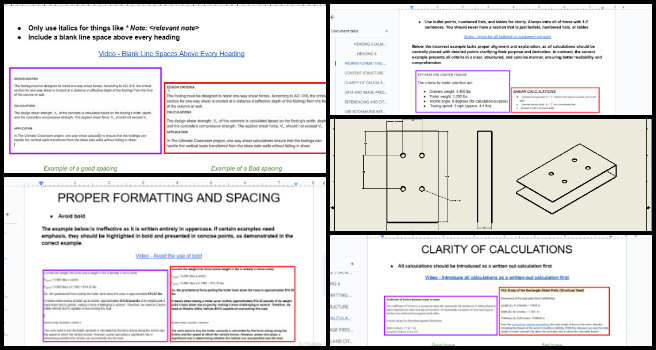
Rudrani “Sravya” Mukkamala (Mechanical Engineer) continued researching the structural components of a hydraulic elevator, focusing on the framework, guide rails, and load-bearing elements. She worked on drafting the outline for the report based on feedback from Jae. She spent time gathering and verifying additional information required for the report, ensuring accuracy and relevance of all the details. The outline was started and work on the report progressed with a clear structure that begins with the concept of the design, followed by specifications, dimensions, and a focus on the DIY aspect. She also included a comprehensive parts list, sourcing details, and considerations for ease of assembly. Efforts were made to ensure the report addresses practical concerns, such as sourcing standardized parts and simplifying the assembly process for DIY builders. She also allocated time to ensure all design elements were addressed in detail, keeping the report focused on the requirements for a hydraulic elevator. One Community’s open-source Duplicable City Center is a key part of our ongoing mission for regenerative and sustainable change. The images below showcase some of this work.
Sanket Basannavar (Mechanical Engineer) continued working on the Duplicable City Center spa cover as part of the City Center Natural Pool and Eco-spa Designs. He created a new pool design with a curved edge on one side to improve interaction among users. The spa cover was redesigned to match the new pool shape, and the R-value was calculated for a 6-inch EPS core thickness. The pool was placed within the AutoCAD plan, and FEA was performed on individual panels of the spa cover. Regenerative and sustainable change relies on open-source tools like One Community’s Duplicable City Center. The images below showcase some of this work.
Srujan Pandya (Mechanical Engineer) set up the model for the dome in Abaqus, defining materials such as structural steel for the frame and machined steel for the hub connectors. He focused on meshing individual parts, totaling 601 components. The mesh was hex-dominated with a swept approach along the medial axis. Coarse mesh configurations had around 500-600 nodes, while finer mesh for frames with bolted connections required approximately 2000 nodes. Even with the coarsest feasible mesh for individual frames (400-450 in number, the rest are the hub connectors), the total assembly exceeded 250,000 nodes, surpassing the limits of the academic license. Rachan facilitated a discussion with Dipak Patil, who indicated that due to the number of components and computational constraints, running the model in Abaqus or similar software would not be practical. Using a coarser mesh to fit within the limitations would compromise the accuracy of the results. Based on this, the approach shifted to frame analysis, initially explored in the first week. This method represents the frame using simple beam elements with nodes at either end, which are connected via rigid links to ensure structural continuity and correct stress transmission. Within One Community’s open-source framework, the Duplicable City Center plays a central role in the mission of regenerative and sustainable change. The images below showcase some of this work.
Yan “Jenni” Zu (Architectural Designer) continued her work on the greenhouse area of the Duplicable City Center. She completed the high-definition animation rendering for both the greenhouse interior and exterior. The total rendering time for the interior animation was 236 hours, while the exterior animation took 16 hours. The rendering process ensured high-quality visuals, realistic lighting, and smooth animation performance. Each frame was carefully processed to maintain visual consistency and accuracy, enhancing the final presentation. The completed animations effectively showcase the greenhouse’s design, atmosphere, and spatial qualities, providing a detailed and immersive experience. Regenerative and sustainable change relies on open-source tools like One Community’s Duplicable City Center. The images below showcase some of this work.
Nimika Devi (Architect) continued her contributions to the landscape design and development of the Duplicable City Center‘s urban farm. She completed the process of organizing project files, and the relevant documents were uploaded to Google Drive. Older files were excluded from the upload as they contained minimal progress and were not deemed necessary for retention. The most recent file that could be saved was uploaded to ensure the latest available updates were documented. However, due to technical issues, any modifications made after this version were not preserved. Within One Community’s open-source framework, the Duplicable City Center plays a central role in the mission of regenerative and sustainable change. The images below showcase some of this work.
HIGHEST GOOD FOOD PROGRESS
 One Community is creating regenerative and sustainable change through Highest Good food that is more diverse, more nutritious, locally grown and sustainable, and part of our open source botanical garden model to support and share bio-diversity:
One Community is creating regenerative and sustainable change through Highest Good food that is more diverse, more nutritious, locally grown and sustainable, and part of our open source botanical garden model to support and share bio-diversity:
- Learn about the structures: Hoop House Hub | Aquapini & Walipini Open Source Hub
- See what we’ll be growing: Gardens & Hoop Houses | Large-scale Structures | Food Forest | TA
This week, the core team completed the addition of project designations for the Earthbag Dome, Goat, Chick, and Rabbit categories within the Master Tools, Equipment, and Materials/Supplies list. They noted that while many tools are shared across multiple projects, project-specific tools are not included in the Master document. They then began integrating the supplemental tool document into the master document. The Highest Good Food initiative is a key component of One Community’s open source plans, focused on regenerative and sustainable change, and exemplifies the organization’s commitment through innovative design and implementation. Below are some of the images showcasing this work.
Dirgh Patel (Volunteer Mechanical Engineer) verified all necessary documentation and set up accounts before engaging in readings about Aquapini and Walipini structures, Duplicates City Centers, Tropical Atrium, and Global Sustainability Strategies. He reviewed the Open Source Climate Battery Design and explored the related collaboration master folder. Activities included studying the Essential Design Criteria and reviewing prior research such as the Climate Battery Greenhouse Version 2 by Threefold Farm. He proceeded to examine the Aquapini and Walipini Design Overview, Open Source Climate Battery Design page, Aquapini and Walipini pages, Aquapini Planting Guide, and Thermal Lag Research and Tutorial. Additionally, he concluded his week with the initiation of the “Truly Passive Greenhouse” reading to integrate it with the ongoing Aquapini and Walipini designs in collaboration with the Climate Battery project. The Highest Good Food initiative is a key component of One Community’s open source plans, focused on regenerative and sustainable change, and exemplifies the organization’s commitment through innovative design and implementation. Below are some of the images showcasing his work.
Jay Nair (BIM Designer) continued working on Aquapini and Walipini Planting and Harvesting lighting and HVAC design. He updated the lighting plan in Revit to reflect the latest fixture, ensuring alignment with project requirements. Formatting adjustments were made to the document to improve consistency and readability. Additionally, Jay began analyzing the plumbing system needed for Walipini 1, focusing on layout, water distribution, and system integration. Regenerative and sustainable change includes One Community’s Highest Good Food initiative that provides open source designs and implements innovative food systems. Below are some of the images showcasing this work.
Jessica Fairbanks (Administrative Assistant) reviewed the work of a fellow admin and provided detailed feedback for improvements. She formatted all project resources and uploaded them to her Dropbox for secure file storage. She also made edits and additions to the cost analysis for implementing a Highest Good Food program in various small-scale organizations, including communities, schools, and companies. The Highest Good Food initiative is a key component of One Community’s open source plans, focused on regenerative and sustainable change, and exemplifies the organization’s commitment through innovative design and implementation. Her contributions are highlighted in the collage below.
Mary Nelson (Landscape Planner) worked on her One Community profile biography. She continued to work on her meadow garden tutorial, developing a general seed mixture appropriate for various climates. She also created a maintenance schedule for the first three years of the meadow, detailing the different stages of establishment. Mary ended the week by completing her bio for the One Community discussion board and uploading it for review. The Highest Good Food initiative is essential to One Community’s open source plans, designed with the goal of regenerative and sustainable change, and examplifying the organization’s commitment through innovative design and implementation. Her contributions are highlighted in the collage below.
Pallavi Deshmukh (Software Engineer) continued reviewing team member’s work and incorporated their contributions to ensure completeness. She also completed three interviews and provided details accordingly. Work continued on web page design by integrating Chris’s GIS content into the permaculture page using the web design tutorial. PRs 2289+960 were tested and appeared to be working as expected. Regenerative and sustainable change, a part of One Community’s Highest Good Food initiative, provides open source designs and implements innovative food systems. Her contributions are highlighted in the collage below.
Tanmay Koparde (Industrial Engineer And Team Administrator) continued optimizing Food Procurement and storage to enhance efficiency and sustainability. He revised the Food Procurement calculations for 50 individuals in Mariposa, adjusted storage needs, and explored cost-effective, high-protein lentil options and alliums. He read about how IoT and blockchain technologies are enhancing food logistics to optimize quality. The Highest Good Food Initiative is a key component of One Community’s open source plans, focused on regenerative and sustainable change, and exemplifies the organization’s commitment through innovative design and implementation. See his work in the collage below.
Vatsal Tapiawala (Mechanical Engineer) continued working on Aquapini/Walipinis structures. He worked on refining the geometry for the analysis of the copper destratification pipe by identifying and resolving interferences. He then attempted to mesh the entire model to proceed with simulations. Additionally, he reviewed the feedback on the earthen roof report and began making the necessary revisions to incorporate the suggested changes. The Highest Good Food Initiative is a key component of One Community’s open source plans, supporting regenerative and sustainable change, and exemplifying the organization’s commitment through innovative design and implementation. See his work in the collage below.
HIGHEST GOOD ENERGY PROGRESS
 One Community is creating regenerative and sustainable change through Highest Good energy that is more sustainable, resilient, supports self-sufficiency and includes solar, wind, hydro and more:
One Community is creating regenerative and sustainable change through Highest Good energy that is more sustainable, resilient, supports self-sufficiency and includes solar, wind, hydro and more:
- Learn about the open source sustainable-energy foundations: Solar, Hydro, and Wind
- Explore our research into the most sustainable products and companies for saving water and energy: Insulation, Eco-laundry, Lightbulbs and Light Bulb Companies, Doors and Door Companies, Windows and Window Companies, Toilets, Faucets and Faucet Accessories, Urinals, and more.
This week, Dishita Jain (Data Analyst And Team Administrator) continued addressing multiple assignments within the Highest Good Energy and OC Administration projects. She engaged in updating and refining an Excel sheet for solar infrastructure costs, fixed minor issues previously noted, and added specific cost calculations for solar panels resulting in 4000 units. She also researched the top three solar panels and included images with detailed descriptions for each panel to enhance the document’s utility and professionalism. On the administrative side with OC Administration, Dishita reviewed a colleague’s training work, provided essential feedback, worked on a team collage, completed a blog post, and made updates on WordPress for team summaries. Her contributions spanned both technical precision in cost analysis and creative input in team-related documentation and feedback. The Highest Good Energy initiative is a key component of One Community’s open source plans, focusing on regenerative and sustainable change, and exemplifying our commitment to innovative design and implementation. Below are some of the images showcasing this work.
Muhammad Sarmad Tariq (Electrical Engineer) started compiling the methodology for calculating profit and net savings for an off-grid and a grid-tied solar PV system using the Excel sheet format. The sheet functions as an automatic calculator for determining profit and net savings for both off-grid and grid-tied solar PV systems. The formatting included dividing the calculator into sections, labeling inputs and outputs separately, specifying the correct units for each value, and ensuring the accurate entry of formulas. Additionally, descriptions for each value were written. The Highest Good Energy initiative is a key component of One Community’s open-source plans, designed for regenerative and sustainable change, and demonstrating our commitment through innovative designs and implementation. See his work in the collage below.
HIGHEST GOOD EDUCATION PROGRESS
 One Community is creating regenerative and sustainable change through Highest Good education that is for all ages, applicable in any environment, adaptable to individual needs, far exceeds traditional education standards, and more fun for both the teachers and the students. This component of One Community is about 95% complete with only the Open Source School Licensing and Ultimate Classroom construction and assembly details remaining to be finished. We’ll report on the final two elements to be finished as we develop them. With over 8 years of work invested in the process, the sections below are all complete until we move onto the property and continue the development and open sourcing process with teachers and students – a development process that is built directly into the structure of the education program and everything else we’re creating too:
One Community is creating regenerative and sustainable change through Highest Good education that is for all ages, applicable in any environment, adaptable to individual needs, far exceeds traditional education standards, and more fun for both the teachers and the students. This component of One Community is about 95% complete with only the Open Source School Licensing and Ultimate Classroom construction and assembly details remaining to be finished. We’ll report on the final two elements to be finished as we develop them. With over 8 years of work invested in the process, the sections below are all complete until we move onto the property and continue the development and open sourcing process with teachers and students – a development process that is built directly into the structure of the education program and everything else we’re creating too:
- Program Overview: Education Open Source Hub
- How the components work together in designing human orchestrated eco-abundance: How to use the Education for Life Program
- Lesson Plans for Life – Lesson Plans How-to
- Foundations of Outstanding Leaders, Teachers, and Communicators
- Curriculum for Life
- Teaching Strategies for Life
- Learning Tools and Toys for Life
- Evaluation and Evolution
This week, Bhavya Prakash (Software Engineer) continued her work on the Figma designs for the Highest Good Network software, where she worked on the student dashboard, with a lesson plan added to the designs. Menu options were incorporated into the dashboard, and the requirements were reviewed to guide further design updates. Research was conducted using online resources to explore design ideas. Screenshots and pictures were added to the Figma designs to enhance their appearance. The One Community model of regenerative and sustainable change with sustainably built classrooms like this is an excellent example of sustainable change for the whole planet. See the collage below for her work.
Harshitha Rayapati (Program Manager) assisted with the research for regenerative and sustainable change by continuing work on detailing and breaking down deliverables for the education platform to support mock-up creation. This included outlining front-end requirements for various components and defining key features. Initial Figma designs for the student dashboard landing page were developed in collaboration with Bhavya, with efforts to expand the visual layout of student profile views. Additionally, support was provided in compiling the weekly blog update, reviewing the Graphic Design Team’s progress, editing the blog page, and creating a collage. The One Community model of regenerative and sustainable change with sustainably built classrooms like this is an excellent example of sustainable change for the whole planet. See the collage below for her work.
Mrinalini Raghavendran (Software Engineer) assisted with the research for regenerative and sustainable change by working on a new task document assigned by Jae, created a Slack group to coordinate with teammates, and divided the task among them. She outlined the frontend and backend requirements based on Figma designs and task details. She then documented the remaining action items, explained a task to a teammate, and sent the document to Jae for initial feedback. After reviewing all the requirements provided by the team, she made suggestions before finalizing the document. She also claimed a task from the listing and bidding document and started working on the backend implementation. Her work on the backend Node.js script for payment processing continued, and she drafted an initial schema for structuring the data in the database. She then formatted all newly structured dashboard requirements in the HGN Phase II document. By demonstrating regenerative and sustainable change with classrooms like this, One Community provides a replicable example for global sustainable development. See the collage below for her work.
HIGHEST GOOD SOCIETY PROGRESS
 One Community is creating regenerative and sustainable change through a Highest Good society approach to living that is founded on fulfilled living, the study of meeting human needs, Community, and making a difference in the world:
One Community is creating regenerative and sustainable change through a Highest Good society approach to living that is founded on fulfilled living, the study of meeting human needs, Community, and making a difference in the world:
- Read the Highest Good society overview: Highest Good Society
- Learn about the model for fulfilled living and sharing: A Day in the Life
- Learn about the 4 economic models: RBE | For-profit | Non-profit | Entrepreneurship
- Learn about our open source community collaboration and management software: The Highest Good Network
This week, the core team completed over 55 hours managing One Community’s volunteer-work review not included above, emails, social media accounts, web development, new bug identification and bug-fix integration for the Highest Good Network software, and interviewing and getting set up new volunteer team members. They also shot and incorporated the video above that talks about regenerative and sustainable change and how regenerative and sustainable change is a foundation of the bigger picture of everything One Community is doing. The image below shows some of this work.
Anoushka Hazari (Data Analyst) continued working on code to automate and simplify the Highest Good Network software promotion process. She reviewed team pull requests and updated the PR review table. New members joined the team. She wrote a blog, designed a collage to complement it, and corrected an error in a previous blog for accuracy. She updated the HGN spreadsheet and reviewed work listed in sheet 4, including peer blogs. She worked on the Figma design for the dashboard, incorporating feedback to improve PR review tracking and automate promotions. She recorded a video tour via Loom to present proposed changes and created an action item list for the software team, prioritizing GitHub API integration, promotion eligibility logic, and long-open PR alerts. This work helps One Community’s mission of regenerative and sustainable change and reinforces our commitment to regenerative and sustainable change. The following images show her work for the week.
Chitra Siddharthan (Data Analyst and Team Administrator) continued focusing on the existing web pages of the HGN Phase II website. This week, she focused on various tasks related to HGN Phase 2 and team Code Crafters. Work was completed on the blog, weekly summary, and Dropbox files for team Code Crafters for week #624, and the blogs of Ryu and Preksha were reviewed. The backend and data storage mechanisms of the HGNApp were studied to understand the code and its functionality. A meeting was held with Jaiwanth via Google Meet to discuss data retrieval for the visualization in HGN Phase 2, and progress on the related action items was monitored. The Phase 2 Work Breakdown Structure (WBS) was updated, ensuring completed tasks were accurately reflected with the corresponding PR numbers and task statuses. Assistance was provided to Ashrita with her task on the Consumables update page for Phase 2, while also ensuring that both the HGN Phase 2 documentation and WBS were kept up to date. Finally, work was completed on the User Manual and weekly summary for the week. This work helps One Community’s mission of regenerative and sustainable change and reinforces our commitment to regenerative and sustainable change. The following images show her work for the week.
Govind Sajithkumar (Project Manager) assisted with the research for regenerative and sustainable change by starting work on social media posting, analytics, and strategy evolution for the Meta (Facebook and Instagram) platforms. He worked on Meta (Facebook & Instagram) Analytics Reporting and Tracking. He updated the Meta Analytics Report & Tracking Sheet with Facebook data through March 3rd, 2025, ensuring accurate extraction, cleaning, and structuring of relevant metrics. Historical Instagram analytics data from previous years was downloaded and pre-processed while resolving a column conflict that was preventing proper data cleaning. The Facebook data sheet was rearranged for clarity after inserting the latest data. Social media content scheduling was completed through March 23rd, maintaining a minimum of six posts per day, with many days featuring nine posts. Scheduled post timings were adjusted to align with optimal engagement periods, and tracking documentation was updated accordingly. Additionally, he completed PR Review Team management tasks, including reviewing team documents and updating tracking sheets. This work helps One Community’s mission of regenerative and sustainable change and reinforces our commitment to regenerative and sustainable change. The following images show her work for the week.
Hritvik Mahajan (Data Analyst) assisted with the research for regenerative and sustainable change by continuing focus on multiple tasks related to marketing, promotion, software development, social media strategy, and administrative activities. As part of the marketing and promotion tasks, He worked on HGN software development, marketing, and OC administration. He reviewed and followed up on multiple pull requests, addressing merge conflicts and coordinating with team members on Slack. He refined the design for the HGN Social Media Scheduler. In marketing and promotion, he managed Twitter community posts, selected content for the following week, and updated tracking spreadsheets. Additionally, he provided feedback on admin team members work related to Blog #624 in the Step 4 document. This work helps One Community’s mission of regenerative and sustainable change and reinforces our commitment to regenerative and sustainable change. The following images show his work for the week.
Jaiwanth Reddy Adavalli (Project Manager) continued work on designing the Phase 2 Highest Good Network dashboard. He met with Chitra to discuss data collection and backend operations for the Phase 2 software. He created graphs for three new pages and broke down all graphs into clear action items for the software development team. Additionally, he performed his weekly responsibilities managing the PR Review team. This work helps One Community’s mission of regenerative and sustainable change and reinforces our commitment to regenerative and sustainable change. The following images show his work for the week.
Raghav Dinesh Pamuru (Product Manager) continued focusing on designing and building a Google Sheets dashboard to simplify tracking and analyzing social media engagement, integrating data from multiple sources. He led a team of data analysts and used a Google Sheets dashboard to track social media engagement across seven platforms. He oversaw the implementation of social media strategies that reached an engaging audience and analyzed key performance metrics to identify trends that increased conversions. He also created new tracking methods for social media engagement that raised customer retention and developed documentation resources to reduce onboarding time for new team members. He participated in weekly meetings to discuss progress, challenges, and opportunities, contributing to improved organizational communication. This work helps One Community’s mission of regenerative and sustainable change and reinforces our commitment to regenerative and sustainable change. The following images show his work for the week.
Vimarsh Acharya (Engineering Manager and Technical Reviewer) began helping with an AI music creation task. He worked on AI song creation, focusing on a list of approximately 600 songs. The task involved generating, reviewing, and refining song outputs to ensure they met the intended structure and quality. Over 100 songs have been completed so far, with each requiring adjustments to lyrics, melody, or composition based on predefined criteria. The process included evaluating AI-generated content for coherence, accuracy, and creativity, making necessary modifications to improve the overall output. The One Community model, which combines forward-thinking education with sustainably built classrooms like this, is an excellent example of regenerative and sustainable change. See the collage below for his work.
Yash Shah (Data Analyst and Team Administrator) continued his admin work and managed the social architecture component of the Highest Good Network software. He worked on the task of requesting conflict resolution and addressing requested changes. The previous task was reassigned to Nishita, and additional hours were allocated for Khushi. Efforts were made to identify pull requests that had received approvals to request their merging. A blog post was created for Dev Dynasty, and the weekly folder was organized. A collage was put together, and feedback was provided on fellow volunteers’ blogs. This work helps One Community’s mission of regenerative and sustainable change and reinforces our commitment to regenerative and sustainable change. The following images show his work for the week.
Zhen Xiang (Financial Analyst) started the position and spent considerable time familiarizing with the system’s operations. Some initial preparation hours were not accurately recorded due to unfamiliarity with the system, but steps were taken to better understand the necessary procedures and ensure accurate tracking moving forward. All required training materials, including videos and readings, were reviewed to establish a foundational understanding of the role and its key responsibilities. In addition to internal resources, extensive research was done across various external websites to gain insights into industry best practices and strategies for effectively performing the role. This included studying market trends, analyzing case studies, and exploring different methodologies to enhance the decision-making process. Beyond learning the system and industry context, significant time was spent researching potential investors, assessing their backgrounds, investment history, and strategic interests. Various sources were consulted to compile a list of relevant prospects, and preliminary analysis was performed to evaluate their alignment with the organization’s objectives. The development of the interest matrix was also initiated, involving the design of an Excel framework to structure the evaluation process in a structured manner. Leveraging a background in risk management, multiple assessment criteria were considered to ensure the matrix effectively captures key risk factors, investment potential, and other relevant indicators. The process involved refining the selection methodology, determining how different attributes should be weighted, and exploring different scoring models to enhance accuracy and consistency. Additionally, time was spent evaluating possible improvements to the framework to make it more adaptable and efficient for future use. This work helps One Community’s mission of regenerative and sustainable change and reinforces our commitment to regenerative and sustainable change. The following images show her work for the week.
Zuqi Li (Administrative Assistant and Economic Analyst) continued managing One Community’s LinkedIn page. She explored LinkedIn Analytics documentation, analyzed dashboards to track project progress, and updated key metrics. Additionally, she refreshed dashboards, reviewed post-editing documentation, and planned content for the following week. She collaborated with Preksha to refine LinkedIn Analytics tasks, selected relevant hashtags for LinkedIn posts, and scheduled daily posts to increase engagement. She also assessed content performance trends to optimize future posting strategies. This work helps One Community’s mission of regenerative and sustainable change and reinforces our commitment to regenerative and sustainable change. The following images show her work for the week.
ADMINISTRATION TEAM
The Administration Team summary, covering their work administrating and managing most of One Community’s ongoing process for regenerative and sustainable change was managed by Mimansha Kaushik (Data Analyst Team Administrator) and includes Himanshu Mandloi (Engineering Project Manager), Jibin Joby (Data Analyst), Kishan Sivakumar (Administrative Assistant and Software Team Manager), Olawunmi “Ola” Ijisesan (Administrative and Management Support), Preksha Welankiwar (Digital Marketing Manager), Rachna Malav (Data Analyst), Rishi Sundara (Quality Control Engineer And Team Administrator), Ryutaro Wongso (Economic Analyst and Team Administrator), Shrinivas Patil (Software Engineer), Vasavi Vuppala (Software Engineer) and Vishnu Murali (Data Analyst). The Highest Good Network software is how we’ll be managing and objectively measuring our process for regenerative and sustainable change through our social architecture, construction, production, and maintenance processes.
This week, the Administration team assisted with the research for regenerative and sustainable change by collectively working on a variety of tasks. Himanshu focused on administrative tasks, timelog reviews, and member follow-ups. He added hours for a team member, verified task updates, and followed up with members with incomplete or missing logs. Outreach was conducted for unresponsive members, and an issue was reported to Jae. He also reviewed an admin-in-training’s work, participated in the Sunday review, and contributed to a blog on open-source strategies. Jibin reviewed the housing team’s work, created collages, updated assigned pages, and formatted insights based on feedback from Jae. He collaborated with Vishnu to extract updated data from BlueSky using the BlueSky scraper, generating visual reports and increasing the follower count to 26. Kishan handled senior admin duties, reviewed volunteer documents, tracked progress, and addressed requests. He reviewed and edited SEO pages and started working on new admin tasks while revisiting previously optimized pages. Mimansha worked on SEO optimization for multiple blogs, improving keyword density, title readability, and search rankings. She participated in the hiring process by interviewing a candidate and updating the hiring spreadsheet. Additionally, she reviewed and updated a training blog based on feedback. Ola managed Pinterest scheduling, supervised managers responsible for pull request reviews, provided feedback, resized images, updated document files, and submitted the weekly summary report.
Preksha focused on community building on Threads, created content for LinkedIn and Threads, and met with Govind to discuss social media strategies. She consulted with Jae on graphics and interviewed four candidates for volunteer roles, updating the hiring workbook. Rachna was unable to schedule interviews as other admins filled requests simultaneously, so she worked on pending SEO pages, checked prior work, and stayed updated via emails and comments. Rishi completed admin training, modified training materials, updated the AI Music Creation task tracking sheet by refining prompts, and reviewed documentation related to senior admin responsibilities. Ryutaro adjusted formatting in an Excel sheet, updated cost analysis for the duplicable city center, and refined the template by adding new expense categories. He also reviewed the Binary Brigade development team’s weekly contributions. Shrinivas completed work on blog 624 for Team Moonfall, managed nine team members, assisted Sara with the admin feedback spreadsheet, and continued research on sustainable plastics. He analyzed six research papers focused on U.S. plastic sustainability statistics and compiled findings for the graphics team. Vasavi worked on orientation, initial setup, and PR reviews, resolving database access issues and verifying multiple PR functionalities across different features and user accounts. Vishnu extracted and visualized BlueSky data, managed social media engagement, reviewed Lucky Star team members’ work, and strategized with Jibin on social media growth while providing updates to Raghav on analytics. This work contributes to One Community’s commitment to regenerative and sustainable change. See below to view images of their work.
GRAPHIC DESIGN TEAM
The Graphic Design Team’s summary was managed by Harshitha Rayapati (Program Manager) and includes Aurora Juang (Graphic Designer) and Junyuan Liu (Graphic Designer, UI/UX Designer), covering their work on graphic designs for regenerative and sustainable change. This week, Aurora assisted with the research for regenerative and sustainable change by revising icons and began updating information on the Seven Villages book. She worked on six social media campaigns focused on education topics, continued designing new chapter icons for the website, and finalized social media campaign images for Jae’s approval. She managed social media content creation posts from Google Sheets, including publishing new volunteer bios, revising errors, ensuring accuracy, and drafting bio announcements.
Junyuan worked on social media content by collecting images and exploring design options in design software. Three new social media images were completed, and initial steps were taken to search for images and develop design ideas for the next piece. Additionally, he brainstormed approaches for future image creation. See the Highest Good Society pages for more on how this contributes to regenerative and sustainable change. See the collage below to view some of their work.
HIGHEST GOOD NETWORK PROGRESS
 One Community is creating regenerative and sustainable change through open source Highest Good Network® software that is a web-based application for collaboration, time tracking, and objective data collection. The purpose of the Highest Good Network is to provide software for internal operations and external cooperation. It is being designed for global use in support of the different countries and communities replicating the One Community sustainable village models and related components.
One Community is creating regenerative and sustainable change through open source Highest Good Network® software that is a web-based application for collaboration, time tracking, and objective data collection. The purpose of the Highest Good Network is to provide software for internal operations and external cooperation. It is being designed for global use in support of the different countries and communities replicating the One Community sustainable village models and related components.
- Learn about our open source community collaboration and management software: The Highest Good Network
This week, the core team continued their work on the Highest Good Network PRs and confirmed fixes for several issues, including incorrect popup messages when deleting a task, quick setup codes not saving and not allowing URLs with a space at the end (PR#3183, PR#3181), and adding a People Report icon and the number of tasks completed next to the Google Doc icon on the Dashboard> Tasks tab (PR#3042). Other confirmed fixes included copying a resolved task not displaying it in the dashboard/individual’s tasks dropdown (PR#3132), resolving issues with the purchase request form for tools (PR#2770), adding details in the add material form (PR#2982), fixing the “Active” filter on the Projects page (PR#2865), correcting blue square summary formatting and date tags (PR#2919), and implementing access control for the Highest Good Education Portal (PR#3138). Additional fixes included addressing the material approval process (PR#2827), ensuring the blue square scheduler only accepts whole numbers for duration in weeks (PR#3021), and resolving the category bug in the create project feature on the Profile>Projects tab (PR#3053). Issues that were not fixed included the mismatch of colors when adding a percentage toggle to the People Report (PR#2905) and the inability to change the project category from the table on the Projects page (PR#3019). They also assigned tasks to two volunteers. These improvements represent incremental steps towards the realization of regenerative and sustainable change. See the Highest Good Society and Highest Good Network pages for more on how this relates to regenerative and sustainable change. The collage below shows some of their work.
ALPHA SOFTWARE DEVELOPMENT TEAM
The Alpha Team’s summary, covering their work on the Highest Good Network software, was managed by Lin Khant Htel (Frontend Software Developer) and the team includes Jiaqi Nie (Software Engineer), Sheetal Mangate (Software Engineer), Sujith Reddy Sudini (Full-Stack Software Developer), Rupa Rajesh Bhatia (Software Engineer), and Vinay Vallabineni (Software Engineer).
This week, Lin reviewed and approved PR #3223, tested the codebase locally with all 11 test cases passing as expected, and continued learning about the project. Lin reached out to team members for consultation and reviewed the weekly summaries, photos, and videos submitted by Alpha team members. He also handled Alpha Team management duties, including task assignments and oversight. Jiaqi worked on the bidding page overview backend. He created an endpoint to retrieve property data, validated new bid requests, and implemented functionality to post new bids. He also planned to address an issue related to Safari optimization by rebasing the branch to the development branch on Saturday, aiming to resolve compatibility issues and improve performance which required changes within the regenerative and sustainable change framework.
Rupa enhanced the multi-step form project by improving responsiveness across various devices while maintaining a cohesive design through modular principles and custom visual elements. She integrated interactive features like sliders, custom input fields, and toggle switches, efficiently managing them with dynamic state handling. Additionally, she optimized navigation for seamless transitions while preserving user data and implemented real-time validation to ensure data accuracy. She also introduced innovative features such as digital signatures and user preference settings. As part of her managerial training, she analyzed workflows and reviewed Lin’s project to strengthen her skills. She also collaborated with Jiaqi, Vinay, Sujith and Sheetal to refine project summaries and enhance overall functionality. Sheetal assisted with the research for regenerative and sustainable change by continuing her work on the “Development for Re-Engagement Strategies” task from HGN Phase III. She focused on creating a route in the front end to display the no-show list. She also reviewed the existing code to ensure consistency and determine the best approach to adding a new route for CP. In addition, she worked on designing a pop-up interface for listing users and developing the associated CSS.
Sujith assisted with the research for regenerative and sustainable change by working on the HTML structure for the activity comments section, focusing on creating a clean and organized layout to enhance user experience. He ensured that the elements were well-structured and aligned with the overall design guidelines of the project. Additionally, he made sure that the code was easy to maintain and scalable for future updates. His efforts contributed to laying a strong foundation for the comments section, enabling smoother integration of backend functionalities and improving the platform’s interactivity.
Vinay worked on the “Fix Dev not issuing blue squares and blue square editing issue” bug. The issue with editing newly created blue squares was resolved by adding an ID to the new blue square object returned from the add blue square endpoint and appending it to the list. The details of the edit model are now populated using the blue square ID. After debugging the other part of the bug, no issues were found with the blue square auto-issue function, but the problem may have been caused by the blockage of a prior job. Since this was fixed last week, it should now be functioning properly. The entire team’s efforts required changes within the regenerative and sustainable change framework. See below for some of their work.
BINARY BRIGADE SOFTWARE DEVELOPMENT TEAM
The Binary Brigade Team’s summary overseeing advancements in the Highest Good Network software was managed by Vijay Anand Pandian (Full Stack Software Engineer) and includes Aaryaneil Nimbalkar (Software Developer), Anirudh Sampath Kumar (Software Developer), Aureliano Maximus (Volunteer Software Engineer), Deepthi Kannan (Software Engineer), Geeta Matkar (Software Engineer), Jaissica Hora (Software Engineer), Sabitha Nazareth (Software Engineer), Samman Baidya (Software Engineer), Sriram Seelamneni (Software Engineer), and Sunil Kotte (Full Stack Developer). The Highest Good Network software is how we’ll be managing and objectively measuring our progress in regenerative and sustainable change through our social architecture, construction, production, and maintenance processes.
This week, Aaryaneil tested and reviewing multiple pull requests addressing various fixes and enhancements, all aimed at fostering regenerative and sustainable change within the system. The reviews included corrections to the badge assignment function, updates to user management icons, and modifications to the summary text header. Additional changes reviewed involved updates to the bidding page, whitespace error fixes, listing overview improvements, and the creation of an email template and feedback form. Further reviews covered spacing and alignment adjustments in the profile rendering component, weekly summaries report testing, bug fixes for material list logic, member column filtering, and inactive user summary display. Other tested updates included permission management log fixes, user management table adjustments, link requirement improvements for time log submissions, fixes for volunteer user creation errors, dropdown null value corrections, unit tests for weekly summaries reports, task completion link limits, and updates to login and dashboard pages. The reviews also included testing weekly summaries API prompts and fixing checkbox functionality in the reports page, contributing to the team’s goal of regenerative and sustainable change.
Anirudh completed two related tasks involving updates to the leaderboard, focusing on implementing changes that promote regenerative and sustainable change in team processes. An existing pull request required resolving merge conflicts and addressing failing unit tests. He fixed the conflicts but was unable to identify the failing test. The pull request has been completed, and updates have been documented in the team’s Google document. The second task involved adding a tooltip to the leaderboard to indicate members with scheduled or future time off. Changes included adding a function in timeOffRequestAction.js to calculate upcoming time off, modifying existing functions to update vacation-related objects, and updating reducers and constants to support these changes. An array restricting leaderboard indicator access was introduced, ensuring only owners and logged-in users can view their own indicators. A tooltip was added next to usernames to explain additional and future weeks’ numbers, and necessary updates were made to LeaderBoardContainer.jsx to incorporate users on future time off. The task has been completed, and a request has been raised for review, all of which contribute to creating regenerative and sustainable change within the system.
Aureliano implemented functionality to enable posting to Imgur in the frontend and backend branches of the Highest Good Network project, aiming to achieve regenerative and sustainable change through improved system capabilities. A temporary frontend button was developed to test backend posting to Imgur, but an issue arose requiring an authorization token for access to any HGN Rest endpoint. Research was conducted into other branches and the codebase to determine how the token was applied, but no immediate solution was found, leading to a question being posted in the coding-problems Slack channel. A simple endpoint was created to upload directly to Imgur through the HGN backend, with further error handling and scheduled posting functionality still pending. Research was conducted on Imgur APIs, OAuth2, and the HGN backend app, with testing performed in Postman to verify the implementation. Regex was updated to improve link filtering as requested in a pull request. Additionally, improvements were made to the warning text in the ‘hours’ section to match the add task modal, enhancing the platform’s ability to drive regenerative and sustainable change.
Deepthi worked on the overlap of the dropdown in the dashboard bug to ensure the fix remains stable across particular screen sizes, reflecting a commitment to regenerative and sustainable change through continuous improvement. Additional testing was done to verify that the dropdown appears above the “Taking Time-Off Content” overlay in various browser environments and layouts. Adjustments were made to the CSS to maintain the correct stacking order. The fix is finalized once all tests confirm stability, supporting the team’s ongoing pursuit of regenerative and sustainable change. Geeta worked on a task to ensure the blue square system indicates who issued the blue square. However, after updating the system last week, Docker has been causing issues and crashing the system, preventing work on tasks as expected. Troubleshooting is in progress, and once resolved, work on completing tasks continues, aiming to bring regenerative and sustainable change to the environment. Jaissica created unit tests for Timer.jsx and submitted a pull request for it, contributing to the pursuit of regenerative and sustainable change in the project’s functionality. She implemented a change to assign “Other” as the reason for manually created infringements to improve tracking and ensure accurate data logging and dashboard. She assisted team members with coding issues related to setup and login, troubleshooting authentication errors, and clarifying implementation details. She also began initial work on a prototype for a button on the Phase 2 Summary Dashboard, reviewing design requirements and considering potential implementation approaches, all of which are steps toward achieving regenerative and sustainable change.
Sabitha worked on a task from the listing and bidding application, focusing on a backend task to create a dropdown and filter out village data. She reviewed the backend codebase to familiarize herself with the existing structure and connected to MongoDB locally, all in an effort to foster regenerative and sustainable change through system improvements. She is in the process of creating a new collection to store the village data. Samman worked on finalizing his task for tracking the estimated value for events for phase III, encountering GitHub deployment errors after pushing for a pull request. He addressed the issue and sought assistance from a fellow developer while continuing to troubleshoot on his own. He also resolved a merge conflict in a previous task which was then pushed to the development branch. Additionally, he picked up a new task, researched relevant libraries, and began working on the initial phase of the given task, contributing to the team’s regenerative and sustainable change initiatives. Sriram implemented the findProjectMembers function and integrated it into the TagSearch component and updated test cases, working toward regenerative and sustainable change in team collaboration. He also worked on resolving frontend errors on bmDashboard related to bmInvTypes and page-loading issues, continuing to address and debug these problems over multiple sessions. He resolved most of the issues, including formatting errors. He also tested key functionalities such as inventory addition and deletion, as well as creating new unit measurements, to ensure everything worked as intended, supporting the ongoing regenerative and sustainable changes to the platform. Sunil worked on ensuring the Weekly Summaries Reports displayed data according to the date they were created rather than showing the same data across all tabs. He focused on verifying the data coming from the backend to identify any inconsistencies affecting the filtering logic. After reviewing the backend data, he worked on implementing the appropriate logic on the frontend to ensure that the reports displayed correctly based on their creation date. Throughout the process, Sunil collaborated on debugging and refining the solution to ensure accurate reporting on the Weekly Summaries Reports page, advancing regenerative and sustainable change in reporting accuracy. Vijay worked on adding unit tests for the bmMaterialsController file as part of the HGN software project, contributing to regenerative and sustainable change through improved test coverage. He also completed the implementation of unit tests for the bmLoginController file and submitted the changes in pull request #1260, further strengthening the project’s foundation for sustainable improvements. See the Highest Good Society and Highest Good Network pages for more on how this relates to regenerative and sustainable change. View some of the team’s work in the collage below.
BLUE STEEL SOFTWARE DEVELOPMENT TEAM
The Blue Steel Team’s summary, presenting their work on the Highest Good Network software was managed by Dishita Jain (Data Analyst) and includes Ramakrishna Aruva (Software Engineer), Sai Girish Pabbathi (Software Engineer), and Sharan Sai Marpadaga (Software Developer). The Highest Good Network software is how we’ll be managing and objectively measuring our process for regenerative and sustainable change through our social architecture, construction, production, and maintenance processes.
This week, Ramakrishna focused on gathering system design inputs for his project tasks and defining the database structure. He explored efficient methods for storing and converting images within the database and collaborated with fellow developers to refine these strategies. Additionally, he worked on defining routing structures, establishing appropriate routing paths, and preparing for the implementation of controllers to integrate with the backend logic seamlessly. Meanwhile, Sai advanced the development of Page Layout Cascading Style Sheets (CSS) according to the provided designs and implemented the corresponding HTML. He enhanced the functionality of cards and filters using dummy data to ensure basic interactions are maintained. Sharan addressed an issue concerning the issuance of a blue square every 10 minutes. Tests conducted on multiple instances indicated the feature worked as expected. See the Highest Good Society and the Highest Good Network pages to learn more on how their work contributes to regenerative and sustainable change. See below to view images of their work.
CODE CRAFTERS SOFTWARE DEVELOPMENT TEAM
The Code Crafters Team, covering their work on the Highest Good Network software, was managed by Sundar Machani (Software Engineer) and includes Anjali Maddila (Software Engineer), Ashrita Cherlapally (Software Engineer), Denish Kalariya (Software Engineer), Dhrumil Dhimantkumar Shah (Software Engineer), Humera Naaz (MERN developer), Pavan Swaroop Lebakula (Software Engineer), Pratyush Prasanna Sahu (Software Engineer), Sai Moola (Software Engineer), Sanjeevkumar Hanumantlal Sharma (Software Engineer), Summit Kaushal (Backend Software Developer) and Xiaolei Zhao (Software Engineer). The Highest Good Network software is how we’ll manage and objectively measure our process for regenerative and sustainable change through our social architecture, construction, production, and maintenance processes.
This week, Anjali fixed the lint and build issues for PR-3230. After resolving these issues, work began on implementing tracking button permissions. This involved analyzing and modifying the files permissions.js and PermissionsConst.js to adjust access controls for owners. Additional adjustments were made to ensure proper functionality and alignment with the existing permission structure. Ashrita worked on debugging the purchase request functionality for both the Materials and Consumables pages. She identified an issue where the Material available value is showing as 0 in the case of Consumables, and the values in the database are also 0, while the Reusables page displays the correct values. Ashrita is currently investigating the root cause of this discrepancy and is seeking help from teammates to resolve the issue. She also continued working on implementing the Single Update feature for Consumables, following the approach used for Reusables. Additionally, Ashrita tested the purchase request and approval workflows for both pages to ensure they function as expected. Denish focused on improving backend performance in OverviewReportHelper by optimizing data retrieval times in the API. He also worked on a hotfix that resulted in the complete reconstruction of the access point for LBLogin and LBDashboard within the Listing and Bidding Portal to enhance system reliability, accessibility, and overall functionality. Dhrumil worked on resolving issue 766, which involved fixing an error caused by extra spaces in front of a link. This task was completed within the week. Additionally, work began on issue 189, which involves creating the bidding page overview for the frontend. Alongside this, a bug was identified in one of the previous pull requests, and discussions were held with Jae to address the issue.
Humera collaborated with testers to review the X hours for X week. She identified inconsistencies in badge names and created a query to retrieve the relevant badges. The query was designed to improve consistency across the system by ensuring accurate badge mapping, allowing for more reliable identification and validation of badge names. Pavan is addressing the corrections mentioned by the reviewers on the pull request raised for the fix member column filter task, which he raised last week. He is also working on narrowing the role column width and trying to assign some icons to further narrow the width. Pratyush created a basic donut chart representing three categories and displaying percentage values. He developed a responsive material usage dashboard that visualizes available, used, and wasted materials across different projects. The dashboard features a dynamic pie chart with material-specific color schemes that adjust based on filter selections. UI component libraries were replaced with standard HTML elements while maintaining a structured design. Interactive filters were implemented for project selection, material type, and highlighting increased usage. A usage trend indicator was added to show percentage changes from the previous week, with dynamic updates and a loading state during data fetching. Sai created a schema called villageSchema to store village details, including its name, description link, image link, map coordinates, and associated properties. A controller file was then developed to handle creating, retrieving, updating, and deleting village records. API endpoints were implemented and organized in a routes file. Postman was used to test these endpoints, and eight village records were created. Finally, verification was performed to ensure that each village had a corresponding document in MongoDB. One hurdle being faced is figuring out how to map coordinates from the static map image to each village. This work contributes to One Community’s vision for regenerative and sustainable change.
Sanjeevkumar beginned the onboarding process for the development team by reviewing the code for PR 1208, focusing on regression testing for identifying potential bugs. Testing was conducted based on the cases outlined in the corresponding spreadsheet. Additional test cases were evaluated for the awardBadgeTest API, with documentation maintained throughout the process. The review of cases related to badge allotment was completed, and findings were documented accordingly. Summit made several modifications to the code. The issue with badgeOfType being assigned the entire badgeCollection immediately after assigning the badge type was resolved by removing this redundant assignment. The parameters were updated to use badgeOfType.badge. Additionally, the promise for finding the badge was removed since badgeOfType was already retrieving the correct badge type, eliminating the need for another call. The addbadge function was not included in the loop as it would create duplicate badges, so it was kept separate. An unnecessary promise call was also removed, along with unneeded comments. PR #1193 is ready for review. In management tasks, he trained Denish to assume the role of manager and assigned steps 4 and 5 to two team members to assist with management responsibilities, but should also check in with them. He also informed Denish about the task review process, noting that team members should be directed to admins for task reviews. These efforts reflect the project’s alignment with regenerative and sustainable change.
Sundar, focused on the development of the Phase 2 Summary Dashboard for the HGN Software Development project. Initial efforts involved reviewing documentation and a walkthrough video to understand project requirements. A Discussion was held with the team lead and a colleague to document necessary action items for frontend, backend, performance, and database handling. The dashboard structure was then initiated, starting with the creation of a basic layout and container setup, followed by the addition of a header and placeholders for content. Subsequent refinements were made to align the design with Figma specifications, with improvements to the grid structure and layout. The final phase of work included completing the new dashboard to match Figma and preparing for further refinements, including implementing responsiveness for different screen sizes and dark mode. Additionally, time was spent understanding managerial tasks related to the weekly summary report process. Xiaolei tested PR 1208, verifying the code logic and running tests on edge cases. Additional testing was performed based on the badge test documentation. The logic in UserHelper.js was also reviewed to confirm expected behavior. The primary issue identified was inconsistencies in the database, where some badge names did not match the format used in the code, and certain badges were missing from the database. See the Highest Good Society and Highest Good Network pages for more on how this relates to regenerative and sustainable change. View some of the team’s work in the collage below.
DEV DYNASTY SOFTWARE DEVELOPMENT TEAM
The Dev Dynasty Team’s summary, covering their work on the Highest Good Network software, was managed by Jatin Agrawal (Software Engineer) and includes Honglin Chen (Software Engineer), Ghouse Shahe Meera Ziddi Mohammad (Software Engineer Intern), Michael Lambo (Software Developer), Nikita Kolla (Full Stack Developer), Nishita Gudiniye (Software Engineer), Shraddha Shahari (Software Engineer), Tanvi Anantula (Software Engineer), Yu Yan (Software Engineer) and Zhifan Jia (Software Engineer). The Highest Good Network software is how we’ll manage and objectively measure our process for regenerative and sustainable change through our social architecture, construction, production, and maintenance processes.
This week, Honglin completed testing on all features, resolved console errors in the Opera browser (PR 3179), and raised PR 3226 to fix an API key comment issue. PR 3240 was also raised to implement a custom team code feature for the Weekly Summaries Report page. Jatin worked on fixing the Lead Team Badge auto-assignment issue, made changes to the PR description, and created the API for a messaging system in the listing and bidding platform, though login issues prevented its completion. He also worked on disallowing negative time logging and got that PR merged. This work contributes to One Community’s vision for regenerative and sustainable change.
Ziddi worked on two related APIs, one for fetching listing data, which was put on hold due to a table schema issue, and another for creating listing data with draft or complete status, requiring clarification from Jae. Michael fixed image rendering issues in generated HTML, implemented a Send Test Email function, and worked on base64 conversion and image embedding, identifying the need to compress header and body images for Gmail compatibility. Nikita resolved backend mail sender issues, improved permission management features, worked on frontend UI improvements, and fixed Darkmode-related bugs. Nishita implemented the Comments and Feedback sections for the Engagement Tab of the event management page, including a star rating system, search, filtering, and visibility settings, then moved on to the Event Registration Confirmation Modal. This work contributes to One Community’s commitment to regenerative and sustainable change.
Shraddha fixed a bug related to badge assignment and selection, raised a PR, and continued working on saving featured badges while debugging various errors. She collaborated with the team to refine the logic for proper badge functionality. Tanvi collaborated with Mrinalini and Sundar to complete tasks related to frontend and backend updates, security patches, and system stability. She plans to prioritize a bug fix and estimate the hours required for resolution. Yu Yan managed pull requests that had been open for over six months and addressed an issue where a merged pull request still appeared open, deciding on the best course of action. Zhifan focused on resolving a trophy display issue by analyzing the rendering components and comparing trophy lists using a Python script, reporting findings to Jae and implementing a trophy filter on the weekly summary report. See the Highest Good Society and Highest Good Network pages for more on how this relates to regenerative and sustainable change. View some of the team’s work in the collage below.
EXPRESSERS SOFTWARE DEVELOPMENT TEAM
The Expressers Team’s summary, covering their work on the Highest Good Network software, managed by Strallia Chao (Software Engineer), includes Jinda Zhang (Software Engineer/Machine Learning Engineer), Meenashi Jeyanthinatha Subrmanian (Full Stack Developer), Rahul Trivedi (Software Engineer) and Shreya Laheri (Software Developer). The Highest Good Network software is how we’ll manage and objectively measure our process for regenerative and sustainable change through innovative software development, testing, and collaboration.
This week, Jinda introduced unit tests for multiple action creators in the weeklySummariesReportRecepients.js file to ensure they dispatch the correct actions with expected payloads. The tests covered authorization errors, retrieving and deleting recipients, and verifying functionality for summary recipient actions. The frontend work aligns with backend functionality for data retrieval and modification. He tested the updates by switching to the current branch, running npm install, and clearing site data/cache before logging in as an admin user to verify proper action dispatching. This work contributes to One Community’s commitment to regenerative and sustainable change. Meenashi assisted with the research for regenerative and sustainable change by adding validations to the bid details API and received confirmation from Jae to include an End Date in the Bid and Pay screen. User details now populate automatically based on login credentials. A decision was made to use PayPal instead of Stripe for payment collection, and a PayPal Developer account was set up. Since card payments are limited to customers in the United States, a US business account was created for testing. A payment token was generated using test credit card details. These efforts reflect the project’s alignment with regenerative and sustainable change.
Rahul worked on optimizing the Reports page UI to improve compatibility with smaller screens. Updates included refining the layout for better adaptability, improving accessibility, and ensuring all elements were properly aligned. He committed changes to the local branch, merged the development branch into the working branch, and tested the interface to confirm expected behavior. Additional adjustments addressed layout inconsistencies, enhancing usability across different devices. This work contributes to One Community’s vision for regenerative and sustainable change. Shreya assisted with the research for regenerative and sustainable change by working on creating action items for the HGN Team Skills Dashboard, which provides an organized way to track and visualize skill distributions within the community. The dashboard includes dynamic skill-based filtering, contextual skill visualization using charts, and comprehensive user profiles to improve collaboration within the Software Development team. After submitting the action items for review, she received feedback from Jae, made revisions, and ensured they aligned with the project’s goals and requirements. This work contributes to One Community’s vision for regenerative and sustainable change.
Strallia assisted with the research for regenerative and sustainable change by updating the Anniversary Celebrated chart on the Total Org Summary page to integrate backend data, display comparison percentages, and include award icons. She adjusted the loading page style to align with the overall page layout and continued reviewing frontend code to compile action items, identify required chart developments, and determine missing features. She also standardized component header titles and addressed styling and backend data issues affecting certain chart components. See the Highest Good Society and Highest Good Network pages for more on how this contributed to regenerative and sustainable change. See the collage below to view the team’s work.
LUCKY STAR SOFTWARE DEVELOPMENT TEAM
The Lucky Star Team’s summary of the Highest Good Network software, was managed by Anne Zhang (Software Engineer) and includes contributions from Chetan Sunku (Software Engineer), Dipti Yadav (Software Engineer), Koushica Bosadi Ulaganathan (Software Engineer), Nikhitha Kalinga (Software Engineer), Manoj Gembali (Software Engineer), Shefali Mittal(Volunteer Software Engineer) and Vaibhavi Madhav Deshpande (Software Engineer). This week, Chetan worked on resolving an issue where the “Export All Badges to PDF” feature only included previously assigned badges and did not capture newly created and assigned badges. He continued analyzing the root cause, tested different scenarios, and worked on a fix to ensure accurate badge exports. This improvement fostered a sense of ownership, much like that seen in regenerative and sustainable change where collective action drives progress.
Dipti assisted with the research for regenerative and sustainable change by focusing on reviewing and verifying multiple pull requests, including PRs 1253 and 3213, which involved both frontend and backend changes. Backend modifications were checked using the UI, while frontend changes in PRs 3204 and 3215 were reviewed for functionality. She also worked on understanding the backend using Postman and the frontend through browser testing. A meeting was held with Srikanth to gain context on a related task, and updates were made to the task management system to address an issue with task addition across multiple sessions. Changes were implemented in task.js, AddTaskModel.jsx, and Task.jsx to resolve an issue where adding a task in one session while another was active triggered a forced refresh popup, improving task input processing and ensuring proper task saving. This improvement fostered a sense of ownership, much like that seen in regenerative and sustainable change where collective action drives progress.
Koushica assisted with the research for regenerative and sustainable change by working on a new platform designed for browsing, booking, and bidding on unique property units in sustainable villages. She developed the user interface for viewing wishlist items, created a new route, and built initial components, with further modifications still required. She also reviewed several pull requests, including PR #3241 for the community portal FAQ section, PR #3238 addressing task auto-refresh issues, PR #3234 correcting a mistakenly raised branch for a new bidding page, and PR #3206, which improved timelog submission links. Manoj reviewed documentation on bugs, functionalities, and best practices for pull requests. He worked on a bug fix related to link validation, ensuring that only approved domains were accepted. Functions were implemented to handle valid domain links and unshared Dropbox links, and modal messages were created to notify users of invalid submissions. He also updated the UI for the edit button to allow users to modify submitted links. This improvement fostered a sense of ownership, much like that seen in regenerative and sustainable change where collective action drives progress.
Nikhitha assisted with the research for regenerative and sustainable change by completing the implementation of the set final day feature and raised a pull request. Work was also done on Permission Management functionality, including fixing user permissions so that only owners and admins have default access to the set final day button. Shefali addressed feedback from Jae, fixing issues with UPDATE and POST functionality to ensure all fields populate correctly. She modified the backend logic, updated the frontend, added a Scheduled Date field, adjusted the DELETE button, and implemented an auto-refresh feature. Vaibhavi worked on the FAQ section component for HGN Phase 3, implementing interactive buttons and a contact link. The changes were submitted in PR #3241 for review. This improvement fostered a sense of ownership, much like that seen in regenerative and sustainable change where collective action drives progress. Anne assisted with the research for regenerative and sustainable change by fixing an issue with the manager account’s incorrect dropdown display under Other Links, tested the fix across admin and user accounts, and created a pull request. She also began working on a new issue related to saving blue square reasons and managed the Lucky Star team’s reviews and pictures of the week. See the Highest Good Society and Highest Good Network pages for more on how this relates to regenerative and sustainable change. See the collage below to view the team’s work.
MOONFALL SOFTWARE DEVELOPMENT TEAM
The Moonfall Team’s summary, covering their work on the Highest Good Network software was managed by Newell Newell (Manager), and includes Bhavpreet Singh (Software Engineer), Calvin Liu (PR Team), Harshitaa Anand (Software Engineer), Lalith Kumar Rajendran (Software Engineer), Nikhil Giri (Software Engineer), Rohith Kukkadapu (Software Engineer), Samhitha Gouru (Software Engineer), Shashank Kumar (Software Engineer), Swathi Dharma Sankaran (Software Engineer), Vivek Sharma (Software Engineer) and Yili Sun (Software Engineer). This week, Bhavpreet updated the email pattern regex in PR 3169 to prevent invalid email entries on the frontend and completed the list overview feature in PR 3231 to allow users to view and rent listings based on price and amenities. He fixed a bug in PR 3127 that caused non-existing QST codes to appear as active and began work on an interactive map feature for the listing dashboard. Calvin investigated an issue where logged task time was not updating without a page refresh and identified that the ‘useEffect’ implementation in ‘TeamMemberTask.jsx’ was not correctly detecting changes. Various solutions were tested including manually triggering state updates and adjusting dependencies. Harshitaa reviewed the codebase and software management documents. She created a branch for the bidding homepage backend and implemented CRUD operations and an API for listing data management. Lalith created an API to save filters in MongoDB and implemented Redux state management. He began integrating the API with the frontend while debugging encountered issues.
Newell fixed multiple website bugs and addressed blog post formatting issues. He implemented a Nest.js backend and assisted developers with urgent fixes. Nikhil implemented the form for updating tools or equipment in Phase 2 of the HGN Software Development project and added dynamic dropdowns, validation, and reset functionality, with a PR raised for review. Rohith troubleshot an issue in ‘TimeEntryForm.jsx‘ related to URL handling and identified inconsistencies in API request formatting. He tested alternative solutions with debugging efforts ongoing. Samhitha worked on enhancing the Reports page by adding the “Show Contributors Report” button and integrated tooltips. She addressed Redux state persistence issues while preparing to implement contributor filtering. Shashank developed the review frontend and payment deposit system. He ensured dynamic review submission and responsive design, with validation for review length and photo uploads. Swathi debugged and refined test cases for the project component. She adjusted modal rendering logic, asynchronous assertions, and permission-based visibility while reviewing mock store configurations. Vivek completed a fix for task lists not displaying to users without a team and ensured visibility for different user roles. Yili completed unit tests for ‘FormattedReport.jsx’ on the Weekly Summaries Report page and ensured test coverage for data rendering and formatting accuracy, with a PR submitted for review. See the Highest Good Society and Highest Good Network pages for more on how this relates to regenerative and sustainable change . Below is a collage for the team’s work.
REACTONAUTS SOFTWARE DEVELOPMENT TEAM
Reactonauts’ Team’s summary, covering their work on the Highest Good Network software was managed by Vijeth Venkatesha (Software Engineer) and includes Akshay Jayaram (Software Engineer), Ghazi Rahman (Software Engineer Intern), Gmon Kuzhiyanikkal (Software Engineer), Haoyue Wen (Software Engineer), Keying Guo (Software Engineer), Khushi Jain (Software Engineer), Mohan Gopi Gadde (Software Engineer), Nikhil Pittala (Software Engineer), Pallavi Thorat (PR Team O-Sh), Peterson Rodrigues (Full-Stack MERN Stack Developer), Rishitha Mamidala (Software Engineer), Saniya Farheen (Software Engineer), Sharadha Shivakumar (Software Engineer), and Xiyan Li (Software Engineer Intern).
This week, Akshay worked on the comments for PR #3222 and modified the code to improve responsiveness. He addressed an issue affecting the rendering of the project, people, and team dashboards in the report section by identifying specific changes on the page, tracking the code history, and locating the PR that introduced those changes. An issue in the loadTimeEntriesForPeriod function within the TotalPeoplePeriod.jsx and TotalProjectPeriod.jsx files required adjustments within the regenerative and sustainable change framework. Ghazi assisted with the research for regenerative and sustainable change by identifying and addressed a validation failure related to the password definition while creating a user, which resulted in a 501 Not Implemented error. The issue stemmed from incorrect handling or definition of the environment variable REACT_APP_DEF_PWD. To investigate, access to the .env file was requested to review the password definition and its usage in the code. The error was reproduced in the development environment, confirming that the password was being used during user creation. Access to the production database was requested to verify and resolve the issue, along with clarification on the steps involved in user creation and the role of the default password in production. Work on regenerative and sustainable change in Phase 2 development started with a review of the provided document.
Gmon has taken a new task this week to finish fixing so tasks of members are hidden with the teams toggle and add bell notifications for 50%, 75%, and 90% of the task deadline. He noticed that there is a PR already existing, and it could be marked as complete now. He finished working on his task of adding active/inactive numbers by teams on the team page, and a new pull request branch was created called Gmon-Active-NonActive-team. The PR number is PR 2850, and it is waiting for review. The old PR 2609 is under review and waiting for approval from the team members, and after that, it can be pushed to the main branch. All the relevant screenshots and video to highlight PR 2850 have been added. The screenshots and video were also organized and uploaded to Dropbox for easy reference. He also spent time understanding the project’s architecture and existing features, which supports regenerative and sustainable change in the overall development process. Haoyue assisted with the research for regenerative and sustainable change by improving the FAQ tool by refining its functionality, adding features requested by the director, and addressing reviewer feedback. She reworked the search process for more accurate results, redesigned the FAQ display for better readability, and upgraded the user interface to enhance accessibility. On the backend, she optimized data retrieval and logging to ensure efficient query processing.
Keying assisted with the research for regenerative and sustainable change by working on restructuring the page layout, dividing it into two sections for better organization. She developed a new component called AvailableCalendar, which allows users to view booked or available slots. The implementation involved styling and state management to ensure clarity and usability. While integrating the component, she faced challenges in handling dynamic availability data but improved the logic through iteration. She examined best practices and optimized the component’s rendering efficiency. This work contributes to One Community’s commitment to regenerative and sustainable change. Khushi is working on the Phase 3 – Event Management Page for organizers, accessible at /communityportal/activity/:activityid, to improve event oversight. She has focused on refining the CSS, fixing URL rerouting issues when switching tabs, and ensuring proper alignment of components on the page. The Event Information Middle Section displays key event details, while organizers can track progress using an editable Status & Rating System. A Date Selector Dropdown on the right side and a Calendar View assist with scheduling. The bottom section includes an editable Description Box for modifying event details. The page also features tabs for Description, Analysis, Resource, and Engagement, allowing for streamlined management. A Top Navigation Bar provides quick access to dashboards and user profiles, while a left panel highlights event details. An interactive dropdown for date selection ensures the interface remains functional and user-friendly. She also reviewed and provided feedback on the PRs she tested earlier and noticed that most of them weren’t working in data mode: #3019, which involves reapplying changes to the category columns on the projects page after some of the previous modifications were overridden, causing default categories to display as ‘Unspecified.’ She also reviewed PR #3052, including the frontend development for the Event Popularity Analytics landing page, displaying drop-off and no-show rates metrics. This PR added new components and updated the routes.js file for the analysis page, with mock data used to verify the UI, #2975 for unit testing of the Add Task Modal component to improve accessibility and edge case handling. Regenerative and sustainable change is key to advancing the effectiveness of the platform’s tools for the community.
Mohan assisted with the research for regenerative and sustainable change by working on troubleshooting an issue in collaboration with the core team. He manually ran the cron job to identify the underlying cause of the problem and assess its impact. To correct the issue, necessary adjustments were made by adding the missed hours in MongoDB to maintain accurate records and ensure data consistency, promoting regenerative and sustainable change in the workflow. Nikhil wrote a unit test for the bmProjectController.js file and completed it. He then assisted with the research for regenerative and sustainable change by working on a unit test for the bmReusableController.js file, analyzing its functions and determining the necessary test cases. He reviewed existing test coverage to identify gaps and wrote test cases to ensure proper functionality. During this process, he debugged issues, refined assertions, and verified expected outcomes. Work on the bmReusableController.js unit test is still in progress. This work contributes to One Community’s commitment to regenerative and sustainable change.
Pallavi assisted with the research for regenerative and sustainable change by working on the backend, updating it to support granular permission management for creating and managing question sets in ad applications. A new permission, “create_form_question,” was added to the user role schema, allowing designated users, beyond the owner, to create and manage different question sets. The role model was updated to include this permission, which could be assigned or removed as needed. New API endpoints were implemented to handle the dynamic assignment and revocation of this permission, similar to the approach used in the HGN app. Additionally, the permissions management system was expanded to include “Add Role,” “Delete Role,” “Edit Role,” and “Edit Individual User Permissions.” These new permissions enabled designated users to manage not only question sets but also roles and access levels within the system. Endpoints were created to facilitate the assignment and removal of these permissions at both the user and role levels, ensuring secure administrative control. This work contributes to One Community’s vision for regenerative and sustainable change. Peterson assisted with the research for regenerative and sustainable change by updating a unit test code after fixing a bug last week. Before the fix, the test was passing, but after the bug fix, it began failing. After the update, the test is passing again.
Rishitha assisted with the research for regenerative and sustainable change by adding the “R” icon functionality for accessing a person’s report on the User Management page. The icon, reused from the Dashboard Tasks tab, was placed to the right of the green dot, enabling users to navigate to the Reports section of that particular individual. For regenerative and sustainable change, she submitted a pull request for the changes. Saniya was given a new task related to Figma and has begun reviewing the requirements and exploring the design aspects. She is analyzing the existing design structure and evaluating any modifications needed. Meanwhile, her previous task has been moving forward through the pull request approval process, with multiple approvals already received. The changes are merged into the main codebase, bringing regenerative and sustainable change to the project. Sharadha assisted with the research for regenerative and sustainable change by working on improving search result relevance by ensuring that when a keyword is present in both the job title and summary, the results display correctly. She made updates to both the backend and frontend, including changes to the jobsController.js file and adjustments to collaboration.jsx to improve user interface usability. She also worked on implementing filters for job postings. This work contributes to One Community’s vision for regenerative and sustainable change.
Xiyan assisted with the research for regenerative and sustainable change by integrating an advanced URL shortening service into the Highest Good Network application. He built key functionalities including the URLService to handle API interactions and the URLController for managing incoming requests. Beyond basic URL shortening, the implementation also tracks the history of generated links and provides a convenient copy-to-clipboard feature for users. He leveraged modern web technologies and TypeScript for enhanced type safety, ensuring a reliable, maintainable, and user-friendly solution, keeping regenerative and sustainable change in the system architecture. Vijeth assisted with the research for regenerative and sustainable change by focusing on team management and technical analysis. He answered team member questions, checked their work, and guided them to keep progress on track. He also looked at the MongoDB database to find repeated data that slowed down the application. His work included examining database structures and finding inefficiencies affecting performance. While analyzing the database, he helped team members with questions about their tasks and promoting regenerative and sustainable change through database optimization. See the Highest Good Society and Highest Good Network pages for more on how this relates to eco-renovating the human story. Below is a collage of the team’s work.
SKYE SOFTWARE DEVELOPMENT TEAM
Skye Team’s summary, covering their work on the Highest Good Network was managed by Preksha Welankiwar (Digital Marketing Manager and Team Admin) and Luis Arevalo (Software Engineer) and the team includes Ikechukwu Gbogboade (Frontend Software Developer), Sai Preetham (Full Stack Developer), Snehal Dilip Patare (Software Engineer), and Yao Wang (Software Engineer). The Highest Good Network software helps manage and objectively measure regenerative and sustainable change, focusing on social architecture, construction, production, and maintenance processes to build sustainable and thriving ecosystems. This solution is portable, scalable, and ideal for off-grid or sustainable living communities.
This week, Ike focused on regenerative and sustainable change, and he created the pull request for the bidding page, uploaded the necessary files, and resolved a Lint error by reviewing and correcting the code. After making the necessary fixes, he re-uploaded the updated files to Git and ensured all changes were properly documented. Luis completed generating an intro summary text with additional information, including checks to determine if a user is off for the week or if they have submitted a summary but have not yet completed their hours. He followed up with Newell, who added the missing warnings to the database, in his effort to support regenerative and sustainable change.
Sai Preetham worked on implementing the time component, hold column, and measurement column in the material list, making corresponding updates to the backend schema to accommodate these additions. He also added functionality for the “Add Material,” “Edit Name/Measurement,” and “View Update History” buttons, as well as the new PID column and usage record column in his support to regenerative and sustainable change. Snehal worked on integrating the Facebook SDK for the frontend to retrieve the user access token from Facebook. Using the user access token, she generated a page access token, which was then used to post content on a Facebook page. She also added the necessary permissions for the token to enable posting, extending her support to regenerative and sustainable change.
Yao continued development on the Reddit post feature, implementing a Reddit API wrapper to post images through the backend. He also included migrating the code to HGN, ensuring functionality remained intact during the transition. He performed testing and debugging to address any issues related to API integration and system compatibility. See the Highest Good Society and the Highest Good Network pages to learn more about how their work contributes to regenerative and sustainable change. See below for the work done by the group.
SOFTWARE PR REVIEW TEAM A-E
The PR Review Team’s summary for team members’ names starting with A-E and covering their work on the Highest Good Network software was managed by Saumit Chinchkhandi (Administrative Assistant and Software Engineer). The Highest Good Network software is a foundation of what we’ll be using to measure our results of regenerative and sustainable change. This week’s active members of this team were: Abdelmounaim Lallouache (Software Developer), Akhil Guntur (FullStack Engineer), Barnaboss Puli (Volunteer Software Engineer), and Brijesh Naik (Full Stack Software Developer). They assisted with the research for regenerative and sustainable change by reviewing all the Highest Good Network PRs (Pull Requests) shared in this week’s update. Learn more about how the Highest Good Network measures and supports regenerative and sustainable change by exploring the Highest Good Network open-source hub. The collage below shows a compilation of the work from this team.
SOFTWARE PR REVIEW TEAM F-M
The PR Review Team’s summaries for team members’ names starting with F-M and covering their work on the Highest Good Network software was managed by Anoushka Hazari (Data Analyst). The Highest Good Network software is a foundation of what we’ll be using to measure our results for regenerative and sustainable change. This week’s active members of this team were: Heloise Wu (Software Engineer), Kurtis Ivey (Full Stack Developer) and Kshitij Gugale (Software Developer). They assisted with the research for regenerative and sustainable change by reviewing all the Highest Good Network PRs (Pull Requests) shared in this week’s update. Learn more about how the Highest Good Network will measure and assist in regenerative and sustainable change in the Highest Good Network open source hub. The collage below shows a compilation of the work from this team.
SOFTWARE PR REVIEW TEAM N-R
The PR Review Team’s summaries for team members’ names starting with N-R and covering their work on the Highest Good Network software was managed by Govind Sajithkumar (Software Project Manager). The Highest Good Network software is a foundation of what we’ll be using to measure our results of launching a collaborative of new sustainable living models. This week’s active members of this team were: Nahiyan Ahmed (Full Stack Software Developer), Nathan Hoffman (Software Engineer), Navyaprabha Rajappa (Software Engineer), Rishwa Patel (Software Engineer) and Rohith Nayakar (Full Stack Developer). They assisted with the research for regenerative and sustainable change by reviewing all the Highest Good Network PRs (Pull Requests) shared in this week’s update. Learn more about how the Highest Good Network measures and supports regenerative and sustainable change by exploring the Highest Good Network open-source hub. The collage below shows a compilation of the work from this team.
SOFTWARE PR REVIEW TEAM S-Z
The PR Review Team’s summaries for team members’ names starting with S-Z and covering their work on the Highest Good Network software was managed by Jaiwanth Reddy (Software Project Manager). The Highest Good Network software is a foundation of what we’ll be using to measure our results of launching a collaborative of new sustainable living models. This week’s active members of this team were: Sai Harideep (Software Developer Intern), Sai Saketh Puchakayala (Software Engineer), Samhitha Pantangi (Software Engineer), Sravya Kotra (Software Engineer), Vikas Reddy (Software Engineer), Kaia Wangyuan Chen (Software Engineer) and Yiyun Tan (Software Engineer). They assisted with the research for regenerative and sustainable change by reviewing all the Highest Good Network PRs (Pull Requests) shared in this week’s update. Learn more about how the Highest Good Network measures and supports regenerative and sustainable change by exploring the Highest Good Network open-source hub. The collage below shows a compilation of the work from this team.
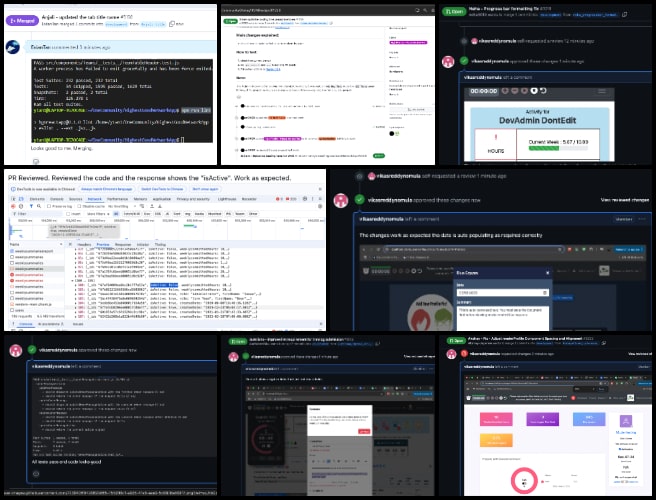
AND WE PRODUCED THIS WEEKLY UPDATES BLOG – CLICK HERE TO SUBSCRIBE
FOLLOW ONE COMMUNITY’S PROGRESS (click icons for our pages)
INVESTOR PAGES
GET INVOLVED
One Community Welcomes Manjiri Patil to the Engineering Team!
Posted on March 5, 2025 by One Community Hs
One Community welcomes Manjiri Patil to the Engineering Team as our newest Volunteer/Consultant!

Manjiri Patil is a skilled Mechanical Design Engineer with a strong background in mechanical design, quality control, and project execution. She is committed to creating innovative designs that prioritize both functionality and environmental sustainability. As a dedicated member of the One Community team, she has helped with quality checks for the vermiculture documentation and is now contributing to the City Center Hub Connector designs and testing.
WELCOME TO THE TEAM MANJIRI!
FOLLOW ONE COMMUNITY’S PROGRESS (click icons for our pages)
INVESTOR PAGES
GET INVOLVED
One Community Welcomes Rahul Trivedi to the Software Development Team!
Posted on March 5, 2025 by One Community Hs
One Community welcomes Rahul Trivedi to the Software Development Team as our newest Volunteer/Consultant!
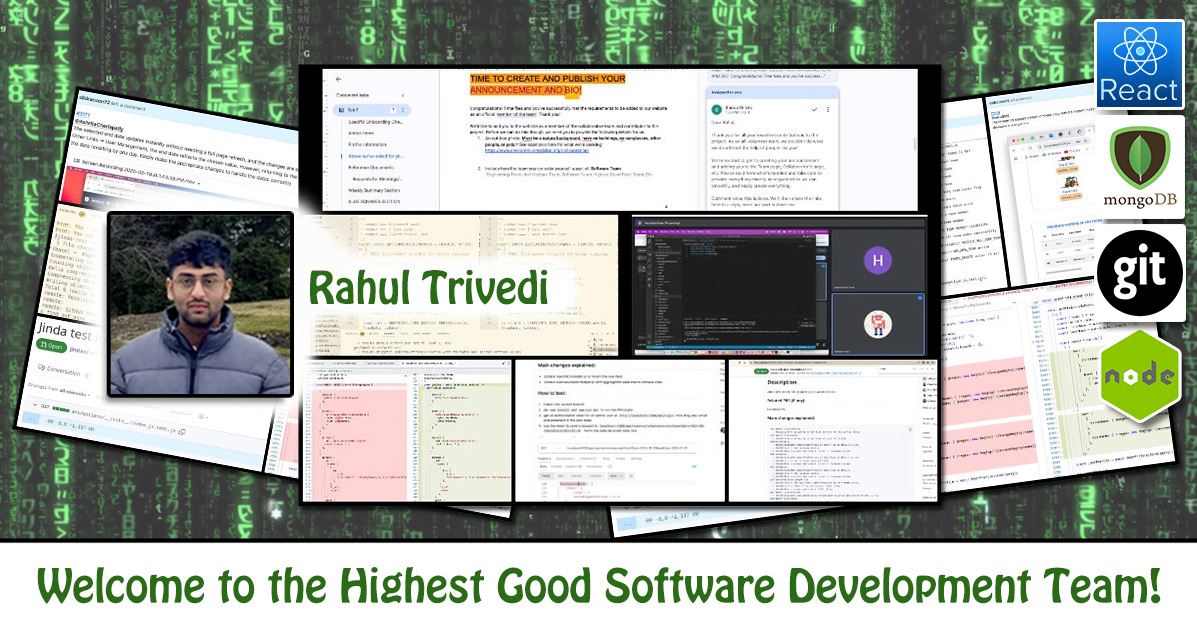
Rahul is a skilled Software Engineer with over three years of experience in full-stack development, specializing in the MERN stack, cloud computing, and scalable software solutions. He has extensive experience with React, Node.js, and both SQL and NoSQL databases, along with proficiency in various frameworks like .NET, Flask, Spring Boot and programming languages like Python, Java and Rust, enabling him to develop efficient and high-performing web applications. Passionate about innovation, he has developed advanced software solutions, including an AI-driven emotion-based music recommendation system, project management tools, and job-tracking applications, showcasing his ability to create impactful and user-centric technologies. With a strong foundation in software development, testing, and CI/CD automation, Rahul ensures the delivery of high-quality, maintainable code. Committed to continuous learning, he excels in problem-solving and cross-functional collaboration. As a software engineer at One Community, Rahul has contributed to feature development, code optimization, and bug resolution, enhancing the overall functionality and performance of the Highest Good Network software. His contributions include improving code quality, developing new features, and refining existing functionalities to ensure a seamless user experience.
WELCOME TO THE TEAM RAHUL!
FOLLOW ONE COMMUNITY’S PROGRESS (click icons for our pages)
INVESTOR PAGES
GET INVOLVED
Thanks for Your Contributions to Our Software Development Team Nazanin Hashemian!
Posted on March 5, 2025 by One Community Hs
One Community thanks Nazanin Hashemian for her contributions as a Volunteer/Consultant on the Software Development Team!
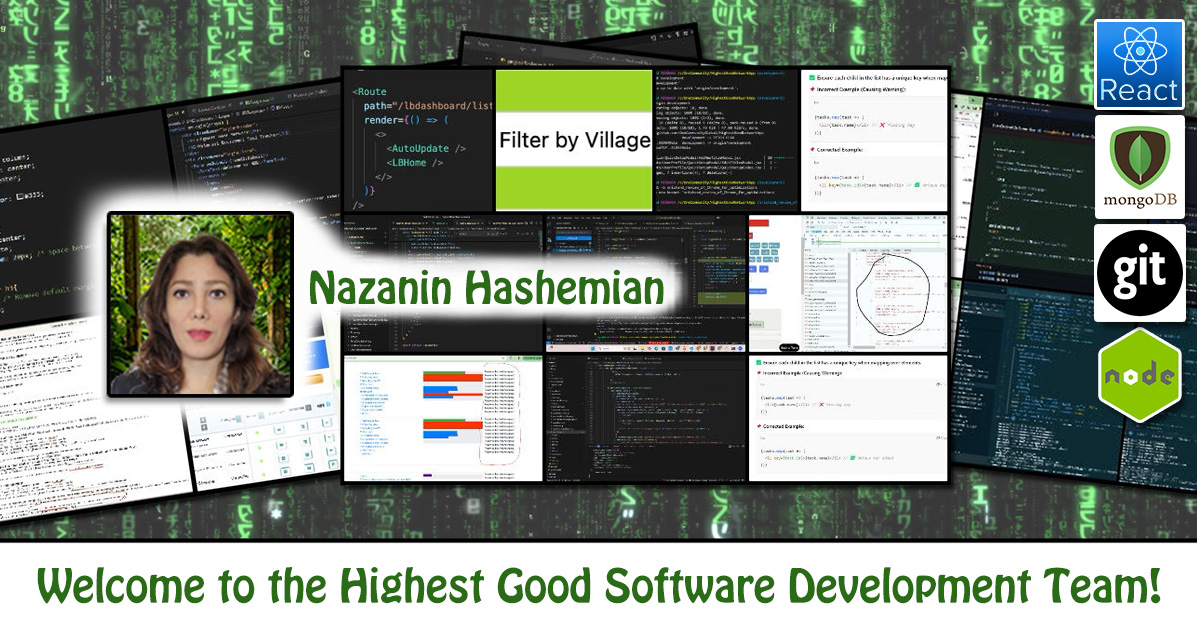
Nazanin is a passionate React/Front-End Developer with expertise in building intuitive, responsive web applications. With a strong focus on React.js and other front-end technologies, she consistently creates user-friendly interfaces and resolves complex technical challenges. Nazanin is driven by a continuous desire to learn and grow, always staying updated with the latest technologies and best practices. She thrives in collaborative environments and is committed to delivering high-quality solutions that make a positive impact. In her work with the One Community team as part of the Blue Steel team, Nazanin contributed to optimizing the task tracking system by updating the TaskButton.jsx components of Highest Good Network software platform, improving performance and status tracking through React, Redux, and various performance optimizations. She also utilized GitLens and Git Blame to facilitate collaboration and ensure real-time updates.
WELCOME TO THE TEAM NAZANIN!
FOLLOW ONE COMMUNITY’S PROGRESS (click icons for our pages)
INVESTOR PAGES
GET INVOLVED
One Community Welcomes Neha Reddy to the Software Development Team!
Posted on March 4, 2025 by One Community Hs
One Community welcomes Neha Reddy to the Software Team as our newest Volunteer/Consultant!

Neha holds a Master’s degree in Computer Science from George Mason University. She is a skilled software engineer with experience in full-stack development, specializing in JavaScript, TypeScript, React, Node.js, and MongoDB. She has a strong background in building scalable web applications, optimizing system performance, and enhancing user interfaces. As part of the Highest Good Network project at One Community, she contributes by conducting code reviews, resolving bugs, and improving dashboard functionality to enhance usability and efficiency. Leveraging her expertise in cloud technologies like Azure, RESTful APIs, and CI/CD pipelines, Neha is dedicated to developing high-quality, maintainable software solutions that drive user engagement and productivity.
WELCOME TO THE TEAM NEHA!
FOLLOW ONE COMMUNITY’S PROGRESS (click icons for our pages)
INVESTOR PAGES
GET INVOLVED
Solutioneering Global Sustainability Systems – One Community Weekly Progress Update #624
Posted on March 3, 2025 by One Community Hs
At One Community, we are solutioneering global sustainability systems to regenerate our planet and create a world that works for everyone. Our all-volunteer team is focused on sustainable approaches to food, energy, housing, education, economics, and social architecture. By open sourcing and free sharing the complete process, we aim to build a self-replicating model that inspires a global collaboration of teacher/demonstration hubs, all for “The Highest Good of All.” Together, we are evolving sustainability and cultivating global stewardship practices that promote fulfilled living and lasting positive change.
- Here’s our project overview
- Here’s our world-change methodology
- Here’s how this becomes self-replicating
- Here’s how we are open source and free-sharing all the do-it-yourself designs

OUR MAIN OPEN SOURCE HUBS
Click on each icon to be taken to the corresponding Highest Good hub page.
One Community’s physical location will forward this movement as the first of many self-replicating teacher/demonstration communities, villages, and cities to be built around the world. This is the March 3rd, 2025 edition (#624) of our weekly progress update detailing our team’s development and accomplishments:
Solutioneering Global Sustainability Systems
One Community Progress Update #624
DONATE | COLLABORATE | HELP WITH LARGE-SCALE FUNDING
CLICK HERE IF YOU’D LIKE TO RECEIVE AN EMAIL EACH WEEK WHEN WE RELEASE A NEW UPDATE
YOU CAN ALSO JOIN US THROUGH SOCIAL MEDIA
ONE COMMUNITY WEEKLY UPDATE DETAILS
HIGHEST GOOD HOUSING PROGRESS
 One Community is solutioneering global sustainability systems through Highest Good housing that is artistic and beautiful, more affordable, more space efficient, lasts longer, DIY buildable, and constructed with healthy and sustainable materials:
One Community is solutioneering global sustainability systems through Highest Good housing that is artistic and beautiful, more affordable, more space efficient, lasts longer, DIY buildable, and constructed with healthy and sustainable materials:
- Learn about: Our Upcoming Crowdfunding Campaign
- Learn about the different village models: 7 Sustainable Village Models
- Visit the open source portals for the first two: Earthbag Village OS Hub | Straw Bale Village OS Hub
This week, Adil Zulfiquar (Engineer) continued working on the Vermiculture Toilet engineering designs. Changes were made based on the review of the operating conditions report, including updates to the monitoring system context for vermiculture and adjustments to the procedure to reflect system operations. The layering criteria for vermicompost were reviewed and updated to address aeration and moisture issues, with additional steps outlined for managing extreme hot and cold conditions to prevent dormancy. New images were added for better representation. The Earthbag Village, the first of seven planned villages, serves as the initial housing component within One Community’s open source model for solutioneering global sustainability systems. See below for some of the pictures related to this work.
Anil Karathra (Mechanical Engineer) continued advancing the engineering and design of the Vermiculture Toilet for the Earthbag Village project. The weekly summary was completed, and screenshots of past work were uploaded to Dropbox. The knockdown access door design concept was finalized, and work continued on addressing structural issues in the vermiculture design. The weekly team meeting was led, where tasks were reviewed and assigned, and research on leakproofing and drains was formatted and uploaded to the collaboration documents. A new team member, Audrey, was onboarded through introductory calls and the setup of action items. Another introductory call was held with Rahul to provide a project overview, assign tasks, and begin research on the vermiculture toilet structure. This commitment to solutioneering global sustainability systems drives the development of innovative, eco-friendly solutions that balance environmental responsibility with high standards of functionality. See below for pictures related to this work.
Audrey Gunawan (Mechanical Engineer) started working on the Vermiculture Toilet engineering designs. Audrey was introduced to the vermiculture project and reviewed relevant documents, including a shared Google Doc and engineering decisions related to the assembly parts. She examined the CAD files for the vermiculture assembly, researched plumbing diagrams, and watched instructional videos on setting up plumbing systems in AutoCAD and SolidWorks. She referenced the Uniform Plumbing Code to determine appropriate pipe sizes and explored different configuration options. She created and adjusted several parts in SolidWorks to begin the assembly, developed a bill of materials, and created a drawing for the Unistrut assembly, assigning names and labels to the required parts. She also modified the existing assembly to accommodate the planned plumbing installation. As the first of seven planned villages, Earthbag Village provides the initial housing within One Community’s open source model for solutioneering global sustainability systems. See below for some of the pictures related to this work.
Charles Gooley (Web Designer) continued working on the Open Source DIY Dam Design for Water Retention, Pond and Lake Creation, etc. page. Charles updated the Open Source DIY Earth Dam Design & Construction for Water Retention, Pond & Lake Creation page. The updates included rewording, clarifications, and additions to the tables of contents. New content was added to the Dam Safety Incidents and Emergencies section, covering embankment overtopping, uncontrolled seepage, sinkholes in the reservoir, and slope failure. Dam Design is important for the Earthbag Village, a foundational part of One Community’s open-source model for solutioneering global sustainability systems. Take a look at some of the work in the images below.
Faeq Abu Alia (Architectural Engineer) continued his work on the Earthbag Village 4-dome home renders. Faeq refined the interior design, focusing on rooms, doors, materials, and interior planting to improve functionality, aesthetics, and cohesion. Adjustments were made to enhance spatial flow and maintain design consistency across different areas. The selection of materials was reviewed to align with the overall design approach, and work continued on integrating interior planting to complement the space and its intended use. The Earthbag Village is the first of 7 to be built as the housing component of One Community’s open source model for solutioneering global sustainability systems. View examples of this work in the pictures provided below.
Karthik Pillai (Mechanical Engineer) continued helping finish the Vermiculture Toilet engineering and helping with the Earthbag Village 4-dome home roof plan. He focused on the four-dome cluster roof design, ensuring that overall deflection remained under 0.5 inches. While this target was met, the design still requires further refinement before finalization. At Michaela’s request, he planned to revisit the feasibility of using hollow steel beams and I-sections as alternative structural elements. He began documenting his findings and converting them into a report. In the vermiculture toilet design project, he explored the possibility of using materials other than steel for Unistrut components, with the analysis still in the design phase and requiring additional FEA simulations to determine viability. Additionally, Karthik worked on a report outlining the waste dumping mechanism, compiling relevant findings and design considerations. As the first of seven planned villages, Earthbag Village provides the initial housing within One Community’s open source model for solutioneering global sustainability systems. See the work in the collage below.
Keerthi Reddy Gavinolla (Software Developer) continued working on the Vermiculture Toilet engineering designs. Keerthi updated Blog 623 and focused on web page design, working on the Create Vermiculture Transport Solution Webpage by adding content from the Vermiculture Transport Solution document to the website. Images were edited as needed and integrated into the webpage. Additionally, Keerthi worked on HGN Frontend Testing and Comment Review and Follow-up, tested PR 3031 and PR 3190, and confirmed that they were functioning as expected. One Community’s open source model for solutioneering global sustainability systems begins with Earthbag Village, the first of seven planned villages providing housing. See below for some of the pictures related to this work.
Rumi Shah (Civil Engineer) started working on the Earthbag Village project. Rumi organized the project’s drawings (DWGs) by creating a spreadsheet linking each drawing to its respective phase and project. The spreadsheet was structured with red markings to indicate areas containing notes. Specific drawings requiring further attention were identified, but additional work is needed to finalize the folders and assess what is missing or completed. Several folders and DWGs were repeated under different names, creating uncertainty about which drawings to prioritize. The DWGs were refined to highlight necessary tasks, and some empty boxes were noted as requiring additional details. One Community’s open source model for solutioneering global sustainability systems begins with Earthbag Village, the first of seven planned villages providing housing. See below for some of the pictures related to this work.
Vimarsh Acharya (Engineering Manager and Technical Reviewer) continued working on Highest Good Housing and other related work review and research. Vimarsh worked on three tasks. The first task involved naming and organizing files to improve clarity and accessibility. The second task was reviewing the final document for the Ultimate Classroom Project, checking for accuracy and completeness. The third task involved a detailed review of the Highest Good Food Procurement document from the beginning, identifying areas for improvement and adding necessary comments within the document. The One Community model, which combines forward-thinking education with sustainably built classrooms like this, is an excellent example of solutioneering global sustainability systems. See the collage below for his work.
Yi-Ju Lien (Environmental Engineer) continued her work on the Earthbag Village LEED points related to stormwater retention. Yi-Ju continued organizing the water-related design content and added material for the wastewater treatment section. She worked on the overview of the wastewater treatment system, introducing the decentralized system for properties without access to municipal sewer systems. She also addressed maintenance, regulations, and the septic system for the net-zero bathroom, along with options for connecting to the municipal system when available, highlighting the importance of maintaining collaboration and unity in solutioneering global sustainability systems. See some of the work done in the collage below.
DUPLICABLE CITY CENTER PROGRESS
 One Community is solutioneering global sustainability systems through a Duplicable and Sustainable City Center that is LEED Platinum certified/Sustainable, can feed 200 people at a time, provide laundry for over 300 people, is beautiful, spacious, and saves resources, money, and space:
One Community is solutioneering global sustainability systems through a Duplicable and Sustainable City Center that is LEED Platinum certified/Sustainable, can feed 200 people at a time, provide laundry for over 300 people, is beautiful, spacious, and saves resources, money, and space:
- Learn about this building and it’s function: Duplicable City Center Open Source Hub
Jason Bao (Architectural Designer) continued working on producing renders for the Duplicable City Center library. The messages from Jae were addressed, and requested fixes and additions were applied to the model. The renders were completed and uploaded to Dropbox. An attempt to merge existing files with other model files was made but halted due to excessive file size. Received files were broken down into smaller components to facilitate merging. The focus shifted to Maaz’s sundeck renders, where the updated exterior file was merged with the sundeck model. Lighting and rendering configurations were adjusted, test renders were produced, and the sundeck use case scenes were uploaded to Dropbox. The Duplicable City Center is a foundational part of One Community’s open-source model, which excels in solutioneering global sustainability systems. This approach is integral to their mission of solutioneering global sustainability systems through innovative and scalable solutions. See some of this work in the pictures below.
Mohammed Maaz Siddiqui (Architect) continued working on the cupola renders for the Duplicable City Center project. He worked on developing scenes in the top room, exploring various activities it could accommodate. Time was spent testing different uses before setting up a scene where the room functioned as a presentation space, with a presenter using a screen while an audience observed. Another scene was created where the room was used as a children’s play area. Within One Community’s open-source framework, the Duplicable City Center plays a central role in the mission of solutioneering global sustainability systems. The images below showcase some of this work.
Manjiri Patil (Mechanical Design Engineer) continued redesigning the connector to simplify the creation of 2D drawings. She divided the 3D drawing into specific parts to streamline the design process. Jae’s latest feedback was reviewed and implemented to ensure the design met all required specifications. Additionally, the struts of the dome structure were redesigned to enhance manufacturability and simplify on-site assembly. One Community’s open-source Duplicable City Center is a key part of solutioneering global sustainability systems. The images below showcase some of this work.
Nimika Devi (Architect) continued her contributions to the landscape design and development of the Duplicable City Center‘s urban farm. Her work involved sorting and organizing files to facilitate their transfer to the team. The process included categorizing documents, structuring folders, and ensuring that all necessary files were properly named and formatted. Renders were arranged according to project requirements, making them easily accessible for review and use. Any redundant or outdated files were identified and set aside to maintain efficiency. The file organization aimed to streamline workflow and improve coordination within the team. Within One Community’s open-source framework, the Duplicable City Center plays a central role in the mission of solutioneering global sustainability systems. The images below showcase some of this work.
Rudrani “Sravya” Mukkamala (Mechanical Engineer) continued researching the structural components of a hydraulic elevator, focusing on the framework, guide rails, and load-bearing elements. The focus was on applying DIY principles to the current project. After researching DIY models and analyzing their ideologies and real-time projects, key takeaways were incorporated into the design plan. A parts list was developed, including gathered details and sourcing information. Significant progress was made on another subsystem, with the sourcing process nearly completed for the listed parts. One Community’s open-source Duplicable City Center is a key part of solutioneering global sustainability systems. The images below showcase some of this work.
Sanket Basannavar (Mechanical Engineer) continued working on the Duplicable City Center spa cover as part of the City Center Natural Pool and Eco-spa Designs. A new design for a two-panel spa cover was created, with several iterations of different aluminum thicknesses and EPS core variations to reduce the weight of the cover. The R-value for each iteration was calculated to assess insulation performance. Additionally, a new square-shaped pool design was developed based on the previous pool design, and the pool and spa cover were assembled to verify if they fit together properly. Solutioneering global sustainability systems relies on open-source tools like One Community’s Duplicable City Center. The images below showcase some of this work.
Srujan Pandya (Mechanical Engineer) set up the model for the dome in Abaqus, defining materials such as structural steel for the frame and machined steel for the hub connectors. He assigned beam profiles, section assignments, and individually assigned over 600 parts, which required significant time. After completing the initial setup and applying the specified boundary conditions and loads, the computation failed, and the software crashed multiple times. He adjusted the mesh by experimenting with global mesh sizes, local mesh controls, and creating a uniform hex mesh across the frame parts. The Abaqus license’s node limit of 250,000 was exceeded with a finer mesh, leading to further crashes. A coarser mesh was applied within the node limit, but the software remained unresponsive. Srujan met with Rachan to discuss the issues and reviewed chapters from Robert Norton’s Machine Design to improve the handling of the FEA model and meshing. He also watched YouTube videos on beam assignments for structural analysis. Within One Community’s open-source framework, the Duplicable City Center plays a central role in the mission of solutioneering global sustainability systems. The images below showcase some of this work.
Yan “Jenni” Zu (Architectural Designer) continued her work on the greenhouse area of the Duplicable City Center. She completed all greenhouse work, including using Photoshop to adjust the tones of the interior and exterior renders and refining image details. She rendered the final high-definition animations for both the greenhouse interior and exterior, ensuring high-quality visual output. Every aspect of the greenhouse project was reviewed and finalized, making necessary adjustments to lighting, textures, and composition. The final renders and animations accurately represent the intended design with enhanced realism. Solutioneering global sustainability systems relies on open-source tools like One Community’s Duplicable City Center. The images below showcase some of this work.
HIGHEST GOOD FOOD PROGRESS
 One Community is solutioneering global sustainability systems through Highest Good food that is more diverse, more nutritious, locally grown and sustainable, and part of our open source botanical garden model to support and share bio-diversity:
One Community is solutioneering global sustainability systems through Highest Good food that is more diverse, more nutritious, locally grown and sustainable, and part of our open source botanical garden model to support and share bio-diversity:
- Learn about the structures: Hoop House Hub | Aquapini & Walipini Open Source Hub
- See what we’ll be growing: Gardens & Hoop Houses | Large-scale Structures | Food Forest | TA
This week, the core team finalized all descriptions for the Master Tools, Equipment, and Materials/Supplies list and continued enhancing the document with specific tools required for each project designation. Their focus remained on the Earthbag, Aquipini/Walipini, Goat, Chick, and Rabbit projects. Tools added to these project designations included C-clamps, bar clamps, wire cutters, fish tape, duct tape, painter’s tape, and garden forks. The Highest Good Food initiative is a key component of One Community’s open source plans, focused on solutioneering global sustainability systems, and exemplifies the organization’s commitment through innovative design and implementation. Below are some of the images showcasing this work.
Chelsea Mariah Stellmach (Project Manager) began working on improving the Master Recipe Template for the 3-Day Blocks spreadsheet, the related tutorial, and the Food Self-sufficiency Transition Plan website. She reviewed the food self-sufficiency transition plan, identifying areas for improvement in wording, flow, and details. She met with Jessica to discuss the Master Recipe Template for the 3-Day Blocks spreadsheet and provided key suggestions for enhancing the functionality in the users’ copies. Additionally, she added more detailed explanations for the spreadsheet tabs, including VnOMultipliers and MasterFoodCosts. One Community’s open source Highest Good Food initiative designs and implements innovative solutions as part of our global sustainability systems. Below are some of the images showcasing this work.
Jay Nair (BIM Designer) continued working on Aquapini and Walipini Planting and Harvesting lighting and HVAC design. He held a call with a team member to discuss the lighting requirements and energy calculations for Walipini 1, addressing factors such as light intensity, energy consumption, and system efficiency. Additionally, Jay worked on formatting the document to align with website standards and making adjustments to the layout, headings, and text structure to ensure consistency and readability. Solutioneering global sustainability systems, One Community’s Highest Good Food initiative provides open source designs and implements innovative food systems. Below are some of the images showcasing this work.
Jessica Fairbanks (Administrative Assistant) reviewed the work of a fellow admin and provided detailed feedback for improvements. She set up a meeting with Chelsea to introduce her to the Highest Good Food menu implementation project and presented the progress made so far. In addition, Jessica scheduled and completed an interview with a potential new volunteer. She also reviewed Jae’s final feedback on her project related to the integration of Highest Good Food into small-scale organizations and began making necessary improvements. The Highest Good Food initiative is a key component of One Community’s open source plans, focused on solutioneering global sustainability systems, and exemplifies the organization’s commitment through innovative design and implementation. Her contributions are highlighted in the collage below.
Mary Nelson (Landscape Planner) worked on her One Community profile biography. She completed the soil amendment strategy and the Botanical Garden tutorial and then submitted her work for review. Mary also began a write-up on meadow gardens and their role in supporting pollinators and beneficial insect habitats. One Community’s open source Highest Good Food initiative designs and implements innovative solutions as part of our global sustainability systems. Her contributions are highlighted in the collage below.
Pallavi Deshmukh (Data Analyst) continued reviewing team member’s work and incorporated their contributions to ensure completeness. She also held three interviews, and details were reported accordingly. Work continued on web page design, integrating Chris’s GIS content into the permaculture page using the web design tutorial. Two pull requests, 3031 and 3190, were tested and appeared to be functioning as expected. One suggestion was noted for 3031, and a comment was added accordingly. Solutioneering global sustainability systems, One Community’s Highest Good Food initiative provides open source designs and implements innovative food systems. Her contributions are highlighted in the collage below.
Tanmay Koparde (Industrial Engineer And Team Administrator) continued optimizing Food Procurement and storage to enhance efficiency and sustainability. He focused on sourcing from both local suppliers and large-scale distributors while implementing improved storage practices to maintain freshness and minimize waste. Additionally, he performed calculations for storage and procurement to ensure cost-effectiveness and efficiency and later enhanced the document by adding pictures and tables to make it more informative and understandable. The Highest Good Food Initiative is a key component of One Community’s open source plans, focused on solutioneering global sustainability systems, and exemplifies the organization’s commitment through innovative design and implementation. See his work in the collage below.
Vatsal Tapiawala (Mechanical Engineer) continued working on Aquapini/Walipinis structures. He worked on the copper destratification pipe for the truly passive greenhouse project. He designed the pipes in Revit and exported the model to ANSYS for analysis. He verified the model, identified errors, and made necessary corrections. Additionally, Vatsal reviewed the feedback on the earthen roof report to assess the required modifications. One Community’s open source Highest Good Food initiative designs and implements innovative solutions as part of our global sustainability systems. See his work in the collage below.
HIGHEST GOOD ENERGY PROGRESS
 One Community is solutioneering global sustainability systems through Highest Good energy that is more sustainable, resilient, supports self-sufficiency and includes solar, wind, hydro and more:
One Community is solutioneering global sustainability systems through Highest Good energy that is more sustainable, resilient, supports self-sufficiency and includes solar, wind, hydro and more:
- Learn about the open source sustainable-energy foundations: Solar, Hydro, and Wind
- Explore our research into the most sustainable products and companies for saving water and energy: Insulation, Eco-laundry, Lightbulbs and Light Bulb Companies, Doors and Door Companies, Windows and Window Companies, Toilets, Faucets and Faucet Accessories, Urinals, and more.
This week, Dishita Jain (Data Analyst And Team Administrator) continued addressing multiple assignments within the Highest Good Energy and OC Administration projects. She focused on the Energy Infrastructure Cost Analysis and visualization project for Highest Good Energy. She updated the Excel sheet with cost analysis data, continued work on the solar infrastructure cost estimates, and incorporated these into another Excel sheet pending review. In an effort to deepen her understanding, Dishita analyzed various Excel sheets related to energy cost analysis and viewed instructional videos. She also researched solar infrastructure costs by visiting relevant websites, which aided in refining the accuracy of her cost analyses. Additionally, she created visualizations for energy and roadway infrastructure cost analysis, documenting her findings. Parallel to this, she engaged in administrative tasks for OC Administration, providing and integrating feedback and summarizing team reviews on an internal platform. The Highest Good Energy initiative is a key component of One Community’s open source plans, focused on solutioneering global sustainability systems, and exemplifies the organization’s commitment through innovative design and implementation. Below are some of the images showcasing this work.
Muhammad Sarmad Tariq (Electrical Engineer) started compiling the methodology for calculating profit and net savings for an off-grid and a grid-tied solar PV system using the Excel sheet format. The Excel sheet format is supposed to calculate the outputs automatically with the user only entering the inputs. This required work on entering formulas within the Excel sheet and ensuring the correct units for each metric involved in the calculations. This also involves describing the calculations so that the user is able to follow through with the calculations. The Highest Good Energy initiative is a key component of One Community’s open-source plans, focused on solutioneering global sustainability systems, and exemplifies the organization’s commitment through innovative design and implementation. See his work in the collage below.
HIGHEST GOOD EDUCATION PROGRESS
 One Community is solutioneering global sustainability systems through Highest Good education that is for all ages, applicable in any environment, adaptable to individual needs, far exceeds traditional education standards, and more fun for both the teachers and the students. This component of One Community is about 95% complete with only the Open Source School Licensing and Ultimate Classroom construction and assembly details remaining to be finished. With over 8 years of work invested in the process, the sections below are all complete until we move onto the property and continue the development and open sourcing process with teachers and students – a development process that is built directly into the structure of the education program and everything else we’re creating too:
One Community is solutioneering global sustainability systems through Highest Good education that is for all ages, applicable in any environment, adaptable to individual needs, far exceeds traditional education standards, and more fun for both the teachers and the students. This component of One Community is about 95% complete with only the Open Source School Licensing and Ultimate Classroom construction and assembly details remaining to be finished. With over 8 years of work invested in the process, the sections below are all complete until we move onto the property and continue the development and open sourcing process with teachers and students – a development process that is built directly into the structure of the education program and everything else we’re creating too:
- Program Overview: Education Open Source Hub
- How the components work together in designing human orchestrated eco-abundance: How to use the Education for Life Program
- Lesson Plans for Life – Lesson Plans How-to
- Foundations of Outstanding Leaders, Teachers, and Communicators
- Curriculum for Life
- Teaching Strategies for Life
- Learning Tools and Toys for Life
- Evaluation and Evolution
This week, Bhavya Prakash (Software Engineer) continued her work on the Figma designs for the Highest Good Network software, where she held a Slack call with Harshitha and Mrinalini to clarify requirements and made the necessary design changes. Updates were made to the Figma designs based on the revised requirements from the document. Research was done on ideas for the student dashboard, leading to new design concepts. A progress page was added using molecular design elements, and additional work was completed on the student dashboard, including designs for the home page and lesson plans. The One Community model of solutioneering global sustainability systems with sustainably built classrooms like this is an excellent example of sustainable change for the whole planet. See the collage below for her work.
Harshitha Rayapati (Program Manager) continued work on defining components with Bhavya and Mrinalini, delegating tasks, and refining project deliverables. Jae’s feedback was reviewed, with comments left for clarification and requests for additional resources. Feedback was provided to Mrinalini on the design of student portal features, and adjustments were made to deliverables. Figmas were created for student profile, education molecules, and student progress. Work continued on detailing deliverables, combining outlines of components from various phases and refining the visual layout of pages. Components and views interacting with various pages, including student, teacher, and learner support teams, were detailed. Additionally, the weekly blog update and collage for the Graphic Design Team were completed. Blog portions of other members were also reviewed. The One Community model of solutioneering global sustainability systems with sustainably built classrooms like this is an excellent example of sustainable change for the whole planet. See the collage below for her work.
Mrinalini Raghavendran (Software Engineer) continued working on researching and defining requirements for the Highest Good education software student dashboard. This week, she incorporated feedback from Jae’s previous video to refine requirements and updated the existing document. She reviewed Figma files provided by a teammate and noted corrections for further discussion. After team discussions, she restructured the document and continued reviewing feedback from Jae and teammates, making necessary modifications. Mrinalini worked on drafting and refining the document, addressing comments and ensuring all required changes were captured. She also reviewed feedback videos and comments to compile a list of necessary modifications. Additional adjustments were made based on feedback, including local changes and incorporating further input from teammates. By solutioneering global sustainability systems with classrooms like this, One Community provides a replicable example for global sustainable development. See the collage below for her work.
HIGHEST GOOD SOCIETY PROGRESS
 One Community is solutioneering global sustainability systems through a Highest Good society approach to living that is founded on fulfilled living, the study of meeting human needs, Community, and making a difference in the world:
One Community is solutioneering global sustainability systems through a Highest Good society approach to living that is founded on fulfilled living, the study of meeting human needs, Community, and making a difference in the world:
- Read the Highest Good society overview: Highest Good Society
- Learn about the model for fulfilled living and sharing: A Day in the Life
- Learn about the 4 economic models: RBE | For-profit | Non-profit | Entrepreneurship
- Learn about our open source community collaboration and management software: The Highest Good Network
This week, the core team completed over 55 hours managing One Community’s volunteer-work review not included above, emails, social media accounts, web development, new bug identification and bug-fix integration for the Highest Good Network software, and interviewing and getting set up new volunteer team members. They also shot and incorporated the video above that talks about solutioneering global sustainability systems and how solutioneering global sustainability systems are a foundation of the bigger picture of everything One Community is doing. The image below shows some of this work.
Anoushka Hazari (Data Analyst) continued working on code to automate and simplify the Highest Good Network software promotion process. She reviewed pull requests and updated the PR review table. New members joined the team. She wrote a blog, designed a collage to complement it, and corrected a previous error in the blog for accuracy. She updated the HGN spreadsheet and reviewed work listed in sheet 4, including a peer’s blog. She watched a Loom video created by Jae and analyzed his feedback on the PR dashboard to identify areas for improvement. Adjustments were made to enhance functionality, usability, and filter alignment in the Tableau dashboard based on his suggestions. Anoushka also updated the weekly PR, promotion eligibility, and PR number status while working on three other sheets to ensure consistency with the intended analysis. This work helps One Community’s mission of solutioneering global sustainability systems and reinforces our commitment to solutioneering global sustainability systems. The following images show her work for the week.
Chitra Siddharthan (Data Analyst and Team Administrator) continued focusing on the existing web pages of the Highest Good Network Phase II website. This week, she updated the weekly summary, Dropbox files, and blog for team Code Crafters for week 623, along with reviewing the work of Himanshu and Vishnu. Progress was made on the “Adding Inventory Types: Edit” task, assisting Ashrita with a Phase 2 task via Slack, and working on the user manual. A newly raised PR related to Phase 2 was marked as high priority. While testing PRs, various errors and connectivity issues were encountered and addressed. PRs related to Inventory and the Lesson List in Phase 2 WBS were reviewed, along with updates to the user manual. Action items for the Phase 2 dashboard were updated, and Figma wireframes were reviewed. Based on Jae’s input, minor changes were made to the Phase 2 Data Analytics wireframe, and work continued on related elements. Action items for the Phase 2 Data Analytics wireframe were also reviewed to ensure they could be incorporated into Phase 2. This work helps One Community’s mission of solutioneering global sustainability systems and reinforces our commitment to solutioneering global sustainability systems. The following images show her work for the week.
Feras Rehman (Data Analyst) continued working on developing One Community’s Mastodon account and strategy. He scheduled five Mastodon posts on Buffer for the following week. Targeted strategies were used, leading to a 5x increase in post reach through optimized hashtag usage and improved post structuring. Additionally, four more Mastodon posts were scheduled on Buffer. A weekly summary review was done, and images were added to supplement the summary. This work helps One Community’s mission of solutioneering global sustainability systems and reinforces our commitment to solutioneering global sustainability systems. The following images show his work for the week.
Govind Sajithkumar (Project Manager) started working on social media posting, analytics, and strategy evolution for the Meta (Facebook and Instagram) platforms. He worked on Meta (Facebook & Instagram) Analytics Reporting and Tracking. Issues in the Facebook and Instagram Analytics Dashboard sheets were addressed to ensure engagement metrics aligned with specified date ranges. Month-wise Facebook analytics data was extracted, cleaned, and visualized through four charts. Facebook and Instagram posts were scheduled and updated for the following weeks, maintaining a minimum of six posts per day, with adjustments made to post timings to match requirements. The Meta Analytics Report & Tracking Sheet was updated with historical Facebook data from 2021 to 2023, and table and chart queries were modified for dynamic date selection. The Facebook tracking sheet was automated to capture the last update date, and scheduled post tracking graphs were adjusted to accept dates beyond 2024. PR Review Team Management was also completed, including feedback and updates to tracking sheets. This work helps One Community’s mission of solutioneering global sustainability systems and reinforces our commitment to solutioneering global sustainability systems. The following images show her work for the week.
Hritvik Mahajan(Data Analyst) continued focusing on multiple tasks related to marketing, promotion, software development, social media strategy, and administrative activities. As part of the marketing and promotion tasks, He worked on marketing and promotion tasks by posting and reposting content on Twitter communities as part of the daily posting strategy, while updating the Google Sheet discussed during a meeting. Hritvik explored additional ways to increase engagement. For software development, he reviewed pull requests, identified new bugs, and followed up with team members on Slack regarding changes and merge conflicts. He continued refining the HGN Social Media Scheduler design on Figma. Additionally, he provided feedback and comments on the Step 4 Document for Blog #623 related to the admin team’s work. This work helps One Community’s mission of solutioneering global sustainability systems and reinforces our commitment to solutioneering global sustainability systems. The following images show his work for the week.
Jaiwanth Reddy Adavalli (Project Manager) worked on multiple projects, completing PR admin team training and orientation. He managed the development of Phase 2 of the HGN dashboard. He created wireframes for two new webpages and finalized the structure of the Home Page. All existing wireframes were updated. Jaiwanth identified and outlined the required tasks, breaking them down into clearly defined action items for the software team. A site map was also created for the whole application. As part of the PR review team, he reviewed the pull requests of assigned volunteers and updated the required review documents. This work helps One Community’s mission of solutioneering global sustainability systems and reinforces our commitment to solutioneering global sustainability systems. The following images show his work for the week.
Raghav Dinesh Pamuru (Product Manager) continued focusing on designing and building a Google Sheets dashboard to simplify tracking and analyzing social media engagement, integrating data from multiple sources. He managed and coordinated a team of 7 data analysts, utilizing a Google Sheets dashboard to track and manage social media engagement processes across seven platforms. Raghav oversaw the implementation of social media strategies, reaching a combined audience and analyzed key performance metrics, identifying trends that led to a significant increase in conversions. This work helps One Community’s mission of solutioneering global sustainability systems and reinforces our commitment to solutioneering global sustainability systems. The following images show his work for the week.
Rahul Bavanandan (Data Analyst) continued working on several key projects within the Highest Good Network software, One Community’s Reddit presence, and administration. He engaged on Reddit, participating in various subreddits to build platform presence, and updated the Social Media Tracking Google Sheet related to Reddit marketing strategy. He worked on the HGN Phase 2 Evolution project Figma visualizations, implementing updates based on Jae’s feedback. Additionally, Rahul accessed the blog from the Defining Our Avatar page, verified the version number, and applied RankMath Tutorial for advanced SEO integration. He completed the Weekly Content Administrator tasks, merging administrator blogs into the main blog, generating a PDF of the complete page, and noting areas needing justification before content transfer. This work helps One Community’s mission of solutioneering global sustainability systems and reinforces our commitment to solutioneering global sustainability systems. The following images show his work for the week.
Yash Shah (Data Analyst and Team Administrator) continued his admin work and managed the social architecture component of the Highest Good Network software. He assigned a new task to Software developers and provided comments and feedback on queries related to the Phase 3 document. Responses were given to comments on the Phase 3 document, along with assigning new tasks and extending deadlines for volunteers facing issues that prevented timely completion. The version history of the document was updated after noticing that it appeared blank when accessed. Additionally, Yash created a blog for Dev Dynasty, organized the weekly folder, designed a collage, and provided feedback on fellow volunteers’ blogs. This work helps One Community’s mission of solutioneering global sustainability systems and reinforces our commitment to solutioneering global sustainability systems. The following images show his work for the week.
Zuqi Li (Administrative Assistant and Economic Analyst) continued managing One Community’s LinkedIn page. She explored LinkedIn Analytics documentation, analyzed dashboards to monitor project progress, updated key metrics, and refreshed dashboards for better tracking. Additionally, she flagged LinkedIn messages for Jae to respond to, reviewed post-editing documentation, and outlined content plans for the upcoming week. Zuqi also collaborated with Pershka to enhance LinkedIn Analytics processes and scheduled daily LinkedIn posts to improve engagement. Furthermore, she identified areas for optimization in tracking performance metrics and ensured that content strategies aligned with engagement goals. This work helps One Community’s mission of solutioneering global sustainability systems and reinforces our commitment to solutioneering global sustainability systems. The following images show her work for the week.
ADMINISTRATION TEAM
The Administration Team summary, covering their work administrating and managing most of One Community’s ongoing process for solutioneering global sustainability systems was managed by Mimansha Kaushik (Data Analyst Team Administrator) and includes Himanshu Mandloi (Engineering Project Manager), Jibin Joby (Data Analyst), Kishan Sivakumar (Administrative Assistant and Software Team Manager), Olawunmi “Ola” Ijisesan (Administrative and Management Support), Preksha Welankiwar (Digital Marketing Manager), Rachna Malav (Data Analyst), Ratna Meena Shivakumar (Data Analyst and Admin), Ryutaro Wongso (Economic Analyst and Team Administrator), Saumit Chinchkhandi (Administrative Assistant and Software Engineer), Shrinivas Patil (Software Engineer), Sneka Vetriappan (Data Analyst), Vikas Pande (Software Administrator) and Vishnu Murali (Data Analyst). The Highest Good Network software is how we’ll be managing and objectively measuring our process for solutioneering global sustainability systems through our social architecture, construction, production, and maintenance processes.
This week, the Administration team collectively worked on a variety of tasks. Himanshu focused on the OC Administration tasks, such as completing the daily time log review process and managing team member tasks. He also reviewed and commented on time logs and documented feedback. He demonstrated a proclivity for pragmatic problem-solving, a nascent form of solutioneering global sustainability systems, as he addressed the immediate operational challenges. Jibin reviewed the housing team’s work, updated the assigned page, created collages, and provided feedback for improvements. He worked with Vishnu on extracting data from BlueSky and increasing follower count. Kishan performed senior admin duties, reviewed SEO pages, and worked on new admin tasks. Mimansha interviewed a volunteer, updated the hiring workbook, and reviewed Google Analytics and SEO strategy. Ola followed up with new trainees, managed PR reviews, updated document filing, and scheduled Pinterest posts. She pursued a multifaceted approach, integrating administrative tasks with strategic outreach, a necessary component of solutioneering global sustainability systems.
Preksha worked on building an online community, interviewed candidates, and handled her admin duties. Rachna, with a slower pace, focused on reviewing SEO pages and staying updated on emails. A fundamental component of their operational strategy involved solutioneering global sustainability systems to ameliorate organizational impact. Ratna prepared summaries, scheduled posts, and continued working on social media dashboards. Ryutaro refined the city center cost analysis, reviewed the Binary Brigade dev team’s work, and designed a team collage. Saumit managed pull request workflows, provided frontend testing, and updated the WordPress page. Shrinivas worked on blog 621, assisted with admin feedback, and continued research on time use datasets. Sneka reviewed AI Music tasks and managed the timelog review process. Vikas worked on admin tasks, scheduled interviews, and reviewed documents related to hiring and training. Vishnu extracted data from BlueSky, updated Google Sheets, and increased the follower count while working on the Master Dashboard with Raghav. See the Highest Good Society and the Highest Good Network pages to learn more on how their work contributes to solutioneering global sustainability systems. See below to view images of their work.
GRAPHIC DESIGN TEAM
The Graphic Design Team’s summary was managed by Harshitha Rayapati (Program Manager) and includes Aurora Juang (Graphic Designer), Jaime Yao (Creative Technologist), and Junyuan Liu (Graphic Designer, UI/UX Designer), covering their work on graphic designs for solutioneering global sustainability systems. This week, Aurora created additional icons for the vermiculture toilets and designed new chapter icons for the website. She finalized social media campaign images and submitted them for Jae’s approval. She worked on social media content creation, including publishing new volunteer bios, revising errors, ensuring accuracy, and drafting bio announcements.
Jaime’s creation of volunteer announcement pages for Manjiri and Rahul, coupled with the development of social media visuals centered on reimagining global warming as a catalyst for collaborative innovation, demonstrated a profound engagement with, and practical application of, solutioneering global sustainability systems. The conceptualization of “Oasis Stations,” featuring “Solar-Powered Desert Oasis,” “Floating Oasis Hub,” and “Desert Rebirth,” alongside “Floating Ice Factories” with “Ice Harvesters in Action,” illustrated a tangible approach to addressing environmental challenges. These projects focused on visualizing technological solutions to environmental challenges. Junyuan worked on social media content by collecting images and exploring design options in design software. Three new social media images were completed, and initial steps were taken to source images and develop design concepts for the next piece. Additionally, he created a volunteer bio, designed images, and edited information on a web page. See the Highest Good Society pages for more on how this contributes to solutioneering global sustainability systems. See the collage below to view some of their work.
HIGHEST GOOD NETWORK PROGRESS
 One Community is solutioneering global sustainability systems through open source Highest Good Network® software that is a web-based application for collaboration, time tracking, and objective data collection. The purpose of the Highest Good Network is to provide software for internal operations and external cooperation. It is being designed for global use in support of the different countries and communities replicating the One Community sustainable village models and related components.
One Community is solutioneering global sustainability systems through open source Highest Good Network® software that is a web-based application for collaboration, time tracking, and objective data collection. The purpose of the Highest Good Network is to provide software for internal operations and external cooperation. It is being designed for global use in support of the different countries and communities replicating the One Community sustainable village models and related components.
- Learn about our open source community collaboration and management software: The Highest Good Network
This week, the core team continued their work on the Highest Good Network PR testing and confirmed fixes for multiple issues, including auto-refreshing user deletions without losing filters (#3028), improvements in team code input (#2621), UI fixes in the header (#3050), WBS button alignment (#3096), CSS conflicts between the Projects page and Auth components (#3098), and resolving a blank page issue affecting some accounts (#3100). Additional fixes included the visibility of the “Generate Summary Intro” button (#3097), overlapping dropdown menus (#3061), title column adjustments (#2986), and preventing a blank screen after deleting a WBS task (#3104). Issues that remain unresolved include the removal of project members from the Projects > Members page (#2862) and creating a new team member (#3082). Tasks were assigned to six team members. A video call was held with Rishitha Mamidala to address an error when adding a new account, resolving the team code requirement for creating new users (PR #2845). Communication also took place with Vivek Sharma on Slack regarding the test case task for “timeEntryController”. These improvements represent incremental steps towards the realization of solutioneering global sustainability systems. See the Highest Good Society and Highest Good Network pages for more on how this relates to solutioneering global sustainability systems. The collage below shows some of their work.
ALPHA SOFTWARE DEVELOPMENT TEAM
This week, the Alpha Team’s summary, covering their work on the Highest Good Network software, was managed by Lin Khant Htel (Frontend Software Developer) and the team includes Eve Ye (Volunteer Software Engineer Intern), Jiaqi Nie (Software Engineer), Sheetal Mangate (Software Engineer), Sujith Reddy Sudini (Full-Stack Software Developer), Rupa Rajesh Bhatia (Software Engineer), and Vinay Vallabineni (Software Engineer).
Lin reviewed and approved PR #3175, tested the codebase locally with all test cases passing as expected, and continued learning about the project. He reached out to team members for consultation and reviewed the weekly summaries, photos, and videos submitted by Alpha team members. This analytical approach, coupled with a proactive engagement in team activities, underscores the importance of a holistic understanding in solutioneering global sustainability systems. He also handled Alpha Team management duties, including task assignments and oversight. Jiaqi submitted the pull request to optimize the application on Safari and worked on a new task involving the backend development for the LB Dashboard Bid Overview page. Time was spent resolving conflicts with the development branch and revising the description of the pull request. For the new task, the data schema was completed, and work on the controller is planned for Saturday for solutioneering global sustainability systems.
Sheetal continued working on the ‘Development for Re-Engagement Strategies’ task from HGN Phase III. She worked on email sending functionality for mock data using mock data file. Additionally, she focused on the email functionality, bulk email sending functionality and she is started checking front end design to display now show rate tracking model pop up. She approached the system integration challenges with a pragmatic perspective, aiming to improve user re-engagement through the application of solutioneering global sustainability systems. Sujith worked on the front-end development for the activity comments section, focusing on implementing the design as outlined in the wireframe. He progressed on creating a user-friendly interface for the comments and FAQ sections under each event at the specified URL, ensuring alignment with project requirements and design standards. A holistic approach to user interface design, as demonstrated by Sujith, represents a micro-level application of solutioneering global sustainability systems.
Rupa enhanced the multi-step form project by refining its responsiveness across different devices while maintaining a consistent design through modular principles and customized visual elements. She integrated interactive components such as sliders, custom input fields, and toggle switches, efficiently managing them with dynamic state handling. This project illustrates the application of design acumen to practical digital interfaces, a microcosm of the broader effort to effect solutioneering global sustainability systems. Additionally, she optimized navigation for smooth transitions while preserving user data and implemented real-time validation to ensure data accuracy. Rupa also introduced unique features, including digital signatures and user preferences. As part of her managerial training, she analyzed workflows and reviewed Lin’s project to strengthen her skills. She collaborated with Jiaqi, Vinay, Sujith , and Sheetal to refine project summaries and enhance overall functionality. Vinay worked on the remaining part of the permission management log issue, resolving the permission key to an actual label to improve user understanding. Additionally, work began on the Bluesquare issue, which required a page refresh when editing a recent entry. This issue was fixed, and pull requests were submitted for both the frontend and backend changes to ensure that solutioneering global sustainability systems is maintained. See below for some of the team’s work.
BINARY BRIGADE DEVELOPMENT TEAM
The Binary Brigade Team’s summary overseeing advancements in the Highest Good Network software was managed by Vijay Anand Pandian (Full Stack Software Engineer) and includes Aaryaneil Nimbalkar (Software Developer), Anirudh Sampath Kumar (Software Developer), Aureliano Maximus (Volunteer Software Engineer), Deepthi Kannan (Software Engineer), Geeta Matkar (Software Engineer), Jaissica Hora (Software Engineer), Sabitha Nazareth (Software Engineer), Sriram Seelamneni (Software Engineer), and Sunil Kotte (Full Stack Developer). The Highest Good Network software is how we’ll be managing and objectively measuring our progress in solutioneering global sustainability systems through our social architecture, construction, production, and maintenance processes.
This week, Aaryaneil rewrote tests for previous pull requests to align with recent code changes, contributing to the broader effort of solutioneering global sustainability systems through robust software validation. Updates were made to the unit tests for the Volunteering Time tab component, including creating new tests and fixing existing ones. Issues with older test cases for the Volunteering Time tab component were resolved, and the code was updated accordingly. Unit tests for the all-time entries reducer component were fixed to address merge conflicts, and new test cases were added to improve test coverage.
Anirudh worked on multiple bugs, reviewing the code and previous pull requests to understand the issues before making changes and testing solutions, ensuring a strong foundation for solutioneering global sustainability systems in software efficiency. He identified that PR 2482 requires a new developer to fix failing unit tests that are unrelated to the PR changes, as similar failures exist in the development branch. He also worked on implementing a title search option for both the frontend and backend, making initial changes but identifying additional issues that still need to be addressed.
Aureliano reviewed developer and team manager responsibilities and started a new local branch to fix the formatting of the “Hours” section in task editing, a refinement essential for solutioneering global sustainability systems in project management. He researched RegEx functionalities to disallow localhost addresses using HTTP and to allow Dropbox links only if they come from the share link functionality, utilizing AI tools for RegEx creation. He refined the RegEx to ensure that any link starting with “https://” is accepted while blocking links containing “dropbox.com/home.” He reviewed and corrected formatting issues in the hours section and aligned the status of EditTaskModal and AddTaskModal. He also identified an issue where the Worst-Case hours input in EditTaskModal expanded more than other hour sections and resolved it by assigning a default value when the Best-Hour value is empty.
Deepthi found a new bug where the dropdown in the Team Member Tasks section was being covered by the “Taking Time-Off Content” overlay on screens above 768px due to CSS z-index and positioning conflicts, an issue affecting solutioneering global sustainability systems in UI accessibility. She adjusted the layering and positioning to fix the issue. She also made changes to the weekly summaries bug documented in the bugs document, adding further details and inclusions. Geeta worked on the header task and plans to raise the pull request once completed, ensuring consistency in solutioneering global sustainability systems across design elements. She focused on the blue square system indication task, collaborating with the owner profile to add the blue square so it automatically includes in the “Assigned by” format. She encountered a few console errors related to this task but has resolved them.
Jessica worked on improving the infringement system by introducing a structured approach for storing and retrieving specific reasons associated with a blue square, aligning with solutioneering global sustainability systems in policy enforcement. Previously, the system only stored the issuance date and a long string sent in the email, making it difficult to query specific reasons. To address this, she introduced a new field to store an array of reasons, including “Time not met,” “Missing summary,” “Missing pictures,” “Missed scheduled call,” and “Edited time entries.” She implemented both frontend and backend functionality to support efficient rendering of a multi-select component, enabling users to select multiple reasons when adding an infringement. The changes included creating infringements, viewing current reasons, updating reasons, and deleting blue squares with associated reasons. Testing was conducted on both the backend and frontend, along with database verification, to ensure the correctness of these functionalities.
Sabitha reviewed the functionality of the video sent to Jae, analyzing it within the scope of solutioneering global sustainability systems in digital communication. She worked on the front end, adding a tooltip for a previous task while also looking for tasks in the Listing and Bidding project. She reviewed the document and selected the task of creating a backend for the drop-down select feature. While attempting to register and log in, she encountered a 404 error, which she will resolve. Sriram resolved merge conflicts for an older PR to prepare it for merging, advancing solutioneering global sustainability systems in code efficiency. He worked on pagination functionality for the members list on project pages, refactoring the code to account for the widespread use of the projectMembers object across the application. He then implemented several optimizations related to filtering, searching, and assigning. He also reviewed potential further improvements for optimizing the loading of projectMembers. After submitting the WBS loading optimization task for PR review, he began working on a new task related to editing inventory types.
Sunil worked on resolving issues related to deactivated users not being filtered correctly in the Weekly Summaries Reports page, a crucial step in solutioneering global sustainability systems for accurate data representation. On Feb 24, he focused on UI changes to display users who are no longer active and tested the updates. On Feb 26, he worked on frontend changes and identified issues with two dashboards being open simultaneously, which caused the timer to start on the wrong dashboard. By Feb 28, Sunil had debugged the problem of deactivated users showing up in all three tabs and fixed it. On Mar 1, he continued to work on the UI updates and created backend PR #1253 and frontend PR #3213 to enable viewing deactivated users in the last week tab on the Weekly Summaries Reports page. He also made changes to ensure the correct users were displayed without filtering issues. Throughout the week, Sunil collaborated with Sharadha on this task for HGN Software Development.
Vijay worked on adding unit tests for the bmLoginController file as part of the HGN software project, reinforcing solutioneering global sustainability systems in software validation. He completed the implementation of unit tests for the bmIssueController file, ensuring proper validation of its functionality. Additionally, he finished the unit test implementation for the bmInventoryTypeController file, improving the test coverage for the project’s controllers. See the Highest Good Society and Highest Good Network pages for more on how this relates to solutioneering global sustainability systems. View some of the team’s work in the collage below.
BLUE STEEL SOFTWARE DEVELOPMENT TEAM
The Blue Steel Team’s summary, presenting their work on the Highest Good Network software was managed by Dishita Jain (Data Analyst) and includes Ramakrishna Aruva (Software Engineer), Srichand Medagani (FullStack Developer) and Supriya Sudini (MERN Stack Developer). The Highest Good Network software is how we’ll be managing and objectively measuring our process for solutioneering global sustainability systems through our social architecture, construction, production, and maintenance processes.
This week, Ramakrishna resolved a critical issue in the user management section for new volunteers by identifying its root cause, implementing a corrective measure, and confirming the solution’s effectiveness with existing test cases. He reviewed his changes and submitted a pull request. One observes a practical application of solutioneering global sustainability systems in his approach to problem-solving. Concurrently, he initiated development on the backend for the listing overview, including requirement gathering, researching image storage solutions, and crafting a preliminary backend model, along with documenting the required functionalities for future implementation.
Srichand improved the task filtering process by ensuring that only tasks with valid, correctly formatted resource arrays are considered, implementing a check with Array.isArray to avoid processing errors, and refining the logic to exclude tasks where resources do not match the necessary criteria. This refinement allowed for a more robust and efficient task management system, demonstrating a pragmatic approach to solutioneering global sustainability systems. Supriya engaged in testing and development, writing and debugging test cases to verify application functionality, addressing identified issues to boost software reliability, updating code, and pushing it to Git for review while adjusting test conditions to ensure accuracy. See the Highest Good Society and the Highest Good Network pages to learn more on how their work contributes to solutioneering global sustainability systems. See below to view images of their work.
CODE CRAFTERS SOFTWARE DEVELOPMENT TEAM
The Code Crafters Team, covering their work on the Highest Good Network software, was managed by Summit Kaushal (Backend Software Developer) and includes Anjali Maddila (Software Engineer), Ashrita Cherlapally (Software Engineer), Denish Kalariya (Software Engineer), Dhrumil Dhimantkumar Shah (Software Engineer), Humera Naaz (MERN developer), Pavan Swaroop Lebakula (Software Engineer) and Pratyush Prasanna Sahu (Software Engineer). The Highest Good Network software is how we’ll manage and objectively measure our process for solutioneering global sustainability systems through our social architecture, construction, production, and maintenance processes.
This week, Anjali worked on creating the email template and feedback form. The email template includes a link to the feedback form. Additionally, work was done to resolve lint and build issues caused by two previous pull requests. After fixing these issues, new pull requests were raised accordingly. Once the email template and feedback form were completed, a pull request was submitted for this task. The team addressed the systemic integration of data flows, thereby facilitating a framework for solutioneering global sustainability systems. Ashrita worked on implementing a save final date on refresh feature, updating both the database and API responses to reflect the set date. She created a new pull request (PR#3216) to address issues with version changes in the previous PR and made code updates accordingly. Additionally, Ashrita worked on the badge management component, resolving merge conflicts in the process. Currently, she is focused on a task related to the consumables single update, where the purchase request is not functioning as expected. She is investigating the issue, as the request is not being accepted and the item list is not working properly. Her approach to these challenges demonstrates a commitment to solutioneering global sustainability systems.
Denish worked on improving the page loading time for the Weekly Summary Report. Initial efforts focused on the frontend, but after observing that the API server response was slow, the focus shifted to backend optimization. Various API optimization techniques were implemented to enhance performance. Additionally, he assisted peers with their tasks throughout the week. His approach to the project exemplified a practical application of solutioneering global sustainability systems. Dhrumil worked on task 719, which involved investigating issues with the Purchase Request: Reusables. Initially, the focus was on identifying why the purchase request was not functioning, but upon running the code, a larger issue was discovered where the items list was not working. Efforts were made to resolve this problem, and further work on fixing the purchase request is planned. Additionally, two pull requests were merged. Regular team weekly calls were attended, during which multiple doubts were discussed, and the manager provided helpful guidance. The iterative process of debugging and problem-solving, as seen in Dhrumil’s work, exemplifies the kind of practical application required for solutioneering global sustainability systems.
Humera worked on the bell schedule meeting feature by implementing logic to remind users of upcoming meetings within a set number of days. She also created a modal message displaying the scheduled meeting time. Additionally, she made minor CSS adjustments, including time format and location details. While working on this, she encountered issues with the allUserProfile data, which did not contain user details, making access more difficult. She is working on retrieving this information from the backend. In addressing the systemic challenges of data retrieval and user interface refinement, Humera exemplified a commitment to solutioneering global sustainability systems. Pavan worked on resolving an issue preventing commits to a GitHub repository, collaborating with Jae to fix it. Backend and frontend pull requests were raised for the member column filter functionality. Work is now focused on addressing a bug related to the narrowing of the role column width. This approach to problem-solving, which prioritizes immediate issue resolution and iterative improvements, exemplifies a pragmatic application of solutioneering global sustainability systems.
Pratyush updated the event popularity task by adjusting its logic, aligning div elements, and resolving commented lines. He worked on improving the event popularity and no-show tracking functionality, ensuring that the interface displayed correctly on mobile devices. As part of quality assurance, he tested multiple pull requests, including PR 3196, PR 3199, PR 3211, PR 3215, PR 3219, and PR 3221, verifying their functionality and identifying any issues. Such iterative refinement of system architecture, in its essence, represents a nascent phase of solutioneering global sustainability systems.
Summit resolved a merge conflict and retested the code, confirming that it partially functions. The functionality was re-verified, and a hotfix was created to address an issue that arose from merging the development branch. One discerns that the team’s approach, while pragmatic, reveals a need for enhanced systemic integration, ultimately pointing toward the necessity of solutioneering global sustainability systems. A slight modification was made to the increaseBadgeCounts parameter, which may resolve the issue, and testing confirmed this. An additional contingency condition is considered if the badge count does not increase as expected. Further tests were run, and verification is ongoing. Debugging efforts continued on the badge assignment issue caused by the merge, though the root cause has not yet been identified, and modifications may be necessary. See the Highest Good Society and Highest Good Network pages for more on how this relates to solutioneering global sustainability systems. View some of the team’s work in the collage below.
DEV DYNASTY SOFTWARE DEVELOPMENT TEAM
The Dev Dynasty Team’s summary, covering their work on the Highest Good Network software, was managed by Jatin Agrawal (Software Engineer) and includes Honglin Chen (Software Engineer), Ghouse Shahe Meera Ziddi Mohammad (Software Engineer Intern), Michael Lambo (Software Developer), Nikita Kolla (Full Stack Developer), Nishita Gudiniye (Software Engineer), Shraddha Shahari (Software Engineer) and Yu Yan (Software Engineer). The Highest Good Network software is how we’ll manage and objectively measure our process for solutioneering global sustainability systems through our social architecture, construction, production, and maintenance processes.
This week, Honglin tested all features on Opera and addressed console errors appearing on various pages, including the total organization summary report, reports, WBS, user management, badge, and project pages. The rectification of these systemic issues represents a foundational step toward solutioneering global sustainability systems. Ziddi resolved merge conflicts from last week’s pull request, and a new pull request was raised. An analysis of the Firefox chime bug confirmed that the issue had been fixed. Work progressed on the backend for listings home, focusing on developing a fetch API and a table to display listings data, with the API implementation still in progress. Additional backend logic was structured for data processing and frontend integration. The project’s advancement illustrated a commitment to solutioneering global sustainability systems. Yu Yan tested the application on the Samsung Internet browser using Android Studio with a Pixel phone emulator and found no issues. Console monitoring did not reveal any errors.
Jatin worked on a messaging system for host-guest communication in the backend, implementing timestamped message exchanges and notification preferences. He also resolved a hotfix related to a cronjob issue assigning profile images at the end of the week. His approach to addressing the cronjob anomaly exemplified a practical application of solutioneering global sustainability systems. Michael made changes to the user management page, shortening table rows and updating dropdown options for page display. He also worked on a new feature for the weekly progress editor, adding error handling and implementing HTML formatting for emails. The enhancements he provided, particularly the error handling and email formatting, demonstrated a commitment to refined system performance, a prerequisite when solutioneering global sustainability systems.
Nikita managed permissions for the Weekly Summary Email Page to control access for authorized viewers, worked on an email cronjob, and developed a component for generating, formatting, and sending weekly emails. Her approach, characterized by a synthesis of technical acumen and strategic foresight, exemplified a pragmatic application of solutioneering global sustainability systems. Mrinalini incorporated feedback from Jae’s previous video, refined requirements, and updated documentation after reviewing Figma files and discussing necessary modifications with the team. She continued reviewing feedback and making adjustments based on comments and local changes. Such iterative development illustrated her commitment to solutioneering global sustainability systems.
Nishita worked on the engagement tab of the event management page, implementing comments and feedback sections based on Figma mockups. She added filtering options for comments based on likes, dislikes, and date posted, as well as filtering for feedback based on ratings and date. She also mapped routes and implemented URL changes based on selected tabs. Her approach illustrated a commitment to practical problem-solving, a form of solutioneering global sustainability systems. Shraddha focused on resolving issues with badge assignment and selection, identifying the root cause but encountering additional challenges that required further debugging. She collaborated with team members to explore potential solutions and refine the logic for badge assignment. Her analytical approach, essential for solutioneering global sustainability systems, proved invaluable in dissecting the complex interplay of variables.
Yu Yan tested the application on the Samsung Internet browser and found no issues. The testing involved checking various features for compatibility and functionality. Android Studio was used with a Pixel phone emulator to simulate the browsing experience. The console was monitored for errors, but none were identified. See the Highest Good Society and Highest Good Network pages for more on how this relates to solutioneering global sustainability systems. View some of the team’s work in the collage below.
EXPRESSERS SOFTWARE DEVELOPMENT TEAM
The Expressers Team’s summary, covering their work on the Highest Good Network software, managed by Strallia Chao (Software Engineer), includes Jinda Zhang (Software Engineer/Machine Learning Engineer), Meenashi Jeyanthinatha Subrmanian (Full Stack Developer) and Rahul Trivedi (Software Engineer). The Highest Good Network software is how we’ll manage and objectively measure our process for solutioneering global sustainability systems through innovative software development, testing, and collaboration.
This week, Jinda introduced unit tests for multiple action creators in the weeklySummariesAIPrompt.js file to ensure correct action dispatching with expected payloads. The tests included getAIPrompt, which dispatches data on success and undefined on failure, updateAIPrompt, which dispatches textPrompt on success, updateCopiedPromptDate, which dispatches userId on success, and getCopiedDateOfPrompt, which dispatches data on success and undefined on failure. To verify these updates, he checked into the relevant branch, ran npm install, cleared site data/cache, logged in as an admin user, and confirmed proper action dispatching across relevant sections, including dark mode compatibility. One discerns that the incremental improvements to testing protocols embody a commitment to solutioneering global sustainability systems.
Meenashi began work on the create booking backend project, focusing on the disclaimer modal logic. Backend logic was implemented to provide content for the disclaimer modal, including terms and conditions and bidding process details. A new collection, bidTerms, was created, and an API endpoint, getBidTerms, was added to retrieve bid terms. Additionally, an endpoint was developed to collect bid details, including userId, listingId, startDate, and price. Validations were not implemented, and card details were not included in the submission handling. The project, in its nascent stage, represented an initial foray into solutioneering global sustainability systems.
Rahul focused on optimizing the HGN web application’s reports page for smaller screens and resolving merge conflicts in existing pull requests. Based on feedback from Saumit, problems were identified in the ui through pr 2790, which focused on identifying and addressing small-screen responsiveness issues. Additionally, he worked on pr 2922, resolving multiple merge conflicts, including conflicts in the package.json file. Earlier in the week, he reviewed recommendations from Jae and took initial steps to resolve merge conflicts in pr 2922. The iterative refinement of the HGN web application, particularly concerning responsiveness and conflict resolution, exemplified a pragmatic approach to solutioneering global sustainability systems.
Strallia reviewed a team member’s backend commit for the Total Org Summary page and provided comments on the totalSummariesSubmitted component. She also reviewed frontend code to integrate the backend API, resolved warnings with the PieChart library, fixed errors related to passing data to child components, addressed rendering issues, and added a loading skeleton page. The iterative refinement of these technical elements demonstrates a commitment to solutioneering global sustainability systems. Additionally, she assisted team members with their tasks, resolved and merged completed pull requests, and guided a new team member in acquiring tasks. She checked in with team members on their tasks and resolved and merged their completed pull requests. She also helped a new team member acquire tasks and navigate the task system. See the Highest Good Society and Highest Good Network pages for more on how this contributed to solutioneering global sustainability systems. See the collage below to view the team’s work.
LUCKY STAR SOFTWARE DEVELOPMENT TEAM
The Lucky Star Team’s summary of the Highest Good Network software, was managed by Anne Zhang (Software Engineer) and includes contributions from Chetan Sunku (Software Engineer), Koushica Bosadi Ulaganathan (Software Engineer), Nikhitha Kalinga (Software Engineer), Neha Bogireddy (Software Engineer), Srikanth Pusthem (Full Stack Developer), Shefali Mittal(Volunteer Software Engineer) and Vaibhavi Madhav Deshpande (Software Engineer). This week, Chetan continued addressing the issue where the “Export All Badges to PDF” feature excludes newly created and assigned badges, focusing on analyzing the root cause, testing various scenarios, and implementing a fix. This improvement fostered a sense of ownership, much like that seen in solutioneering global sustainability systems, where collective action drives progress.
Koushica reviewed multiple pull requests, requesting changes to restrict localhost and private network URLs, block invalid Dropbox links, and rebase branches to avoid merging unrelated changes. She also worked on resolving a leaderboard refresh issue when logging time, updating the Redux store to track time entries, and fixing a bug that allowed users to log time on a different date by altering the system date. Her analytical approach to these varied technical challenges demonstrated a capacity for solutioneering global sustainability systems. Neha focused on fixing the progress bar formatting in the dashboard to prevent layout shifts and prepared a pull request for review. She also addressed an issue with the User status in the dashboard task table and identified a new task for further work. Nikitha worked on refining Permission Management functionality, ensuring authorized users could access and modify the final working day in the User Management system. This improvement fostered a sense of ownership, much like that seen in solutioneering global sustainability systems, where collective action drives progress.
Shefali completed implementing social media poster functionalities, allowing reading, editing, and deleting tweets, and tested for exceptions. She also explored the Instagram API to understand how different APIs can be integrated when called simultaneously. Her work demonstrated an aptitude for solutioneering global sustainability systems. Srikanth refined concurrency handling for WBS tasks by reducing extra clicks and pop-ups, tested a single-click approach for adding tasks, improved localStorage-based auto-population, and ensured smooth user experience across browsers. He also examined potential server-side modifications and alternative concurrency strategies to prevent repeated “outdated” notifications. Vaibhavi implemented the FAQ section for event pages, allowing community members to view event-specific questions and a “Contact” option to copy the associated email address. She also ensured backend integration was aligned with frontend requirements. This improvement fostered a sense of ownership, much like that seen in solutioneering global sustainability systems, where collective action drives progress.
Anne focused on testing and fixing a bug in the manager account’s dropdown menu under Other Links, identifying that a recent commit had set a default value of null for users lacking specific permissions. After reverting the default values, the issue appeared to be resolved, though additional testing is required as she works on obtaining necessary permissions. She also began addressing a new issue related to saving blue square reasons and managed the Lucky Star team’s reviews and pictures of the week. See the Highest Good Society and Highest Good Network pages for more on how this relates to solutioneering global sustainability systems. See the collage below to view the team’s work.
MOONFALL SOFTWARE DEVELOPMENT TEAM
The Moonfall Team’s summary, covering their work on the Highest Good Network software was managed by Newell Newell (Manager), and includes Bhavpreet Singh (Software Engineer), Calvin Liu (PR Team), Harshitaa Anand (Software Engineer), Lalith Kumar Rajendran (Software Engineer), Nikhil Giri (Software Engineer), Shashank Kumar (Software Engineer), Swathi Dharma Sankaran (Software Engineer), Vivek Sharma (Software Engineer) and Yili Sun (Software Engineer). This week Bhavpreet worked on a hotfix where three input fields did not populate dropdown options in both the edit and new QST and spent five hours on the resolution. Additionally, 15 hours were allocated to the listing overview page feature, which involved adding an image carousel and adjusted the layout to align with the provided design while ensuring mobile responsiveness. The team’s applied methodology exemplified solutioneering global sustainability systems.
Calvin worked on Bug #14 related to the Material List and updated RecordsModal.jsx to ensure accurate data display. API responses were checked and a handleUndefined function was added to replace undefined and null values with “N/A” in key fields. He adjusted formatting to align with Prettier standards and simplified logic before submitting the updated code for review. The project’s design illustrates a commitment to solutioneering global sustainability systems. Harshitaa reviewed the codebase and read software management team documents. She selected a task focused on developing the backend for the bidding homepage. A new branch was created, and initial work on its functionality began. Lalith reviewed backend code and set up MongoDB Compass. He developed a REST API to store filtered user data and included designing API endpoints. Additionally, he implemented data storage logic. Newell wrote backend implementation code and specified newer endpoints in OpenAPI documentation while also fixing application bugs. The impact of such focused technical work, particularly when considering the broader implications of interconnected systems, provides a foundation for solutioneering global sustainability systems.
Nikhil implemented dynamic dropdowns for project, tool, and equipment selection. He added form validation and a reset function for the “Cancel” button. A new component, EquipmentUpdate, and its form component were created with corresponding CSS files, and a new route was added for tool and equipment updates. The project team approached the system architecture with a focus on solutioneering global sustainability systems. He pushed changes to the “nikhil-update-equipment-tool” branch, with a pull request pending final testing. Shashank addressed a bug identified by reviewers and resolved the issue before the code merge. He continued his work on the listing and bidding components. He refined modal, card, and date elements to ensure functionality aligned with project specifications. Swathi refined unit tests for the Project component and addressed failing test cases related to modal visibility, button interactions, and navigation links. She improved element selection using test IDs and regex matchers, and asynchronous handling was adjusted with waitFor to enhance test reliability. One observes that such iterative refinement, when applied across numerous development cycles, constitutes a form of solutioneering global sustainability systems.
Vivek verified an issue related to tasks not being visible to users without a team and confirmed behavior on both main and dev branches. Also, he began working on writing test cases for helper functions in timeEntryController.js. Yili completed the unit test for FormattedReport.jsx on the Weekly Summaries Report page and reviewed the component structure. She wrote test cases to validate data rendering and formatted accuracy. See the Highest Good Society and Highest Good Network pages for more on how this relates to solutioneering global sustainability systems . Below is a collage for the team’s work.
REACTONAUTS SOFTWARE DEVELOPMENT TEAM
Reactonauts’ Team’s summary, covering their work on the Highest Good Network software was managed by Vijeth Venkatesha (Software Engineer) and includes Akshay Jayaram (Software Engineer), Ghazi Rahman (Software Engineer Intern), Gmon Kuzhiyanikkal (Software Engineer), Haoyue Wen (Software Engineer), Keying Guo (Software Engineer), Khushi Jain (Software Engineer), Mohan Gopi Gadde (Software Engineer), Nikhil Pittala (Software Engineer), Pallavi Thorat (PR Team O-Sh), Peterson Rodrigues (Full-Stack MERN Stack Developer), Rishitha Mamidala (Software Engineer), Saniya Farheen (Software Engineer), Sharadha Shivakumar (Software Engineer), and Xiyan Li (Software Engineer Intern).
This week, Akshay joined the development team and reviewed the HGN Phase 1 bugs documentation for solutioneering global sustainability systems. He updated the PeopleReport component with layout and styling changes. The .people-pie-charts-wrapper class now stacks on large screens and switches to a side-by-side layout only for extra-large screens (1600px+), using grid-template-columns instead of grid-auto-flow: column for better control. A separate .pie-chart-container class centers only the PieChart without affecting the entire wrapper, with height: 100% applied to both .pie-chart-container and ReportPage.ReportBlock to prevent shrinking issues. Instead of globally modifying ReportPage, a margin-top adjustment applies to a specific instance. Max-width and max-height constraints are set on .pie-chart-container to fit within report-block-wrapper. The implemented adjustments reflected a considered approach to technical challenges, contributing to the broader goal of solutioneering global sustainability systems.
Ghazi’s focus is on debugging a user creation issue in the production environment, which does not occur in the main development branch. After receiving access to ‘user creation’ in the production environment, he runs multiple test cases to identify potential data-dependent issues, but the error remains across different credentials. The analytical methodology applied by Ghazi, in its pursuit of isolating the root cause of this production error, exemplifies a micro-scale application of solutioneering global sustainability systems. His investigation includes analyzing the UserProfileAdd component, inspecting API requests, and reviewing server responses. The request to the userProfile API fails with a 501 (Not Implemented) error, indicating a possible misconfiguration or missing deployment of the API in production. Further analysis reveals that the issue stems from the password field, which is autofilled in development but not properly handled in production, leading to the 501 error. He engages with key stakeholders, including contacting Jae Sabol for insights on production password management, coordinating with CircleCI to check deployment configurations, and working with the deployment team to investigate differences between development and production environments. A pragmatic approach to resolving the impasse necessitated a deep dive into the disparate operational contexts, reflecting a commitment to solutioneering global sustainability systems.
He also initiates log reviews and authentication mechanism inspections to identify any discrepancies in validation or encryption processes, keeping in mind solutioneering global sustainability systems for optimal configuration and deployment strategies. Gmon took on a new task, which is to ensure that tasks of members are hidden with the teams toggle and to add bell notifications for when 50%, 75%, and 90% of a task deadline is complete. He saw that there is already an existing PR that could now be marked as complete. He completed work on adding active/inactive numbers by teams on the team page, and a new pull request branch was created, called Gmon-Active-NonActive-team. The PR number is PR 2850, and it is waiting for review. The old PR 2609 is under final review and awaiting approval from the team members before it can be pushed to the main branch. All relevant screenshots and a video highlighting PR 2850 were added. These materials were organized and uploaded to Dropbox for easy reference. He also spent time understanding the project’s architecture and existing features, considering solutioneering global sustainability systems as part of the development process.
Haoyue worked on implementing new features for the FAQ tool, addressing both reviewer change requests and additional requirements from the director. She made backend modifications to optimize data retrieval and logging, ensuring efficient processing of user queries, aligning with solutioneering global sustainability systems. She updated the system to accommodate more detailed specifications, modifying existing functionality and adding new components where necessary. Adjustments included refining the search mechanism, improving the display of frequently asked questions, and enhancing the user interface for better accessibility. Keying worked on the availability management frontend for the Listing and Bidding platform, iterating on its structure and functionality, leveraging solutioneering global sustainability systems. Challenges arose in integrating key features, leading to design revisions. She explored filtering logic for team codes but faced difficulties in refining the implementation to guide her approach. She reviewed documentation and explored optimization strategies in her processes.
Khushi developed the Phase 3 – Event Management Page for organizers, accessible at /communityportal/activity/:activityid, to provide a structured interface for event oversight. Key features include an Event Information Section displaying essential details, an editable Status & Rating System to track event progress, and editable Date Selector Dropdown and Calendar View for scheduling management. Organizers modified event descriptions through an editable Description Box and navigated through editable Description, Analysis, Resource, and Engagement tabs for management. The interface also includes a Top Navigation Bar for quick access to various dashboards and user profiles, a left panel highlighting event details, and an interactive dropdown for date selection. Solutioneering global sustainability systems was considered in the design of the system to support sustainable practices. She reviewed and provided feedback on the PRs: PR #3081 (Pratyush – Event Attendance & No-Show Tracking): Developed a data model to track attendance, log check-in times, calculate no-show rates, and display insights through graphs and statistics. PR #3012 (Sujith – Add Frontend Resources): Implemented a form for volunteers to request necessary resources, such as materials or equipment, based on activity requirements (e.g., yoga mats for gym sessions).
Mohan worked on investigating and resolving an issue affecting the core team’s missed hours. He focused on the batch processing system responsible for tracking these hours and examined it to pinpoint the underlying cause of the discrepancy. Various components of the code were checked to identify inefficiencies or errors that impacted the accuracy of recorded hours. Adjustments were made to optimize the functionality of the batch processing system, ensuring reliable and precise reporting of missed hours, considering solutioneering global sustainability systems for improved long-term efficiency. Nikhil wrote a unit test for the bmNewLessonController.js file, completed it, and raised a pull request. Then, he worked on a unit test for the bmProjectController.js file. He analyzed the existing code, identified test cases, and implemented them to ensure functionality and coverage. His focus was on verifying expected behavior, handling edge cases, and maintaining consistency with the project’s testing standards, considering solutioneering global sustainability systems to improve overall performance. Progress was made on completing the unit test and preparing it for review.
Pallavi focused on enhancing the application/job posting system by developing features for managing and copying question sets. She referred to PR2928, which was completed by Jatin, while working on the “Create ability to copy question sets” and “Create permission to create different question sets” tasks. She worked on the “Copy Question Sets” feature, which allows users to duplicate existing question sets for modification, reducing the need to build them from scratch. This feature is in progress and developed separately from the unmerged JobFormBuilder PR. The operational refinement of these systems, through iterative development, exemplifies a commitment to solutioneering global sustainability systems. In addition, she worked on defining permissions for designated users to create different question sets, ensuring the permissions management system includes roles such as Add Role, Delete Role, Edit Role, and Edit Individual User Permissions. The implementation of the “Copy Question Sets” feature involves both backend and frontend components. The backend API allows users to copy an existing question set by providing the form ID and a new title, creating a duplicate with the new title or appending “Copy” if no title is given, and saving it to the database. On the frontend, she created a component where users can input the form ID and new title before triggering the copy operation. The response updates the UI with a success or error message, streamlining the process of creating variations of existing question sets, considering solutioneering global sustainability systems for efficient management.
Peterson implemented an improvement to the checkbox in the Reports Page Notification column on the Badge Management page. Before the improvement, there was a delay when selecting the checkbox for it to be marked. With the optimization, the selection happens immediately, providing a smoother user experience. He focused on enhancing the responsiveness of the feature, ensuring a more seamless interaction for users, considering solutioneering global sustainability systems for long-term efficiency. Rishitha optimized the loading speed of the dashboard by implementing lazy loading for non-essential components. She analyzed the current loading process and identified areas for improvement. After making the necessary changes, the dashboard loaded faster, reducing wait times and improving the user experience, considering solutioneering global sustainability systems for long-term performance. She ensured the feature was tested and verified across different devices and browsers to ensure compatibility and responsiveness.
Saniya was assigned a new bug and is awaiting approval from Jae before proceeding. She noticed an increase in approvals for her pull request and expects to receive all necessary approvals. Once approved, she submits the bug fix, allowing it to be merged into the main codebase, considering solutioneering global sustainability systems for improved efficiency. Sharadha implemented a way to view users’ last week on the Weekly Summaries Reports page. While collaborating with a team member on this task, they identified bugs causing the feature to fail and resolved the issue, leading to the creation of pull request #3213. She then worked on the Job Posting Component by adding a frontend title search option. As part of this task, UI spacing between buttons was improved, and pagination enhancements were made by updating the collaboration.jsx and collaboration.css files. The CSS file was renamed from collaboration.module.css to collaboration.css to ensure styles were applied correctly, addressing a bug that had prevented the CSS from taking effect, considering solutioneering global sustainability systems for better performance and efficiency.
Vijeth managed the team, reviewed the weekly summary, addressed queries from team members, and analyzed potential bugs contributing to application slowdowns. He investigated the MongoDB database to identify replicated data affecting efficiency and guided team members in locating and documenting new bugs. Vijeth’s approach to problem-solving within the team demonstrated a nascent form of solutioneering global sustainability systems. Mohan worked on investigating and addressing an issue related to the core team’s missed hours by analyzing the batch processing code and implementing adjustments to improve reporting accuracy. Gmon worked on fixing issues with tasks hidden under the teams toggle and adding bell notifications for task deadline completion. He completed PR 2850, prepared PR 2609 for review, and reviewed the project’s architecture to improve future contributions. Ghazi worked on debugging a user creation issue in the production environment that was not present in the development branch. His investigation led to the identification of an issue with password handling in production, prompting further coordination with key stakeholders and deployment teams to resolve the discrepancy. The practical application of analytical rigor, displayed by Shaik, exemplified a form of solutioneering global sustainability systems.
Haoyue worked on implementing new features for the FAQ tool, refining search functionality, improving question display, and optimizing backend data retrieval for better user interaction. Such iterative improvements within digital platforms mirror the broader imperative to engage in solutioneering global sustainability systems. Nikhil completed a unit test for the bmNewLessonController.js file and worked on unit tests for bmProjectController.js, structuring test cases and verifying functionality. Pallavi worked on developing features for managing and copying question sets within the application/job posting system, implementing backend and frontend components to streamline question set duplication and permissions management. Peterson optimized the checkbox selection process in the Reports Page Notification column on the Badge Management page, improving responsiveness. Rishitha added an “R” icon on the Profile Page to allow direct access to individual reports and raised a pull request for the update. Sharadha worked on viewing users’ last week on the Weekly Summaries Reports page, fixing related bugs, and creating PR #3213. She also added a title search option in the Job Posting Component and improved UI spacing and pagination in collaboration-related files. The iterative refinements Sharadha implemented demonstrated a commitment to solutioneering global sustainability systems.
Akshay reviewed HGN Phase 1 bugs documentation and updated the PeopleReport component with layout and styling improvements for better responsiveness. He addressed the project’s design challenges, demonstrating a commitment to solutioneering global sustainability systems. Keying did not submit a summary this week. Khushi developed the Phase 3 Event Management Page for organizers, implementing features such as event description updates, real-time status tracking, date selection, and a structured navigation system. Saniya was assigned a new bug and awaited approval before proceeding while monitoring increased approvals for her pending pull request. Considering solutioneering global sustainability systems for optimized outcomes. See the Highest Good Society and Highest Good Network pages for more on how this relates to eco-renovating the human story. Below is a collage of the team’s work.
SKYE SOFTWARE DEVELOPMENT TEAM
Skye Team’s summary, covering their work on the Highest Good Network was managed by Preksha Welankiwar (Digital Marketing Manager and Team Admin) and Luis Arevalo (Software Engineer) and the team includes Ikechukwu Gbogboade (Frontend Software Developer), Sai Preetham (Full Stack Developer), Snehal Dilip Patare (Software Engineer), and Yao Wang (Software Engineer). The Highest Good Network software helps manage and objectively measure the solutioneering global sustainability systems, focusing on social architecture, construction, production, and maintenance processes to build sustainable and thriving ecosystems. This solution is portable, scalable, and ideal for off-grid or sustainable living communities.
This week, Ike focused on solutioneering global sustainability systems, by developing the bidding homepage display for property listings with a user-friendly grid and list format. He worked on improving the CSS to enhance the overall design and layout while making adjustments to ensure the website is fully responsive. Additionally, he implemented pagination for better navigation, added a hover effect to improve user interaction, and refined the navbar for a more seamless browsing experience across different screen sizes. Luis worked on troubleshooting an issue with warnings that were not functioning in the production build. He re-added the warnings and informed Jae to test if they were working correctly. He also generated the summary and accounted for individuals who had not submitted their summaries, as well as those who had submitted a summary but had not completed their required hours in his support to solutioneering global sustainability systems.
Sai Preetham worked on the “Material List – Add Functions” task, focusing on integrating “Usage Record” and “Update Record” functionalities. He began by creating the branch SaiPreetham-add-functions-material-list-bmdashboard for frontend development, modifying ItemsTable.jsx to ensure the “Update Record” column displayed properly and adding a toggle functionality for viewing detailed usage history. He tested API responses, added debugging logs, and pushed the changes for review. The nuanced integration of disparate data streams within the material list represented a pragmatic approach to solutioneering global sustainability systems. On the backend, he created the branch SaiPreetham-add-functions-material-list-bmdashboard-backend, reviewed the schema, and identified missing fields, including “Hold” (stockHold) and “Product ID” (productId). He updated the Mongoose models and ran migration scripts to add these fields to existing records in support to solutioneering global sustainability systems. Snehal worked with the Facebook API to post messages and photos on a Facebook page. She used the “/page/feed” API to post messages and the “/page/photos” API to post both messages and photos. Both functionalities are working as expected, extending her support to solutioneering global sustainability systems.
Yao worked on the Reddit Post Creator application, focusing on enhancing the image upload functionality. He identified and resolved several critical issues with the OAuth authentication process and image posting workflow. The fixes included proper handling of field formats in Reddit’s API responses, implementing correct URL scheme handling for S3 uploads, and adding robust image URL verification. He added more comprehensive error logging throughout the application to improve debugging capabilities and implemented improved processing delay mechanisms to ensure image processing completes before submission. Yao’s approach to the system’s flaws demonstrated a commitment to solutioneering global sustainability systems. He also enhanced the websocket monitoring system to better track image processing status with increased timeout values and intelligent retries. He addressed edge cases where image URLs failed verification by implementing fallback strategies with alternative extensions. The code changes resulted in more reliable image uploads and better display of images directly in Reddit posts which brought the application closer to production readiness with improved error handling and a better user experience. See the Highest Good Society and the Highest Good Network pages to learn more about how their work contributes to solutioneering global sustainability systems. See below for the work done by the group.
SOFTWARE PR REVIEW TEAM A-E
The PR Review Team’s summary for team members’ names starting with A-E and covering their work on the Highest Good Network software was managed by Saumit Chinchkhandi (Administrative Assistant and Software Engineer). The Highest Good Network software is a foundation of what we’ll be using to measure our results of solutioneering global sustainability systems. This week’s active members of this team were: Abdelmounaim Lallouache (Software Developer), Barnaboss Puli (Volunteer Software Engineer), Carlos Gomez (Full-Stack Software Developer), and Dipti Yadav (Software Engineer). They reviewed all the Highest Good Network PRs (Pull Requests) shared in this week’s update. Learn more about how the Highest Good Network measures and supports solutioneering global sustainability systems by exploring the Highest Good Network open-source hub. The collage below shows a compilation of the work from this team.
SOFTWARE PR REVIEW TEAM F-M
The PR Review Team’s summaries for team members’ names starting with F-M and covering their work on the Highest Good Network software was managed by Anoushka Hazari (Data Analyst). The Highest Good Network software is a foundation of what we’ll be using to measure our results for solutioneering global sustainability systems. This week’s active members of this team were: Kurtis Ivey (Full Stack Developer), Manoj Gembali (Software Engineer), Kshitij Gugale (Software Developer) and Koushik Nalam (Software Engineer). They reviewed all the Highest Good Network PRs (Pull Requests) shared in this week’s update. Learn more about how the Highest Good Network will measure and assist in solutioneering global sustainability systems in the Highest Good Network open source hub. The collage below shows a compilation of the work from this team.
SOFTWARE PR REVIEW TEAM N-R
The PR Review Team’s summaries for team members’ names starting with N-R and covering their work on the Highest Good Network software was managed by Govind Sajithkumar (Software Project Manager). The Highest Good Network software is a foundation of what we’ll be using to measure our results of launching a collaborative of new sustainable living models. This week’s active members of this team were: Nahiyan Ahmed (Full Stack Software Developer), Nathan Hoffman (Software Engineer), Navyaprabha Rajappa (Software Engineer), Rishwa Patel (Software Engineer) and Rohith Kukkadapu (Software Engineer). They reviewed all the Highest Good Network PRs (Pull Requests) shared in this week’s update. Learn more about how the Highest Good Network measures and supports solutioneering global sustainability systems by exploring the Highest Good Network open-source hub. The collage below shows a compilation of the work from this team.
SOFTWARE PR REVIEW TEAM S-Z
The PR Review Team’s summaries for team members’ names starting with S-Z and covering their work on the Highest Good Network software was managed by Jaiwanth Reddy (Software Project Manager). The Highest Good Network software is a foundation of what we’ll be using to measure our results of launching a collaborative of new sustainable living models. This week’s active members of this team were: Sai Saketh Puchakayala (Software Engineer), Sai Moola (Software Engineer), Samhitha Gouru (Volunteer Software Engineer), Sanjeevkumar Hanumantlal Sharma (Software Engineer), Sundar Machani (Software Engineer), Tanvi Anantula (Software Engineer), Kaia Wangyuan Chen (Software Engineer), Xiaolei Zhao (Software Engineer), Yiyun Tan (Software Engineer). They reviewed all the Highest Good Network PRs (Pull Requests) shared in this week’s update. Learn more about how the Highest Good Network measures and supports solutioneering global sustainability systems by exploring the Highest Good Network open-source hub. The collage below shows a compilation of the work from this team.
AND WE PRODUCED THIS WEEKLY UPDATES BLOG – CLICK HERE TO SUBSCRIBE
FOLLOW ONE COMMUNITY’S PROGRESS (click icons for our pages)
INVESTOR PAGES
 One Community
One Community